

•perational scena rios deriving the disappearance of the io nal th reat have enhanced •le of individual train ing in the •r's p r eparation.
J R-MONTHLY
lem ent to numbers 5 and 6
1ista Militare Italian Edition
::>r in Chief: anni CERBO
1gement and Editorial Offic.e di S Marc.o )Rome
3 47357373
rtising of the Secretariat ista Militare 3 6795027
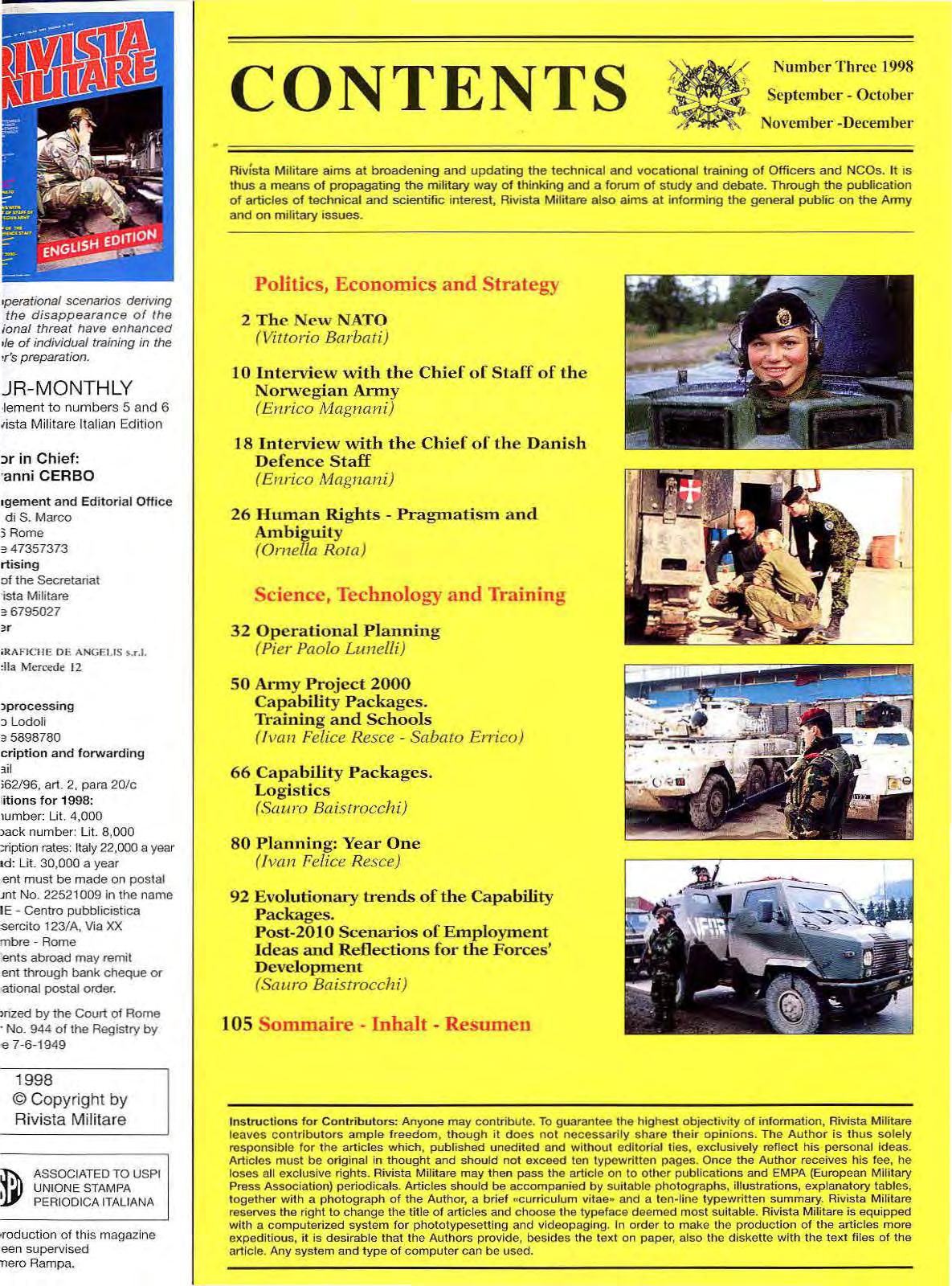
oRAFICHE OE ANGELIS s.r.l.
:!la Mcrcede 12
lprocessing
:> Lodoli
3 5898780
cription and forwarding :til
>62/96, art. 2, p ara 20/c
itio ns for 1998:
lUmber: Lit. 4,000
)ack number: Lit. 8,000
::ription rates: Italy 22,000 a year d: Lit 30,0 00 a year ent must b e made on postal Jnt No. 22521 009 in the name lE - Centro pubblicistica sercito 123/A, Via XX mbre- Rome
ents abroad may remit ent through bank cheque or ational postal order
>rized by the Court of Rome
· No. 944 of the Registry by -e 7 -6 -1949
1998
© Copyright by Rivista Militare
ASSOCIATED TO USPI UNIONE STAMPA PERIOOICA ITALIANA
CONTENTS
Rampa.
!\umber Three 1998
Se ptember - October
Nove mb er -De cemb er
Rivlsta Militare aims at broadening and updating the technical and vocational training of Officers and NCOs. lt is thus a means of propagating the military way of thinking and a forum of study and debate. Through the publication of articles of technical and scientific interest, Rivista Militare also aims at inform ing the general public on the Army and on military issues.
Politics, Economics and Strateg}
2 The New NATO (Vittorio Barbati )
10 Interview with the Chief of Staff of th e Norwegian Army ( £ 11 rico i\!lagnan i)
18 Interview with the Chief of th e Danish Defence Staff ( E11rico M agnani)
26 Human Rights - Pragmatism a nd Ambiguity ( Omella Ro!a )
Science , Technology and Training
32 Operational Planning ( Pier Paolo Lu11elli)
SO Army Project 2000 Capability Packages. Train in g and Schools ( ! va11 Felice Resce- Sab ato Frrico)
66 Capability Packages. Logistics (Sauro Baistrocchi)
80 Planning: Year One {/van Felice Resce)
92 Evolutionary trench• of the Capability Packages. Post-2010 Scenarios of Employment Ideas and Reflections for the Forces' Development ( Saw·o Baisrrocchij
105 Sommai r e- Inhalt · Resumen
Instructions for Contributors: Anyone may contribute. To guarantee the highest objectivity of information, Rivista Militare leaves contributors ample freedom , though it does not necessarily share their opinions. The Author is thus solely responsible for the articles which, published unedited and without editorial ties, exclusively reflect his personal ideas. Articles must be original in thought and should not exceed ten typewritten pages. Once the Author receives his fee, he loses all exclusive rights. Rivista Militare may then pass the article on to other publications and EMPA (European Military Press Association) periodicals. Articles should be accompanied by suitable photographs. illustrations, explanatory tables, together with a photograph of the Author, a brief «curriculum vitae and a ten-line typewritten summary Rivista Militare reserves the right to change the title of articles and choose the typeface deemed most suitable Rivista Militare is equipped with a computerized system for phototypesetting and videopaging In order to make the production of the articles more expeditious, it is desirable that the Authors provide, besides the text on paper, also the diskette with the text files of the article Any system and type of computer can be used.
•roduction of
magazine een supervised nero
this

1
by .Vittorio Barbati 1 :
The NATO s ummit of Jul y 8, 1997 decided to enlarge the Allian ce , starting from 1999, with the inclusion o r tlu·ee cou ntries, form er members (o r parts of fon n er members) of the defun c t Wars aw Pact - Poland, th e Czech Republi c and Hun gary - \.v hile th e other candidates arc s till on the waitin g list. The protocols of adh es ion wer e signed on December J 6 or the sam e and w ill co m e into force after the ratifi cation bv the Nati ons concerned -

This decisi o n , adopted after a debate that witnessed some of the allies - par t icula rly Fran ce and Italyspon so r a g reater widening, extended, to sta rt with, to R tU11ania and Slo venia, raises a series of
very pressing probl ems, which affect various fields and demand an in-depth recon side ration of the very h.mc tion of the Atlantic Alliance.
It mus t be stated at o nc e tha t NA TO tod ay i s no more in a position to pmsue cl ear aims and li ves waiting fo r a precise definition of its ta-;ks. Certainly it has secured peace and developm e nt for d ecades to its m e mber s a nd, in a broad er sen se, directly or in directly, to tl1e entire ·western vvorld (meant in a pol itico -ec onomi c, and not mere l y geog raphi c, sen se ). Moreover, it has cr eated a mu ltinat iona l structure of planning and com mand whi c h has reach e d , throu g h a len gthy and diffjcult process of re fi nement, an a lmost peerl ess lev el of efficiency. Therefore it \ vo uld be a clime to dissolve it; it sho uld be g iven instead new directions and goals.
The first definition o f the n ew ob jectiv es to be a ss igned to NATO v.rill be of cou rse a politi cal task
It will b e the pohti cia ns ' job to decide \vh e ther NATO should be tran sform e d from a defensiv e Alliance, w i th th e main task of safeg uar ding t h e liberty ::lnd integrity of its me mbers , into an interven Lion bod y o[ th e interna tional community, chieOy charged w ith keeping or enforcing peace in critical are as , employing force when and where necessary, ei th er active l y (i. e eve n w i th war) or 'vv i t h a d e terrent funct ion. Adm i ttedly, more in fa c t than in l a w and \ v:itb the UN's force d endorseme nt, NATO has a l ready p erformed
3
and is currently performing a similar fun ction in Bosnia. B ut Lh is is occu rring wi thout a n y in th e c h a rt e r of t h e And it \vill again be a p oliticaJ task to determine - with t he indispensable technical support, given the enom1ous comp lexity or t h e te chnica l p r oblem s co n n ected wi t h t his cho i c ew h a t NATO's scope w ill be and which r elations will have to be establ ished, or strengthened, with f:tiendly countries or other loca l or r eg iona l allianc es th at may b e fon;;ed in o th e r areas. The redefinition of NATO's sco pe an d tasks req uires a specific a tion of the «external» relat ions of the Alliance, fi rst of alJ w ith the UN and p a r ticular ly w ith its mo st iJ l lpur taut buuy, the S ecuritv Council, in orde r to u·anslate and scope i nto juridical forms and actua l agreements If NATO will have to opera te - ou tside its in s tituti onal <<de fe nsi ve» p u rposes - as the arm e d hand of the inte rnation a l community, it will be n ecessary to decide which marg in s of manoeuvre will have to be permanently at is disposal a nd through \/·/hat legal instruments it
will be authorized to act on behalf of th e Un i ted Nations.
Tn c onne c tio n with this p ic tu re, th e relation s to b e established w i th t h e two major «E as t ern» powers, R ussia and C hina, appear to be pa r ticu l arly delicate. T hey are nuclear powers and p er manent mem be rs of t he UN Secur ity Council, and it. m us t be born in min d th at the fo rm er d oes not apprec i ate thP- extension of NAT O to the East , wh il e the l atter d oes not seem k een on esta b lis hing close relati o ns of po litico-mili tary c oopera tion w ith the West, w hil e both ai m at rei n forc i ng the i r econo m ic t ies, especially the bilateral ones, with the Western countries. All this w ithout overlooking th e role that might, or must, be played by t he o t he1· ac to r s - b ig, medium or small - on the international scene, startin g from J apan and the countliesI ndia, Pa kistan, etc. - whi ch, in one wav or the other, seem des tined" to inll ue n c e the m a in po li tical , economic a nd str a tegic balances
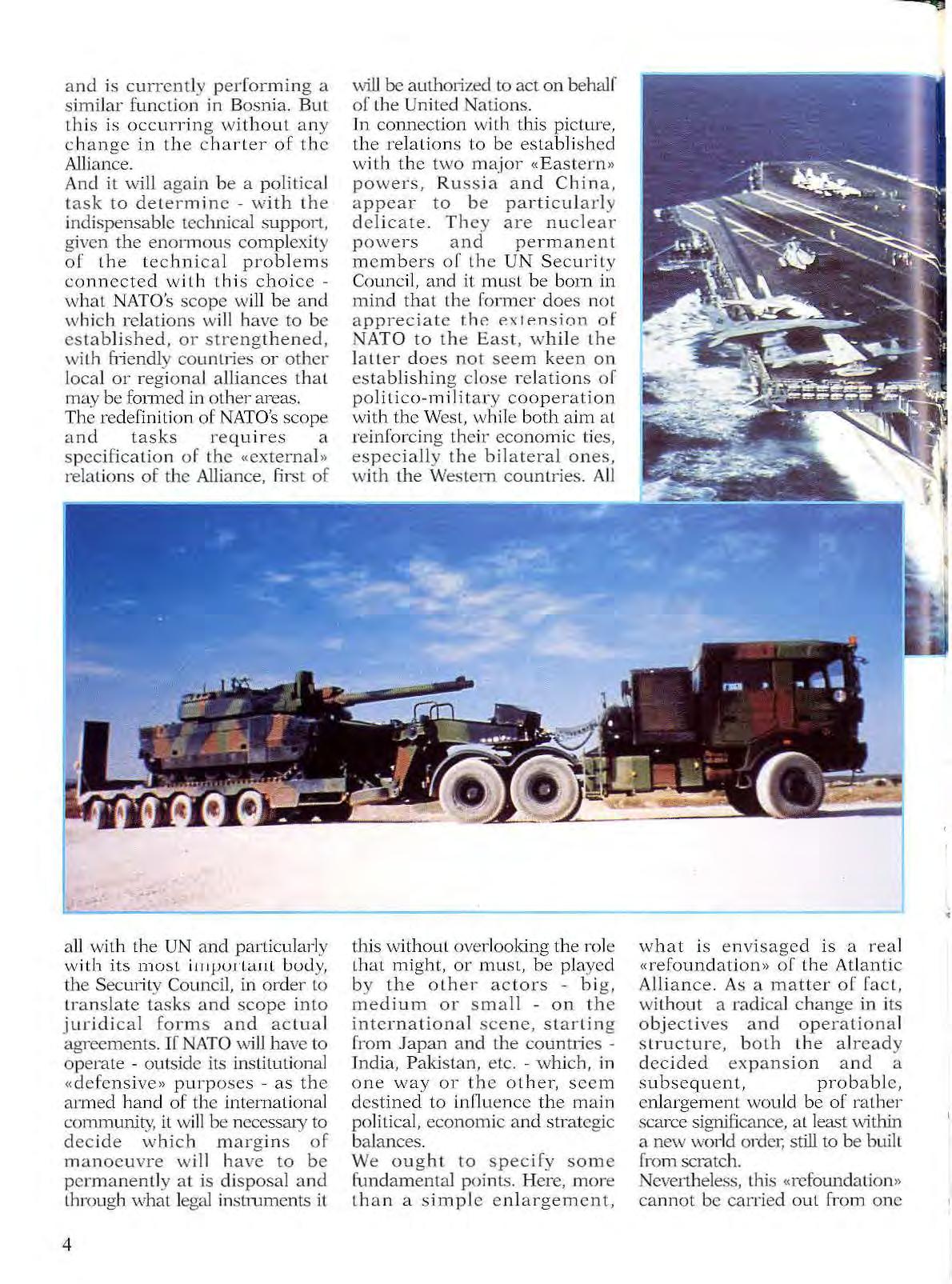
We ought to specify some fundamental points. H ere, more tha n a s i mple e nl a rge ment,
w hat is e n visage d is a rea l «refouncl at ion» o f the Atl antic All ian ce . As a ma tt e r of fact, wi tho u t a radica l change in its objectives and operational structure, both t he a l ready dec ide d expansi o n and a s ubs e qu ent, p r ob able, e nlarget11 e n t wo uld be o f rather scar ce significance, a t least \vithin a nevv \vorld order, still to be built from scratch.
Neverth eless, this «rcfoundation » ca nn ot be carried out fTo m one
4
Above.
The USS «Joh n C. Stennis» (CVN7 4) is 1./ze seventh aircraft -carri er o f' the « Nilllitz.» clas s Facing page.
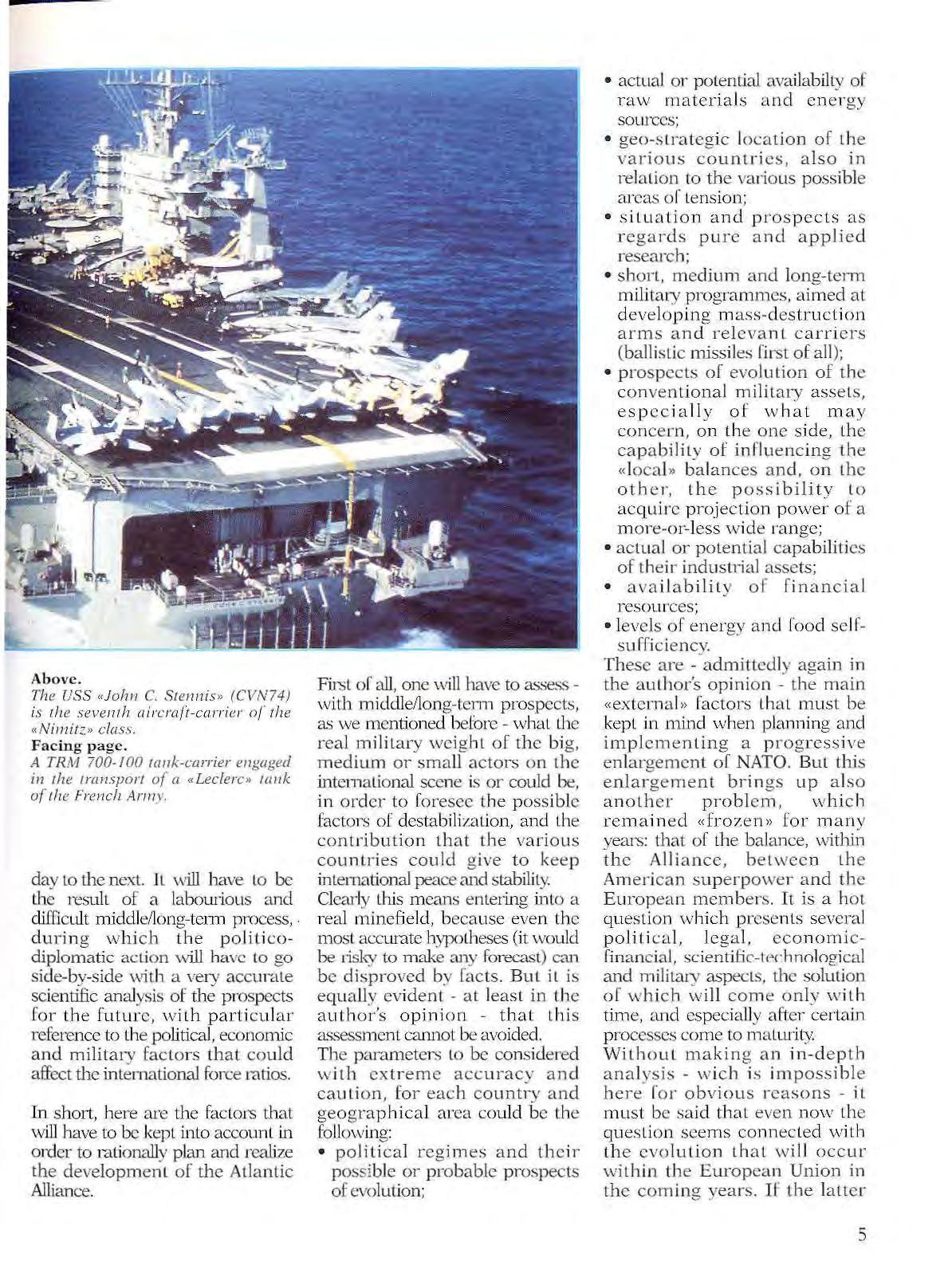
A TRM 700-100 tank-carrier e n ga ged in the transport o f a « Lee/ere» ta11k of th e French Ar111y
day to the next. It \-vill h ave to be the result of a labOlu-ious a nd diffic ult rniddl ellong-tenn process, . du r ing \Vhi ch the politicodiplomatic action w ill have to go si de-bv-side with a verv a ccurate scientilic analys is of prosp ects for the futur e, w ith partkular reference to the political, economic and militarv fac tors that co uld affect the force ratios.
In short, here are the fa c tors that \.vill have to be kep t into accoun t in order to ratio nally plan and realize the development of the Atlantic Alliance.
Firs t of all, one have to a.sse..c:;swith m iddlellon g- te m1 prospects, a<:> \Ne mentioned be fore - what the real rn ilitm·y weight of the bi g, medium or small actors on the intemational scene is or could be, in order to foresee the possible factors of destabilization, and the contribution that the various countries could g i ve to keep in ternational peace and stability. Clearly this mean s e ntering into a re a l minefi eld, b eca use even the most accmate hypotheses (it would be risky to make any forecast) can be disproved by fac ts. B ut it is equ ally evi dent -a t least in th e author's opini on - that thi s a<;,.;;essment cannot be avo ided. The parameters to be conside re d with ext rem e acc urac y and cauti on , for each country and geo gra p hical area co uld be the fo.llowing:
• political re g im e s and their possible or p robable prospects of evol ution;
• actual or po tential availabilty of ra w materials and ener g y sources ;
• geo -s t ra tegic l ocation of th e various countries, also in relati on to the vario us possible are as o f tension;
• situ atio n and prospects a s reg ards pure and appli e d research;
• short , medium and long -term military program mes , a imed at d eve loping ma ss-des tructi on arm s an d relev a nt carriers (ball istic missi les first of all );
• prospects of evolu tion o f the convent ional military ass e ts, espe c ially of wha t ma y con cern, on th e one side, th e capability of influencing the «l oca l » balances and, on the oth e r, the p oss ibility t o a cquire projection power of a more- or- l ess w i d e range;
• actu al or poten tial capabilities of their indust rial assets;
• availabi lit y o f financia l resources;
•l eve ls of e nergy a nd food selfsuffi ciency.
These are - admittedly again in the autho r's opini on -t he main «extern a l » factors that must h e kept in mind wh en plan ning and impl eme nting a p r ogressiv e en la rgemen t of NATO. But this enlargement brin g s up also anoth er prob lem, which remain e d «froz en» for man y years: that of the balance, the Alliance, between the American superpower and the Eu ropean memb ers . It is a h ot que stion wh ich prese nts severa l politi ca l, legal, ec o no mi cfinan c ia l , and military aspects, the solution o[ \ Vhich vv ill come onlv with time, and especiall y afte r p roces ses come to matw·ity.
Without making an in-d epth ana l ysis -w i ch is im possi b le here f Or 0 bvi OU S rea!> OI1S - it must be said that even now th e questi on see m s connec ted \V i t.h th e evolution th at wi ll occur within the European Union in the com ing years . I f the l a t ter
5
will be ab l e to give itself real fore i g n and defence poli c iesand it will tak e several years to attain t hese objectives - one could s peak, on certain co ndi t i ons, of a real US-EU partn ers hip. lf this do es not o ccu r, i t is better no t to h ave too many illusions. ln l imited and restra inab le crises, the Europ ea n co untrie s could act autonomous l y, but when and where the diplomatic skim1ishes escalate to facts, i.e. to military operations of remarkab le importa nce, the weight of th e N o rth American giant \vill, or will again, b e d ecisive.
Th e obstacles to o vercom e in order to ac hieve real Eu ropean foreig n and defence policies are enormous and ca n not be avoided. T hey can be d etec ted, first of all, in the attachm e nt to nati onal sovereignty, justified by the Europea n countri es' great traditions, bu t not b y their political, economic and military d imens ions . They can a l so be found in the different conceptions of the va rious Gene ral Staffs, bound to their experiences and no t always incl ined to thin k in «European » terms (also when they issue the i r s pec ifi cations). M oreove1·, in the fields of b oth researc h and production it is very difficult to es tablish, or strengthen, mu ltilateral coopera tive relati ons among the E urope<.m indus tries of d efence, ·wi th the threefold aim of estab li s hing multinational indus lli.es, comparable for s ize to the big American concerns, develop in g new s yste m s and attaining in thi s \.vay a reo ! European standardization. Th ere is ye t another impo rtant obs tacle to a politi cal hi ndrance that thro w s a shadow of ambiguit y o n several re l a ti onships. Four members of the Eu ropean Union - Austria , F in l a nd , I reland a nd S\ veden - are not NATO members, while three others - I celand, No rway an d Turk ey - are members of NATO
but not of the Eu ropean Union (albeit T urkey is bound to the EU by a customs agree ment ) and are also associate members of WEU (Western Europea n Union, link e d , v i t h NATO, w hich ought to be the «ar med Right.
The Euro{ighter 2000 (EF 2000) is very likely the most imporuwt multinatio11al European pro[!,ramme, ar1d w ill be adop1ed by th e Air Forces of the UK, Germ any and Italy Below.
The British nuclear sub marine HlvlS «'Vict(rriou.s» is equipp ed w ith sixteen U S- made « T ri d en l ll » ballis tic miss iles .

6
band» of the European Union). The in termingling is mad e even more complicate by the fact that Austria, Denmark (which belongs to NATO), Finland, Ireland and Sweden have the status of observers at WEU, while various countries, members of the fom1er Warsaw P act or even of the Soviet Union, such as Bulgaria, Czech Repub lic , Esthonia, Lat via, Lithuania, Poland, Ru man ia, Slovakia and Hunga ry, are special WEU partners. Clearly, the impossibility to disentagle this politi co-j uridic a l knot (w hich is made worse a lso b y the persistent tension between Greece and Turkey and between the latter and the European Union) will make it difficult to ta lk a bo u l European foreign and defence policies. It is equally clear that it will take years of difficult negotiations to obta in this result and to form a real partn ershi p US-EU in the ambit of NATO. Evidently there is a very close and mutual relationship of
int erdepe nd ence bet ween NATO's enlargeme nt and the Europea n Union's: t he y affect each other by limitin g or increasing their scope. Th erefore the just started, and for the lime being only partial, ex tension of NATO to the Eas t must be considered, like those that will fo ll ow, just the beginning of a process that needs a long time to 1ipen. Nevertheless, it is necesary to co nsid er its techni ca l impli cati on s as from now, in order to lay the doctrinal and practical foundat ions of the new strategy (today they can only be assumed) that NATO h ave to adopt in the next century. 1t is appropriate to start from the present situation. Today NATO can operate only on the basis or a tempor ary strategy or rapid intervention, within a rather limited range, with the decisive contribution of the American forces. Let's not delud e ourselves abo ut it. Only t h e US have th e organization and the means necessary to c arry out substantial interventions on a planetary
scale: the rapid intervention forc es of th e European coun tries, also of those militalily best equipped, have a limited sign ifica nce and in case of strong contrasts can only ope rate under the protective Am erican umbr e lla and with America n logistic support. Th e reasons for this arc manifold and desenre some investigation. Duri ng the cold -wa r decad es the US develop ed t he m eans nece ssary to conduct any t ype of war fare on a p l anetary scale: from global nuclear confli cts to conve ntion al cont1 icts of diverse duration or extens i on. T herefore, toda y, be sides h:-win g a powerful strategic nu clear dcten·ent, the US, with its conven tional forces, can carr y out deci sive in tervent ions i n any part of th e ·world.
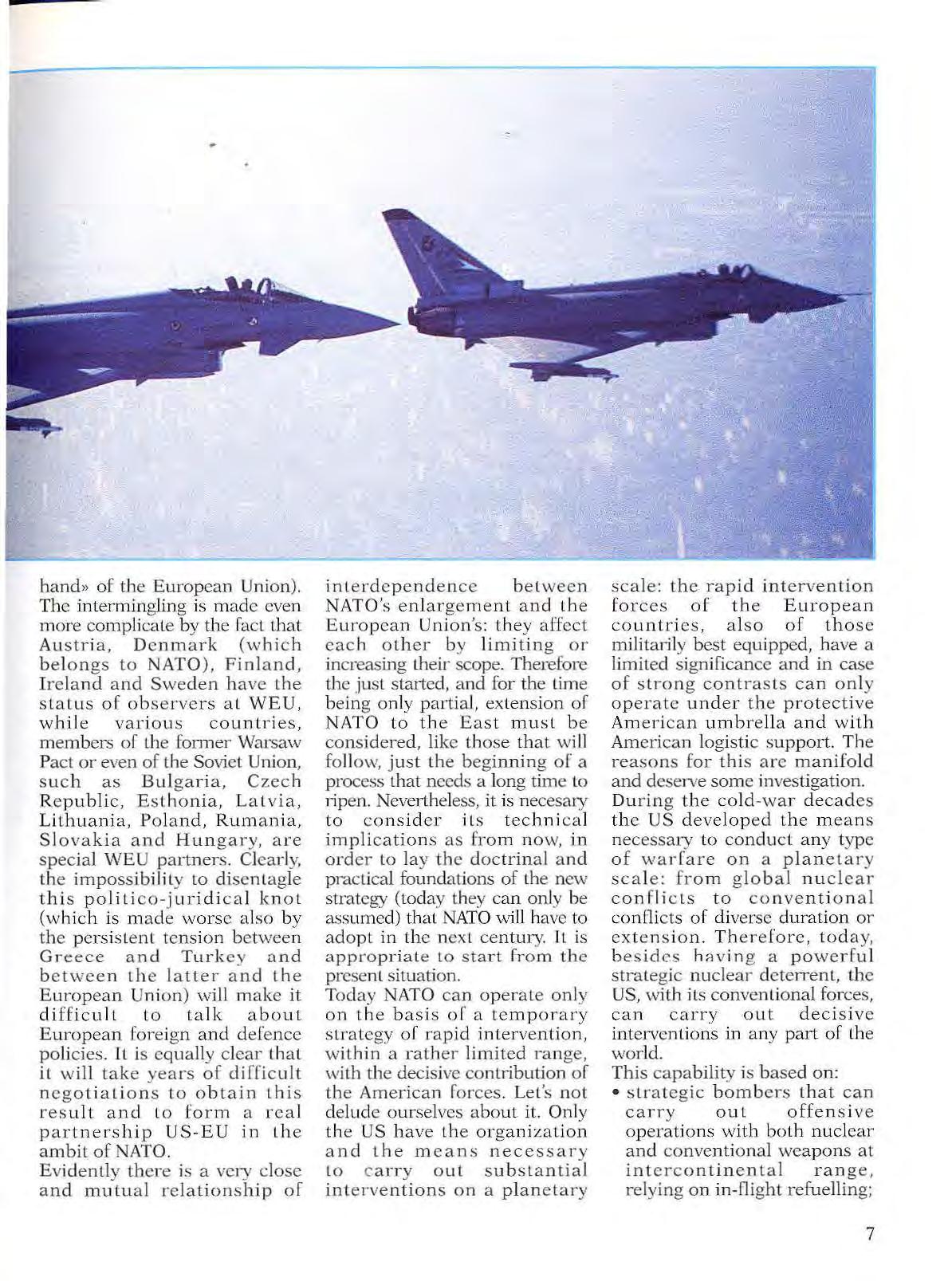
This capability is based on:
• strategic bomb ers that can car ry out offensiv e operations with bo th nucl ear and conve ntional weapon s at in tcrcon tin en tal ran ge , relying on in-Oight refuelling;
7
• a wide n e t of o vers ea b ases l ocated in a ll ied o r fr iend l v coun tr ies (t he u se o f thi s bases, o n the o t h e r h an d , m ay b e s ubject to m ore or l ess se rious poli tical and/ or lega l limitations);
• a pow e rf ul tactical air fo rce (s ub o rdinate, like the bombe r s, to th e Ai r Combat Comm a nd ) whic h , th anks to gener ali zed i n -f li g h t re fuellin g, c an b e prom ptly tr a nsferred , a ll or in pa rt, from T heatre to Th eat re;
• power ful CV BG ' s (A icraf L Ca rri e r Battle Group s), co n s is tin g of aircraft carriers and e scort units, abl e to exerc ise both a strong air power and to c ontribute to aircraft a nd a n timiss il e defence o f th e US ten·it ory and , if necessary, a lso of the territ ories o f th e allied or hien dly coun tries;
• p owe rful formatio ns for am phi b ious or triphibi o u s o p erations co ns t i tut e d b y s p ec ia lized naval uni ls and mi gh ty US Marine CoqJs Un its ; • a hu ge log istic structure, whose stro n g points are , b es i des a i rcraft a nd s h ips c apa b le o f ca n ying the heavie.s t m aterials over in te r continen tal distances, prepositioni ng sh ips s ta tioned i n s t ra teg ic areas and large inland d e pots for the storage of t a nk s , artillery, engin ee r s ' material etc., ··irnm ; di at e ly e m p l o ya b le by Arm y an d Ma rine units transferred to th e area;
• last but n ot leasL, po werful Anny and Mari ne units supported, i f n ecessarv, b v w ell t r a i ne d , rea d ily reserves . T h ese e le ments confe r to th e Un i te d S ta tes uniqu e strateg ic ca pabi lities determined b y a cle a r s uperiority - that ca n be «m eas ur e d» in d ecade s a nd billions o f dollars - in some k ey secto r s : fro m that of s tra teg ic bombers (no European country is capable of deve l o pin g, p roduc i ng and m anaging a i rcra ft of that ca tegory) to th a t o f intercontin e n ta l
Above.
The Bri t i sh Ullralig/11\veigh l Fiel d How il ze r (U FH) was t h e w i nne r o{ a competitive biddinf!, h eld by 1he US Arrny /or a <<light» I 55 mm Right.
;1 Pz. fl 2000 155 nun self:pmpe/led gun.

ball i s t ic m iss il es, rr om the sp a c e s e ct or to th e sectors o f te lecommu n i cations, g rea t aircraft carri e r s, (w i t h their embarked mul tival e nL w in gs), AWACS (Airbon1e Warning And ConLTol System), gr ea t transport aircraft, amphibi o u s assau lt s hips and logistic sh ips. The list could co n tinu e but, at this poin t, we th ink it's en ough . Clea rly i t is u n think able t o try l o compete wi th the US in the s e sec tors The Eur opea n s could instead play ot h er ca rds. Provid e d that they b e c apa ble of creating a uni ficld i n du s try for d e fence, wi th co n ce rns of adequate dim e n s i ons a nd the coo peration of fi rms - lik e t h e S wed ish firm s, for exa mpl ew h ic h , altho ug h t t h ey b e lon g to c oun tr ies th at cu r ren tly are no t NATO m e m bers, a lr ea dy vvork with standard s compatible
wit h NATO 's . I n this w a y, i t cou ld h e p oss ible to att a in , throu g h a co mpariso n of th e b est n1 a ter i a ls , an admittedly parti al Eur o-American standardi zati o n.
Ac tuall y, es pec ially in th e arm a m e nt a nd .la nd equipment secto r - tan k s, to w ed and selfpropell e d a y·till e r ies , ligh t a n d h ea vy armoure d c ars , tank c ar r i ers, m o to r vehicl es, En g ineer eq uipment, battlefield cont r ol sys t e ms, etc. - man y
8
European prod uct<; a re doubtlessly comparable to s i milar U S products. They have a \Neak point: non-standa rd ization, which makes it d ifficult, if not do wnrig h t impossi ble, in case of contlict, to h ave su bstantial mu l tinat i on al forces operate
Al so in oth er sectors, the European s h ave something to say. Provid e d that th ey jo in forces. To make just a few examples, t h ey can deve l op excelle n t fighter and attac k
aircraft, tac tical miss iles, radar systems, satellites, hightechnology nava l un i ts, etc.
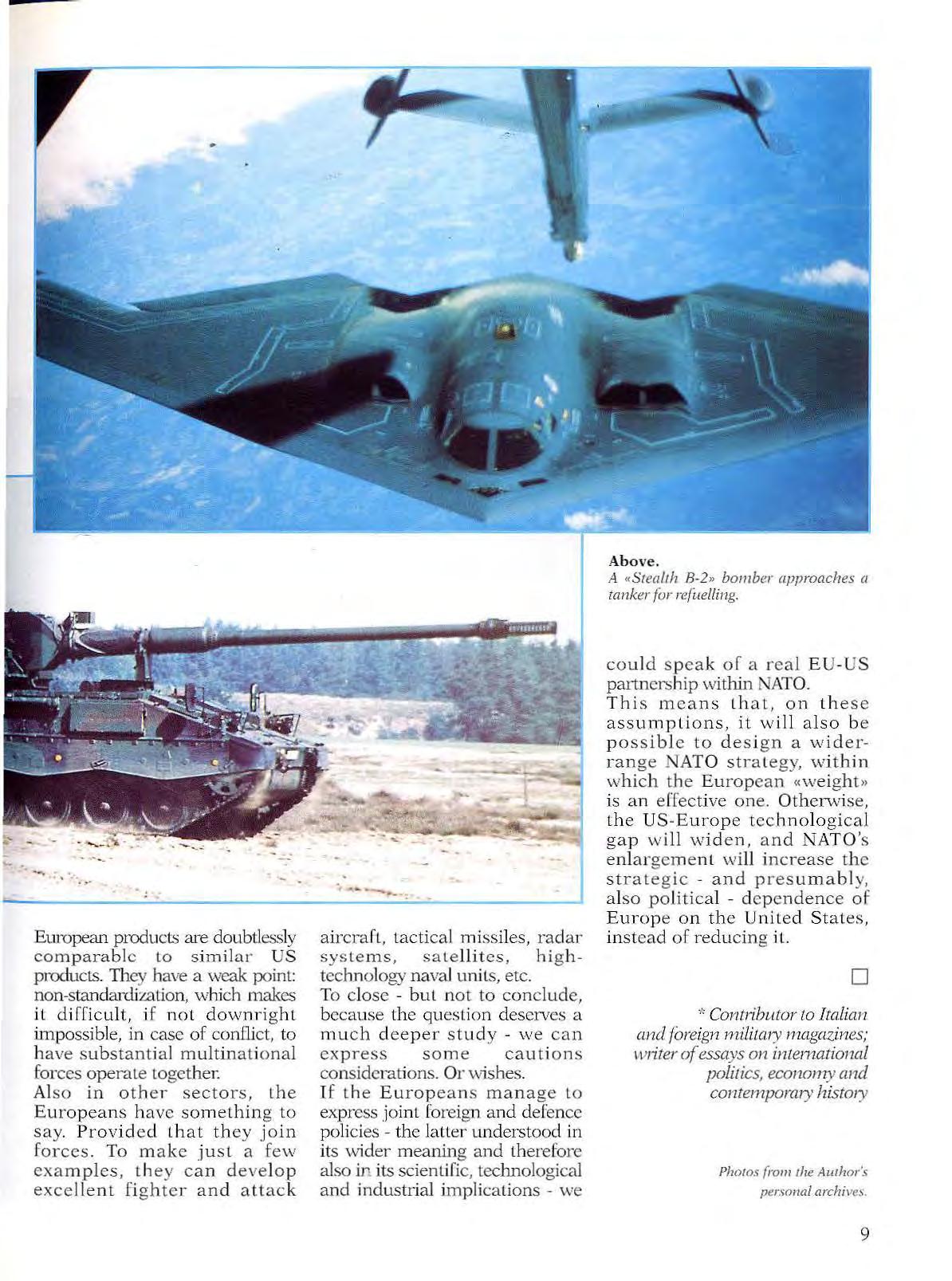
To close - b u t no t to conclude , beca u se the qu estio n des erves a nlll ch d e eper st udy - we can express some cautions considerations. Or wishes.
If the Europ eans manage Lo express joint foreign a nd d efence poli cies- the latter understood in its wider meaning a nd th erefore also in i ts scientific, techn ological and industrial implications - we
could s peak of a real E U-US partne rs h ip -vvithin AT O. Thi s mea ns th at, on th ese assu mp ti ons, it w ill also be p ossible to d es i gn a widerrange NAT O strategy, w i th in which the Eu ropean «\.veight» is an effec tive one. Otherwi se, th e US -E urop e tech nolog ical gap will ,.viden, and NATO 's enlargeme nt w ill i nc rease the st rategic - and presumably, also political - dep e ndence of Europ e on the Un ite d Sta tes, instead of redu cing it.
0
'' Contributor to ltalia11 and fore ign militc1.1y magazines; writer ofessays on international polil ics, economy ancl contemporary histo1y Photos fro m 1he Author 's personal archi ves.
Abo ve.
A «Stealth B-2» bomber approaches a tanker for re[i1elling.
9
Interview With e Chief of Staff orwegian Army
 by Enrico Magnani *
by Enrico Magnani *
10
THE NEW ARMY
Also the Norwegian Army faces the challenge of a renewal, made necessary by budget limitations and changes in the politico-strategic scenario. The objective is to obtain an instrument reduced in size but flexible, mobile and well equipped, able to face any type of threat.
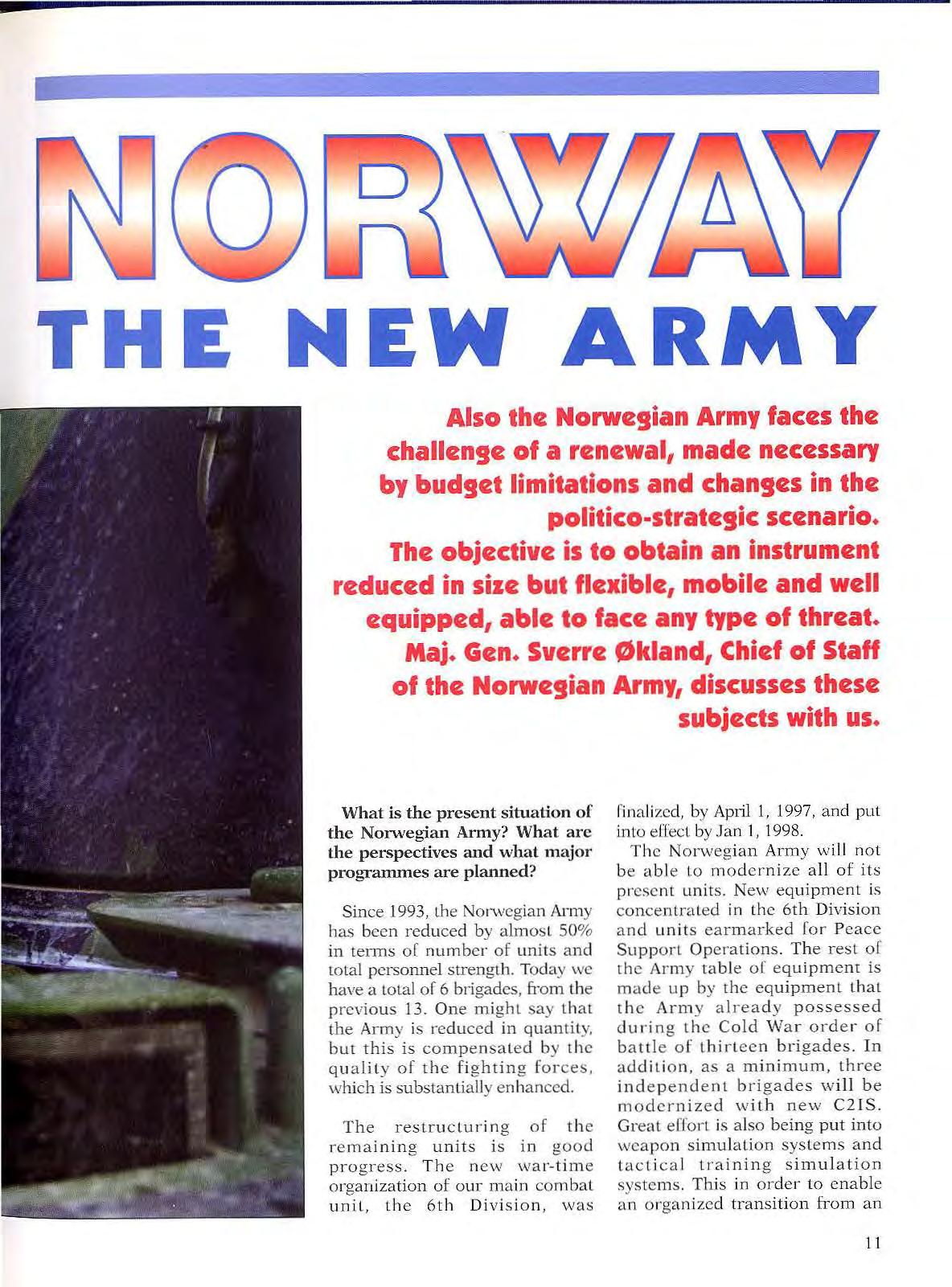
Maj. Gen . Sverre Okland, Chief of Staff of the Norwegian Army, discusses these subjects with us.
What is the present situation of the Norwegian Army? What are the perspectives and what major progranunes are planned?
Since 1993, the Norwegian Army has been reduced by 50% in terms o( number of units an d wtal personnel strength. Today we have a total of 6 brigades, from th e previous 13. One might say that the Army is reduced in quantity, but this is compensated by the quality of the fighting for ces, wh ich is substantially enhanced
The of the rernaining units is in good progress. Th e new war-tim e organization of our main eo m bat unit, t he 6th Di vision, vvas
fina li ze d, by Ap1ill, 1997, and put into ef[ec l. by Jan 1, 1998 .
The Norwegian Army will not be able to rnoclernize all of its present units New equi pm ent is conce ntrated in the 6th Di vision and units earmarked for Peace Support Operations . The rest o( the Arm y tab le of eq uipm ent is made u p by the equ ipme nt that the Army already possessed during the Cold War order of battle of t hirteen brigades. I n addition, as a m i nimum, three ind e pendent brigades w ill be modernized with new C21S. Great effort is also being put into weapon simulation systems and tactica l training simulation systems . This in orde r to enab l e an o rgan ized transition from an
11
A columu o( 1//0tor s l e dges. The m aint enance of high off- r o ad mobilit y i l l difficul t orographic condi t ions i s a high prior il y for th e Non ,vegian ;1rm y.
Attriti o n-\Va rfare-based army t o an army oriented towards Mano euvre Wa rfare.
T he Norwegian Army will use approx. 2,5 billion .\IOK eac h year on new equipment in Lhe period 1999 - 2004. T hi s i s planned to inc rease t.o more than 3 billion NO K each year from 2005.

T hiss is heav il y depende nt on the effort s made to red u ce the present. O& M costs (appr·ox . 4,5 billion p er year) .
Th e m ajo r· ongo ing procure ment
programmes are the following :
• CV 9030 infrant.ry cornbat. ve hi cle ( 103 pieces);
• 12 MLRS-system s;
• d igita l VHF-raclios (M ult i- ro le);
• amw C2IS; Major plann e d pro curement pr ogranm1es:
• New !\ilBT (Main Battle Tank);
• Medium range anti tank weapons;
• NASAMS anti aircraft system;
• light infantry ten-ain ve hicles;
• replacement of t h e M-109 artillery system.
The Norwegian Army has a lon g expe ri e nce in peace supporting operations, from Korea to Bosnia. Today, Norwegian soldiers togeth er with other Sandinavian, Polish and Baltic comrades, are serving in the NORPOL Brigade in SF OR. What does this mean for the Norwegi a n
Army and the participation in peace-keeping operations?
F ir s t and foremost the partic ipation gives ofGce rs, m e n a nd wome n of the Army a uniqu e opportunity t o serve within an opera tional multinat ional NAT Oled Army Corps f ormalion. T h is g ives u s the possib ility to dravv exper ience f rom the practical app li cation of principles, doctrines and regulat ions in an ongoing operation. T his \.vill benefit the indiv id ual, as well as the Ar my as a whole .
S econ dly, it gives the Army the possibility to gain more experience fro m the use of national orga nization, trai ningpr-ograms and equ ipment.
ll oweve r , th e participation
12
.._
Two ,\lo r wej!, i al'l soldi e r s wi1h the sy s1em of' 1he all(ifank «Hellfire » missile.
pulls huge r es ources fro m o ur national eo m mittmcnts , th us t her e \v ill be a co ntinuous e valu a tion of th e b a l a nce bet ween ben efit and cost.
After the establishment of the Telemark battalion, Norway is a full participant in the Allied Mobile F o rce, the most important elem e nt of NATO's Immediate Reaction Forces.
Will we in the future see Norwegian soldiers training in Italy?
Th e Tel em ark Batt a lion partic ip ated in exerc ise Dynamic
Mix and Arden l Gro Z-md in Ita ly last year. Th e c u rrent exe rcis e schedul e of t h e Com man d er AM F (Land) is subj ect Lo a pprov a l by S HAP E and to t he [i xe d prior i t ies
Toda y, th er e are no plans for the TeletTaark B atta li on to parti c ipate in tra in ing in Italy in the n ear fu tur e
Until now, the Norwegian Almy has not assigned combat units to the ARRC. Will this situation

c hange in the futur e, and will Norwegian soldiers take part in other muts of the ARRC structure?
Norway has made commi tm e nts !o•· panicipati on in NATO's react ion fo rces. According to the V l hite Paper of 1997-98 fro rn the MoD, \Ve inte nd to maintain th e level of the present
co ntribution. the White Paper still says that th e questi on of new co mmit me n ts to KATO 's mullinatio.nal fo rce sn·uc ture m ay be a matter of jud ge ment. initiall y \ ve may look for poss ibili t ies to place minor new formations at the dis p osal of ARRC or AMF(L). Norway may a lso pa rticipate w ith ollice rs in .HQ ARRC.
During the Cold War y ears, the Norwegian Army has been NATO's first line defence aga inst the Warsaw Pact military structure. WiJI the fact that Russia is a fundamental member of the new Euroatlantic sec urity system change the architecture of the Norwegian Almy?
Durin g th e Cold War, the Norwe gia n Army ha d a con ce pt
13
a n d arc h i l ecture b ased on Attrition Warfare Th e aim was to k eep as m u ch as p ossible of t h e t eu i tory i nta ct b y d e la y i ng an i n o r d e r to buy t ime for Alli ed reinforcements to ar r ive .
Thi s c oncept and the Army ar c hit ec ture have chan ge d fund ame ntally The Arm y i n iti a te d in 1993 a process of imple m ent i ng a new co n ce pt b a se d on Manoeuvre Warfare. E d u cation of officers and tra inin g o f units have both been ch a nged s u b stantially in order to b e in line \ vit h t he new c o ncept F u r thermore, th e Army Proc u re m e nt Plan i s n o w con ce n t r a ting on rel e v a nt e qu i p me nt for a mano e u vrew arfare-o ri e nted army.
The mai n tas k of the Norwegia n Army is, as the land compone n t of t h e Norwegian Ar med F orces, to protect and d c r cnd t h e sovere ig n ty of N onvay, a nd to contribute to a cre di b le a nti - invasion f o rce in one p ar t of the country, fo r th e tim e b e in g initially locat e d in N ort h ern Nor way.
In a t ra d it ional in vasion scenario, Norw a y d oes sti ll re lay on NAT O rei nfor ce m e n ts.
O ne part o f t he still ongoing proc ess is the e stabli shment of a new ar m y doct r i ne Th e d oc um e nt Tactical Doc t ri ne of the
Army w ill be finalized in 1998, and i s closely co-ordinated with the ongoing joint process of es ta b lishing a new national j o in t doc trine.
Sustaining a cred ibl e antiinvasion capacity is s Lill th e main o bjective of the N orw egia n Army, w hile emphasis i s a l so p ut on the pa rt i c i pati on i n interna tional P eace Support Ope r at ions.
Besides the co-opera tion , ,vith NATO, the Norwegian Anny has a long tradition of co-operating with the other Scandinavian countries.
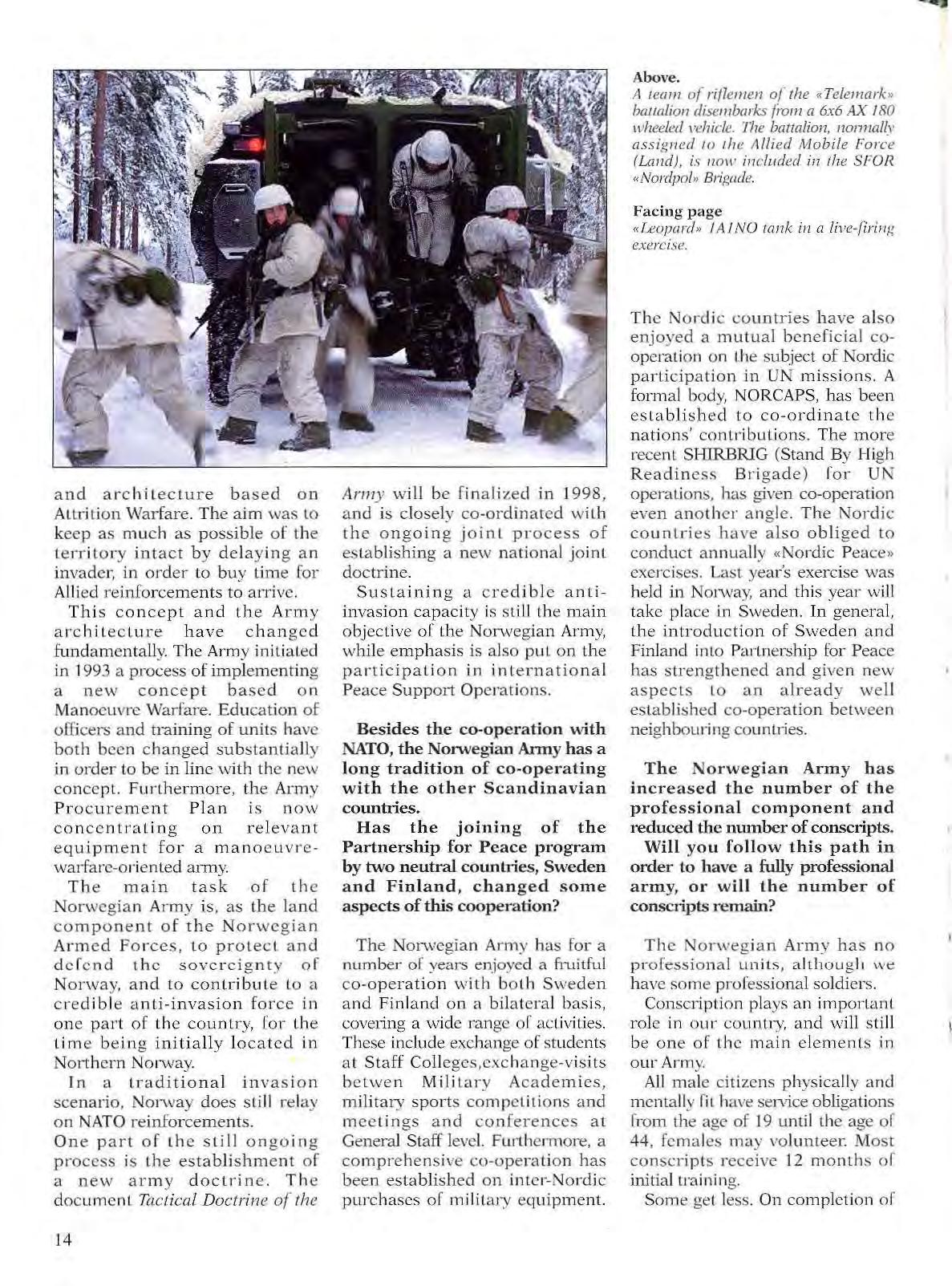
Has the JOllllllg of the Partnership for Peace program by two neutral cotmtries, Sweden and Finland, change d some aspects of this cooperation?
The Norwegian Army has fo r a n um b e r of years enjoyed a fn.titful c o -operation w i th b o th Sweden a nd Finland on a b ila t era l basis , covering a wide ran ge of ac tivities. Th ese include exchange o f s tudents a t S t aff Coll eges,cxc h a n ge -vi s i t s bctwe n Mili tary Academ i es, m i litary sp o rt s compet i tio ns and mee ti ngs and conferences at General S taff leve l. Furt he r-more, a compre h ens ive co-operatio n has been established on i nte r-No rdic purchases of military eq u ipment.
Above.
A team of riflemen o( the «Telemark» battalion disembarks from a 6x6 AX 180 IVheeled vehicle. 111e battalion, nonna/1\' assigned to 1h e !lllied JHobile Force (La 11d), is now included in the SFOR «Nordpol » Brigade
Facing pa ge
« Leopa rd» 1A I NO tan k i11 a live-firi ng exercise.
The ordic co u ntries h ave a lso enjoyed a mutual benefic ial coop erati on on th e su bjec t of No r dic p a r tici p atio n i n UN mission s . A formal b od y, NORCAPS, has bee n establi she d t o c o-ordinate th e nation s ' co ntri b utions. The mo re rece n t SHIRBRIG (Stand B y Hi gh R ea d iness Br i ga d e) for U N operations, has given co-operat ion even a n other angle . T he Nordic co u ntries have also ob liged to conduct annua ll y «No r d .i c Peace» e xerc ises. Last year's exercise was held in Norway, a nd this year will take place in S weden. In general, th e in troduc tion of Sweden and Finlan d in to Partn ership for P eace has strengt h e n e d and give n new aspects to an already well established co-operation between neighbouring countries.
The N orwegian Army has increased the number of the professional component and reduced the number of conscripts.
Will you follow this path in order to h a ve a fully professional army, or will the number of conscripts r e main?
The orweg i an Army has n o professional un it s, alth oug iJ we have some pro fessiona l soldie rs .
Cons crip ti o n p lays an importan t role in o ur c oun t ry, and will s till be one of t h e main elements i n our Ar my.
All ma le cit izens p hys ic ally and mentally fit have service ob ligations from the age of 19 unti l the age or 44, females may vol unteer. Most conscripts receive 12 months or initial tra ining.
S o m e get less On completion of
14
the ini t ia l tram mg, th e cons cri p t will be discha rged and assigned to a s pe ci fic unit. Un til the age o f 4 4, t he con sc ript w ill regul a rly b e called up fo r refres h er tra ini ng and fie ld exe rc ises.
We in t e nd t o stic k t o th e co nscri pt system, an d th ere will not be any p r ofessional Army in No r way .in the yea r s t o co m e. Solution s other th a n con sc ription wil l not provide the necessary n u mber of sold iers a n d will not o btain s upp or t fro m th e popu la ti o n.
An almost all-professional force needs strong commitment in the social field as well a s home programs, sala ry, educ a tional programs etc.
What will the Norwegian Army do in order to help its professional personne l?
S ome years ago t he Norweg ian Army started focusing on t h e o fficer s' famili es T h e Arm y wa nt s the o ff icers to m ove with t heir family when transferred. T h e Army S taff foc u ses on Co u r 'i ssues:
• E d u cational possib ilities for th e s po u ses;
• Job p oss ibiliti es for th e sp ouse s. Th e Norwe g ian system is buil t o n a rwo -income family, and the
fam ilies ' e con on1 y i s mainl y b ased on two incomes .
• Kin derg a rten - we try to make sure there is a kind e rga rten fo r ch ildren be tween age 1 and 6
• A satisfactory housing tandard.
Female personnel have been in th e ranks of t he N orwegian Anny for several years .
If possible, c ould you give a short history and anal ys is of this compo nent, and what are th e persp e ctives of wom e n in th e Norwegian Army?
Today wome n are f ull y inte gra ted in a ll fiel ds in th e Norweg ian Army T h e in tegration started in 1977, when the Officer Candi da t e S c h o ol, n o n c omb at se ctors, vvas ope n e d t o w o me n In 1 983, the ord i nary init i al se rvice was opened to wo m e n in volunt a r y terrn s, and in 1984 all pos i t ions were opened to wo m en. T he present highest rank for a female in our Ar my is maj or, but i n th e NATO / UN servi ce w e h ave some temporary lieutenantcolonels .
In 1997 the N o rwe g ian Arm ed Forces estab l is h e d a stra t eg i c plan for gender equality. This plan is focusin g m a inl y o n t wo imp o r lan t issues:
• H ow to make women apply for
Offi c er Ca n didate S chool.
• H ow to make female officers choose th e mi l ita ry as a c areer. Th is plan is our workin g d ocume nt and w e h ope will h elp us to reach the aim of 7% •Nomen in t h e Arm ed Forces i n the year of 2005.
In comparison with the de fe nce budgets of t he other NATO memb e rs, the Norwegian Defe nce Budg et has maintained its Co ld War level, and you are still aiming to increase the pro c urement share of the total budget. How is this possible?
As sta t e d in t h e r es p o n se to your first question, in order to be abl e to increase th e s h a re o f t he bud ge t spent o n acq u is ition , we h ave to r-ed u ce o u r O&M costs. T he De fence B udge t w ill prob a bly b e maintai ne d at i ts presen t leve l , in t he y e a r s to come. Taking into account the conri n uosl y ri s in g cost of th e new equ ipme nt , th e only way we h a ve or financ ing our p rocurements of n ew eq uip ment i s by r e d ucing the O&M costs of th e p eace-Lim e army. Thi s w ill be achieved b y a (urther downs i zing or the peacet ime leve l of t h e Army. Th is is n o L an easy pr oces s , bu t I rema i n confident that \ ve w i l l

.'
15
achi e ve our ai m of m o derni z i ng our A•-m y a cco r di ng t o t h e pla ns lai d down.
The National Guard is a very important element of th e N orwegian defence system.
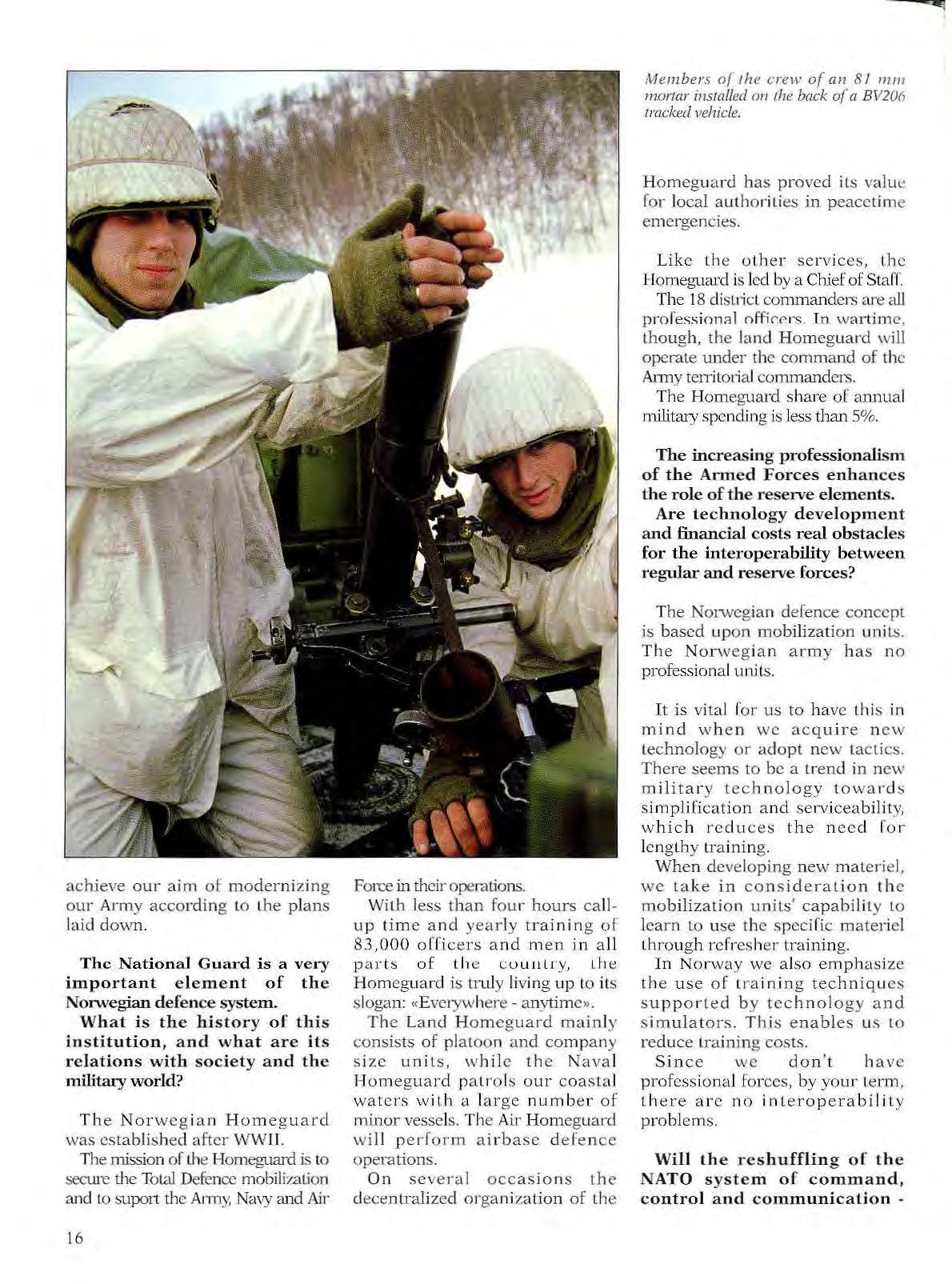
What is the history of thi s in s titution, and what are its relations with s ociety and th e military world?
T he Nor we g i a n Ho me g u ard was e s t a b lishe d after W WJJ
Th e mission of the Homeguard is to secur e the Total Defen ce mob ili zatio n a nd to the Am1y, Navy and Air
Force in their operations.
With less than fou r h o urs ca llu p tim e a n d yea rly traini n g of 8 3,000 o f f ic ers a nd men in a l l pa rts o f th e L: uuu l ry, Lh e Ho m eguard i s t r uly livi ng up to i ts s lo ga n: «E veryw h ere - a nyt ime ».
The Land H o m cgu a rd m a in l y cons i sts o f p latoo n and company s i z e uni ts , w hi l e t he Nav a l Homeguard p a tro ls our co asta l wa ters with a l arg e numb e r o f minor vesse ls . Th e Air Homegu a rd w i l l p e rfo rm a irbase d e fe n ce o perations
O n se veral occ asions the d ecentra li zed orga n ization of th e
Members of the crew of an 81 111111 m 011ar installed 011 the bac k of a BV206 tracked vehicle
H o meg u a rd h as p ro ved i ts value for l o cal au t ho riti es in p eacet i me e m e rge ncies.
Like th e o t her ser v ic es , th e l Iomei:,'W:UTl is led by a Chief of S ta ff.
The 18 d is tric t c mmnande rs are all n ffic.P. rs . l n w arti me, th ough , the lan d H o m egua rd wiU operate w 1der t he co mmand o f t he An ny t errito d a l conunanders.
The Hom eguard share o f aru1Ua l military spe ndi ng i.s less than 5%.
The increasin g professionalism of the Arm e d F orces en han ces the rol e of the reserve elements
Are technology developm e nt and financial c osts real obstacles for the inter operability betwe en regular and r e serve forces?
T he Norweg ia n d efe nce concept is based up o n m obi lizat ion uni ts. T h e N o r w eg i a n a r-my ha s n o profession a l uni ts .
It is v ita l for us t o have th is in mind \v h e n we acqu ir e n ew techn ol ogy or a dopt n ew t actics. The r-e seem s to be a t r e n d in new m i li ta r y t ec hnology tow a rd s s impl i fic ation a nd se rvi ce a b ilit y, w hich re el u ce s the ne e d f or le ng thy tra i nin g
\<\' he n d eve lop ing new mat eriel, w e t ake in co n si d e ra t ion t h e mobilizati o n u n its' capab i l it y to learn t o u s e t h e spec ifi c m ateriel through r e fr es h e r t r ainin g .
In Norw ay we also emphasi ze t h e us e of t ra i n i ng t echn i q u es s uppor te d b y techno l o gy an d s imula t ors . T h i s e n a bl es u s to r educe trai ning c o s ts.
Sinc e we d o n' t h a v e professiona l f orces, by your t erm , there ar c no int er operab i li ty p roble ms.
Will the r e shuffli n g of th e NATO system of command , control a nd c omm uni cation -
16
A CV90 tracked vehicle proceeding on the difficult Nonvegian t erra in.
first with the fusion of AFNORI'H with UKAIR and the consequent establishment of AFNORfHWEST, and now its in tegrati on in AFCENT, change in some measure the contribution of the Norwegian Army to security a nd stability in Northem Europe?

The fact t h at the NATO command s tructure has b een grea tly re duced over Lbe last ten years is me rely an adap tation to L}Je c ha nged secmity environ ment , a n d to the ne w and different tasks foreseen as a result of t ha t.
The Norwegian Anny's contribution to NATO is not influ enced by t hese ch anges, e ve n thou g h N AT O's n ew m iss i o ns ma y increa s e th e demands on o u r reaction forces.
In the past , NATO e mergenc y p la n s earmar ked relevant forces (US , Br iti sh, Canadian a n d Ge r ma n Lmi t s and so ld ie rs ), fo r the Defen ce o( Norway.
Has t h e new stra.tegic si tuation in the northern region c h ange d t h e Allied effmt for the are a?
I n l ine wit h the earl i er concepts, t he main contri buti on is Ame ri c an, with t h e N onv a y A i1- La nded Ma r £ne A i r Ground Task F orce, N AL MAG TF. In addi t i on , d i fferent units of the Allian ce's Re a ction F orces and two artillery batta li o n s ( GE and US) are i n t he NATO Com p os i te Force ( NCF )
Th e Un it e d Kiu gu uw a nd the Neth e r·lan ds h ave ce n tral fun c lions i n the r e inforcement p lans for Norway, including the UK/NL Amphibious force.
T h e Allied Command Europe Mobile Fo rce (La nd) - AMF( L) \vill b e a pr imary c ri s is ma n ageme n t too l in o u r regi o n.
Maj. Gen. Sve rre 0kland w as born on Jan 4, 19 41.
He attended t he Militar y Preparato ry Scho ol, and obtained the Military Matriculation Degree; t h e Military Academy, the Ca mb e rl ey Army Staff College; the Royal College of D efe nce Studies in the Unite.d Kin g dom.
Pl"omoted to the rank of Ca valry Lieute n ant in 1966, he ser ved at th e Cava lry Scho ol a nd the Reconnaissance Company of th e North Norway Brigade.
As a Captain, he served as a n instructor at the Military Academy.
After his promotion to Major, h e was Secretary to H.R.H. t h e Crown Prince a nd Opera ti ons Officer of th e Troms Land Defence District.
F rom 1984 to 1987, Lt. Col. 0kland served at the Office of the Inspector of Cavalry, and com manded a n Annoured Battalion of the North Norway Brigade.
In 1987, promoted to the rank of Colonel, commanded th e Cava lr y Regim e nt South until 1989, when , promoted Brigadier General, assumed t h e position of Chief of th e Army Staff at th e H eadquarters Defence Command Norway.
In 1992 M a j Gen. 0kland was given Command of the Land Command Vestlandet and in 1996 was appointed Chief of Staff of the Army.
Major Gener a l Sverre 0kland is decor ated with the National S ervice Me dal and th e Defence Service Me dal with two Stars .
0 ./
o u mal is t
17
THE NEW ARMY

l
18
Interview
with
General Christian Hvidt Chief of the Danish Defence Staff

Tod ay the Da n i sh Arm y i s a military instrum e nt limite d in size, but wi th hi gh capabilities. H ow will the land for ces be or gan ized at th e beginnin g of next ce ntury?
D ue to Den rnat·k's memb ersh ip of NATO, the Danish Army has a lon g tradition f or exten s iv e milit ary co-operaUon with other nations in Europ e. Situated at the gateway to the Balt ic Sea region, d uri n g the Co ld War Demnark was ve ry dependent o n NATO coop era tion and trained regularly with t he dedicated reinforcemen ts Th e Danish Army was - and s till is connected to NATO 's command struc ture thro ugh Allied
Com m a nd Balti c Appr oa c h es (BALTAP). BALTAP was politi cally approved in the autumn of 196 1 and estab lished in J an uary 1962 . BALTAP is a joint command res pon s ible for a ll military operations in the area covering Den mar k , Schl eswie- Holst e in north of the river E l be, parts of Skagerrak, Ka ttegat, the Danish Straits, and the Baltic Sea.
Subordinate to BAI.:fAP are two arm y corps: Allied Land Forces Ze ala nd ( LANDZEALAN D) and Allied Land Forc es Jut l and and S chl esvvig-Holstein (LAN DJUT).
During t he cold w ar, the missi on of LANDZEALAND was to defend the Z e aland archipelago w it h Da nish forces and a l lied
19
reinforcements. T hrough the years we ha ve enjoyed part icipation in NAT O exerci ses of the I talian Alp ini battalion ass ig ned to ACE Mobile Fo rces (Land)- AMF( L) .
Cor ps LANDJU T co nsist s of b ot h Danish and German l and rorces The mission of LAN DJ UT - co nsist ing of one German and one Danish di v is ion, incl. supp ort troo ps - was b as i ca ll y to d efend th e Jutland pe ninsula and Schlesvvig-H olstein.
T he changes in the European and glob a l security sit u ation afte r the collaps e of th e Soviet Union and the War saw Pact have had gre a t i nflu e n cc o n the D ani s h Army.
The overall p o li tica l directives for t h e modernizat i on of the D anish Defence have been formu la te d i n the Defe n ce Act fro m December 1993. The Lasks o f the Danis h Anny ha ve vv idcn ed fro m the traditiona l regio n a l ro le t o in clude a global dimension. ln accordance with t h e Defence Act, a t-my contrib u tions to conflict preve ntion, p eace supp ort, and humanit ari an operati ons on a globa l scal e have bee n give n hi gh p ri or ity durin g r·ece nt years. Th e effec t of this has be en a modernization of the army, inclu din g adjustments of the army structur e, training and ope r a tional and mu l t inati o n a l ac tiv ities. Alth oug h sub stan tial and st ill in creasing weig h l is g iven to internati ona l r e lations a nd activi lles, po li tical a uthori ties have stated that the main task of th e Danis h Arm ed Forces still is to maintain D en mark' s sovere i g nt y and g uara nte e t h e continued ex i sten ce and integrity of the nation. The modernization and devel opment of the army is still in prog re ss The mode r niza t ion p r ogr am is carrie d out in acc ordance with Dan is h fore i gn po li cy and d efence po li cy.
The ai m of the r estructurin gguided tht-ough the successive Defe n c e Agreements b etween the
po litical part ies - has also been to e n s ure the nnanc ial basis for participati on in peac e supp ort o p erations, ad e quate trainin g and exerc ises, and en hanced mater icl stan dard , primar i ly for our contribu tions to in ternational tasks. This financia l basis is ensured by means of redu ct ions i n both the warti me structure and in the peac etim e orga ni z ation. The peace tim e organ iza tion ha s b ee n reduced by ama l gamation of regiments and army schools a<; well as by disband ment of peacetime and infrastr u ctu re facilities, i .e. banacks, d e p o ts etc
The wartime str uc ture consists of:
• a light recc e un it, assigned to AMF(L). This was the un it th at participated in the Itali an-led operation ALBA in 1997.
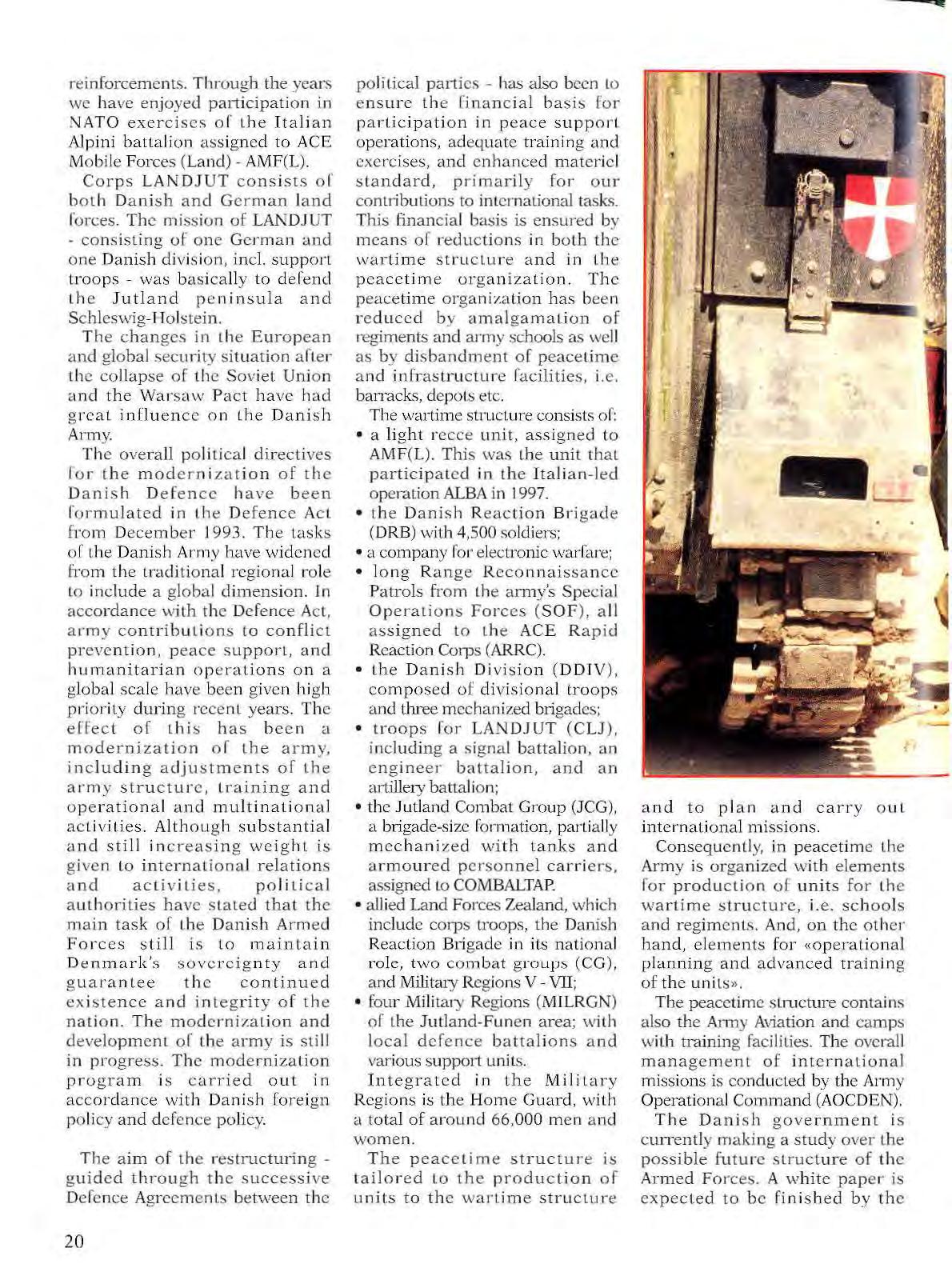
• t he D anish R eac tion B rigade ( ORB) with 4 ,500 so ldiers;
• a company for e lectronic warfare;
• long Ra nge Reconnaissance
P atrols from the army's Special Operation s Forces ( SOF), a ll ass i gned to t h e ACE R apid Reaction Corps (ARR C).
• the Dani s h Div is ion ( DDI V ), composed of div is ional troop s a nd three m echanized brigades;
• troops for LANDJUT (C L J), incl uding a signal battalion , an engineer battalion, and an artillery b attali on;
• t he Jut la nd Comba t Group (JCG ), a brigade-s ize fo rrnatio n, parti a ll y mechani zed wi t h tanks an d arm oured personnel carri ers, assigned to COMBALTA P.
• all ied Land Forces Zealand, which include corps troops, the D anish Reac tion B rigade in its nati ona l role, two combat g roup ::. (CG), a nd iVlilitary Regions V - VII;
• fom Milita1y Regio ns (M ILR GN) of the Jutland - Funen area; vvi t h local defence battalions and various support u n its.
Integrat ed i n the MiliL ary Reg ion s is th e Home Guard, with a t otal of aroun d 66, 000 men and women.
T he peacetime structure is tailored to the production of units to the wartime strucL ure
an d to p l an a nd carr y o ut int er na ti onal miss ions.
Consequent ly, in peace ti me th e Army is organ i zed w ith elements for produ ctio n of un i ts for t he wartime structure, i. e. schools a nd regiments. And, on th e oL h er hand, el ements for «opera tional planning and a dvanc ed t rainin g of the uni tS».
The peace t ime st ru ctw·e contains also the Anny Aviation and camps w ith train ing facilities. The overall man a gemen t of int ernational missions is cond u c Le d by the Army Operational Comma nd (AOCD EN).
The Dani sh gove rnm ent is cwTently making a stud y over the possible future struct ure of the Armed Fo rces. A , vh ite paper is expected to be fi ni shed by the
20
-
end of 1998. So far, there are no conclus ions , but it is stated that the focus of the Army in the future will ren:lain on the ability to take part in internationa l peace support ope r ations.
The Danish Army ass i gns to NAT O a considerable part of its operational capabil i ty. The recently established Reaction Brigade, bes ides being earmarked for out-of-area interventions, has been assigned Lo a British Division of ARRC. Has the Brigade already reached its Cull operational capability?
The Danish Reaction Brigade is the main Danish contribution to NATO's reaction forces. It was
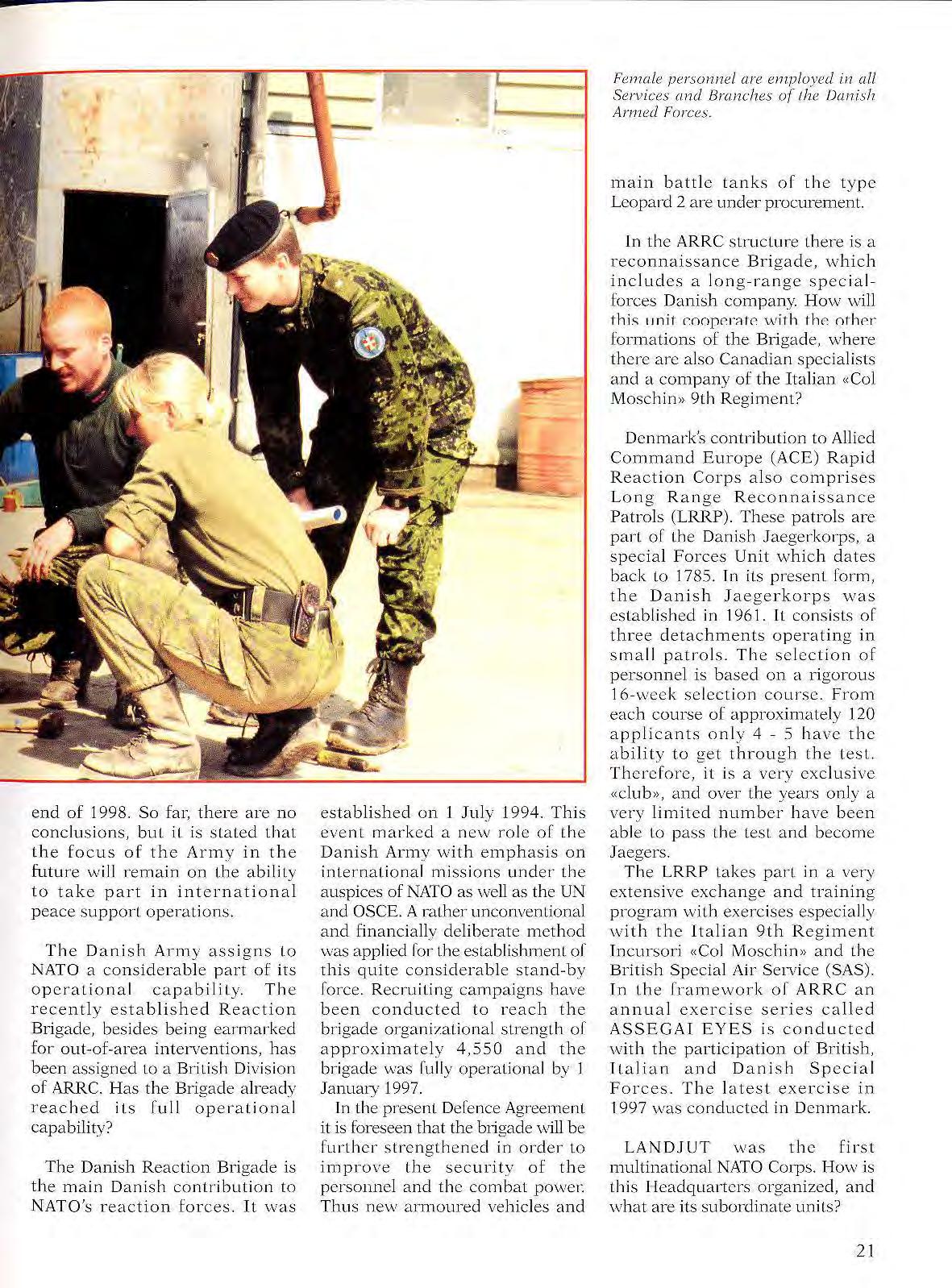
established on 1 July 1994 This event marked a ne\.v role of the Danish Army with emphasis on international m issions under the auspices of NATO as well as the UN and OSCE. A rather unco.nvenLional. and financially deliberate method was applied ror the establ ish.rnent of this quite considerable stand-by force. Recruiting carnpaigns have been conducted to reach the br igade organ izationa l sLrengLh of approximately 4,550 and the brigade was Cu lly operational by 1 January 1997
I n the present Defence Agreement it is foreseen that the brigade will be further strengthened i n order to improve the security of the personnel and the combat powec Thus nev,: armoured vehicles and
Female personnel are employed in all Services and Branches of the Danish Anned Forces.
main battle tanks of the t y pe Leopard 2 are under procurement.
ln the ARRC sLruclure there is a reconnaissance Brigade, which includes a long - range specialforces Danish company. How will this 1mit· r.nopcnHP. with thP. nthP.r· formations of the Brigade, where there are also Canadian specialists and a company of the Italian «Col Moschin» 9th Regiment?
Denmark's contribution to Allied Command Europe (ACE) Rapid Reaction Corps also comprises Long Range Reconnaissance Patrols (LRRP) These patrols are part of the Dan ish Jaeger·korps, a special Forces Unit which dates back to 1785. Tn its present form, the Danish Jaegerkorps was established in 196 1 It consists of three detachments operating in small patrols. The selection of personnel is based on a rigorous 16 -week selection course. From each course of approximately 120 applicants onl y 4 - S have the ability to get through the tesL. Therefore, it is a ver-y exclusive «club», and over the years only a very limited number have been able to pass the Lest and become Jaegers.
The LRRP takes part in a very extensive exchange and training program with exercises especially with the Ita l ian 9th Regiment Incursori «Col Moscbin» and th e British Special Air Service (SAS). In the framework or ARRC an annual exercise series called ASSEGA I EYES is conducted with the participation o f British, TlaJian and Danish Special Forces . The latest exercise in 1997 vvas conducted in Denmark.
LANDJUT was the first multinational NATO Corps. How is this Headquarters organized, and \.vhat are its subordinate units?
21
ll is a t ribute to t h e prese nt polit ica l s t abilit y of W estern Eu rope that a multi n a t i o n a ll y m a nn e d Allied headquarters h as exis t e d in th e Northern Germ a n town of Rendsburg since t h e eiJd of Wor ld War II. In its prese nt form , the headq uart ers ' hi s t ory d a t es bac k to 1961 at wh ic h time a n agree ment on the crea t ion of a new com mand organi za ti on for the d efe n ce o f th e B altic Ap p roac h e s was r ea c h e d. As a co n se q ue nce , the Corps w i th h e adqu a rters in Re ndsbu rg w as d es ig nated as Allied Land Fo rces Schles w ig - Holstein and J utland, with a n area of respon sib il ity whi c h also incl uded Hambu rg and the Danish island of Fu ne n. I t was t he n manned b y Am e r ican, B ri t ish, Ca nadian , D an i sh and Ge r ma n p e rson n el. LANDJUT b ecame t he main l and force com p o nent of the t t- i-s e rv ice comm a nd of t he Allied F o r ces
Balt ic Approach es (COMBALTAP), who se h eadquarte r s w as established at K ar up in the Ju tland p eninsu la Thi s conce pt rema ined unchan ge d fo r more than 30 years. T h rou g hout that time LANDJ UT wa s the only multinational corps he adquarte rs in NATO , the foreru n n e r of wh at has become a ccep ted a s the nom1 (s ix o f t h e ei g ht corps in NAT O's Ce ntral R egio n are no w mu ltina t ional). F o Uow in g the J.lssuluLiou of th e W a r s aw Pact, NATO went throu gh s ig nifica nt cha nges in its str u c ture. F rom 1 994 th e headqu art e rs of NATO corps, as a general rule , were non lo n ger funded cen tr a lly by the Alliance , but becam e the financial r esponsib ility of the mos t in vo lved na t ions. Si nce both m aj or co n tr ibut o rs t o LA N DJ UT, Ge rman y and Den m a r k, agreed with SACEUR on t he importance of retaining a multin ational corps
Left
L ow -a l titude antiaircraft system o( the Danish Army.

Faci n g page
M 11 3 t racked vehicles in exercise .
in th e a r e a, they signed a Memorandum of Understandin g Th is m em orandum now forms th e basis for the m a nning and fundi ng o f the headq ua r t e rs and f or p rovision of fo r c es t o th e Corps w h i ch is a part o f NATO 's Mai n D e f en ce F orces. Although th e r e a re pr e s e ntly no American o r Canadi a n officers in the staff, Headq uar t e rs LANDJUT retain s its int e rn a tional status as a multin ational headquarters.
Th e tasks and the role o f LANDJ UT ha ve changed af t er 1989. T he area o f operation h as been wi d e n ed to incl u de the area south and e a st of Hamb u rg, a nd the ga niso n a rea now includes th e Da ni sh is l a nd of Zea land and th e Gem1an Bunclesland MecklenburgVorpomm er n. Furthermo re, emp has is has changed to N ATO's dialo g u e o f c o-opera ti on and pa r t nersh ip w ith the Easte rn Eu ropean co u n t r i e s . The ma in b odies of LANDJUT are tod ay th e Danish D ivis i o n and the 1 4 th Getman Di vis ion.
Furth erm o re , both Germ any and D e nm a r k c ontribut e w it h corps troops.
Headquarters LANDJUT is now in R e d sb urg, Ge rmany; i n vi ew o f P o la nd's immine nt entrance i nto the NATO struc tu r e , t h e De fe n ce Mini sters of P o la n d , Germ a n y a n d De nm a rk have r ec e ntl y plann e d the cons t i tu t ion o f a t r ination a l Co rps. Could t h e establishmen t of this major u n i t modify the organization of th e Danish Army ?
·with t h e P art ne rship for P eace c o- o p e r at i on a nd th e p l ann ed enlargement o f N ATO wit h P o land , Hu nga ry a nd th e Czec h R epubli c, NATO is facing a n e w era . Thi s will affect the Dani sh
22
-·
Army sub sta ntially. Polan d is ex pected to join NATO in 1999, and at the same t ime t h e creation of a new multinational ( P olish, German, Danish) Corps on the basis of LAN DJU T is planned. The nam e of the n ew corps will be Multinational Corps North Eas t (MNC NE). Its headquarters will b e placed in Stettin in Poland. The headquarters is expected to be operat ional fro m the end of the year 2000. The for ces will consist of nat iona l divisions and brigades f rom the three countries: the 12th Poli s h Divjsion, the 14 th G erman Division, an d the Danis h Division. The new corps \Vill fit into NATO 's strategy and be pr·epared for Article 5 operat io ns as well as crisis management, peace supp ort, and hum anitarian missions
De nm ark has mad e known its intention of pa rtici patin g in NAT O's Immediate Reacti o n Force, which is a symbol of Atlantic solidarity. Will Danish soldiers come for thei r training a l so to coun trie s of the Southern Region , like Italy?
Denmark contr ibut es to NATO's Immediate Reaction Forces with a light reconnaissance unit. The unit, of com pany size, participates in ACE Mobile Force (Land) AMF(L)) major actjvili es includin g exercises . From the year 2000, the unit is expected to b e ready also for extreme climatic conditions incl uding winter warfare.

Danish sol diers part icipated in the operations in form e r Jugos l avia, both under the UN flag and within IFOR/SFOR. What less o ns have been le arned from this long peace-mission?
Denmark has a lon g tradition in peace support operati ons. Over the years abou t 50,000 Danish soldiers have parti ci pated in peace keep ing missions, and we have coll ected a variety of less ons l ea rned. Tod ay Denmark contributes almost 1,000
soldi ers to peace sup port ope ratio ns , and ther e are no indications that this number will decrease in the n ear future. For the Lime being, we are considering, in clos e co-operat io n with th e Netherlands and Austria, to contribute to a p eace keeping force to Western Sahara (MINURSO).
Denma rk's p a rticipation in the missions in Former Yugoslavia, first under the UN and late r und er NATO i n IFOR and SFOR, has b ee n of great valu e for t he d evelopment of the Arm y. This involvement has brou ght new challenges for the training and procurement of eq uip n1ent. In view of the lessons learned, and the dev elop ment in peace su pport opera.tions, we foresee a demand for - and the n ecessity of - modem and efficient equipment, which not only will make it possibl e to cooperate and carry out the missions, but even more vital - protect and secu re the participat ing personnel. In co-operation with Estonia, Lat v i a and Lithuania, our engage ment in Fom1er Yugo slavia has a lso been used as a co mmon training platform \.vherc different uni ts fTom the t.hrce Baltic nations ha ve part icip ated as part of the Dan is h Battalion.
A multinational plannin g ce ll for peace operations, SHIRB RIG, ha s bee n operational for some months at Hoevelt Barracks, near Co penh agen Sev e ral Nati ons partecipate in thi s activi ty, and many others have shown a great interest in the projec t. Could this cell be come a Staff, oriented towards peace operations ?
The establis hm e nt of a UN Stand-by Forces Hi gh Readin ess Brigade (SI IIRDRIG) was sta rted in 1994 on a Danish initiative and will be composed of co ntributions from so far 12 co unt ries (Argentina, Austr ia, Belgium, Canada, The Cze ch Republi c, Finland, HoUand, Ire land, Norway, Poland, Sweden, and Denmark). I t is plann ed to become operational in 1999. The h eadquarters is al ready established in Denm ark with staff officers from the troopcontri buti ng countries. It is meant to be abl e - on short notice - to participate in peacekee ping and humanitarian mi ssi ons. The brig ade will be composed of natio nal co ntributi ons accord in g to the so called «U N Stand -by Ar-rangem e nts S yste m » This prac tise will reduce prep arat ions and imp rove procedures, training,
23
«Leopard /;\5» wiLh canzoujla12,e system.
and p lanning to a common basis.
In spring and summer 1997 a Danish reconnaissance company participated in the Multinational Protection Force in Albania. This was the rirst massive Europeanonly peace mission Considering t}1e experience oC the Danish Army has in these operations , what is your assessment of the FMP, where, for the first time, there was a close cooperation among UN, OSCE, EU, WEU and TLaly, which vvas responsible for the entire mission?

The reason vvhy Denmark all the way lJ1 rough has been participating in the Balkan peace support oper·ations should be found in an overall wish for a stab l e and secure Europe. Denmark could not passively
accept the crises in Former Yugoslavia, which escalated and inflicted severe damage to the whole region. Therefore, Denmark also had a dem· wish to be a part of the Multinational Protection For ce (F.MP) in AJbania.
The FMP-mission in Albania demonstrated in the finest way the ability of European countries to co-operate in an international mission. As mentioned, Denmark participated with the light reconnaissance unit which is part of AMF(L). The unit gained much experience in preparing for and deploying to a new mission on short notice.
The professional component is now two thirds or the Danish Arm y personnel; conscripts represent Lhe remain i ng third Is it possible to envisage a further increase in long -term volunteers and a contemporary reduction of the nurnber or conscripts?
The Danish Army is mainly based on a mobilization principle.
In most of the Army peacetime units, conscripts are called up and trained in periods of 8 to 12 months. ACter the tr-aining period , the soldiers are transferred to mobili;.ation status in the wa t time structure. In order to be ready for mission employment, the units must conduct a supplementary tnti ni ng of 4 - 6 weeks. Some units, for instance tank and signal units, are manned by professional soldiers due to the complexity of the maler·iel and equipment Following the mobilization princip le, one of the basic and necessary tasks of the Army is to produce units and forces for the wartime stmcture. Thus the Army is traditionally di vided in a peace time structure and a wartime structut·e This doublestructure has been maintained during the modernization and development of the Army in the nineties.
The intent is to continue this mobilization principle based on conscription.
24
Denma rk has a l o n g tradi tio n for em p l oy men t of f e m a l e personnel in th e Ar med Forces . Fem a le p erso nnel are. employed in all ser vices a nd , a rms, includin g com ba t ar ms. Cu rrentl y, we are co nductin g a campaign lo motivate women furt her to j o in th e ar m e d forces an d make a car-eer i n one of the three S ervices .
The reg ul ar res erve e nab les t h e D a nish A r my t o Lriple i l s str u cture i n a very s h o r t ti me . Conside ting the larg e n u mber of res ervi sts, i s i l pos sibl e to m ain t ain a real int ero perabiliL y betwe e n this c o n 1ponent and the units on a clive servi ce?
As me n ti o ned p rev iously, Lh e Da ni s h Army is base d on a mobil i zation prin c iple. This mea ns t hat a large part of the Ar my i s co mposed b y res e r ve forc es . In o rd er to make re serve fo r ce units me e t requ i t-e d standards, an effic ien t tra i ning sys tem is necessa ry. T he D a ni s h t ra inin g sys t e m in clu d e s B asic
T raining and S upp l eme n tary
Training in order to prepare the u n its fo r Article 5 operation s as m e ntione d a bove. Un its involve d in in t ernationa l and peace s u ppmt operations are su bject to Mi s sion Or i e nt e d T r ain in g of ap proxim a tel y two ' "'ee ks
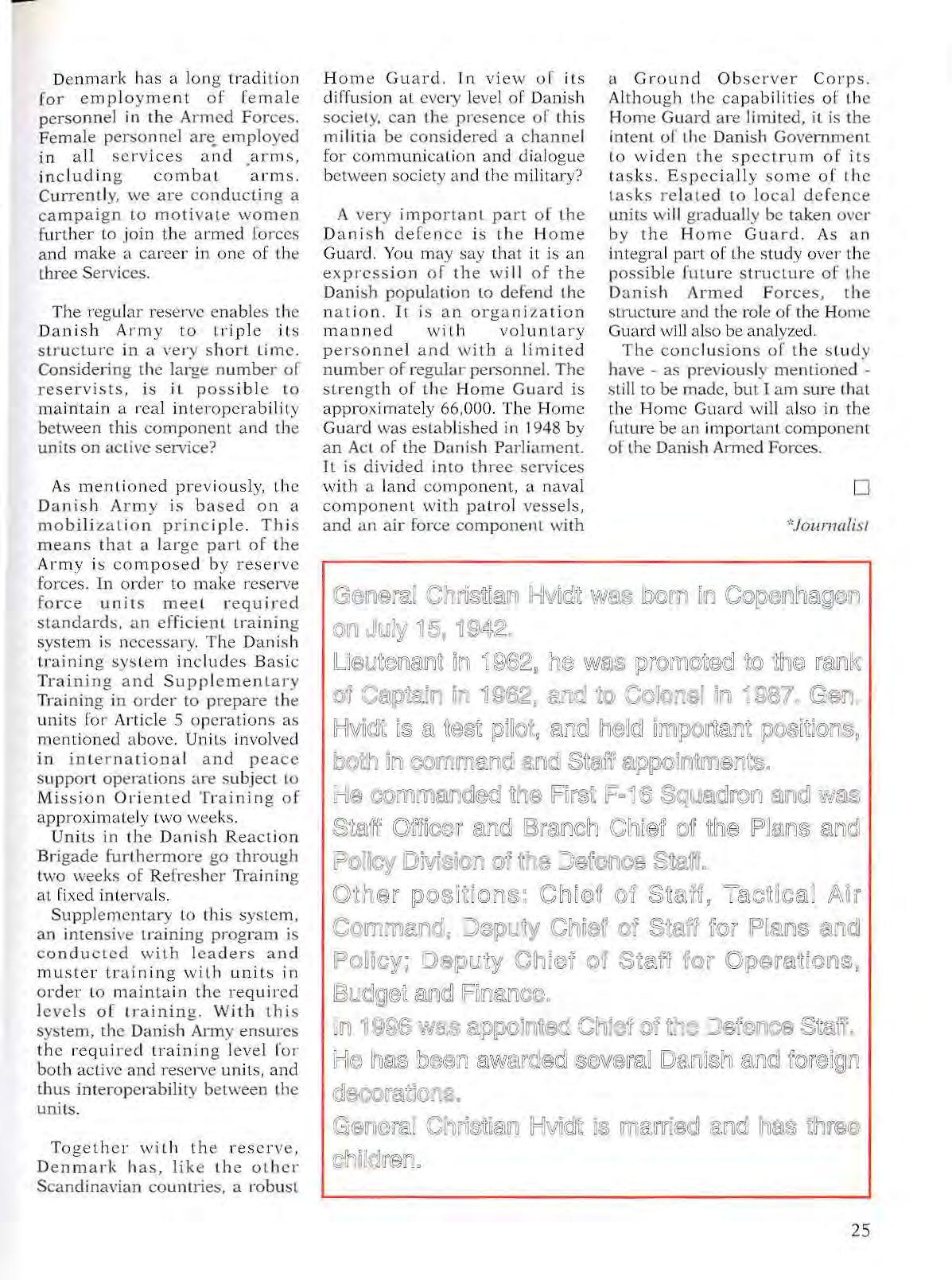
U nit s in t he D a ni sh Re act ion Brigade furthermore go through tw o w ee ks of Re fres her Tr a i ning a t fixed inte rvals.
S u pplemen t a r y to th is s ys t em, an intensi ve t ra i ning prog r am is con du cted with lea d ers and muster t ra ining vvi th units i n order t o ma intain t h e requi red levels of tr a ining. Wi th this
the Danis h Army ensures th e requ ire d train ing level fo r both acti ve a nd r ese r ve units , and t h us i n teroperab ility betwe en the units .
Togeth er with th e reser ve, Den m ark h as, lik e t he ot h er Scand inavian countrie!:>, a rob u !:>t
Hom e Guard Tn vi e w o f its cl i ffu sio n at eve ry level of Da nish society, can th e presence of t his m ili t i a be considered a channe l fo r com muni ca ti o n and d ia logu e between soci e ty a nd the m ilitary?
A very important part of the D a ni s h de fe n ce is t h e H o me Gu ard . You m ay s ay that it is an e xpress i on of the w i 11 of the Danish pop u lation to defend the n at i on . I t is an o r g an i za tion ma n n e d w it b voluntary p erso n n el and with a l im i t ed n u mb er of regular personnel. The s t r ength o f t h e Ho m e Guard i s app rox imately 66, 000 . Th e Home Gu ard was es tab li s hed in 1948 b y an Acl of t he Danis h P arliament. I t is div id ed into three services vvi t h a land c o mponent, a naval com pone nt with patrol vess els , and an ai r force component wi t h
a Grou nd Obs erver Cor ps Althou gh t h e capa b iliti e s o f t h e Home G ua r d ar e limited, it is the intent of the Danish Gover nm e nt lo wid e n t he sp ectru m o f its t as ks. E spec ially so me of th e tasks re l ate d t o local d e fence units wi ll gra du a lly be taken over by th e Ho me G uar d. As an i n tegral p art o f th e s tudy ov e r t h e poss ibl e f utu re structu re of the Danish Armed Forces, the stmc tu re and the r o le of the Home Guard 'Will a lso be an a lyz ed.
T he co n c lu s ion s of the stu dy have - as previous ly mentionedslill to b e made, b u t Jam s ure t h at th e Hom e Guard w ill also in t he fu ture b e an impor tan t component of the Danish Armed Forces.
D ·:•Journalist frrl (:Jop®lnrnCBJg©lrl 5; il l " !\ o <1 ' 1. f• ] n }[\..., "A . 'H)) 1 J.U rg·J on @::1d 0©lonst 1ru reil f(®SJt tamoJ b©itJ ku a.eid (CtvmmSltrNii®0J F"'-<J © v,fllal$ Slrudi ol u:t$ I O'Ht®r ©'J AJr ©¥ CJ1 CBJffildl C["'ie1 fll f1© lrll® ®.n·:oJ GtBilllCG)m : liS rr-m1,rrrr1sdl fnlals tlhtr@lCO 25

WME. The human rights oncept characterizes the ntire second millennium, in the West and not only. Its success during the las t two centuries coincides with the diffusion of democracy and the progress ive esta blishment o f the consti tu Uonal State , which guaran t ees legality, co nfers consecratio n to the social contract, rejects the inhumanity of war.
Its remote precedents are the Petition and t he Bill of Rights of seve n teen th-century England and t h e Magna Charta of John Lackland (12 15- 1225).
The substratum nearest to us is the lay illuminist European culture: the Great Revolution's Declaration of the R ights o f M an and of the Citizen laid do wn in 1789 for the national territo ry but signifying France's ambition to show herself as

li berator of the world. Ear lie r s ti 11 , the declaration s of some Ametican states, a n d th e United S ta t es Decla ra tion o f Inde pende nce (1 776).
In pa r a ll el, i n J 8 59 a l ymph spre ads rro m the b lood -covered pla i ns of Solfer ino : the internat i onal law on armed co nflicts generally defin ed humanita r ian l aw , whi c h ge n e r a t e s th e Int e r n a ti ona l Red Cross an d R ed Crescent . Already
in 1864 (First Geneva Convention) it is stated as a norm, su ccessi vely rea ffirmed in oth er treat ies - up to the f o ur Gen eva Co n vention s which i n 194 9 reform ul ate th e e ntire maller, and t o other more recent works - the concept that k i lling or harass in g woun ded a n d/01- cap tured m e n is not onl y o n inhumane but a useless, ind eed a detri men tal act ion, bec aus e if a co mba ta nt kn ows that fall ing in to
THE DEC LARATION OF H UMAN RIGHTS IN ISLAM

t he enemy's hand enta ils death or tor ture, he w ill figh t to hi s l ast breath , he vv i ll neve r s urrende r:
A c en t u r y ag o , agai n st th e shameful «a[faire Dreyfi.tsS >>, and on the sur ge of Emile Z ola's «] 'ac cus e», in France the first League of th e Ri ghts of Ma n was born, which woul d prove essenti al in s upp ortin g the s u bsequ e n t leagu es persec uted b y t h e variot-r s totali tarian regimes.
Human 1ights deriv e directly from God 's law (Shali'ah) and arc therefore bind ing. Dated August 5, 1990 (1 4 lV1uharram 1411 H), this body o f legislation is very s imila r to the UN Declaration, dis cordant in some asp ects an d more advan ced in others , a nd on so me points n ot exac tl y in agreement with th e legis la tio n of o th e r Mus lim s ta tes.
Muha mmad Zam i r, a mba ssa d or of B a n glades h t o I ta ly, a lso accre di ted to Sarajevo an d to th e UN in tern a t ion a l organi zations in Rome (FA O, IFAD, Wo rld Food P rogramme ), cites from th e Isla mic Charter: << h.uman r ights are an in tegral pmt of th e Muslim religion and as a rule nobody ca n susp end them, totally or in part, violate or ignore th em». «Th e s p ecification of even partial untouchability is very important », observes Zam ir . A professional d iplomat, with several university degrees (literature and fine a11s in Dacca, Law in Da cca and Geneva , Arab literature and Arab langu age at Shem la n in Le banon) Zamir has served in both Wcstem and E astern co untries as well as with interna ti onal organizat ions, suc h as the lslamk Conference (IC O, 54 Mos le m m ember countries) in Jedda and UN Commiss ion for Hum an R ights in Geneva
A rea son fo r di ssent with t he Ch art er of '48 s urfa ces i n ar t. 2: « Exc ep t for t he reaso n s provic.kd for by t h e Shar i' ah», it is for bidd en to take anyo ne 's life, maim of infl ic t corp ora l punishments. On the con t rary, de mocra tic non - Mu s]i m co untries largel y reCuse this type of punishmen ts.
On armed conAicts, the ambassador obse1·ve s, mt.3 promotes the spirit o f the Geneva Conventions: it prohibits to kill non -belligerents, such as old people, women and children and maim the ir bodies, as well as ro fel l trees, da m age sto re d crops o r vic tua ls and destroy c ivil ian bui ldings.
Advanced is also the protection of a person 's reputation and honour, «Wich, wi th us, continues a lso in the afterl ife: State a nd society rnust protec t a lso th e dead fr o m any o utrage . The r e fore it i.s permitted to exhume a body for <tn auto psy but no t to des troy and tra nsform a ce mete ry into a bui ld ing gro u nd ».
Anot h e r di ffere n ce eme rges as reg ards marriage. Art.l 6 of the UN Declaratio n states th e right to many with ou t restrict ion of race, nationality o r re li gio n; art S of the Ca i ro D eclaration use s th e some wordin g, o mitting the world «re lig i on» At the sa me time , i t requires S tate and socie ty ro remo ve a ll obstacles and fac ilitate marriage proce dures. «This », exp lains Z ami r , <<is because some Countries, althou gh offic iall y admitting marriages be twee n loca ls and foreigners, actuall y interpose such and so many obstacles as to make them very diffi cult>>
And now we arrive at the women's questio n, \.vich today is prac tically at the co r e of all debates on Is lam . Art.6 of the Ca iro Cha rter, first pmt, cit es: <<Woma n is equal to man as reg ard s h um<tn di g nity , has rights to asse rt a nd d u ties to p er for m; h as h er ow n c i vi l icl enliLy an d fi nan c ia l i nd ep e n d en ce, a n d the rig ht to retain h e r family name and lineage>> The second part s ays that << the h usband is respo nsib le for th e suste nance and welfare of the family »
Contrary to those w h o be li eve that ! slam humil iat es women>>, emphasizes the am bassador, «With us they have not o nly equal dignity, but a w ife has a further right: to be sustained by her husban d , also after the e nd or in temrption of their marriage>>. According to the Shari'ah's norm , a man can have up to four wives, w hile the tendency of the modern Moslem states is towards monoga m y Funda men tal everyw here , the family is for Iv1us l ims an hinge based on blood ties ( the Shari'ah, for instance, d oes n o t admit adopti o n ). The protection of chi ldre n is preem in e nt: parents, soc ie ty and State mu st take care of th e ir physic al h e<tlth, e dLtCa te a nd morally ass ist th em (art.7) << T hi s is a con c:P. p t ,, Z<'lrnir co n sider!':, «w ich d oes n o t appear in the Declara t ion of 1948; to g ro \v u p and d e vel op co mp letely , we be li eve that mental h ea l th is as i m portan t as physical health; and, cont..rary to tho se w ho belie ve that Islam is in tcgralist per se, art.9 states that every human being has th e ri g h t to receive both r eligious a nd secular educatio n» .
F urther provisions p r ohibit slavery, usu ry, economic exploitation, terrorism, ins tigation of racial, n ationalist or doc tr inal hatred, decree the right of peoples LO lib erty and self- determ inati on, o f citize ns to freedom of tr avel and reside nce within th e Musli m world, of the politically persec uted to ho sp i tality and prote ction, (unless the y h ave co mmitte d acts cons idered crimes by the Shari'ah) Work is considered a hum an rig ht: «Whi c h >>, spec ifies Zamir, «must be a ssured by th e S tate a nd by soc iety We h ave c ho se n this fo rm ul at ion, altho ugh we kn o w that o fte n th is is not possi bl e be caL•se many I sl ami c s ta tes arc not rich ». Synthesis and fulcru m are the las t tw o <trticles : «All th e r ig hts and lib erties sti pulated in this Declara tion are subject to the Shari'ah» (2 4) an d «th e Shari'ah is the so le source o f r eference to expla in and clarify a ll the articles of th is Decla r a ti on» (25).
Th e Charter was adop ted by the X IX Conference of the Forcing Ministers of !CO, but not ye t by the S ummit Confere nc e, i.e by the Kings and other Heads of State
28
0 n Aug u st 14, 1941 the Atl a ntic Charte r si g n e d by Ro o s cv e lt a nd Churchill on a s h ip in th e open ocean, stat ed the f ull damen tal liberties that sho uld be granted to eve r y human be ing, first of all freedo m from te rror and from nee d.
On December 10, 1948 t he UN G e neral Assemb ly a pproved the Universal Declarat ion of the R ights of Man, w h ich is at the root of the Atlanl.i c Allian ce a nd the Uni t ed N ations.
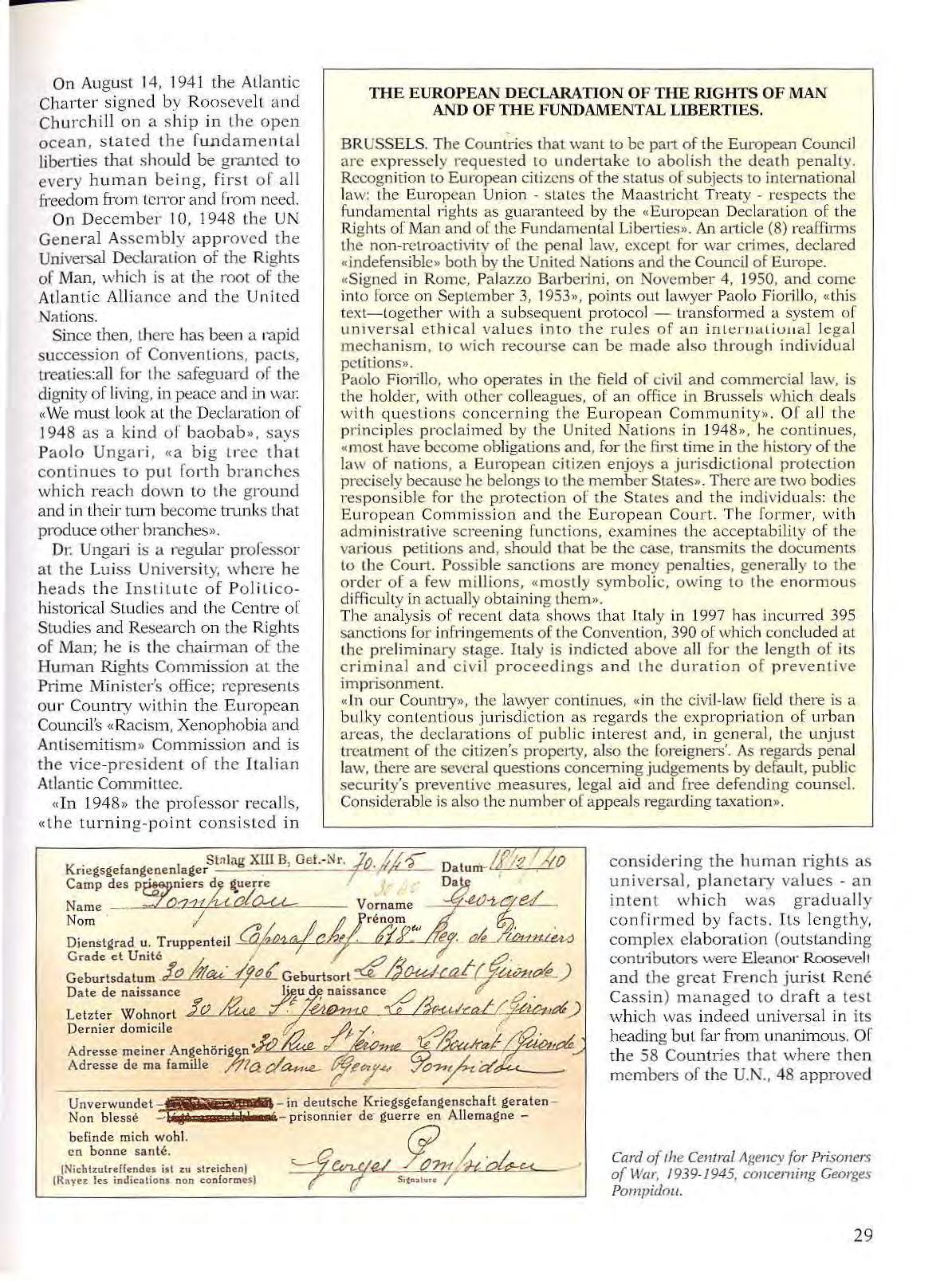
Since then , th ere has been a rapi d succession of Conventions , pac ts, t reaties :all fo r the safeguat-d of the di g nity of Ji\,ing, in peace and in war. «We m ust look at the Declarat ion of 1948 a s a kind of baobab », says P aolo Ungari , « a big t r ee that con tin ucs t o put fo rth branches which reach down to th e gro und and i n their tLm1 beco me tmn.k s th a t produce oth er branches»
De Ungati is a reg ular professo r at the Lu iss University, w here he heads the Insli Lu tc of P ol iti cohi s tmical S tu d ies and th e Ce ntre o[ Studies and R esea rch on th e Ri g hts of Man; h e is th e chait-man of the Human Ri ghts Commission at the Prime Minist er's office ; r·cpresen ls our Co un try within the Eur·opcan Council's « Ra cism, Xe nophob ia <:tnd Antisemitism » Com mission and is t h e vi ce -president of the It al ian Atlantic Comm it tee
«In 194 8» th e proCessor r ec alls, « th e tu rn i n g-po int cons i s t e d in
T HE EUROPE AN DECLARATION OF T H E RIGHTS OF MAN AND OF THE FUNDAMENTAL LffiERTI ES.
BRUSSELS. The Countries that want to be part of t he E uropean CounciJ are ex presse ly req uested to unde rtake to abolish the death penalty. Recognition to Europe an citi :tens of the status of s ubjects to intern ati o nal law: the E uropean Unio n - slates the Maa slricht Treaty - res pects th e f·undamenta l ti g hts as g uarant ee d by th e «Euro pean Declm·ation o f t he Ri g hts of Man and of the Fundame ntal Li berties». An articl e (8) r eaffirm s the non -retroactivity of the pe n a l law, except fo r war crimes, decla red «indefe nsible >> both by th e United Nations and the CmmciJ of Europe.
«Signe d in Rome, Pa lazzo B arbelin i, on November 4, 1950, and come int o force on S e ptember 3, 1953», poin ts out la v.ryer Pao lo Fiorillo, <<this tex t- together with a s ubseque nt p r o to co l - trans fo rm e d a sys tem of universal eth i ca l val u es into the rul es of an inLe r mlliu u al legal mecha nism , to wich recou rse c an b e made also t hr ough petitio ns >>.
Paolo Fiorillo, who operat es in the field of c ivil and commerci al law, is t he holder, with oth er co ll eagu es, of an offi ce in Brussel s which deal s wit h qu estion s c o n c e rnin g t h e Eu r o pean Comm u n i t y>> Of all t he princip les p roclai med by the United Nations in 194 8>>, he continues, <•most have become obligat ions an d , for the first time in the hi stm)' of the law o f na t ions, a European citizen enjoys a j urisdictional protection precisely because he belongs to the member Sta tes>> There are two bodies r es ponsi b le for th e protecti on of the Sta tes an d t he in divi duals : the E uro p ean Commiss ion a nd the Eu ropean Co u rt. Th e fo rme r , w i t h ad ministrative sc ree ni ng fun ct io ns, examin e s the acceptab ility of th e vario us peti ti ons an d , shouJd that be the case, transmits the documents to the Court. Possib le sancti ons are mon ey pe nalties, gener-a ll y to the order of a few millio ns , <<mos tl y sy m bol ic , owi ng to the e normou s difficulty in a ctually obtain ing them>> .
Th e a nalysis oF rec e nt data s hc)\VS that It a ly in 1997 ha s inc urred 395 sanctions for in frin ge ments of t he Conventi o n , 390 of which co ncluded at th e prelimina ry stige. Italy is indicted above all for the le ngth of its crim i nal and civil proceedings and the dur ation of preventive imprisonmen t.
cd n o ur Country>> , the lawyer co ntinues, <<in the civil -law field there is a bu lky contentious j uri s d icti o n as re g ard s th e ex p r o p riation of urh a n areas, t he d eclarat io n s of publi c interest and, in genera l, the unjust trea tment of th e c itizen's property, also th e fo reigners'. As r egards penal law, there are several questi o ns conceming judgem ents b y default, public sec urity's prev en tive measures, legal aid a nd free defend ing counsel. Considerable is also the numb e r of appeals r·egarding taxati o n >> .
consid e r i ng the h uman rights as universal, planetary val ues -an inten t w h i ch vv as graduall y co nf i rm e d b y fa cts. Its le n gthy, complex ela b orati on (o utstandin g con t dhutors were Eleano r· RooseveJt and the gre at Fre nch jurist R cne Cassin) managed to draft a test wh idJ was ind eed univers al in its beadin g b ul fa r from unanimous. or the 58 Coun t ries that where th e n members of the U.N., 48 approv e d
--·
Unverwundet in d eu _ tsche Kriegsgefangenschaft geratenNo n b lesse • ' '' - pr isonnier de · gue rr e en Allemagn ebefi n de mich woh l. en bonne sante. 0 /. / (Ni chlzulrellendes isl zu streicben) "-:-:'Zevu:/e/ t2?-u.1Jtk. (R<tyez )es i n dications non con(ormc s) f /
29
Card of 1he Central Agency for P1i5oners of War, 1939- 1945, concerning Ceorges Pompidou.
it, 8 a bstained (Saudi Arabia, Sou th Afri c an Union, So vi et Union , Byelorussia, Ukraine, Czechoslovakia, P oland, Yugoslavia) 2 were abse nt (Yemen and Honduras) . On th e on e h and some Islamic counlli es (many w e r e still colonies or protectorates) accused the text of reflectin g values typical of a Wes te rn liberal c ullure, and as s uch alien to their unive rse O n the other, the «So c ia li s t » Countries complained for its s carce atten ti on to economic and poli tic al ri ghts. In particular Soviet Foreign Minis te r Vyshinskij former Publi c Prosecutor in the trials of the thirties, the years of Stalin's fo un d in th at text the premises of future possible interferences in the sphere of the individua l states' inte r nal soverei gnty».
A well fo u nded wony, conside rin g that in the present time th e r e h as b een a s tre ngthenin g , in speci fi c
Th e firs/. and the last page of the Geneva Convent·io n. ofA ugust 22, 1864.
PRINCIPLE S OF HUMANITARIAN INTERNATIONAL LAW UP TO THE LAST POST-WAR PERIOD.
1856: T he Declaration pertaining maritim e law abolishes privateering in international relations, gove rns naval blockades and regulates th e pr esence of neutral wares on enemy ships (and viceversa).
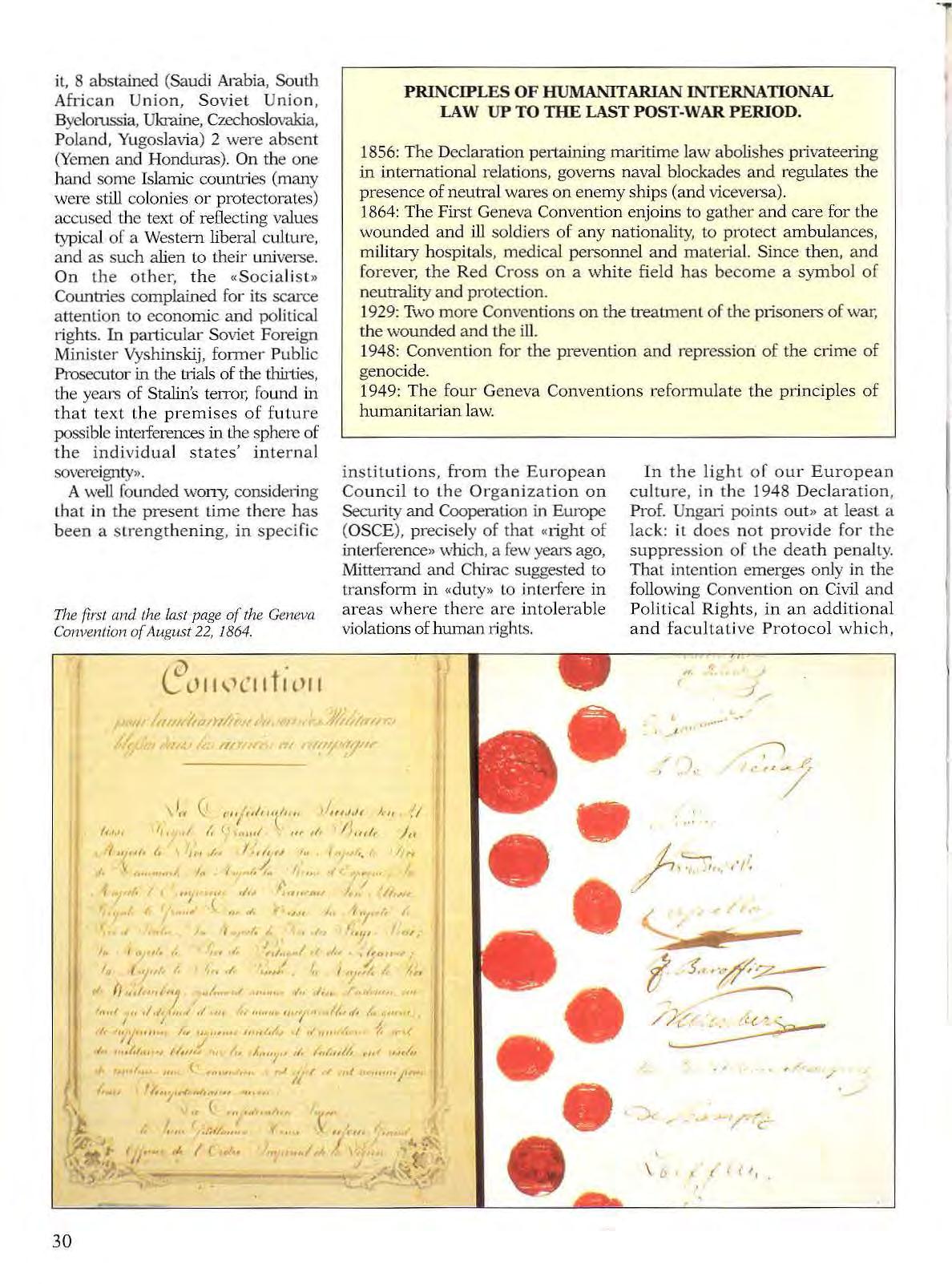
1864: The First Geneva Co nvention enjoins to gather and care for the wounded and ill soldiers of any nationality, to pro tec t ambulances, military ho spit als, m edical personnel and mater ial. Since then , and forever, the Red Cross on a \vhite field has b ec ome a symbol of n eutrality and p r otec tion.
1929: Two mor e Conve ntions on the treatment of the p risoners of war, the wounded and the ill.
1948: Convention fo r the prevention and repression of the crime of genocide.
1949: The four Ge neva Conventions r eformulate t he principles of hwnanitarian law.
institut ions, from t h e European Council to th e Org an i za tion on Secu ri ty and Cooperation in Europe ( OSCE), precisely of that «ti ght of interference» which , a fe w years ago, Mittemmd a nd Chirac suggested to transform in «d u ty>> to in te rfe re in areas where there are i nto lerable viol ations of hum an
I n th e li g ht of our E u r opean cul t ure, in t h e 1948 Declaration , Prof. Ungari poi nts out » at least a l ack: it d oes not provide for th e suppressio n o [ the deat h penalt y Tha t intention emerges only in the followin g Conven tion on Civil and Poli tical Rights, in an additional and facultative Protocol whi ch,
t2Y · L< ll If \., C: 11 t I t, 11 30
/1. ( ' . . -· j, <----. I / , ,.,, 1 , , t ' f , -
until now, h as not been sig ned by many Co u n tries, inc1udin g si gnifican tly the United S t ates. At p res en t a grea t campa i$ n, le d by Italy, is in p rogress, and last fo r the first tim e , a majority has been re ached a t th e UN in Ge ne va i n favo ur of a pl u re nnial mo ratori um on execu tions.
In this l ap s e of time , hopefully t his penal ty w ill b e ba nished by th e intern a t io nal co mmu nity» .
The world 's progress in hum a n ri ghts in cl ud es the int e rnation a l re pression o f war c r i mes and/o r crimes a,aainst mankind. After many decades of frus trations (the idea was vainly san ctioned b y th e Treaties o f Versailles, 19 19 and sevres, 1920), the Co nventi ons of Londo n and Tokyo respectively gave birth, in 1945/46, t o th e Cou rts of Nurembct-g , for t h e German war crimes, an d Tokyo for the war crimes in th e P acific. T he r ese rvation s, Paolo Ungari recalls, claimed that «they concerned ttials by vi c tors against defeated , established ou tside the p reconstituted «natu ral judge » prin ciple, tha t the se ntences cou ld b e r etroac ti ve fo r acts no t c onsi der ed cri me s whe n th ey occurr-ed (or don e in ob ed ience t o s up e rior orders ) and tha t the procedure was like\.vise formu la ted on the mom ent. to which the Huma n i ta rian L aw's body of legi sla t i on, clea rl y p reco nsti tuted, s upplied th e most conc rete an d correct answer; some, nevertheless btin g up «natural law », giving rise to dis putes co ncerning more precisely the philosophy of law ».
Already surfacing in Roman law, th e concep t of crimes again s t mankind is sketched out a bove all in t h e Europ ea n com mo n law o f modern centuries ; th e e xpression «C rim ina juri s gen tium » identifies crimes con<;idered as such not by the law of a single coLmtry or communi ty but by mankind's cons cience itself. «More th a n any th in g e lse >> th e professor co n s iders «it was a very noble idea, cul tural or do ctrina l, o f some jurists In his treatise «De jure b e lli ac pac is», Alb er ic o Ge n til i argu ed with Mach iavel li who maintained that in war there are no
j.'. 7!
Documents o{the C.'mtral Agency fo r Prisoners o{War, 19 14- 1918, con cerning Charles de Gaulle (left) and Mau rice Ch evalier (rif!,h t}.
mles ( «blows a1·e not given tlu·ough pac ts»).»
In 1946, the UN Assembly s ta ted that th e Nur e mb e rg regul a tions would be valid as procedure for the futw--c Court. T herefo re th e re are a t prese nt both an in ternation al Penal Code (the vari ous Conventions, which in clud e the one pro hibi tin g the employm ent of ch emical w ea pons and that ordering the belligerents to spare the coLmtries' cultural assets) and a code of procedme. Th e Courts for Yugoslavia (The Hague, 1993) and that for· R\\o'anda (Arusha, 1994) have been se t up on that basis; Italy has given an i mpo rta nt contrib ution to both, to the first. Moreover; in Rome (next JLme and J uly) will be hdcl th e Conference fo r a Permanent International Court, to be instituted shortly, whi ch, s a lis fyi ng at las t the a ncient w ish of the P eace o f Versaill es, should start ft.mctio ning on January 1st, 2000.
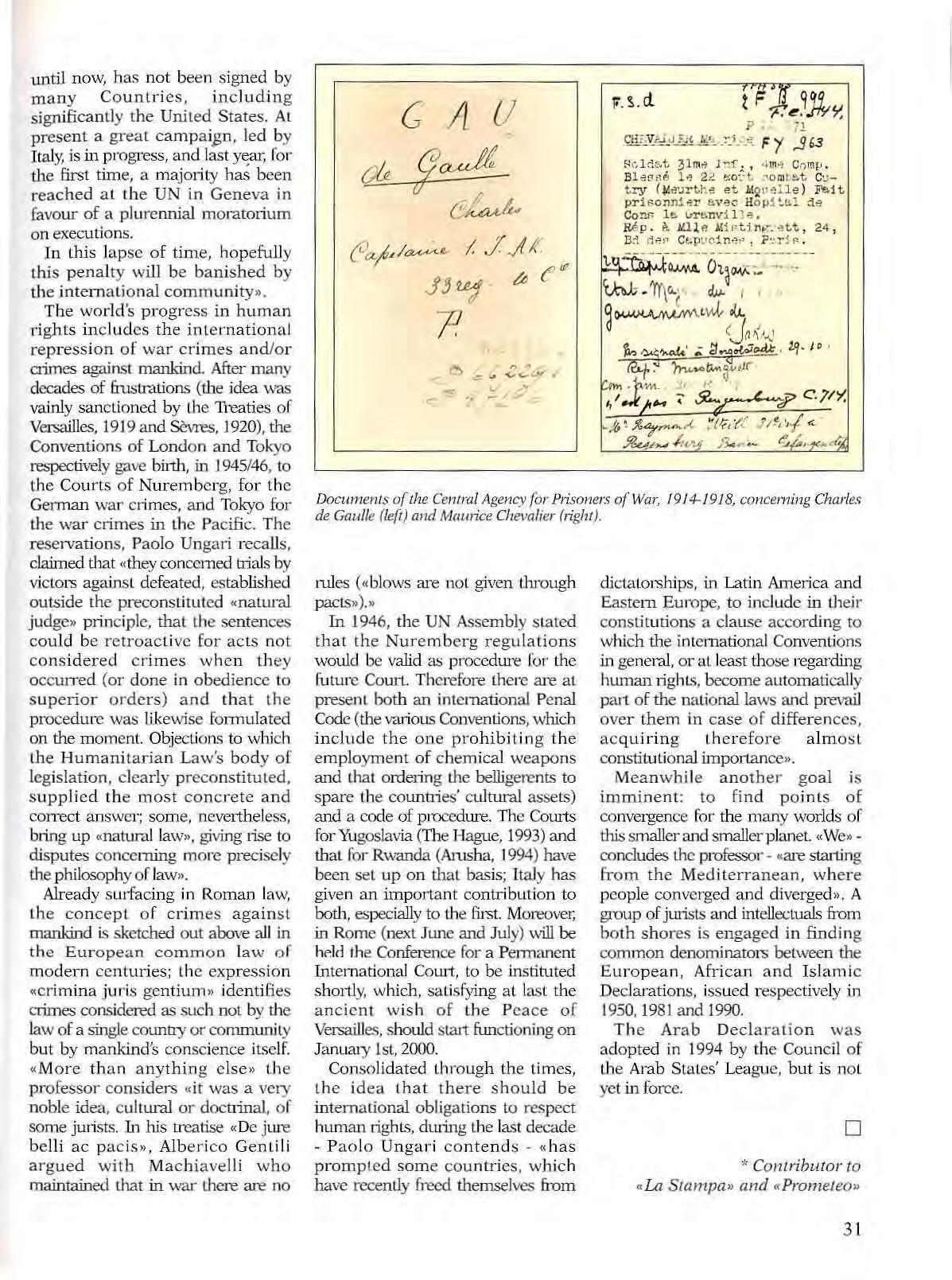
Conso lidated t hroug h the time s, the i de a that the re sho ul d be internati onal obligati ons to resp ect human rights, during the last d ecade - P ao lo Ungari c o ntend s - « has prompted some co untries, w hic h have recen tly freed themselves from
dicta torship s, in Lat in Ameri ca and Eastern Eur-op e, to in cl ude in t he ir constitu tio n s a clause according to which the .inte rnati ona l Conventi ons in general, or at lea'5t those regarding human rig h ts, become a utomatical ly p a rt of the national laws and prevail ove r them in case o f differen ces, ac q ltlnn g th e ref ore a l m o s t constitutional importance» .
Mean whi le ano ther g oa l is i m m i nent: to fi nd points of convergence for the many worlds of this sm aller and smaller planet «We »concludes the professor - «are starting from th e Me diterra nean, w h ere p eople converge d and diverged». A group of jurists an d intellectuals from bo t h shores is engaged in fin d in g common d enominato rs between the Euro pea n, African a nd Is lami c Decla r ations, jss ued r es pectively i n 1950, 1981 and 1990.
Th e Ar ab De claratio n was adopted in 1994 by the Council o f the Arab Sta les' Leagu e, but is not yet in force
Con tributor to cc La Stampa» and «Prometeo»
c Jt u (jJ _ r.
F
CH;':"[lc.:f.!J tit I.:•., F 'f }} 63 Rn ld :? t. ;3l m"' J nf' , Co mp. 1"1 22 e;o;_"t. :-. o ru he.t Cut ry e t Fa:lt p r isonnier avec Hopitel d e le M i Pt i nv..et t, 24 , Bd
t
0
3 1
In order to interconnect the concept of Objective, End State, Centre of Gravity, Decisive Points, Lines of Operation, Sequencing and Contingency Planning, we shall draw a parallel with a chess game whose objective is to checkmate the opponent or compel him to quit (End State, final state/situation). The two kings are th e Centres of Gravity: one's own (to be prote cted) and the opponent's (on which mass, in space and time, must be realized).
After the first skirmishes , each player determines a strategy to checkmate the opponent, and the game can proceed through offensive (against the opponent's Cen tre of Gravity) or defensive actions (to protect one's own Centre of Gravity). The shift from one to the other takes place generally \Nith the application of Contingency Plans, i.e. preplanned actions deriving from experience, carried out, for example, if the opponent's queen
threatens to checkmate at the th i rd move, or to connect the transition from a defensive to an offensive action, or viceversa. Each strategy is based on a set of moves, some of which are decisive for the final result (End State) because, for instance, they open breaches in the opposing deployment, bar the king's escape routes, or int1ict heavy losses. We shall call these moves «Decisive Points>>, in that they display the acquisition of an advantage, and
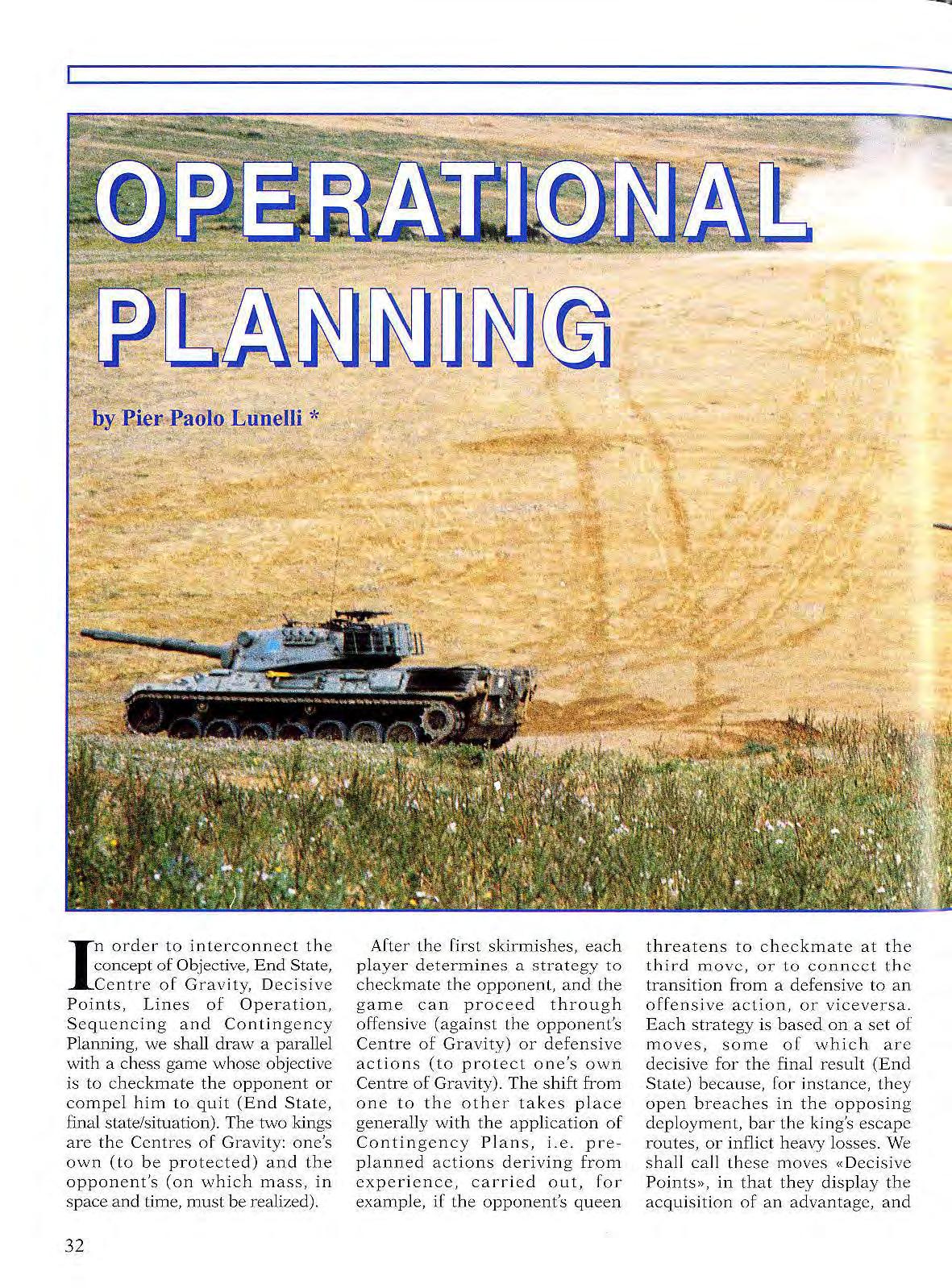
32
are a favo urable p re condi tion for fur tht::r ' lc l.ions.
We shall call Lines of Operation th e whole of these Decis ive Points, b ec a use it is throug h the m that th e m as s is applied in ::; pace and tim e , on the road th a t leads to the opponent's Centre of Gr av ity (the King) in order to achieve the End State (c heckmate). T h e examp le at Fi g 1 s hows the part icula r ca::;e of a c hec kmate in five mo v es , ex ec ut e d th r o ug h Lines of Op e ration sy nchr onized towards
I n t h e seco nd install ment we p r o ceed w ith a co n1prehensive s urvey of the basic concepts whic h are the fotmdation of the operational-level n1ultinational joint plann ingg, intend e d as a pro cess which translates stra tegic aims into tactical acti on s .
In particular, we expound the operational -plannin g concepts appli cable to sym metric conflicts, s uch as:
D e cisive Poi nts, Line s of Operati on, Phases, S eq uencing , Contingency Planning , Culminating Point. All th ese, togeth er with the Centre of Gravi ty and the End State, already examined in the previous article, are called - in NATO jargon - «co ncepts of Operational Design» and help the opera tional Commander to prefigure how his campai gn will develop, in order to achi eve the strategic objectives ass igned to hi m .

Moreover th e art icle illu stra tes the process o f Campaign Pl anning, or - to p ut it better - how the co n1bination of the abo ve e lements, w ithin the framewo rk of a cognitive -conceptual process, leads to the definition of the Campaign Plan. The next issue will contain th e plannin g vari ants that must be adop ted in case of Peace Sup por t Operations . The whole of these notions is an integral part of th e Ba ttle field Vi suali z ation Concept, w hi c h reali zes a powerful and efficie nt i ntegration between the conc eptual and mana ger ial capability of th e Commander s an d th e e normous cap acity of acquisition and manage1n e nt of info rmation mad e possible b y tod ay's advan ced techn ologies. Some of these concepts refe r to t h e t hou ght of Sun Tsu, M ac hiavelli and Clausewit z a nd are already part of the national do ctrine of the co untries of Anelo-Saxon origin, while in the NATO nations they are still in a draft form. They are currently applied in th e planning acti vity of th e ACE Rapid R eac tion Corps (ARRC) .
The methodolo gy expounded in th is articl e does not contradict th e official one. If anything, it a dds other points of vi ew, stimulates d eeper studies and supplies n ew approac h es to those who are about to tackle a planning problem.
33
Model of the chess game (Checkmate in 5 moves)
w ith the emp lo yment of scarce fo r ces and without having to «pay» the damages inflicted to the enemy with one's own losses
(6) The Decisive Points on the road towards the e nemy Centre of Gravity are generally of a ge o g raphi cal nature as, for instance, an obligat01y maritim e li ne of communication, a hill, a city or an air base Th ey can also in clude other elements, as Command P osts, a portion of air space, a transport or communication junction. The Decive Points are not the Centre of but they are the keys capable of opening its acces s doors. (7).
the Centre of Gravity represented by the opposi ng king:
• movement of the queen;
• movement of the pawn;
• movement of the tower.
Sequenci ng is a follow s:
• queen threatens opposing king;
• pawn bars king's escape route;
• tower chec kmates king;
• queen threatens king;
• queen (or tower) checkmates king (End State)
Still fo llowing the parallel, we can say that while the action of the pawn can be considered a «C lose operation» , th ose of the q u een a nd tower a re comparable to two distinct «deep operations»
On the contrary, the action of protecting one's own king has a ll the charac teristics of a «rear operat ion». Deep , close and rear operations take place in bidimensional space (the c h essboard) and in time (five sequential mov es).
As we shall see lat er on, Planning in tenns of End State , Centre of Gravity, Decisive Points, Lines of Operation, Sequencing and Phases presents the advantage of petm.itting a graphical description by applying techniques deriving from ope rational simulation, integrated with Gantt (1) and PERT (2) d iagrams.
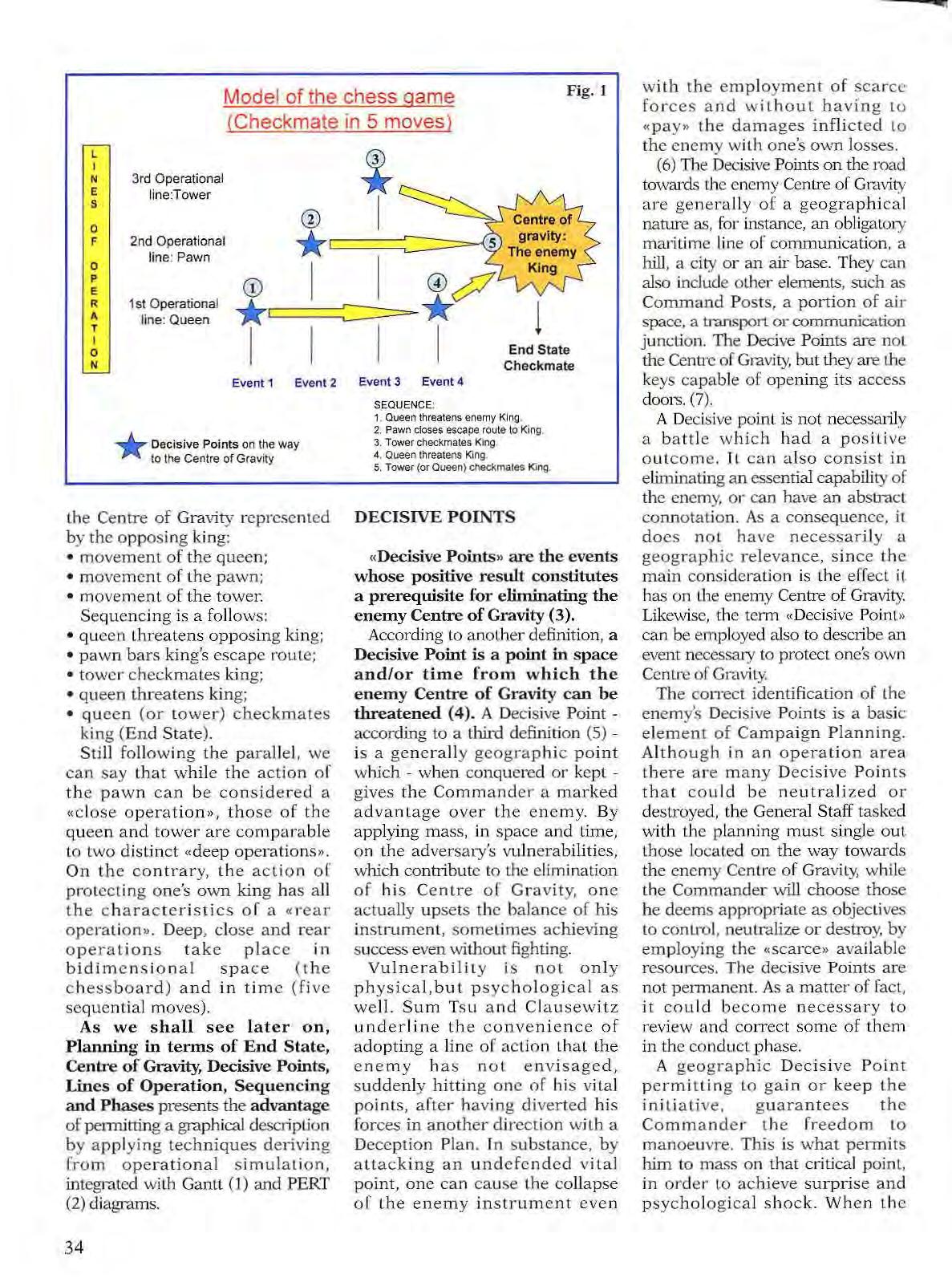
DECISIVE POINTS
«Decisive Points » are the events whose positive result constitutes a prerequisite for eliminating the enemy Centre of Gravity (3).
According to another definition, a Decisive Point is a point in space a nd/or time from which th e enemy Centre of Gravity can be threatened {4) A Decisive Pointaccording to a third definition (S)is a generall y geograp hi c point which - when conquered or keptg ives the Comm ander a marke d a dvantage over the e nemy. B y applying mass, in space an d time, o n the adversary's vu lnerab ilities, which contribute to the e limination of his Centre of Gravity, one actually upsets t h e balance of his instrument, sometimes achieving s uccess even 'vvithout fighting.
Vulnerability is not only physical,but psy cho logical as we ll. Sum Tsu and Clausewi tz und erline the conven ience of ado pting a lin e of action tha t the enemy h as not env isaged, suddenl y hittin g one of his vital points, after having diverted his forces in another direction w i th a Deception P lan. f n substance, by attacking an und efended vi tal point, one can cause the colla pse of the enemy instrume nt eve n
A Dec isive point is not necessarily a battl e which had a positive o ut come. It can also consist in eliminating an essential capability of the enemy, or can have an abstract coru1otation. As a consequence, it does not have necessarily a geographic relevance, s in ce the main consideration is the effect it has on Lhe enemy Centre of Gravity. Likev.rise, the term «Decis ive Point » can be employed also to describe an event necessary to protect one's own Centre of Gra\r:ity:
The cotTect identification of the enemy's Decisive Points is a basic el ement of Campaign Plannin g. AI though in an operation area there are many Decisive Points that cou ld be neutralized or de stroyed, the General Staff tasked \.vith the p lan ning mus t si ngle out those lo cated on the way towards the enemy Centre o f Gravity, while the Commander will choose those he deems appropriate as objectives to control, neutralize or destroy, by employing the «scarce » available resources. The decisive P oints are not p ermanen t. As a matter of fact, it could b eco me necessary to review and co rrect some of th em in th e conduct ph ase.
A geographic Decisive Point permi tting to gain or keep the •n•tlative, g uarantees the Comm ander t h e freedom to manoeuvre. This is what permits him to mac;s on that c 1i tical point, in order to achieve surprise and ps ychologica l s hock . When th e
L
I N 3rd Operational E line:Tower s
0 CD F 2nd Operational * line: Pawn 0 <D I
p E R 1st Operational 1 A line: Queen T I
I 0 End State N Checkmate Event 1 Event 2 Event 3 Event 4 *
Fig. 1
;
I
I
I I I
Decisive Points on the way to the Centre of Gravity
34
SEQUENCE:
1 Queen threatens enemy King
2. Pawn closes escape route to King
3. Tower checkmates Kmg
4 Queen threatens King
5. Tower {or Queen} clleckmates King
The Lines of Operation describe how milita1y force is appli.ed in time and space along the Decisive Points located on t he way lead ing to the en emy Centre of Gra vity
action on a Decis ive Po int causes th e fa ll of the enemy Centre of Gra vity, th e res ult is what Napoleon call e d «t he even t», i.e. a shock determining, on th e material p lane , th e d isabl eme nt o f t he com m uni cat ion, information ami decision net of the enemy instrum ent and, on th e psyc hological plane , panic and disin t eg rati on of th e cohesive bonds of the units (8).
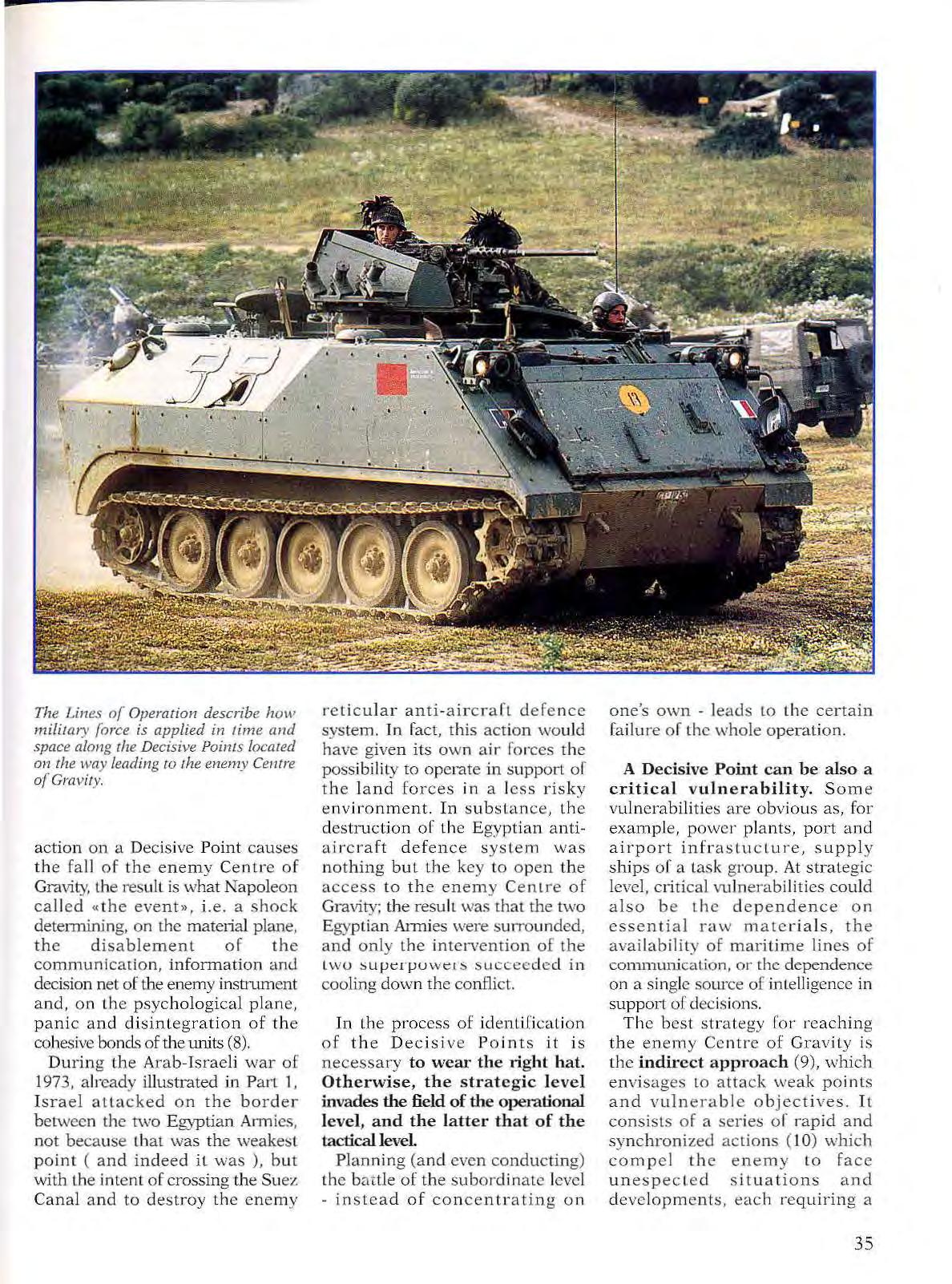
Durin g th e Ar ab -Isr a eli war o f 1973, a lready illustrated in Part 1, I sra el a tt a cked on the bo r d e r b et\.vec n the two Egyp tian Arm ies, no t beca u se th at w as the we a kes t point ( an d i ndeed it was ), b u t with th e int e nt of crossing the Su ez Can al a nd to destroy the enemy
ret ic ular an ti - ai r cra f t defe n ce system. In fac t, t hi s act io n wo uld have given its o wn a ir fo rces t he p ossibi li ty to operate in s u p p ort of the land f o rces i n a less risky e n v ir onment. In substa n ce , t!1 e d estruction of th e Egyptian a ntia ircraft defen ce s ys t e m 'vvas nothing but the ke y to o p e n the acces s to t he enem y Cen t re of Gravity; the resu lt was that the two Egyptian Armies were s u rrou nde d , an d o nly t he int e J\Iention of th e two supeq.Juwe1 s s u ccee d e d i n cooling down t he conflict.
In the process of i d entifica ti on of the Decisiv e Point s it i s nec essary to wear the right hat. Otherwise, the strategic l e vel invades the field of th e operational l ev el, an d t he latter t h at of the tactical level.
Pl anning ( and e ve n cond u c t ing) th e b at tle of t he sub o rdin ate level - instead of co n c e ntr atin g on
one's own - leads to the certa in fa i lu re of the whole operat i o n.
A Decisive Point can be also a critical vulnerab ility. So me v ulne rabiliti es ar e o bvious a s, for example, power plants, port and air port infr ast u c tu re , supply ships of a tas k g roup. At strategi c level, critical vu l nerabilities could al s o b e the d e p en de n ce on ess e nt ial raw mate rials , the aY a i la b i lity of mari tim e li n es of communica tion , or t he dependenc e on a single so urce o f intell igence in support of dec is ions.
The best s tra t e gy ror !"Caching the enerny Ce ntr e of Gravit y i s th e indirect approach (9), which envisages t o at t ack weak points and v ul ne r a b le o b j ectives . I t c onsists of a se r i es o f rapid an d s y n c h ro n ized actio n s (10 ) which comp el th e enemy to f ac e un espe c t ed s ituations and d eve lo pm e nt s , eac h req u iri n g a
35
to achieve air superiority over.the United Kingdom in 1940
Gravity. Nevetheless, when th e Decisive Poin ts, albeit real, are intangible or immaterial their cmmection in a Line or Operation is difficult to achieve, as for instance when they lie in the domain o f e lectromagnetics, psychology, ethics or morc1ls. In these situations, as w e shall see in the third section of this work, they can be joined with f unctional and conceptual links rather then with physical ones.
specinc response. In this context, the opponent cou Id face the dil em ma of having to respond exposing, at the same time , its vulnerable sides. The whole of these ra pid and synchronized actions is defined as «li me» , which measures the speed and r hythm af a military operation. This is in fact a whole of actions and pauses necessary to mount the successive action, and its control is essential if one wants to keep t he Imtlative. The maintenance of a high «time» requires not only the availability of intelligence, in order to locate th e enemy's weak points to be covered with the targ e ting process, but also an adequate decentralization, in order to allow the subordinate Commanders to exploit the opportunities that could arise. «Tune>> and decision -making (11) cycle are closely related. In fact, if the enemy's decision.making process is slower, a series of unexpected attacks against his critical vulnerable assets will prevent him from reacting in an appropriate manner.
Lines of Operation
The Lines of Operation describe how military force is
applied in time and space along the Decisive Points located on the way leading to the enemy Centre of Gravity (12).
With a vie\.v to this, the Lines of Operatio n find the relations among the Decisive Points, ascertain their logical progression and interconnect them, creating a critical route in the direction of the enemy Centre of Gravity.
As we said, the approach to this Centre of Gravity can be either direct or indirect (13) , but the privileged access is through concurrent Lines of Operation, a concept known as twin -multi track approach. ln this way, the enemy Commander reaches a saturation point, in the attempt to respond to multiple Lines of Operation simultaneously applied.
The deception p]an is one of them.
According to another definition ( 14), the Lines of Operation determine the deployment of their own forces in relation to the enemy's.
The Commanders t hen use these Lines of Operation in order to concentrate their combat power (15), applying it in the thre edimensional space and in time, along a space-time cou rse converging on the enemy Centre of
When the Decisive Points are of a physical/geographic nature, a Line of Operation can also b e denned in the same terms. This is the case, for example, \.Vhen one connects the Force from its operational base (vvhere it receives its combat po\.ver) to the operational abjectives (\vhere it applies its combat power against the enemy). Within th is framework, a Force operates through internal lines when its Lines of Ope ration diverge from a central point and enable to modify its gravitation with more rapidity then the enemy's. On the contrary, a Force operates through external lines when the Lines of' Operation co11Verge on the enemy, which means that these operations require more forc es . In both cases, the concept o f Line of Operation coincides with that of manoeuvre through internal and external lines, known for its application in WWI, both by the Central Empires and the Alliance.
The Lines of Operation relevant to modern conflicts can be extended, as we said, to a multidimensional environment which includes, among others, also electromagnetics, ethics, morals, leadership etc. For this reason, the concept of manoeuvre, still valid at the tactical level, does not seem to be sufficient per se to represent them. In fact, the End State is achieved by applying combat power in three-dimension space and in lim e with a logical process which integrates not only manoeuvre, firepovve r, deception,
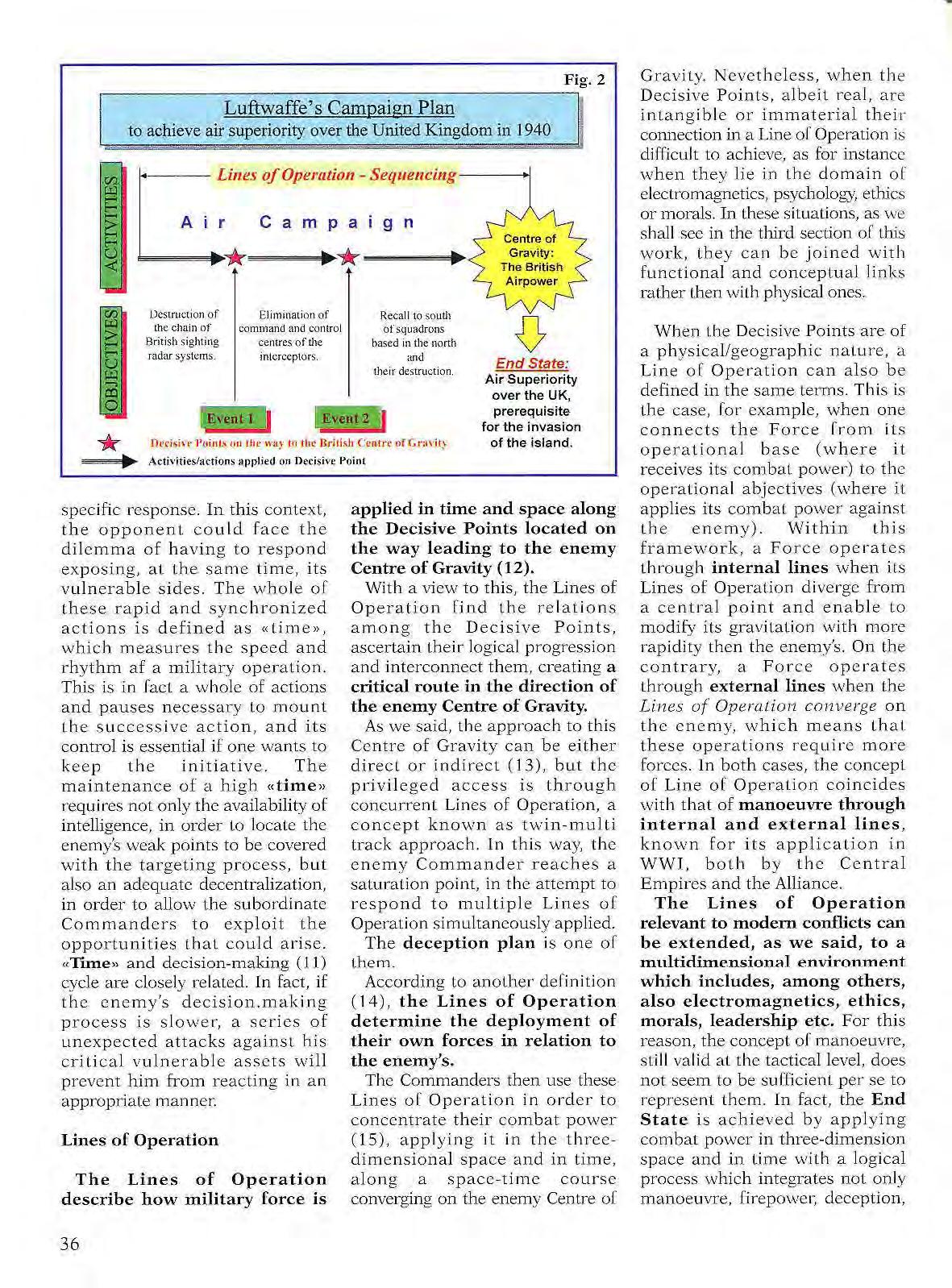
Fig. 2 __pai-gn__
Destruction of El iminati o n of the chain of command and control British sight ing centres of the radar sys tems. in tercep to rs.
* •
Recal I to so uth of sq uadrons in the north and their destruction. End S tate :
Ilcl.'is i..r o n t he t o the Jlrit ish Centre ofGt av ity Activities/actions applied on Ilecisi,•e t>oint
Air Superiority over the UK, prerequisite for the invasion of the island.
36
but a lso command an d contro l wa rfa r e, percepti on ope ra t io n s , p sycho l og ical op er ations and specia l forces, all co n verg ing on the ene my Centre of
Fi g. 2 shows th e P ERT diag ram re l evant to the L u ft\.v a f fe Air Cam paign Plan of 1940, where the End State w as t he acq uisit ion of Air s up eri ority over Britain, as a p rer e q uisi t e for th e s u c cessive invasion o( the is l a nd. Here th e Dec is ive Points are poime d out in a sequence (Events I an d 2) along a Lin e of Operation directed towar ds the enem y C entre of G ravi ty (Ev e nt 3) repr es e nt e d by th e B r it ish a ir power. The Coun t er Offe n s ive Air (COA) ac ti vities mark th e s u ccess ive times of th e eve nts: • desn·uction o f th e e ne m y sighting radar cha in; • el i mination o f th e int e rceptors ' comma nd and control ce ntr-es; • d est ruction of th e reserve s qu a drons, stati one d in th e n o r th of the island an d called to the sout h .
In prac tice, this p l an was not s uccessful, bacause it was modified du ri ng the con d uct ph ase. In fac t , some bom bing action s of the RAF against Berlin- insig nificant also from the tact ica l poi nt of viev,•cancelled the logica l seq uence of events, shifting the G er man counte r-aircraft defe n ce asse ts to a ct i v iti es of escort of bomb in g action s o n Londo n, a n i r relevant obj ective f rom th e operati onal point of vic\.v. In view of t his , the RA F's diverting action on Berlin b ecame a Decisi ve P oint for th e Bri tish, s ince it chan ge d in their favow· the miginal Ge m1an pla n.
Th e Camp aign Plan of Operation « Desert Storm», which presems so me analogies with the p receding ex ampl e, is gra p hical ly shown a t F ig. 3 by a P E RT diagram. The Cen tre of Gravity at ope ra ti o na l l evel was the Repu b li ca n Guard , whose destruction permitte d to a chieve the End S tate at operational leve l, the event «L iberation of Kuvva it and annulm e nt of t h e
D esert Storm Ca mp a ig n P lan Sequenc e of O p era tion Deception Plan
r/) w of Operation - Sequenciug -----+
!=Air Campaign > t:
1st Phase 2nd Phase 3rd Phase
r/) Destru ction an d/or • Disaniculation • Nc utralit.atio n
:.:J > neutralization of of logisti c of Land Forces Campaign CJI systems. NA in Ku\\ait r- defence systems .. Dtsarticulation (AI-OAS) u w and NBC of road and • :-.leu tralization Destntction of Rep ubi ican Guard -, CO Transpon of Rep ub ii<:an 0 • Co ntrol of the sys tems. Guard air.
Jraq i threat to the Gu lf co unnies for the ye;:.1rs to com e»
I n this cas e, th e Lines of Ope rat ion envisa ge d a [our-p h ase a i 1· ca mpaign a nd o ne l and campaign, wh i le the D ecisive Poi nts on the route to the Centre of Grav ity cons isted of three even ts:
• c OLmter-aircraft ac ti vity, combined with t he d estruc.: t i on a n d ne utralization of t he C3I system s and air defen ce sys te ms , as we ii as wit h the capability o f using N BC-capable mjs ile veh icles; air control;
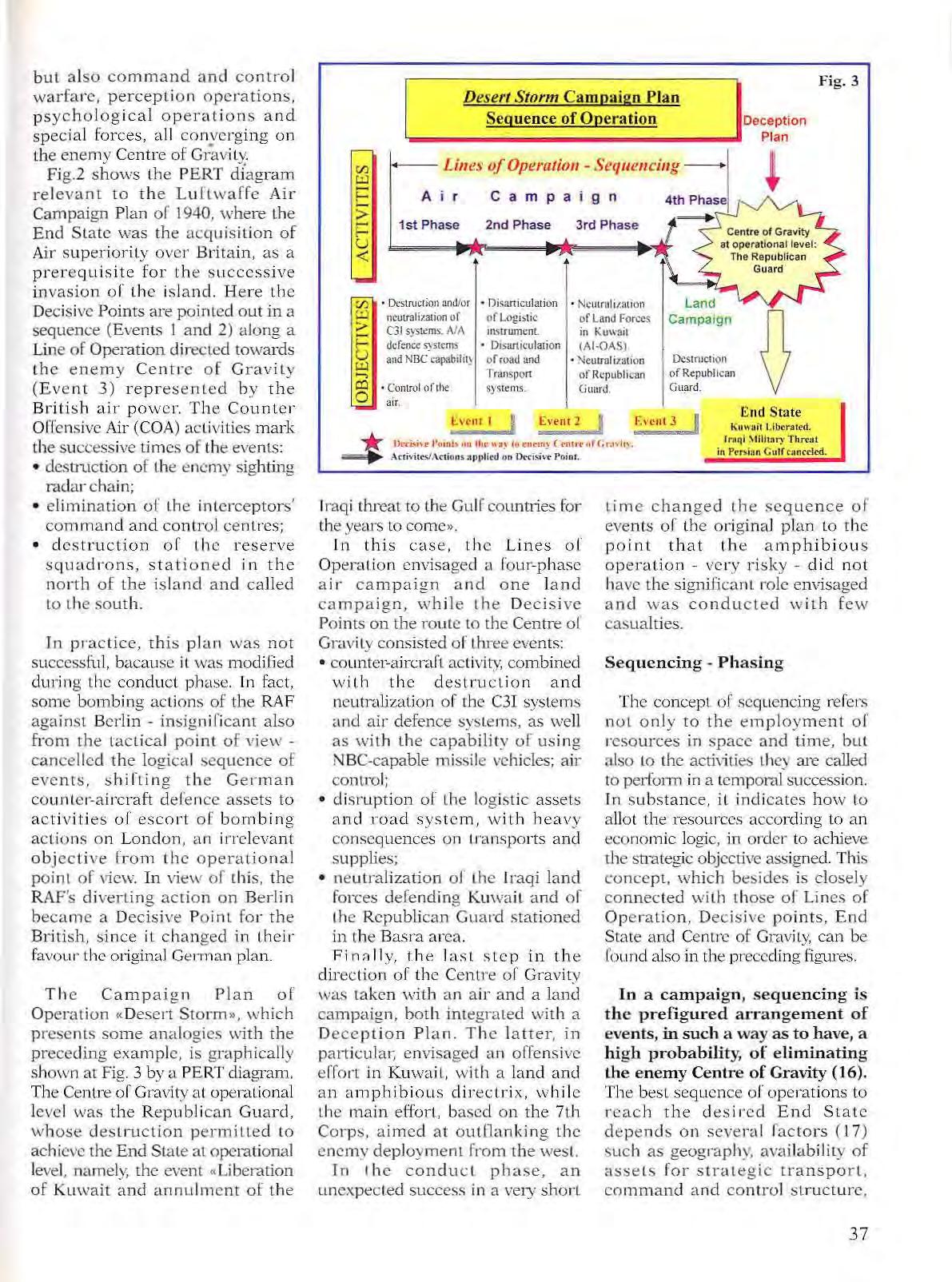
• d is rupt ion of th e log ist ic asset s a nd roa d s ys t em, with heav y co nse quences on tra nspo rts and su pplies;
• n e ut ralization of the I raqi land forces defending Ku wa it and of th e Republican Guard stat ion ed in t h e Basra area.
Final l y, t h e l ast s tep in the di rec tion of the Ce nt re o f Gravity was take n with an a ir and a land campaign, both integrate d wit h a D ece pt i o n P lan. T h e latter, in envisa ge d an offe nsi vc effon in K u wait, w ith a land and an a mph ibi o u s clirec.:t r i x, w h ile th e main effort, b ased on the 7 th Corps, aimed at out11a nking the enemy deployment from t h e west.
Jn the cond uct phase, an unexpec ted success in a very s ho r t
Fig.
time cha n ged the se qLtence o f eve nts o f th e ori gi nal plan to th e po int t hat th e a mp h i bi ou s operation - ve r y ris k y -d id not h ave the significant ro le envisaged and was conduc te d w i th f ew casualt ies.
S e qu e ncin g- Ph as i ng
Th e concept of se q ue ncing re fers not only to th e em ployment of r esources .in space and time, but also to the activities t hey are called to perform in a tempordl success ion. Tn s ubs tan ce, i t. i nd ica tcs ho w to a llot the reso u r ces acc ording to an eco no mic logic, in orde r to achieve the s nategic obje ctive assigned. Th is concept, wh ich besides is closely con n ec ted wi t h t h ose of Lin es of Op e ratio n , D ecisive po ints, End State and Ce nt re of Gravi ty, can be found a lso in the prece ding fig u res.
I n a ca mpai g n , sequencin g is the p refig u red arran ge ment of e ve n ts, in su ch a w ay as to h ave, a h igh probabili ty, of e limina t in g t he e nemy Ce nt re of Gra vity ( 16 ). The bes t se qu ence o f ope ra ti ons to reac h the d es ir ed End Stat e depen ds on severa l factors (17) suc h as geograph y, avail ab il ity of assets for strate gic tr anspo rt, com mand a nd co nt ro l st r ucture ,
3
<
End S ta te J\tl\'t lt i l l ibrrated. lrJH)i Thn•.a1 in Per!ti:tn (;ulr raorc.led
37
(Generation of forces and Liaisons included)
PREPARATION OF FORCES (amalgamallon, training and possible predeployment)
LOGISTIC ORGANIZATION
(Host Nation's logistic support Included)
INTRODUCTION OF FORCE IN THEATRE (or •elnforc:emlnt olln-pllc:e forces)
CONDUCT OF OPERATION
END OF OPERATIONS and IJC)It-contllct actMtlaa
jwiTHoRAwAL oF FoRcE FROM THEATRE 1
VIII CAMPAIGN ANALYSIS (lessons learned, possible review of doctrine)
logistics, public opinion etc. J n any case, the sequence selected by the Commander shoul d have enoug h flexib ilit y to make changes possible throughout th e op e ration.
Th e sequen ce o f the m ai n operations of a campai g n (or the seq u e nce of battles in a m a in ope r at ion) is closely relat e d to th e d efinit i on of t h e campaign phas es , as decided by the Comma nder.
A phase defines a period dudng which the maj ori ty of the forces is engaged in a s pecific activity, such as, for in s tan ce the d ep loyment of a multin ationa l contingent.
A typ ic al jo int/ combined ac li on is struct ured accordin g to the phases show n at F i g. 4. On the other hand, there can be innum e rable variati ons, in re lation to s ituation and miss ion.
Th e g raph on the right of t h e figure s h ows the l evel of reinforcements in the Th eat re (reel) and Lh e weight of the logistic aclivity (blue) through the various ph ases. At this po int, some consi derations appear to be appropriate:
• the phases of j oint /combined o pe r atio ns are never distin c t and can inte rpenetrate, in re lation to
situation and mission. Their number, furth ermore, depends on the assigned mission;
• in case o f operations ou tsi de the contest of a mi lita r y Alliance (the so-call e d <<no n-art.S» o perations, >vvith re fe re nce to the North Atlanti c Trea ty) as, for instance th ose of Peace Support outside the Alli ance area, it is essential to have a leader Nati o n. Op erations of the «art. S» typ e arc instead covered by specific Con tin gency Plans;
• the conceptual a nd organizational activity leadin g lo th e Phase TCampaign Pl an of a multi national operation requires ac tions at the political level, where the so-called «market of forces» ta kes place. In fact, each Nation is called to contribute in re lat ion to its capabilities and its national inte rests in the inte 1·vent ion area; the forces ' identification process is called «Force Gen e ra ti on I Force Nomination. The ava ilability o f Liaison Teams at the different levels of operational and tactica l command is a key cle ment for correct plannin g. T hes e team s should n ot only be able to und erstand mission, op erational concept, doctrine and procedures, bllt also to provide a timely and
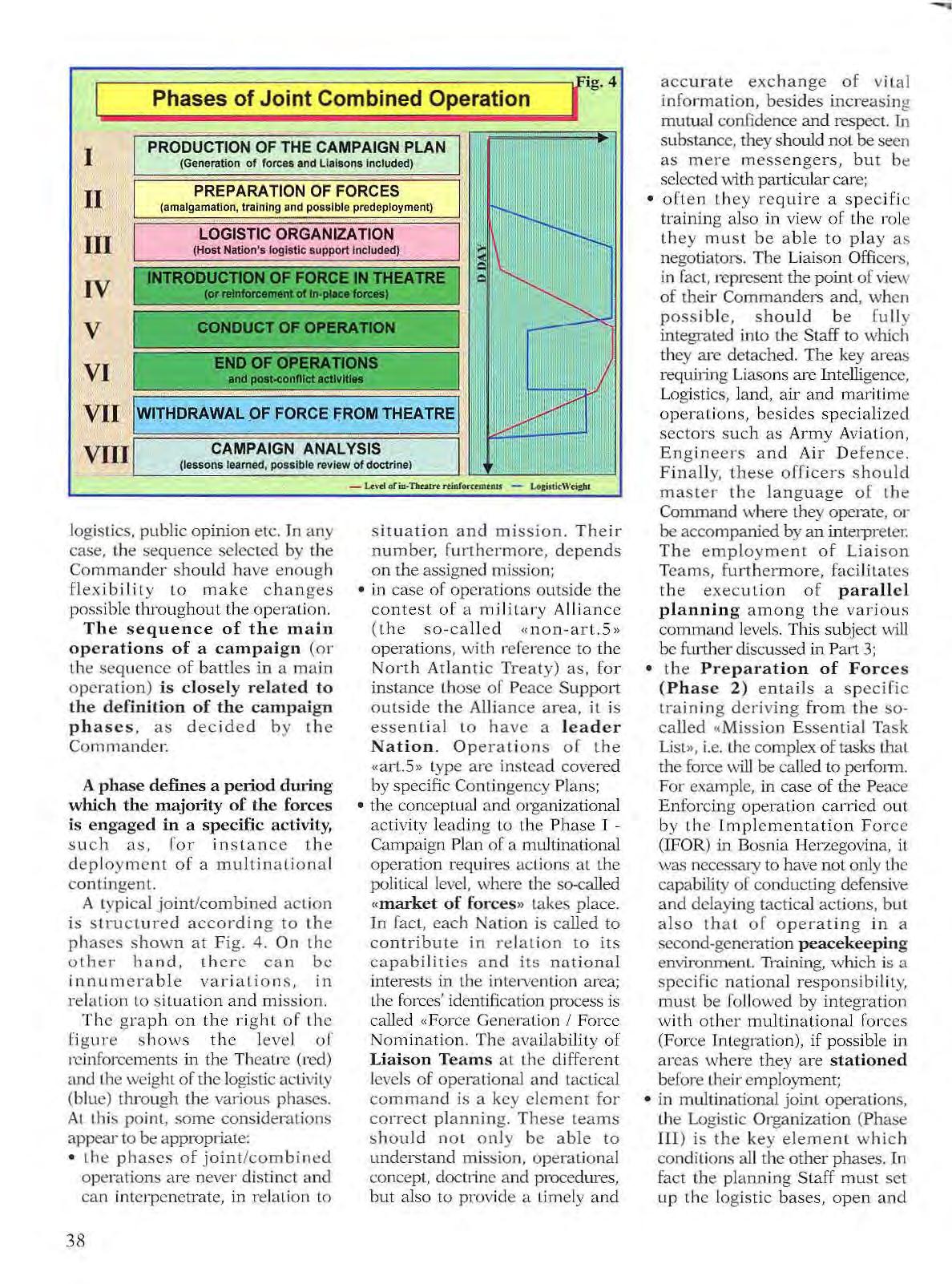
accurate exchange of v it al information, besides increasin g mutual confidence and respect. Tn substance, they should not be seen as m ere messengers, but h e selected with particular care;
• oft e n th e y reqLtire a speci fi c trai ning also in view of the r o le th ey must be able to play as negotiators. The Liaison Officers, in fact , represent the point of view of their Commanders and, when pos s i b l e, sho u ld be fu ll y integra ted into the Staff to which they arc detached The key areas requiring Liasons are Intelligence, Lo gistics, land, air and ma r itim e op en.1 ti o n s , besides specialized sectors such as Army Aviati on, Engine e rs an d Air Defenc e Finally, these officers should master the language o f t h e Command where they operate, or be accompanied by an interpre ter. Th e employment of Liaison Teams, fu rthermore, faci litates the exec u Lion of para ll el p l anning am ong the variou s command levels. This subject will be further discussed in Part 3;
• the Preparatio n o f Forces (P h ase 2 ) entails a specifi c tra in i ng deriving from the socalled «Missi on Essent ial Task List », i. e. the complex o f tasks th at the force v.ill be called to perform. For exa mple, in case of the Peace Enforcing opera tion carried o u t by th e Implementation Fo rc e (IFOR) in Bosn ia Herzegovina, it was necessary to have no t only th e capability of condu cting defensi ve and delaying tactical acti ons , but a lso that of operating in a se co nd- ge n eration peacekeeping environm e nt. Training, which is a specific national responsibility, musL be follovved by integration with ot h er multinational forc es (Force Tnteg ra tion), if possible in area s where they are stati oned before Lb eir employment;
• in multinational joint operations, the Logist ic Organizatio n (Phase Il l) is the ke y element w hi c h condit io ns al l the other phases. In fact th e plann ing Staff must set up t he lo g ist ic bases , open and
I Il
Ill
IV V VI
·vn
38
The preparation of the forces entails a specific trai11ing deriv i11g from the socalled «Mission Essential Task List», i.e. from the complex of tasks that the force 111ill be called to per{or111.

mai ntain t h e Line s of Conu11un ication (LOCs), establish in ter·mediate log istic bases to sustain new phases an d th e suppo rt prio riti es. A historical example is the opera ti o nal pause hy Gen. Eis enhovver on th e Rhine, during v\lvVI I, in order to restore the logistic organization. Operation «Overl ord», conducted in France, was actually structured into s ix separate phases, the first and t he fi fth of which were emin ently logistic:
•• bui ldup;
• • rehearsal;
• • em barkat ion;
•• assault ;
•• build up ;
• • bre akout. Furthermore, the availa bili ty an d contri b ution of a ho st ation in t h e operation Th eatre or in its vicinity is a lso esse ntial, as was pro ved in the Bosnia ope ration, in wh ic h Italy played a key ro le .
• t he introduc tion of the Force in the Theatre (Phase JV ) is probably the most de li cate phase of the operat i on As a ma tt er of fact, th e orde rly and sec ure inflo w is a n es sential p rerequisite for the success of the ent ire operation. As th e old prover b says, «we ll begun is half done». Thi s subject, together w it h t ha t relevant to P hases V, VI an d VII will be dea lt with more exhau stively in the fo llowing para grap h s;
• the anal ysis of the campaign (Phase VIII) at the end of the ope rat i ons teaches l essons whic h are effect ive if they are
re flected in th e doctrine and in the p r eparati o n and trai nin g of the forces. O ne must have the co urage to point ou t t he errors, wit hout recriminations again st t hose respon sib l e Otherwis e, e very furth e r ope ration will take place as if iL were the first, a nd the remun e rat ive value of exper ien ce will be next to zero;
• the transition from one phase to the next makes the f orce vu lne r abl e, beca use, at thi s po int, both mission and co mposit ion/di s pos ition of th e forces coul d c h ange Therefore, the r i sk int ri nsic in th e trans iti on to different p hases must be planned using t h e instrument of Contingency Planning.
Contingency Planning
Contingency Planning i s a process through which possible
39
Sequels
optio ns are nested in the plan, in order to anticipate opportunities or t hreats.
This process gives the Corn m a nder the f l ex i bi I i ty necessary to main tain t h e ini tialiv e beca use, as Von M o ltke reminded his Staff , no plan survives the firs t contact with the enemy Thus, the need to env isage options to ins ert in the plan itself, enabling the Commander to improve his Lin es of Op era tion These options - of the «if... then ... » typ e- anticipat e s it uatio ns w hich could modify th e basic plan, situation s d eriving, for exam pl e, from enemy act ions , availab i l ity of resources, meteorologic or seasonal changes . The purpose of a Contingency Plan , therefore, is to anricipate the scr u tiny and study of possihk P.VP.nls, in order to prefigure t he appropriat e r eac tions as ea rl y as poss ibl e.
T he Con tingency Pl an ni ng pro cess must be a continuous one, so that the Command er n ever finds h i m se l f without options, s i nce this allows h i m lo imp ose hi s own rh yt hm to the operations. Besides , h e must di rect the difficult ph ase of tran si lion between o perations
which logically follow one another. For i nstance, a counteroffensive cou ld be the log ical consequence of a defensive actio n , while a retreat man o e u v re can be roUovved by a cl e re nsive operation. In particula r, at opera tional level these op ti ons are a pplied du ring th e transitio n to a different phase of the campa ig n
In substance, the Con ti ngency Plans, meant as options included in the b asic p lan, point o ut «wh at we shou ld do if event X takes pl a ce , or if we win, lose or f ind ourselves in a stale mate» Th ey are based on on e or more ass umption s and exa mine in detail aspect s SL Lch as:
• prior ity changes;
• changes in command and control re l ations as. for examp le, Tnmsfer of Authority (rrom one Commancle.- lo ano thc1·), c hanges in th e OPCON (18) or the assignm e nt. of a unit unde1· the TACO N (19) of a noth e r:
Some e xamples can clar i[y the conce pt of << bridge » between basic plan and it s possible variants.
After the North Ko1·ean offensive, Gen. MacArthur planned and conducted, in Septembe r 1950 a
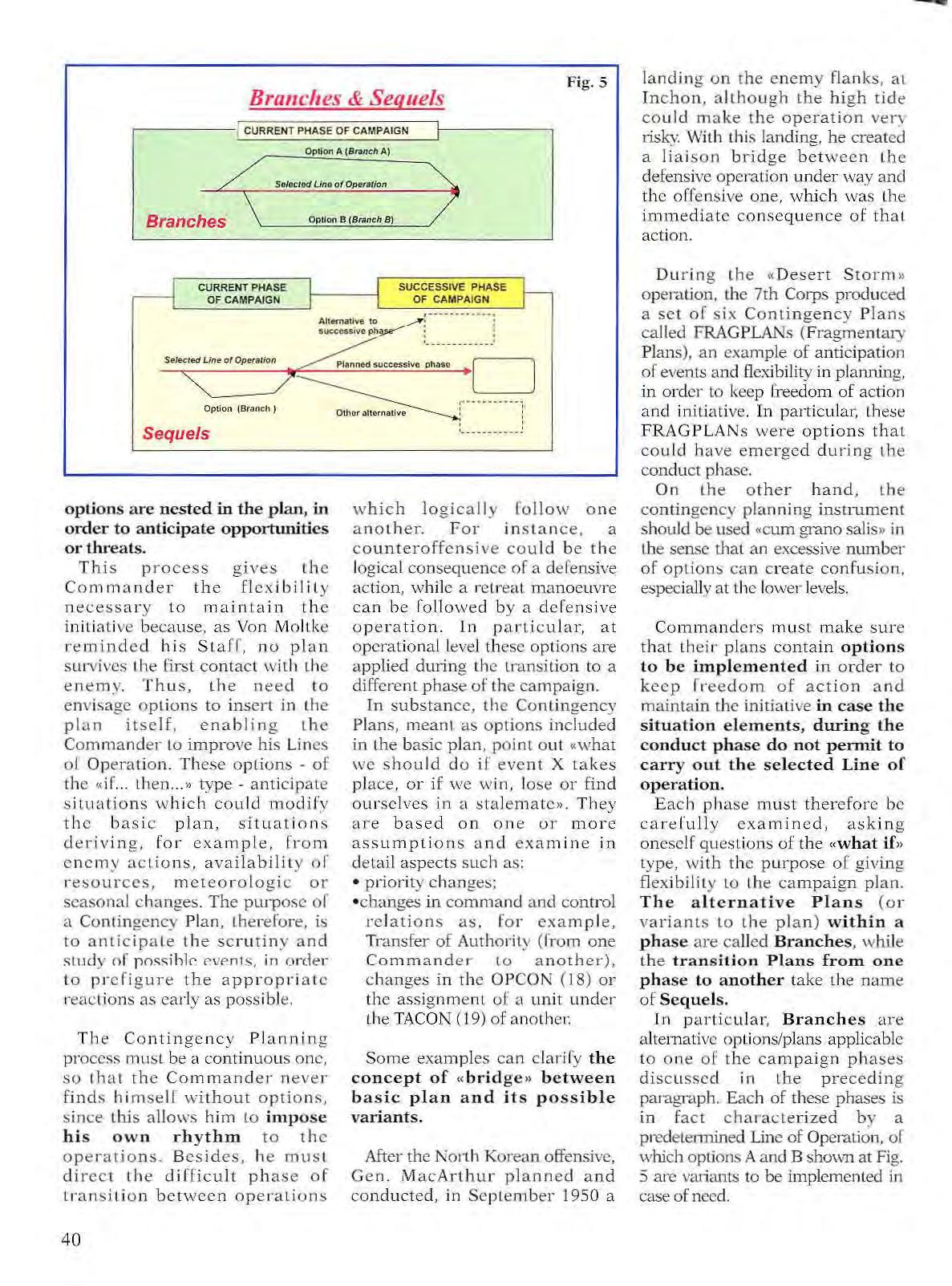
land i ng on the enemy flanks, at Inchon , although the high tide co u ld make the operation very risky. With this landing, he created a liai son bridge betwe en th e defens ive operation under way and the offe ns ive one, which w a s t he imm ediate co nsequ e nce o f th at action.
Durin g the «Desert S torm» operation, the 7th Corps prod u ced a set of six Contingency P lans called FRAGPLANs (F ragmentary Plans), an example of antic ipation of events an d flexibility i n plamung, in order to keep freedom of a c ti on and initiative In par1icu lar, th es e FRAGPL ANs were option s th at could have emerged du ring th e conduct phase.
O n the other ha nd, the co ntin ge n cy planning i nstmment should be used <<Cum grano salis>> in the sense that an excessive numb er of options can create confu s ion, es pecially at t he lowe r levels.
Co mmanders mu s t make sure th at their plans contain options to be impl e mented in order to keep rr eedom of action and mainta i n the initiative in case the situation e l e ments, during the conduct phase do not permit to carry out the selected Line of operation.
E ach phase mus t therefore be carefull y ex amined, askin g oneself ques ti o ns of t he <<what if» type, with the p u rpose o f givin g flexibility to the cam paign plan. The a lternative Pl a ns (or variants to the plan) within a phase are ca lled Branches, whil e the tr a n si tion Plans from on e phase to another take the name of Seque l s.
ln p artic ular, Branches are alternative op ti o ns/plans applicabl e to one of the ca m p aign ph ase!:i discu sse d in the p recedin g paragraph. Eac h of th ese phases is in fa ct characte r i zed by a predete11nined Lin e of Operation, of which options A and B shown at Fig. 5 are vruia.nts to be implemen ted in case of need.
Branch es & Seq uels F i g. 5 .---- CURRENT PHASE OF CAMPAIGN
Line of Operation Branches ;;.. e _ ____, / CURRENT PHASE OF CAMPAIGN SUCCESSIVE PHASE OF CAMPAIGN r -----·•- t Attemative to ..........:• : successive 1 :
Opdon A (Branch A) / So/octod
40 ·-- '
D,...... .. ................ .. ' ' ' ' ' ' ' '
-
Sequels, instead, do not refer to t h e current phase of the campaign, but deter m ine the p o ssib l e o p tions to be carried ou t in the transition(bridge from the current phase to the successive one. These options are op e n, in the sense t hat, once the most appropriate is selected on the bas is of the elements emerged in the conduct phase , it \Vill becom e the Line of Operation of t he subsequent phase of the campaign.
The operations' seq uence in t h e phase of introduc t ion in the Theatre and the exit strat egy.
As was menti oned before, these are very delicate p hases. The rapid introduction of a contingerH i .n order to reinforce a crisis Theatre requires a careful coordination among fo rces which must be categori ze d according to:
• their readiness: Immediate Reaction Forces (TRF); Rapid R e action Forces (RRF) ; Augmentation Forces;
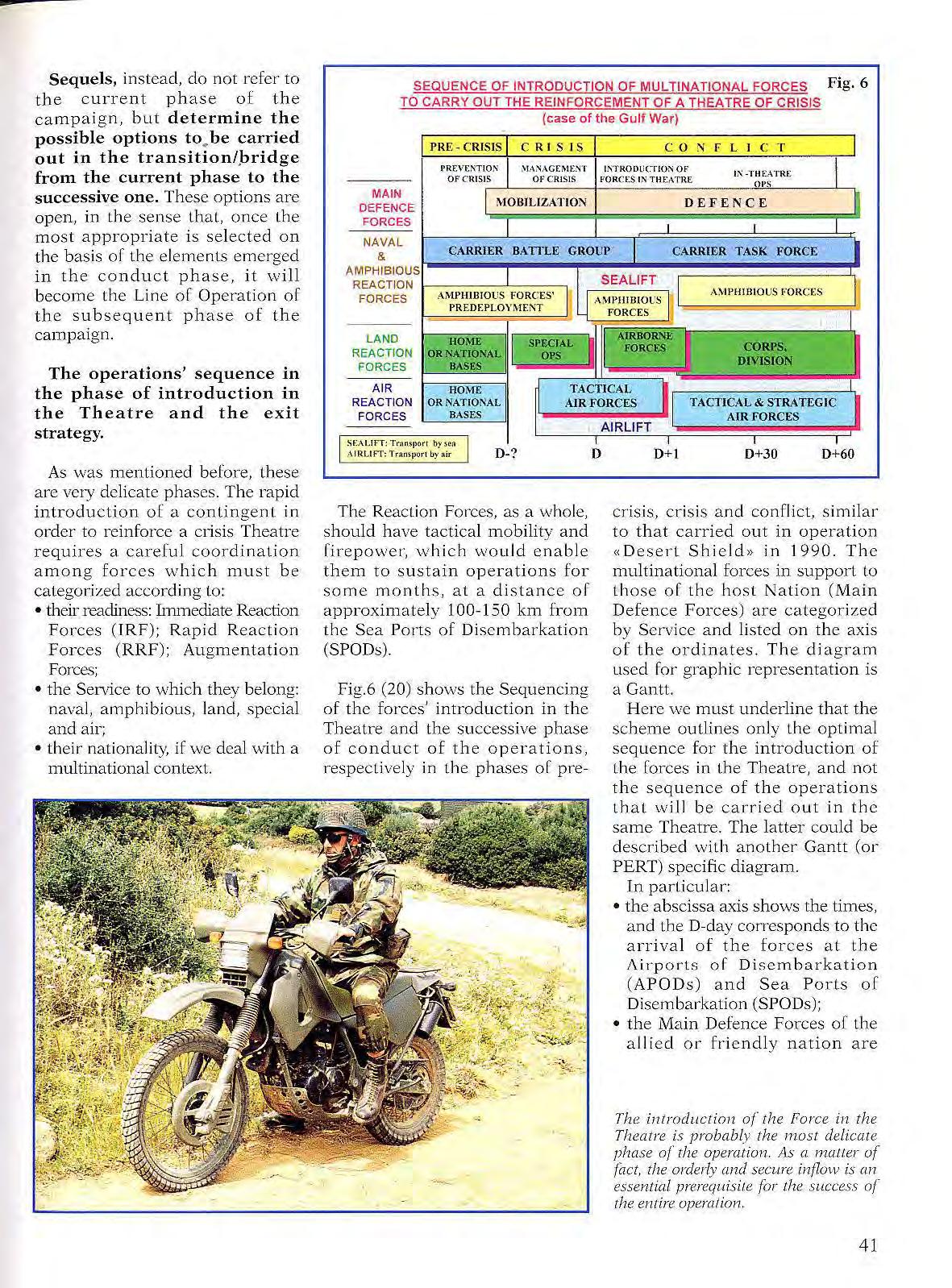
• the Service to which they belong: naval, amphibious, land, special and air;
• their nationali ty, if we deal vvith a multinational context.
SEQUENCE OF INTRODUCTION OF MULTINATIONAL FORCES F i g . 6 TO CARRY OUT THE REINFORCEMENT OF A THEATRE OF CRISIS (case of t he Gulf War)
PRE- CRISIS CRISIS CO :-.: F L I c T
fRf.Vf.NTIOII INTROOUCI'ION
The Reaction Forces, as a whole , should have tactical mobility and firepower, which would enable them to sustain operations f or some months, at a distanc e of approximately 100-150 km from the Sea Ports of Disembarkation (SPODs).
Fig.6 (20) shows the Sequencing of the forces ' introduction in the Theatre and the successive phase of conduct of the operations, respective ly in the phases of pre-
crisis, crisis and conflict, similar to that carried out in operation «D ese n Shield» in 1990 The multinational forces in support to those of the host Nation (Main Defence Forces) are categorized by Service and listed on the axis of the ordina t es . The diagram used for· graphic representation is a Gantt
Here we must underline t hat the s cheme outlines only the optimal sequence for the introduction of the forces in the Theatre, and not the sequence of the operations that wi U be carried out i n the same Theatre. The latter could be des crib e d with another Gantt (or PERT) specific diagram.
In partic ular:
• the abscissa axis shovvs the times, and the D-elay corTesponds to the arrival of the forces at the Airports of Disembarkation (AP O Ds) and Sea Ports of Disembarkation (SPODs);
• the Main Defence Forces of the all ied or fr-iendly nation are
The i ntrodu ctio n of the Force in the Theatre is probably the rn ost delicate phase of' the operation. f ls a maller of fact, the orderly and secure inflo w is an essential prerequisite for the success of the en tire operation.
Of' 11'\ -THEA fRt I - OF C RISIS OF CRISIS f()RC!:S IN Tll<. ,\ TRE <WS MAIN DEFENCE I MOBILIZATION DEFENCE FORCES I I I NAVAL CARRIER BA lTJJE GROUP I FORCE I & CARRIER TASK AMPHIBIOUS SEALIFT ll REACTION ! FORCES AMPHIBIOUS j All') l'IUDlOUS ll FORO:S PREDEPLOHIENT Jl FORCES AIRBORNE I LAND HOME I SPECIAL I REACTION OR NATIONAL OfS FORCES FORCES BASES DMSI ON AIR HOME TACTICAL I' REACTION AIR FORCES 11 TACTICAL & STRATEGIC ] FORCES BASES AIR FORCES I SEAI.JFT : TrtlllSpQrt b y $M I A IR l.IFT: by air D-?
AIRLIFT o I I I D+ l D+30 0 +60
41
replenished through mobilization;
• in the pre-crisis and crisis phases, naval forces, such the Carrier Battle Group can be in interna t ional waters in the operation area, and amphibious forces can be predeployed in the vicinity of the Theatre. At the sam e time, land and air f orces cany out preparation acti\•ities at home or in the national bases abroad;
• in the crisis phase, the employment of special forces could be envisaged (in covert operations), and other units could be given the task of «Showing the flag>>. It is also possible that Command elements o f the multinational forces be deployed in order to conduct the planning activity;
• in the successive phase, beginning on D-day, a Carrier Task Force, amphibious Units, Corps and Divisions, tactical and strategical air forces could be introduced in the Theatre;
• the light -grey background shows the duration of the introduction phase by sea (SEALIFT) and by air (AIRLIFT) towards the APODs and SPODs. It i s not necessary to emphasize that the introduction sequence of the Focces in the T heatre requires a
carefu l coordination, obtained through a specific agency capable of optimiz :ing the capabili ty of reception in th e APODs and SPODs, which are the notorious bottlenecks of the operation. Another important phase is that o f the exit from the Theatre at the conclusion of the mission (End State reached) or vvhen the prerequisites for the forces' presence in the Theatre come to an end. A particular case is the emergency withdrm.val of a multinational c ontingent; thi s should be part o[ a specific Contingency Plan. The golden rule, in these cases, consists in planning how to l eave the Theatre before entering it. The main parameters of the exit phase from an operation Theatre are graphically shown at Fig.7. The post-conflict activities , such as the reorganizat ion of the force, its protection , the transition to peace, connected \Vi th those relevant to the ex.it from the Theatre are represented in blue Logistic s uppo rt and employment o f the reserve appear to be very impo rt ant: their performance must increase, because the former has to manage the complex move.ment system, while the task of the
latt er is to guarantee th e protection of t he forces in this difficult transition phase implementing, if necessary, a specific Contingency Plan.
Culminating Point
In the present decade, the plinciples and concepts expressed by Von Clausevvitz are at the centre of the attention. As regards defensive operations, he says (21): «The success of' the att ack is the result of' an existing preponderance . . . and the material strength runs out little by little It is possible that, nevenheless, the auacker's preponderance increases, due to a proportionally greater weakening of the defende1; but the contrary is true in most cases 11-ze attacker acquires peace tokens of some value for future negotiations, but for this he pays a high price, >vith part ofhis forces »

Von Clausewitz goes on introducing the Culminating Point concept: there are strategic results which have brought about imm ediate peace, but these cases are rare; instead, in most cases, a point is reached when the forces available to the attacker are barely suftl.cient for him to stay on the defensive, waiting for peace ... Beyond th.is point, the situation begins to change completely, and the defender's reaction is to y ield space in exchange for the enemy's
He concludes by stating:
«... Since the attacker's pwpose is the possession of the enemy ten·izory, it follows that the advance must continue until the preponderance is exhausted, a rule that pushes the attar:kr>.r rm rl mom {nrwarrl, towards his goal, bu t can easily lead hi1n beyond it Therefore, the point is to understand what the culminating point of the ofFensive is ».
T hus, the concept of Culminating Point applies to both defensive and o ffe nsive operations (22). In this respect, an operation reaches its Culminating Point when its results can only be maintained and no further advantages are obtainable While
WITHDRAWAL OF THE FORCE FROM THEATRE I
7
rJ) ..J w ...1 w (.) ex: 0 ... I REORGANIZATIOt:J OF THE
I COMPUANCE WITH PEACE AGREEMENT'S I TRANSITIONS TOWARD PEACE I PROTECTION OF THE FORCE LAND FORCES AIRSVPPORT LOGISTIC SVPPORT THEATRE RESERVE NAVAL SVPPORT D+XXX D +XXX
Fig.
PHASES V VI PHASE VII
FORCE
42 I WITHDRAWAL FROM THEATRE H I MISSION
I I " FORCE REDEPLO
D
COMPL ETED
YE
in the o ffensi ve the Cu lminating P oint is the p oint i n spa ce and tim e where th e atta cker's combat p ower does not that of the defen der, in th e defens.ive the d efen d e r reaches his Culminating Poi nt when be has no more capab ili ty to move to the counter offensi ve or eve n to conti n ue his defe n s ive action In other words, the a tt ac ker must cease h is offensi ve and m ove to the defe nsive w h ile, o n the contrary, the d efender i s no more in a positio n to keep his capabil ity of defend ing him self. This is du e to f ac tors such as i nsu fficient lo gistic support , vul nera bility of th e LOCs and cas u a lties suffered in the o ffensive (or defensive) .
The definiti on o f Culminating P oint concludes our discuss ion of the instruments of ope rational pla nn ing, also calle d co ncepts o f opera tional desi gn. In the ne xt paragraph we sha ll see how they are com bin ed in the preparation of the Campaign P lan.
Campaign Plannin g
T he operational Com mander, in i ts v i.s ual izati on (23 ) of the batt l e's spa ce, in order to prepare the Campaign Plan:
• develops a clear knowledge o f the curren t situa tion i n rel ation to enemy and environmen t;
• fix es the desire d End State at operational level, represe nted by the fulfilmen t of his miss ion or the achievement of the assigned s t rategic o bjectives (aims);
• prefigures the optimal sequence of activities (mod a lities) for em ploying his f o t·ces from the present situation to the End State; in substance he connects these elements wit h a b ri dge, whose pillars are the ins t ru ments of opera tional planning;
• points out how he int e nds to app ly his military power (assets) i n sp ace, tim e an d a long the Decis ive P oints located on the w a y to t h e enemy Centre o f Gravity.
Campa i g n Pl anning includ es
3 Conc e ptual Activi
Visualization of the optimal sequence of activities to move from current situation to End State.
@) CAMPAIGN PLAN
first of all a preparatio n phase, where the ex ist in g c ontingency and mobilizati on plans are updated and revi ewed, in order to adapt them to the new si tuation . If t here are no contingen cy plans (a negative fact, s i nce it is a sign of poor foresight), t he process mus t be commence d ex novo.
Cam paign Planning means (24) «to transform the strategic objectives into actio ns at operational and tactical level» whic h , in substance, is t h e app li cation of th e Oper ational Ar t , men Lioned in Part 1. T h e following exa mp les could cl arify t he concept of stra teg ic obj ective.

In the context of the Gulf War (25) the Iraq i strategic obj ectives co u ld have been:
• to acqu ire suitable port-accesses Lo the Persian Gu lFwa ters;
• to control (or mas ter?) th e region's oil reserves;
• encourage Saddam H ussein's inten ti on to become the leader of the Arab world.
1f this was the n at iona l strategy, o n the military strategy's plane it was necessary t o dec ide \Nhat forces had to be allocate d to th e project. This decision had to take into acco u nt, f or instance, t he need to protect the borders with
other e nemy N ations, Iran amon g t he m. At operat ional level, inst ead, it was necessa ry to decide vvhere, when and with what forces th e attac k against Kuwait had to be launc hed. The tacti cal plan do es not need explanations .
From the coalition's point of view, inste ad, the strategic objectives were :
• res tore the lawful government of Kuwait;
• safeguard th e oil su pply from th e Gul f r egion;
• prevent Saddam H usse i n's aspi ration t o become a predominant figure in the region; • s treng hten the Ara b a llies;
• p reser ve the State of Is r a e l. lt is easy to note that t h e aims wer e o ppos e d , and war was inevitab le.
The commander at operational 1evel and his Staff employ the just me ntioned inst ru ments of operational planning to answer the following questions, structured in four steps (Fig. 8):
• what military state situation .(2) (End State) s h o uld be reach ed in order to a ch ieve the strategi c goals? (1);
• is th e b es t sequence of activities/actions (3) to o btain this state/si tuation? l n other terms, which is th e seque nce of events
Operationa
ss Fig. 8 Current Situation Future Situation
l Planning Proce
BCD Determ ination (Goals) ___,""""'.....,""""" _!!!!!'!!!!"""""""""",._"""""+ '----- -" "End State"
(Ends and procedures to ac:hieve them; assets to aUoeate in terms of resourees)
4 3
Campaigrt Pla nnirtg includes a preparation phase, where the existing contingency and mobilization plans are updcued and reviewed in order to adapt tliem to the new situation with the highest probability of achi evi ng the E n d State?
• how can military power - in terms of resources available in space and tim e and in a multidimensional perspective - be appli e d (4) to produce this sequence of acti vi t ies/a ct ions? In other words: what resources, are necessary and how should they be employed to implement the Campaign Plan and achieve the End State?
• what is the risk (5) associat ed wit h the use of this military power?

• The result of this process is the Campaign Plan (4) where the strategic objective ( 1) assigned is connected with th e ends, the ways t o achieve them, as well as with the resources needed to reach them.
•The operational planning process will b e di s cussed in de tail in the third pmt of tlus work. Nevertheless, it is d ee m e d appropr ia t e t o anticipate the analysis of the four questions, furn ishing them with exm11ples h·om nillitary history.
First Question: How can success at operational level be defined? What military conditions must be realized to reach to strategic ends/goals? The answer, although evident in theory, is not aJ<vvays so in practice. The definition of End S t ate is perhaps the most complex aspect o f the question , as proved by the two following examples.
T he North African Cam pa ign (1940 - 1942) was planned by the Germans in support o f Ital y, which was having di fficu lties, to prevent the Bri t ish from ta kin g control of th e Mediterranean. T he Nonh African Theatre, anyway, was consider ed secondary by both the Germans and the British.
Ro mmel, in the co n d u ct phase, was so successful that he considered conquering Egypt; t hi s decision r·equired th e transfer of Ge rman troops from oth er T heatre s T h e la c k of clarity, on the Germans ' part, about the definition of success in the North African Theatre had the effect of comp romising th e s trategic goal, as a direct consequence of th e drainag e of reso urc es from other more im portan t Theatres. The Allied in v asion of ll aly in
W\·\111 is another example of scarce clar i ty of the s trategic goals. What was the purpose? To attract the Gerrnan s to the south in order to strike o n t h e west, or to conquer German y from t he so u th?
Second Question: What is the sequence of events that has the highest probability of achieving the End State? T his question is very impo rta n t for two reaso ns. First, becau se it is unlikely t o reach the s tra teg ic goals with only
44
one operational «m ove » . Second, because it is i mportant tha t th e subordin ate Commanders full y und erstand their mission as well a s th eir ro l e in the hi g h er Com mander's p lan. I n fact, a single ta ct ica l actio n can be irrele vant when not seen in the global context.
In fact , the strategic a im i s achieved only throu gh the attack and destruction of the e nem y Centre of Gravity. The indirect app roach is more desir a bl e, i f it
compel s the enemy to expose its Centre of Gravity. Th P. that f ollov,·s can clarify this co ncept.
In July 1943 th e Germa ns la unched an a tt a ck aga inst Kursk Bulge, on which t h e Soviets had r·ealized a formidabl e defensive system ( action no. 1: prepare yourself), also because they had managed to discover the time and the axes of the allack. \..V i th this advantage, they were tempted to cond uct a preventive a ttack, but
the y let the Germans carry out their plan (action no. 2: wail). The Germ an attack was effectively contained, (act ion no. 3: defen d in depth) and the battle of Prokorovka too k place. Then the Soviets launched a co untero ffensi ve op eration (act ion no. 4: countermano e uvre and hit tbe Cen tre of Gravity) which ended later w ith the conques t of Berlin. (action no. 5: End State).
In short, the operational Comm an d er mu s t first of all determin e the End State (which defines th e suc cess of his operation) and then decide the sequence of the milestones leading to its achievement.
Third Question: What resources are neces sary to carry out the Campai g n Plan up to its conclusion? How will they be used?
T his step i s a logical consequence of the preceding t\.vo, and translate s int o the operational concept.
Gen. Schwarzkopf, during the Gulf Wa r, b eca me aware of the fact that th e available forces were insuffi cient for achiev ing the strategic objectives. He remained firm i n h i s deter mination to launch << Desert Storm» only after the arrival of the requested reinforcem ents into the T heatre .
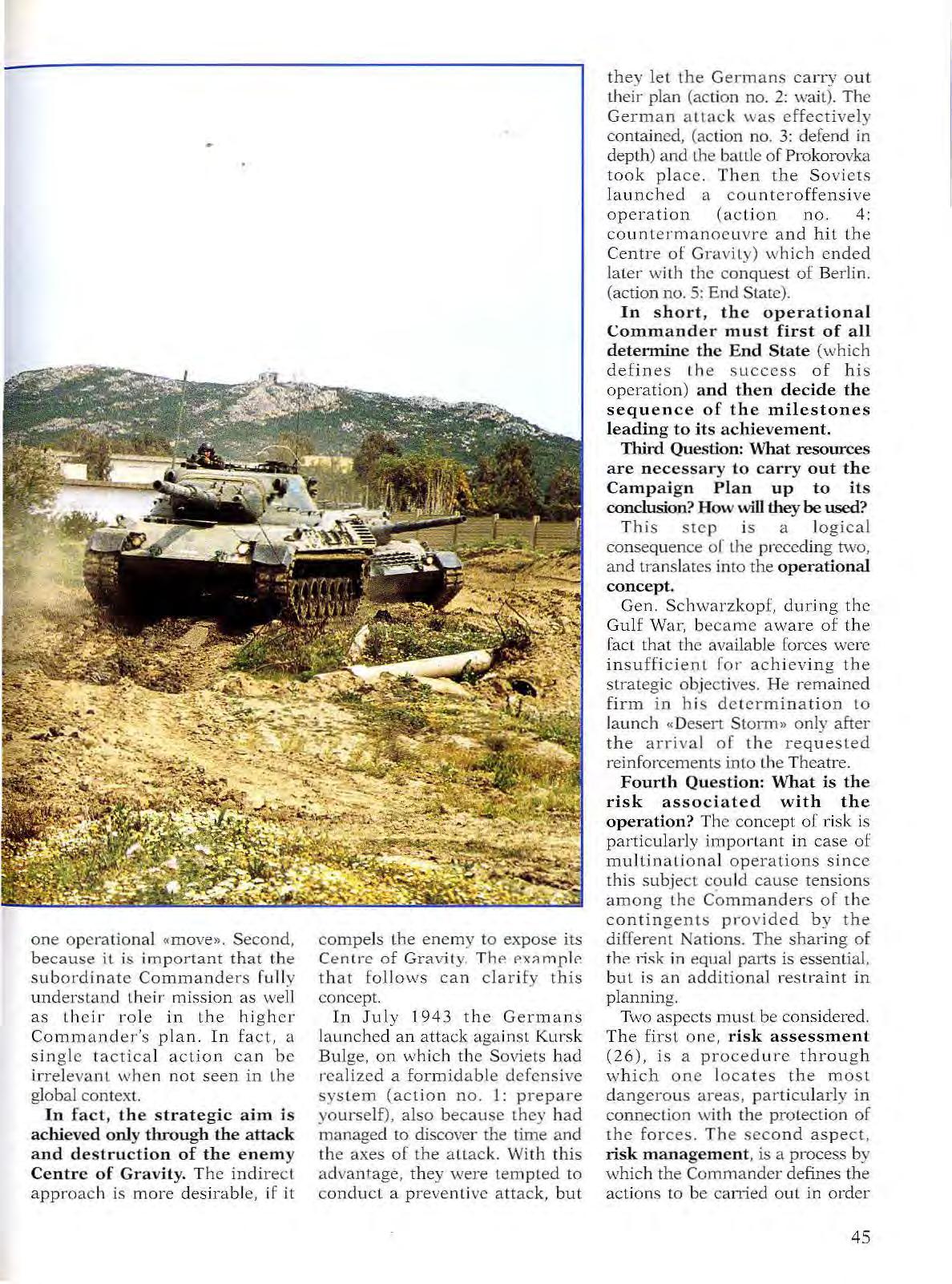
Fourth Questio n: What is the risk associ ate d with the o peration? T he co ncept o f risk is particularl y impo rt ant in case of multinational operations since th is subject cou ld cause tensions among the Commanders of the contingents provided by the different Nations. The sharing of 1i sk in equal parts is essential. b ut is an additional restraint in planning.
Two asp ects must be considered. The first o n e, risk assessment (26), is a proced ure through \.vhich one l ocates the most dangerou s areas, particu larly in connection with the protection of the forces. The seco nd aspect, risk mana ge men t , is a process by which the Commander defines the actions to b e carried oul in order
45
Campaign Planning m ea ns to transform the s lra Legic objec t ives into actions at operational an d t actical level.
to eliminate, red u ce or m inimize t h e risk.
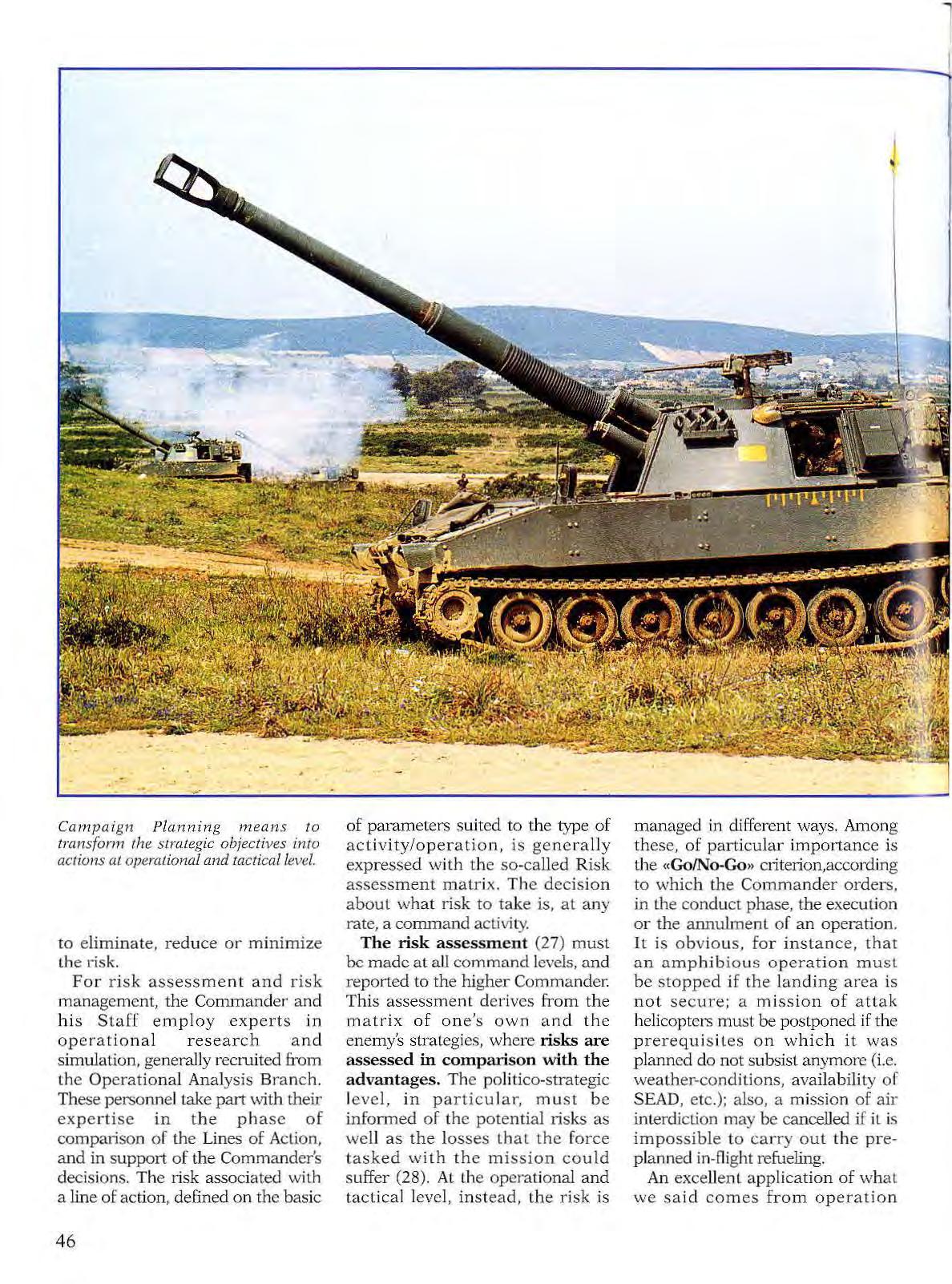
For risk ass essment an d risk manageme n t, t he Conunander and hi s Staff employ exp e r ts in operatio nal resea rch an d simulation, gene ral ly recruited from the Operatio nal Ana lysis B ranch These personne l take part with their expertise in t h e phase of comparison of the Lin es of Action, and in support of the Commander's decis ions. T he ris k asso ciated with a line of ac tion, de fi ned on t h e basic
of parameters sui ted t o th e type of a cti v ity/opera t ion, is gene rally expres sed w it h t h e so-called R i sk assess ment matri x. The decisio n about wh at risk to take is, at any rate, a command activity.
The risk assessm e nt (27) must be m ade at aJJ command levels, a nd rep orted to the higher Comma n de r. T his assess me nt derives from the m atrix of one 's own a nd the en emy's st rat eg ies, where risks are assessed in comparison with the advantages. The po li tico-strategic level, in particular, must be informed of t he potential risks as well as the losses that the force tasked with the mission could suffer (28 ). At t he operational and tac tical lev el, instead, the ris k is
managed in d iffe re nt ways Amon g these, of partic ul a r importance is th e «Go/No-Go » cti t erion,accor d ing to which the Comma nd er orde r s, in the conduct phase, the execution or the annulment of an operation. I t is obvious, fo r instance, that an amphibious operation must be stopped if the l an di n g a rea is not secure; a mi s sion of a tt ak helic opters m u st be postponed if the pre re q uis i tes o n which it was plan ned do not su bsis t anyrnore (i.e. \ovea ther-conditions, availab ility of S EAD, etc.); also, a m ission of air interdiclion may be cancelled if it is impossible to carry out t he preplanned in-flight refueling.
An excellent a p plicati on o f wh at w e sa i d comes f ro m op e r at i on
46
«Ov erlord» in Norman d y. G en. Eisenh ower, the Commander a t operationa l level, opted for a po stponement, co nsiderin g that t h e presence of s t rong win d, l ow clouds and roug h sea in the landing area c ould jeopardize th e success of the operation. Th e ord er «GO» was issued onl y 24 hours l ater (June 6, 1944) wh e n t h e risk a ssociate d wi th the weather conditio ns cou l d be count er balanced by the advantage of sur p rise. Th us 5 ,000 sh ips , 11,000 aircraft and 700,000 men were emplo ye d in one of the most s i gnificant multinational j oint operations. Here Part 2 ends The third and last section of this work will deal \vi th
t h e planning variants concerning P e ace Supp ort Opera tions a n d examine in detail the operat ional Planning Process.
(To be continued) 0
,., Colone l, Commancle 1; 4th Regt AIA Artillery
{9) Lidd el H art, Memoires, Vo l Il , London Cassel, 1965, fro m p 162.
( I O) US F M 100- I Defi nitio n of << T i m e>>.
(11) P P aolo Lunelli: Information Dominance on th e Battlefield, «Ri vista Militare», Eng. Ed., no. 1/98 p 80.
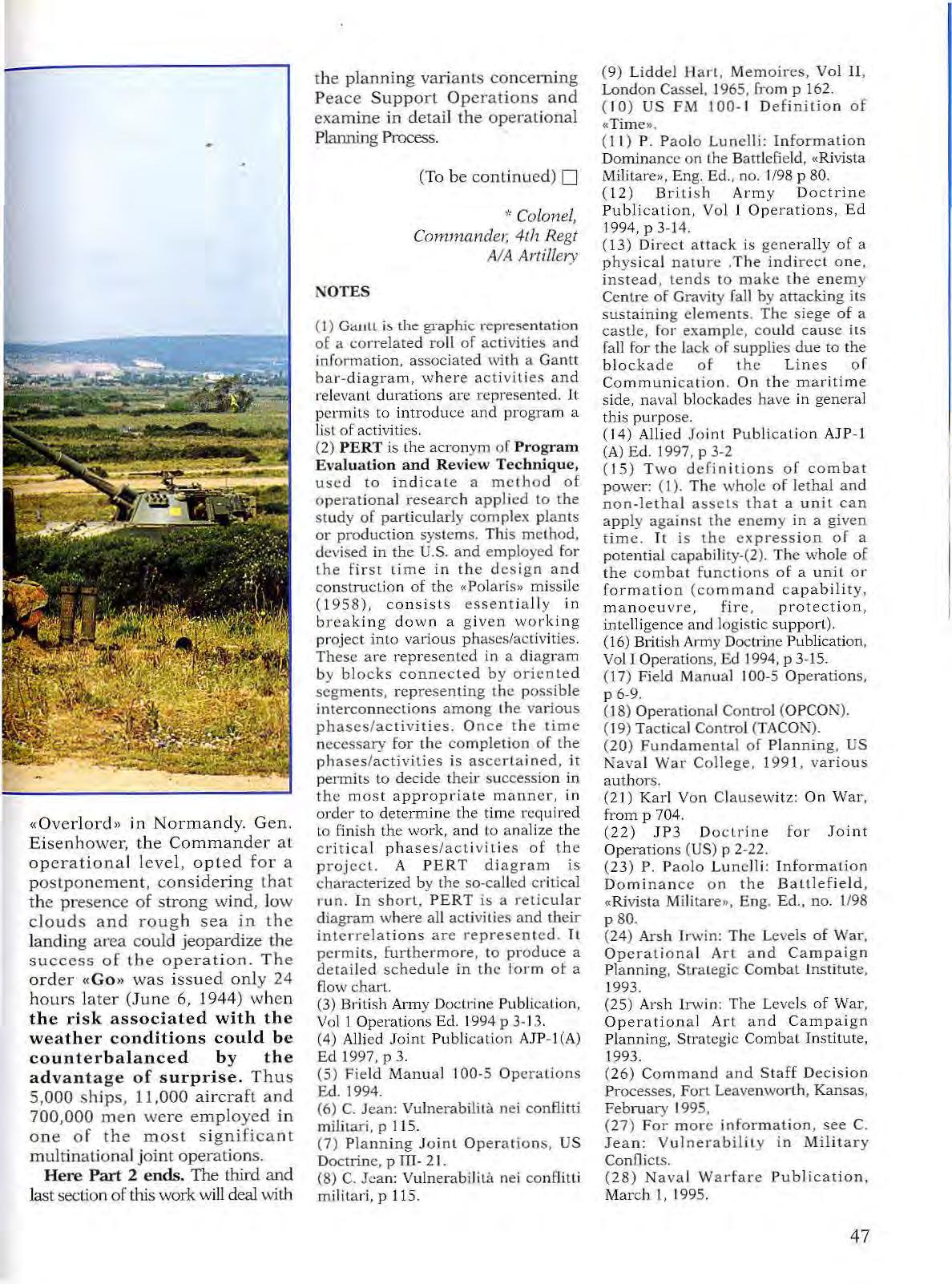
(12) Briti s h Army Doctrin e Publica tion , Vo ll Operations, Ed 1994, p 3-14 .
N OTES
(I) Gault i:; the graphic t·epresentation of a correl ated roll of activities and informatio n , associated with a Gantt ba r -diagram, where activi li es a nd releva nt durations arc rep resented. It permi ts to introdu ce and p rogra m a li s t o f activities.
(2) PERT is the acronym of Program E valuat ion a nd Revi e w Technique, use d to indicate a method of operat ional researc h applied to the study of particu larly complex pl ants or production syste ms Th is method, devised in the U.S. and employed for the first t ime in the design an d construc tion of the <<Po lar is» missile (1958) , consist s essent i a ll y in brea king down a g i ven wor king project into various phases/activi ties. These are r epresented i n a diagram by blocks connected by oriente d segme n ts , r epresenting the possible interco n nections among the various phases/ac tivities. Once the time necessary for the completion of the phases/activities is ascertained, i t perm i ts to decide their s uccession in the mos t appropriat e manner, in order to determine the time req uired Lo finish the \Vork. and to ana lize th e c ritical phases/activiti es of the project. A P E R T d i agram is characteri zed bv the so-called cr itical run I n short, "PER T is a reticular dia gram w here all ac ti vities and their interrelatio n s are represented. Tt permi ts, furthermore, to produce a detaile d schedule i n t he form ot a flow chart.
(3) British Anny Doc trin e Publicalion, Vo l I Operations Ed 1994 p 3-1.3
(4) Allied Joint Publi cation AJP- l(A) Ed199 7 ,p 3.
(5) Fie ld Manual 100 -5 Op eratio ns Ed. 1994.
{6) C. J ean: Vu l nerabilita nei conflitti m ilitari, p 1 15.
(7) Plann i ng Joint Op e r ations, US Doctrine, p JIT- 21.
(8) C. Jea n: Vul n erabilita nei co nflitti mili ta ri, p 115.
(13) Direct attack is ge nerally of a physical nature .The indirect one, i nstead, tends to make t he e n emy Centre of Gravity (all by attacking its sustaining ele m ents. The siege of a castle, for example, co uld cause its fall for the la ck of supplies due to t he blo ckade of the Lines o f Communi cation. On th e marit ime side, naval b lockades have in general this purpos e.
(14) Alli e d Jo in t Pub l icatio n AJP-1
( A) E d. J 997, p 3-2
{I S ) T wo definitions o( combat powe r : (1). Th e whole of le thal and non-lethal assets that a unit can apply against the enemy in a give n time. It is the express i on of a potential capability-(2). The whole of th e combat functions of a u nit or formation (comma nd capability, mano euvre, fire , pro t ectio n, intell igence and l og is tic s upport).
( 16) British Army Doctline Publication, Vol I Op erations, Ed 1994, p 3-15 .
( 17) Field M anua l I 00-5 Operations, p 6 -9.
(18) Operationa l Control ( OPCON).
( 19) Tacti ca l Control (TA CON).
( 20 ) F undamental of Pl ann i ng, US N a v al War Co11ege, 1991. variou s authors.
(21) Karl Von Cla u sew itz: On War , from p 704.
(22) .JP3 Do c trine for Joint Operations (US) p 2-22.
( 23 ) P. P ao l o Lu ne lli : Information Dominanc e on the Ba tt lefield , << Ri vista Militare>>, Eng. Ed., no. 1/98 p 80.
( 24 ) Arsh Irwin: T h e Levels of War, Op erationa l Art and C ampaig n P lan ning, Strateg ic Combat Jn stitute, 1993.
(25) Ars h l rwin: The Leve ls of War , Operation a l Art an d Campai gn Plannin g, Stra tegic Co mbat I nstitute, 1993.
( 26 ) Command and Staff D ecis ion Processes, Fort Leavenworth , Kansas , February 1995 ,
(27) Fo r more infor m ation, see C. Jean: Vulnerability i n Military Conflicts.
(28) Na val W arfa re Publication , March 1, 1995 .
47
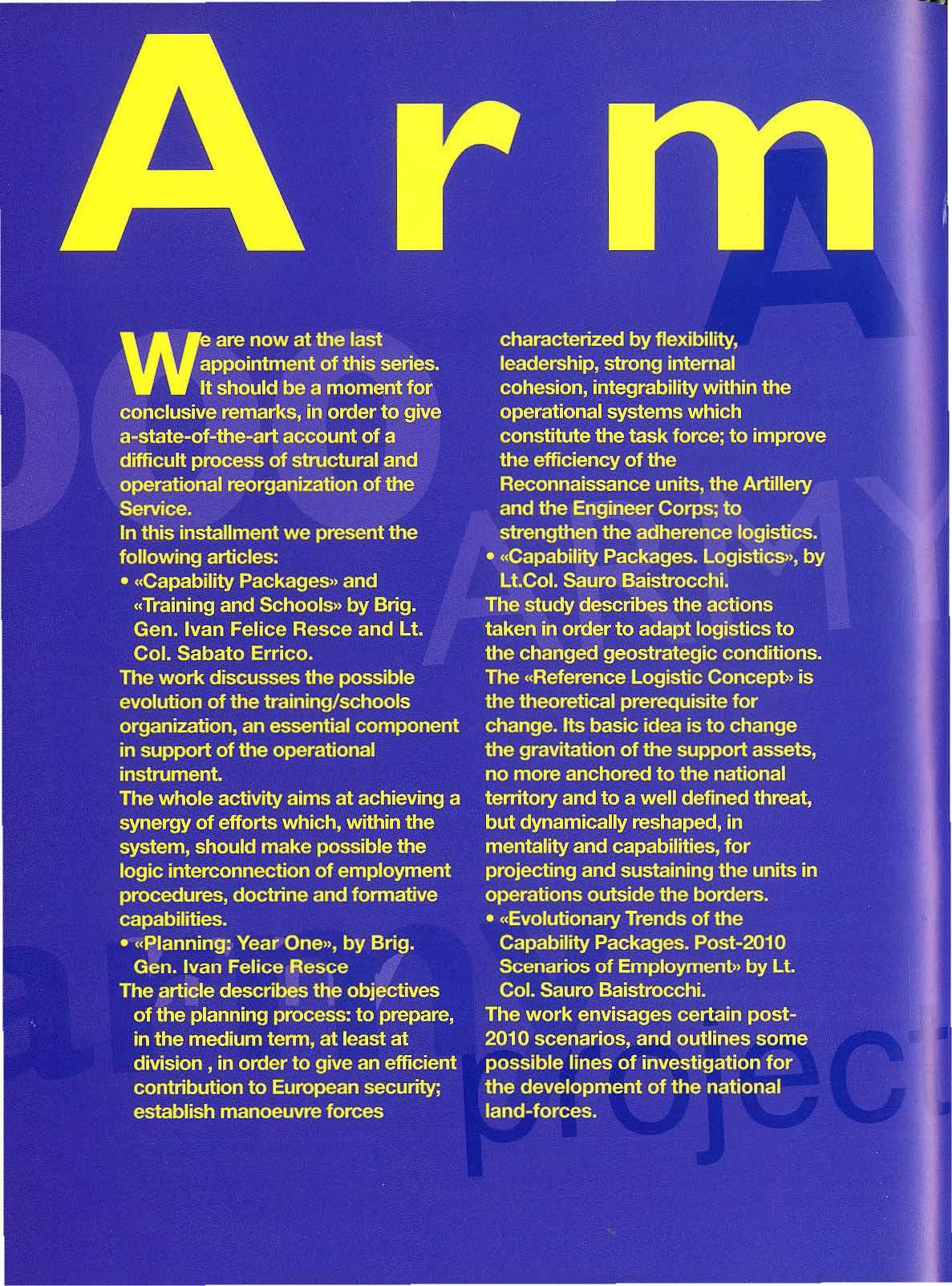
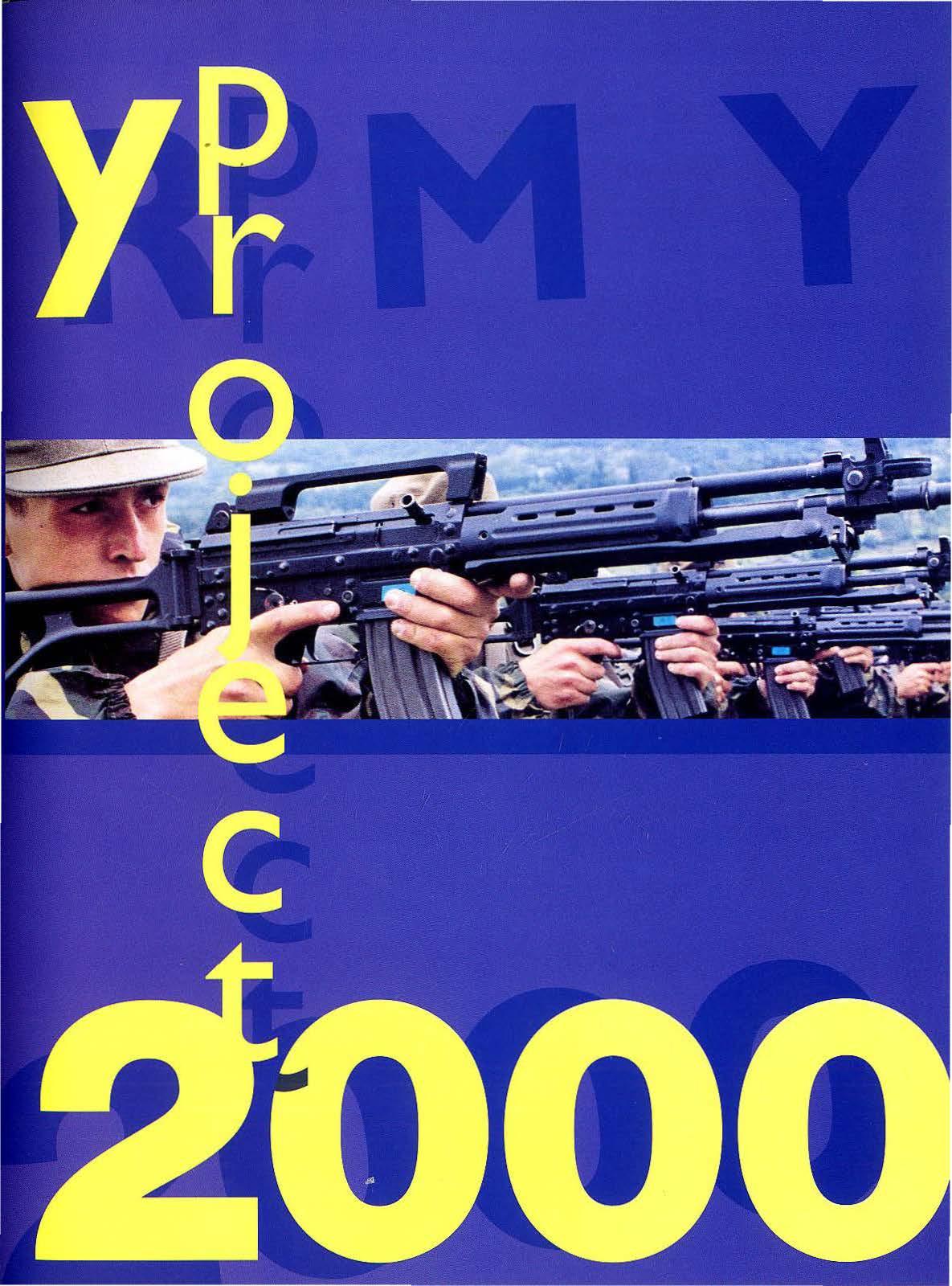
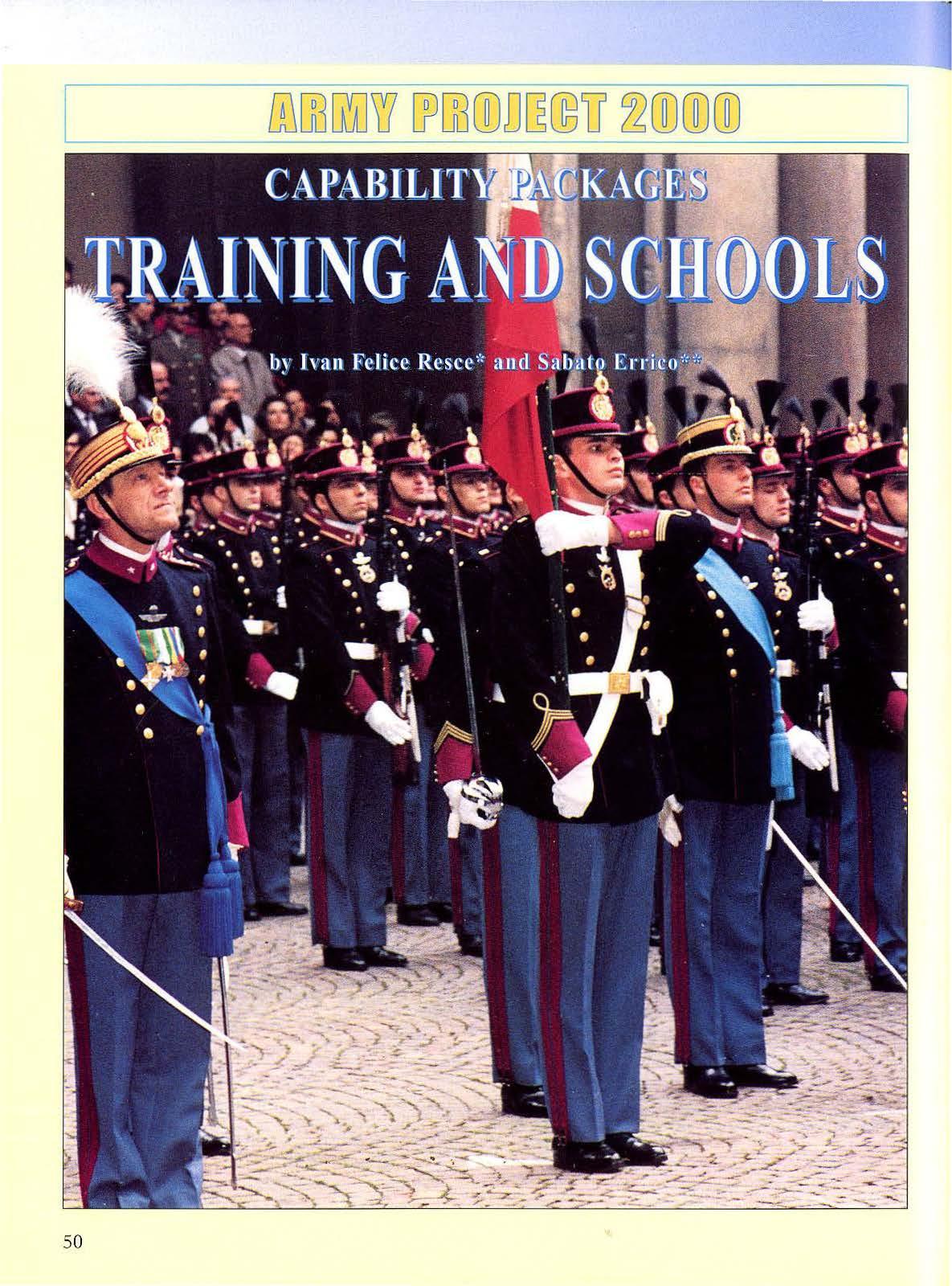
50
Th e Italian Army, a ware of t he role it must take on in the modern operat i onal scenarios, has begun a new syst e m o f fo rce plannin g, markin g the transition from a n approac h based on tlu·eat to one cent red on cap abilities. Th e concrete exp r ession of this typ e of planning is t he «Capabilit y Packages» p roject, b orn with the inten t of reshaping the Anny on the bas i s of the emerging op erationa l re quiremen ts. In par t icu l ar, t he Pr oject aims at letting a ll t h e available resources f low sy nergically togeth er towards objectives con·esponding to specific, concrete , coh erent and interconnectable capabilities (partial objectives), thus real izi ng, an short-, medi u m - and long-tetm h orizons, the complete p roject of t he Servi ce , progressively bu t through fi ni shed partial systems, operationally emp loyable in every ph ase of development of the progr amme.
Wi t hin th e general project, a spec ifi c stu d y was devot ed to the school/t raining sector, an essential sup p ort-compo ne n t of t h e operational instrum en t. T he ba sic concept of the study is prec ise ly that of backing up the S ervice's ge neral objective s as re gards th e preparation of th e cap abiUties requir e d for each package of forces.
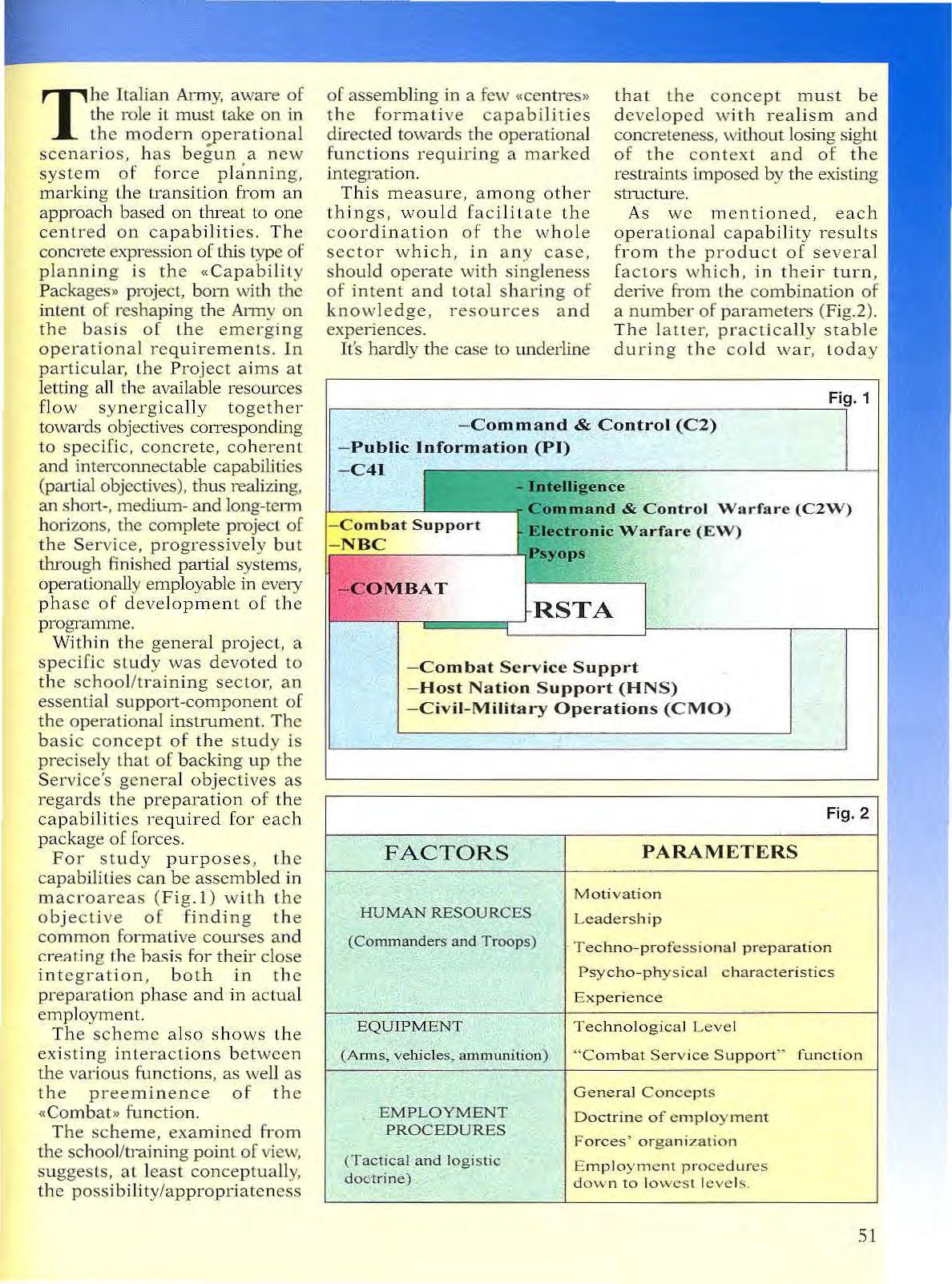
For st udy purpose s, th e capabilities can be assembled in m ac r oareas ( Fig.l ) w i th the ob j ective of fi nding t h e common formati ve courses a nd th e has is for their close int egrat i o n, both in the prepara tio n phase and in a c t ual employm e nt.
Th e sche me a lso s h ows th e exi st in g interactions be tween the var.ious funct ions , as well as the preeminence of th e «Co mb at» fu n ctio n.
T he sche me, examined from the sc h ool/t rai ning poin t of view, suggests, a t l eas t conceptu ally, the po ss ibility/ap prop riateness
o f assembling in a few «Centres» the f orma t ive capabilit ies directe d towards t he operational functio ns requiring a marke d integra tion .
This measur e, among o ther things, \.vou l d fa c ilitat e th e co ordination of the whole sector which, in any c as e , should operate with sing leness of intent and total shari ng of knowled g e, resources a n d experiences .
It's hardly th e case to underline
that the conce pt must be d evelo p ed with rea li s m and concreteness, vvilhout losing sight of the co nt ex t and of th e restrai nts imposed by the existing stn1cLure.
As we ment ioned, each operati onal ca pability results from th e prod uct of several factor s \ vhic h , in their turn , derive from t h e combination of a number of parameters ( Fig.2). The latt er, pract i cally stable during th e co ld w ar, toda y
- Co m ma nd & Control (C 2 )
- P u blic I nform atio n (P I)
- C 4 1
command & C on tro l Warfa re (C2W) Eleetronic W a rfa r e (EW)
- C OM.BAT RSTA
- Combat Service Supprt
- H o st Nation Suppor t (HNS)
- Civil-Military Operations (CMO)
FACTOR S PARAMETERS
Motivation
HUMAN RESOURCES Le ader ship (Commanders and T roops) Tec hno-pro fessiona l preparation
Psycho-ph ysica l c h arac teristics
Ex perience
Technological Le v e l (A rms, vehicles , ammunition)
EQUIPMENT
" Combat Servi ce Su pport" function
General Con cepts
E MPLOYMEN T Doctr ine of e m p loyment PROCEDURE S
F orces ' o rganizaLion (Ta ctical and lo gis ti c Em ploy ment nro cedu res doctrin e) down to lo west leve ls
JL-- - - ___JL....C._---=__..-.,.
Fig . 2
51
assume a dynamic in relation to the constant evo]ution of scenarios, employment con texts, socioeconomic deve lopment and international relations.
The dynamism that marks the evolution of the factors and the relevant parameters is graphically represented at Fig.3.
Th e chart exemplifies a concept : in order to keep the operational capability up to standards updat ed and adequate to the employment scenarios, it is n ecessary to realize a synergy of efforts involving the whole structure of the Service.

In substance, it is a matter of organizing a «system» permitting a logical connection with i n the «hierarchy entrusted with the d evelopment of concepts, doctrine, emplo:yTilent procedures and formative capabilities (Fig.4).
In s h o r t, those who develop formative capabilities for a specific function, must be able to find counterparts, at the higher levels, that are expert and well informed also because they can, and must, be in contact with the corresponding operators of the allied Nations and international organi zations .
THE FORMATIVEffRAINING FUNCTIO N
Training is therefore an i ncremental factor of the operational capability. Training, in its wides t mean i ng, includes:
• training of personnel (Cadres and Troops );
• tra ining of Commands and Units.
The binomial «schoolstraining» is one of the primary aspects of the forces' generation process (Fig.S).
The \.vho le sector must therefore be in line with the operational objectives outlined by the Service in order to effectively carry ou t the assigned missions.
C!iNGOING OPERATIONS
AOA?TATIONOF FORCES' ORGANIZATION:_) EQUIPMEIHAND
SITUATION OUTLINE INCIDENCE ON TRAINING
The mi ss ions assigned to the Armed Forces give rise to employment options that differ in relati on to:
• type of operation: from war operations to humanitarian aid-'
•co ntex t: single Service, joint, multinational;
• theatre: national, NATO, outof-area .
52
DOCTRINE'S IMPLEMENTATION
\ I STUDIES, EXPERIMENTATION AND TEACHING i
4
General Concepts , l JL INSPECTORATE (TRA DOC) Employment Doctrine I 11 "c c' ' r-SCHOOLS Employment Proc edures TRAtNTNG [ 11-FORCES'
• r ! IHCORPORAnON ' I :
Fig.
ARMY
STAFF OPERATIO NAL Fl!NCTIONS
GENERATION PROCESS
11 lr IL:JE.IC 1- 1--'-1- I__: ' . :J f' 1 l[ 2:.i ,11 -
5 • •
Fig.
In this perspective, the engagement in war operations outside the national. territmy, as well as in joint and multinational contexts, is the most onerous, also fr·on the point of fonnatio n and training vic\Npoints.
It is common belief that a soldier prepared and equipped for war operations is perfectly capable of performing in any operational engagement.
This is certainly true as regards the basic technique of individual combat-training, employment of weapons and systems, survival etc.
Never theless, it should be noted that each option of employment requires specific ope rati onal capabilities, characterized by d ifferent means, systems and equipment. This is precis ely the reason why the forces have been divided into Projectio n, Reaction and Presence/Surveillance forces.
As a con seq uence, also the training of personnel, Commands and Units must be developed in accordance with the role attributed to the forces.
Whh refer ence to the latter aspect, suffice it to think that in war operations a soldier mus t exploit to the utmost the lethality of the systems at his disposal, in order to overpo\.ver th enemy, while in a peacekeeping ope ra Lion the use of f orc e is limited to the cases , envisaged by the Rules o f Engagement (ROE), were th e re is no other way of obtaining the respect of the mandate.
In substance , Lhe role of lhe so ldier in war operations is to legit ima tel y exert violence, in order to achieve the objective assigned, while in peaccke e pig operations his ro le is to control the violence between the opposing factions, using only the minimal force necessary and only in the cases envisaged by the RoE.
Fur ther more, more than the joint context, the multinational
context in which modern operations are ca_rried out requires a specific preparation of both the staff organizations included in multinational Command and Control struc tw·es (CJTF Hq) and the units -down to the lowest levels - that could be called to conduct combined actions.
It is hordly the case to point out that the first step of interoperability is the adoption of common t echniques and procedures.
Also the information sector deserves some considerations, as regar ds the em ploym ent of the sources as well as the use of the elements of information.
As far as the sources are concerned, IM TNT (Imagery Int ell igence) is certainly the sector \Vhere the greatest progress has been made, thanks to t he develo pments of advanced technologies, both in the field of satellite-reconnaissance and in that of sensors installed on manned or unmanned aircraft. This is a s ource o f great valu e in symmetric conflicts, and it
can contTibute to the transparency of t he theatre. On t he other hand, it may be ins ufficient in peacekeeping opera Lions, considering the difficulty in distinguishing equipment and personnel employed by the factions for vvar pwposes from those employed for ci\,ilian or humanit::uian use.
In t his scenario, HUMJNT (Human In te lligence) certainly continues to be an indispensable source of in for mation.
As regar ds the information issue, it must be stressed that in any case the superiority in the sector of in fo rma tio n is one of the main factors of success. Never t heless, the approach and e ve n t he use of information assume completel y diffe ren t characteristics, as s hown at Fig.6.

Tn war operations deceit is very important while, in PSOs, transparency is indispensable, not onlv for the contingent's credibility, but for deterrence.
The situation picture is also charcterized by other innovatory elements, which
Reduce enemy capabi lities
PSO: information advantage on the environment
Fig. 6
Protect own information system
53
imp ose adaptation s a nd adju s tm e nt s to the fo rma ti ve a nd training systems , suc h as: evo l u ti on of the Co m mand and Con tr o l syste ms, ins t it u ti on of t h e M ars hal s , S er g ea n ts a nd Vo lu n t ee r s ro lls, increase of th e vo lu nt eer c o m pone n t, r e du ction of t h e co n s c r i ptio n ti m e, i nternationa l t e nd e n cy (NATO
T RA I N IN G GRO U P ; F I NA B EL) to concentrate certai n for m a ti ve activities in a s ing le n a ti on, i n order to ach ie ve i nterop erabiHty an d save r e sources .
R E P E RCUSSIONS ON S CHOO L S AND T RAININ G
A fu n dame n tal consideratio n is obvious b u t n evert h eless n ecessary : t o p repare t h e i n s t r u men ts for t h e new mi ss i ons is much m or e d i ffi c ult, co mp l e x a nd e xp e n s i ve t h an it \.vas th e d e fence on t h e n or theas t of t h e P e n in s u la
The new rea lity im pos ed, in th e first p lace, a radical r e vis i on of th e fo rm a tive co u rs e: the prepa r at i o n of the p erson n e l m ust necess ar i l y a ssume a p erm an en t charac te r a nd be e m p l oyment-oriented
In fac t , t h e c o m pl e x it y a n d d i versification o f the fun c t i o n s t o b e p e rforme d , r eq ui re continuous for mativ e c o ur ses, consis ti ng o f m oment of s p eci fie preparatio n devot e d t o kn owh o w t o , which p r ecede the undertaking of a pa rti c u lar task .
FLU Lhennore, th e n 1ultina ti onal n at u re o f the co n tin gents e m p loyed in m o de rn opera ti o n s n ecess i ta te s a p reparati on ce ntred on t ec h n iqu e s and e m p l o yment proced ur e s agree d up o n i n advance, an d s hared am ong the possi b le p artn ers It i s a qu estion of i n te rn a tionali z in g t h e form a tive and training process, solving beforeh and also t h e p r o bl ems c on n ected w ith the knowle d g e of l anguages .
An e ssen ti al characteristic t o be co nfe r r e d t o Co m man d s a n d uni t s is th at of p ro j e ctability, both o n th e nat io n a l te nit o ry and outsi d e . This pres upp oses, on th e formative p lan e, s p ec ifi c skills in t h e field of plam1i ng, m u lti mo dal moveme n t , assu m p tion of deployments , l ogistic suppo rt e tc . M oreo v er, t h e pecu li a r i t y o f t he conduct o f peace s u ppo r t ope rati o n s requires t h e av ail a bili ty o f a r eas, instructing skills and tr a ini ng s ystems committed to PS O s ( P eac e S upport O peratio n s ).
Finally, the va lue of th e H U.t\tliNT source for the informative activity in P SO s, requ i r es th a t the personnel d esignated for servi ce in this d e li c a te branch have a go al kn o wle d y of t he so-ca ll ed ra re langu age s, w i t h particu la r re ference t o the la n guages used in t he areas of m ost. proba b le em ployment.
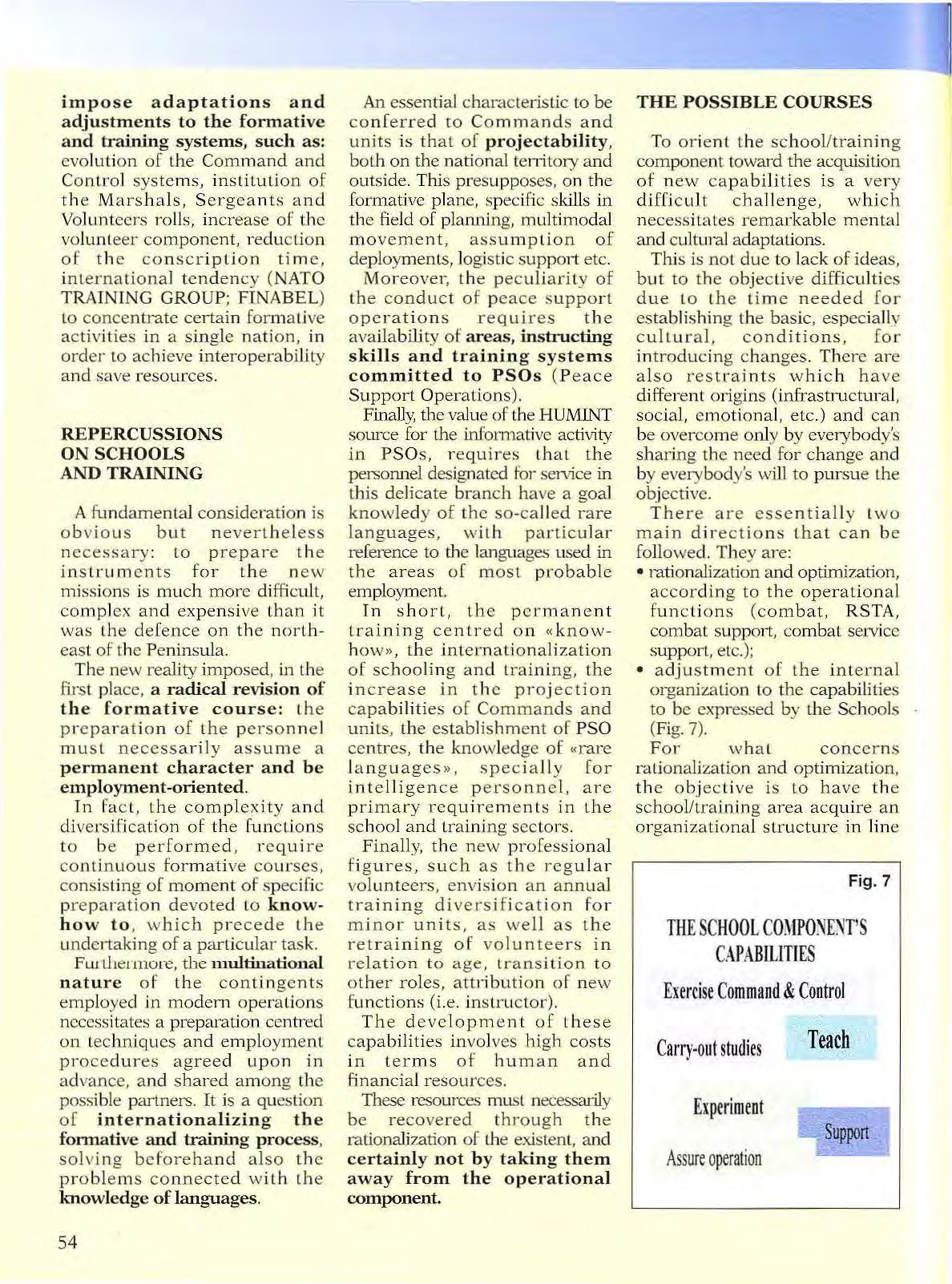
I n short , t h e p er ma n e nt train i n g c e n tr e d on « kn o whow>>, t h e i nt e rn at i o n a lizatio n o f school in g a n d trai ni ng, t h e in cre ase i n t h e pro j ectio n capabi li t ies of Command s and uni ts, t h e es ta blishment of P S O ce n t r es, the kn o,v l edge of «ra re l a n g uag e s », specia ll y f or inte llige nce p ersonne l , are pr i m a r y r eq u i r e m e n t s i n t h e sc hool and trai n in g sec tors .
Finally, th e n e w professional f i g u res , su c h as the r e g ula r vo l u n t eers , env i s i on an ann ual tra inin g diversificat i on f o r minor un i ts, as well as t h e ret r a inin g o f volunteers i n re latio n t o age, transi t ion to o the r roles , a tt ri b u tio n o f new f u nc ti o n s (i. e . i n s t ructo r).
Th e d ev el opm e nt of these capabi l ities invo l ves h igh c o s t s i n terms o f hu ma n and fina n c i a l res o u rces
These reso u rces must n ecessarily be recovered t hrough t h e rationalization of t h e existent, and c e rt a i n l y not b y ta king the m a way from th e o p era tional component
THE POSSffiLE CO URS E S
T o ori e n t t h e sc hool/ t r ai n in g co m po n en t toward the a cquisitio n o f n e w ca p a b il ities i s a v e r y diffi c u l t c ha ll e n g e , w h i c h n ecess i tates re markable m enta l and c ult u ral a dapta t ions.
T hi s is not d ue to lac k of ideas, b u t to t h e obj ec t iv e diffi culti es d u e to t he ti m e need ed for es tabli sh ing th e bas ic, especiall y c u lt u ral, con dit i ons , fo r in t r o d ucing c h a n g es. The re a re a l so restrai nt s wh i c h ha ve d i ffe r e n t o r ig ins (infras tructura l, social, e nlOt i o n a l, etc.) and ca n b e ove r co m e o nl y b y every b ody's shar i ng t h e n ee d for change and by everybody's will t o p ursue the o bj ecti ve .
T here are esse n t ia lly t wo ma i n d i rectio n s t ha t c a n b e f ollowe d. They are :
• ration a li zatio n and optimization , acc or d i n g t o t h e o perat i on a l fun c ti on s (c o m bat , RSTA, comba t s u pp01t, comba t ser vi ce support, etc.);
• a dju st m en t of t he i nt erna l organ ization to the capabilities to be expressed by th e S ch ools
( Fig. 7)
F o r v.t h a t concer n s rati o n a li zation an d opti mi za t io n , th e o bj ec t i v e is to have th e sc h ool!Lraining are a acqui re an organi za tio na l s t r uc t u r e i n li n e
5 4
Fig. 7
Carry-out studies Teach Ex pe rim ent Assureoperat ion
CAPABIL ITI ES Exercise Command & Control
with th e o pera ti on a l functions , r e alizin g, a t t h e s am e tim e, a ll possible mergers in to s ave reso urces.
Consid ering th e lim it'ati o ns c onne c t e d with th e pre se n t locatio n o f t he infr as tru ct u re, this ad aptati on r e quires th e ado ption of measur e s s paced in t ime a nd ther e fo r e, sh o r t, me diu m and l o ng-t erm objectives s hou ld be fixed.
As r egards adju stme nt of t h e i nte rn al organ i zati o n, the fir s t objec tive is to ada pt the struc tu re to the ba sic capabil i ties of th e areas of co mmand and con tro l, te ac hin g, s tu d y/exp e rimentatio n a nd leg is tic - a d m i nis t r ative s upport. The second aim is th a t of achievi n g a clo se c onnection between teac hin g, less on learned a n d futu re d eve lop me n ts, adopting the «learning laboratory» concept , i. e . inte g ra ti ng som e common fo rmative ex periences.
It is al so n e cessary to prece d ed to internat ion a l ize cer tain training a c tiv iti es, i n order to atta in interoperabiliLy and economy of r esources.
Organizatio n of the command and cont rol system
Th e co mmand a n d con t r o l s tructure o f the s cho ol/traini ng organi zation has bee n recently r e adjust ed (Fig. 8). In par ti cul a r, t he trai n in g se cto r has b ee n placed u n d e r the res pons i bil i ty of the Inspector of Army Schools, who avails himself of:
• a Deputy Inspector for Officers trainin g, w h o i s al s o Comma n da nt of the W a r College;
• a Deputy I nspe ctor for NCO s and Vo lunteers tra ining, wh o is a lso Co m m andant of the I CO School.
Also the Service!B ranch schoo l sect or, like th e t ra i nin g o n e, has be e n placed under th e r esp onsa bili ty of a sole su pervisor; t he Inspector fo r Army Branches, \vho avails hi m self of:
• an Army Bra nch Inspec torateestabli shed with the concurrence of th e p rev i o us fi ve S e r vic e Ins pectors - with ge ne ral responsibilities con ce rn in g t ra ining, reg ulatio ns and inspecti ons;
• five Deputy Inspectors, o ne for ea c h Bran c h, \.vho ar e a lso Commandan ts of the r esp e ctive Bran c h S choo ls ( In fa ntry, C a valry / Armour, Ar t illery, Eng ineers, Comm uni cations ). As fa r as th e Logistic S c hools are co ncern e d , t he y h ave been placed under t he respon s ibility of the Army Lo gist ic I n s pec tor, who a vai l s himself o f three D e p uty I n s p ecto rs (Tr ans port / Mat eri als, Me d ic alNet eri nary, Ad minis trat ion/Commiss ary)
Organization of Schools and Institutes
The situation of S c hoo ls and Ins ti tutes is shovvn at Fig. 9.
As regards personnel, the training sector «absorbs» 11% of officers, 8% of NCOs and 10% of Troops, with reference to the established stren gth.
In relatio n to the n ew organizatio n of the Tnspectoratcs and Command line, the organiza ti ons in charge of training ec:u1 be cla-;si(ied according to the fu n da mental fu nctions listed at Fig. 10.
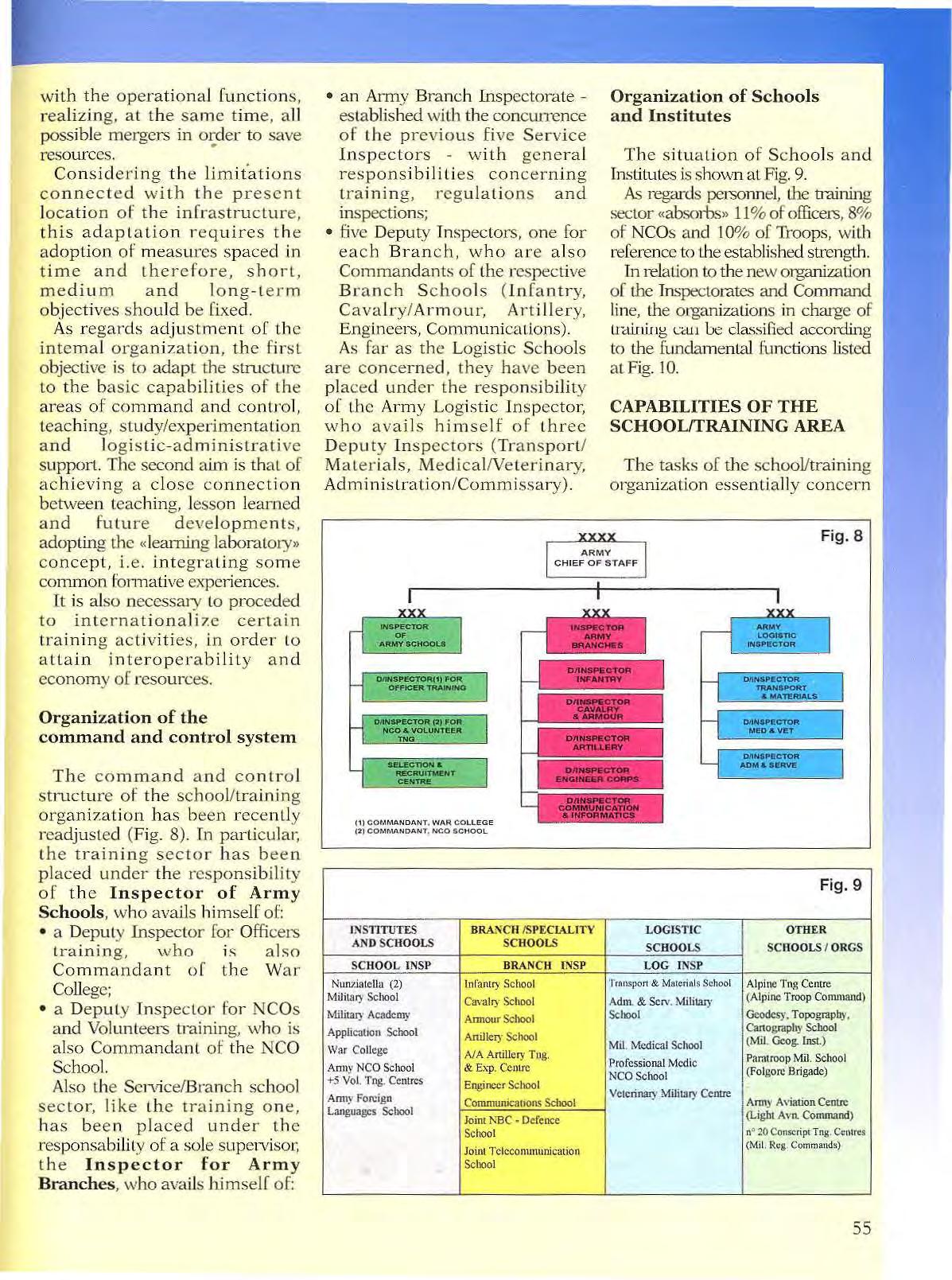
CAPABILITI ES O F TH E SCHOOL/TRAINING AREA
The tas ks of t he s c h ool/tr aini ng orga nization essen ti a l ly conce rn
INSTITUTES BR A:-iCII /S PE CI.ALJTY AND SCHOOLS SCHOOLS
L OGISTI C
SCHO OLS
L OG INSP
Tro ll SJXl rt & M•teri nls School
Adm & SeN Mili UUy School
Mil Medical Schoo l
P rofessional Medic
NCO Schoo l
Veteri nary Mili tary Centre
DIIN8PECTOR ADM&8UVE
OTHER SC HOOLS I OR GS
Alpine Tng Centre (Alpine Troop Conunand) Geodesy. Topogrn pby. Canogrnpby School (Mil Geog. Inst.)
Pamtroop Mil. Schoo l (Folgorc Brigade)
Arnly Aviation Centre
! <Light Avn. Co mmand)
n• 20 Conscript Tng C.: ntres (Mil. Rcg Commands)
0/INSPECTOR(II FOR OFFtCER TRAINING DIINSPECTOR (2) 'OR NCO"' VOLUNTI!I!R lNG SEL.ECT10N & RECRUITII&NT CI!NTIU! (1) COMMANDANT WAR COLLEGE (2) COMMANDANT NCO SCHOOL
Co llege Al A Ani llcry T ug .t\nny NCO School & Exp Ce ntre +5 Vol. Tng. Centres Enginee r Sc hool
ny Foreign Conununicauorl' School
School Joint r-:ac • Defence School Jo int Telecommunication School
SCH OO L INSP BRANC H f SSP Nu117.iatella (2) lnl'anuy Sc hool Milita oy School Schoo l Milital)· Academy Armour School Applicauon School Anillery School War
An
Languages
Fig. 8
Fig. 9
55
four very broad functions :
• teachin g ;
• study;
• experimentation
• logistic-administrative support of activities.
I n order to carry out the tasks connected with these functions, the school/training structu r e m us t h ave a Command and Cont rol sys t e m capab l e of dir ecti n g and coordinatin g the activity of all secto r ( tr a ining, logisti cs, a dmini s t rati on, infrastructure, sec urity e tc.).
In substance, to give a capability to a sector does not mean only to organize it in tenus of hum a n resources and equipment, but also to create specific capa bilities a nd make th em product ive, p l aying a decisive ro l e within b ot h t h e school structure (organiza ti o n of seminars, m eetings, work in g grou ps , ac tivation of « le sson learned» cycles) an d outside i t (contin uous osmosis w i th the ce n tra l Organiz a ti ons and w i t h the Units).
With a view to t h is, the capabilities n ecessary for the function can be gr·o up e d into fiv e categories (F i g 11):
• co:rnmand and control, co ncerning the fun ctions of th e Commandant, Depu ty Con1111andant and Comm andants/Dir ec tors of Courses;
• teachin g, c on cern in g the «classic )) functions of Inst itutes and S c h ools, i. e. t ra i n in g, speciali;cat io n , qualif i ca tion , pro fessional izatio n and updating, as well as meeting joint and i nt ern a ti ona l requirements (Teaching Area);

• study and experimentation , concerning the t asks assigned to the S c h ools as depositaries of the Branc h/Specia lity «culture)), tasks aimed a t \ vor kin g out employ ment procedures an d teehno-ta ct ica l regulatio ns fo r the Branch/Speciali ty, as well as experim en ting the e mpl oyment
of equipment , mat eria l s and weapon systems (Study and Experimentation Area);
• functional capabilities , concerning the type and qu ality o f the available didactic
FUNCTION
in s truments, training method s an d links t hat Institutes and S c hool must have, both external (international connections) and internal (cl ose conta cts with Army General Staff, lnspectorates
ORGANIZATIO NS Fig 10
Conceptual Army Staff and Inspectorates
Land Forces Comma nd and Organizational Int ermedi ate Operational Commands; Commands of Schools and Instit utes.
Executive School s and Institutes, Brigade H qs, Regiment Hqs. (or equivalent Units).
I DEFINI TION OF CAPABILITIES
I Fig 11
A\iD COl\ 1ROL (' AI'AOILITY l I Command Area
( SCHOOL J COMMANDANT ( DEP SCJ IOOL J COMMANDANT ( OFCOlJRSES
Teaching Area ( PREPARE ) ( SPECIALIZE ( QUALIFY j (PROFESSIONALIZE ( DEVELOP DEVELOP DRAW TEAM JOINT INTERNATIONAL OF INSiRUCfORS COI.,JRSES COURSES STU DY CA PA BILITY I I Study Area
( DEVELOP J [ DEVELOP :J EMPLOYMENT TECHNO-TACffCAL STUDIES NORMS NORMS
EXPERLMEJ\:TATTO'J CAPABiliTY l I EXPERIMENTJ\TION
"TEST EMPLOYMENT [ TEST EMPLOYMENT J 1CST if_ PROCEDURES FOR PROCEDURES FOR NO-TACTIC EQOIPMENT H , ALS ROCEDUR.ES
H. NCTION:\1. (,\PATIIIITII I
Teaching, Studies and Experi mentat ion [ '1..EARN ING J ( EXTERNAL J LABORATORIES" CONNECTION
INTERNAL CONNECTION
BASED ON SIMULATION [ LEARNING' S CONTROL rNSTRUMENT
TEACH ING AIDS
SUPPORT Ci\Pi\B ILITII S I I .ogis ti c-Administrative Support Area
(COMMON SERVI CES J ORGANI ZATIONS .: [ .:.•.
56
:--..('1;(
f
I
'
:)
and Units) (Teaching, Study and Experimentation Areas);
• su pport, regardin g infrastructure (quarte rs, cla<:;srooms, gyms and S!)Orts rrr ou nds r anrre s and ' tra i ning areas, parking lots) as we ll as the logist i c support connected "vith the post's general services (Logistic-Administrative Support-Area).
P ossible development ofthesch ooYDr.rirUn g organization in re lation with the operati o nal ftmctions
Th e sc hool/training organization mu st car r y out a funct ion of support i n favour of the operational organization, which is the productive stn1c t ure. Within th i s fr amework, it develops its capabilities in several secto r s: Com m a nd and C on t rol , teaching, s tudy, e""-perimentation, l
ogistic-administrative support
The primary capability ls certainly that of teaching, which consists of training, qualification, specialization and profess io nali zat ion Each of t h ese ac tivities concerns one or more categories of personne l , and, in the same manner, leads to the division of Sc h ools and In stitutes int o two very large areas: training ce n tres, su bdivided b y catego ri es of pen;o nnel, and q ualifica t i on /specia li z ation centres, w hich are multicategory institutes a i med at prepari ng students on the b asis of the «operational functions» d escribed in the «Capability Packages Study». l.onseg uen te ly, the school/training component most be proportionally an d f u nc tion a lly s tructured accord in g to the capabilities to be developed at the var ious leve l s, i.e. summi t, departments correspo ndi n g th e ope rational functions, trainin g po l es whose primary respon sibi li ty is the conduct of training (Fig.12) . In practice, it must have a very simple structure that permits an harmon io us developm en t of the
compo nent 's capabilities and g uarantee an orderly co ordination or all activities.
Th e road is neither short nor easy. The re are nevert hele ss margi ns that enable us to start adjustme n ts that shoul d lead the structure t o conv erge towar ds a con figu r at ion th at cou ld be ca ll e d a long -term prospect.
Within this framework , an d taking into ac count t hat t he organization should be adapted not o nl y to the ope rational function s but a lso to the ne w forma tive requi re m e nts , whic h i mpose further adjus tments, a first step tovvard s the at ta inment of the objective is outlined below.
Adapta tion a n d increa se of th e capabilities
As is the case wit h the «Capabi li ty P ackages », also the partial project relative to the
school/ tr ainin g area envisages a rea lization phase divided into tw o time h orizons:
• a nearer o n e, co ncerning th e immedia te imple mentation of the measures aimed at adapting t he Schools to the capabilities they are call ed t o express in the sec tors of personne l instruction , s tudy of re g ul a tio n s and e mploymen t procedures, experimentation of equipm ent au d system employment technjques;

• a d ista n t o n e , wh i ch tends to rec onfigure the Scho ols on the basis of th e «A rmy 2010201. 5 » m ode l.
S h o rt-t e rm adaptatio ns
The mo st significant measuresbeing now impl emented within the schoo l o rganiza tion - stem [rom the n eed to adapt and imp r ov e the preparation of Cadres and u ni lS in basic sectors of the modern scenarios of employment. Fig.12
SC HOOL- TRAI;\;I NG COM P ONE;\;T I)! V ISION OF CA I'ABILITIES
The sc hool-t r a ining co mp onent should ha ve a very simple str uctu r e, with a maximum of three " le, cls", pe r mitti ng:
• t he r ation a l and ''eco nomi c" di stri b uti on of th e capabil.ities to develo p ;
• the easy coord ination of t he activ iti es corres po ndin g to t he capabilities;
• the efficient exercise of Command and Co ntrol , in order to op t imize the r·esou rces ass igned to the component as a whole.
INS P ECTORATE DOCT R INE TRAIN I NG D EPARTM EN TS . TRAI NING POLES s T V D y
57
We refer, in particular:
• to the co ndu ct of mi li tary operations ot h er than war (MOOTW );
• to t he development o f t h e RSTA (Recoi nnassance, Surveilla nce, Target Acqu isitio n) functio n ;
• to the Explosive O rdnance Disposal.
As a matter of fact, the peculiar employment procedures connected with the p erformance of the activities listed a bove r equ ire the ava i lability of areas , teaching capabilities and ad-hoc training systems perm itting to carry out the tr aining activiti es acco rding to standa rd procedures.
Therefore, the es tabli s hm e nt of special t ra inin g Centres has been commenced, a lso thro u g h the reorganization of a l ready available ca p a bilit ies, a t so me Arm y S choo ls:
• MOOTW Training Centre;
• Training and Procedure Centre fo r RSTA and Manoeuvre;
• Clearance and Disposal Operational Centre.
MOOTW Training Centre
Th e Alli ed Publi cati on AJP-OI (Allied Joint Doctrine) includes in Military Ope r at ions Oth er Than War (MOOTW ) a wid e ra n ge of activiti es : Con f li ct P revent i on, P eace Supp ort Op era tions, Hu manitari a n Aid, No nCombatant Evacuation Opera tions (NEO) , etc. With re ference to the tasks ass igned to the Italian Armed Forces , MOOTWs a r e ge n e r a ll y included in the mission «Defence of external interests a nd contribution to international security » Fur th ermore, th e national doctrine envisages a range of military opera tions that can be considered «other-th an-war vvithin the «Presence an d Surveillance» missio n. Th ey arc (F ig. 13):
• ad vanced presence fo r surveillance of t he borders and conduct of deterrem ac tivities;
• control of the n at iona l te nitor y for prevention/re press ion of
illegal activiti es;
• cooperation with t he P olice Forces in the ma in t ena n ce of public order.
• cooper ation in case of disasters, activities of pub lic interes t. With re feren ce to the above, MOOTWs c an be class i fied in (Fig. 14):
• military operations outside the national ter ritory (PSO);
• military operations on the national territory (advanced presence, safeg u ard of the national I nstitutions, natio n a l welfare . Generally speaking, the conduct of military operations other than war, in both international (mainly PSOs) and national context, requires the application of essentiall y simil a r e mploym e nt procedures an d individual/team techniques . I n other wo rds , there arc overlaps, concer n ing techno-lactica l instructions, in t he preparation of units for M001Ws carried out in d ifferent c ondition s of employment. We re f er, for instance, to the activation of c heckpoints , patrol and escort procedures, searching tec hniques etc . conducted withjn PSOs and in the context of ten·itorial co n trol.
lL foll ows t hat a special school stmcture for preparing the units and for wo rkin g o u t/updati n g the norms of employment in MOOTWs -w hich ofien imp ly lega l-adm ini strati ve notio ns no t always obtainable at the Uni tswill be a re liable refere n ce point for all uni ts of the Army.
Aims of the MOOTW Centre
The establishment of t he MOOTW Training Centre aims at r eali zing «ad-hoc capabilities», in ord er to (Fig. 5) :
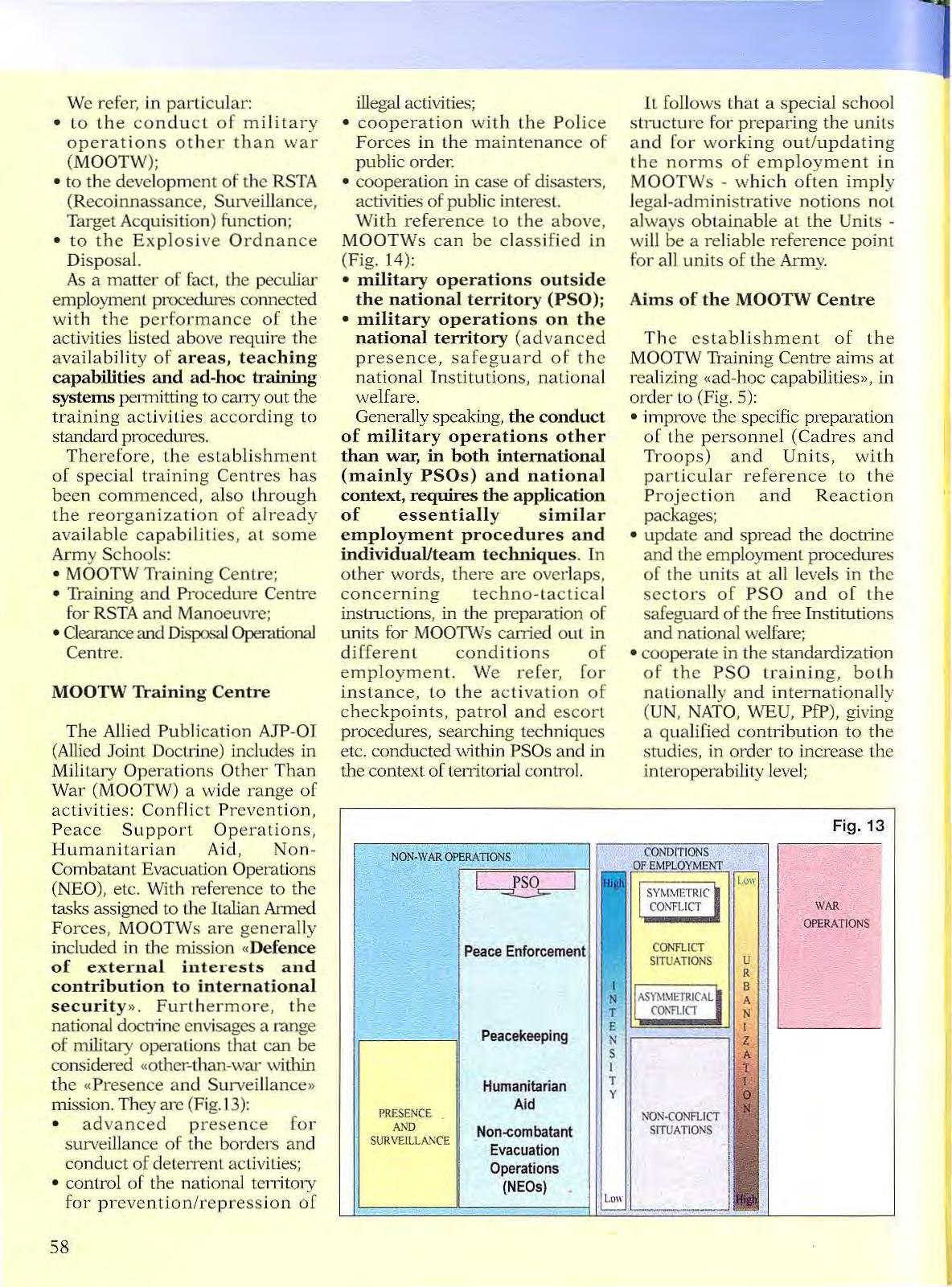
• im prove the specific pr epar ation of the personnel (Cadres and Troops) and Units, with particu l ar reference to the Project i o n and React ion packages;
• update an d spread t h e doctrine and the em ployment procedures of the u nit s at a ll levels in the sectors of PSO and of the safeguard of the free Institutions a nd national welfare;
• cooperate in th e standardizati on of the PSO training, both na ti o n ally and internationall y (U N, NATO, \1\TEU, PfF), giving a q u a lified co ntribu t ion to t he sh1d ies, in order to increase the inLer operability level;
58
PRESENCE AND SURVEILLM\CE Peace Enforcement Peacekeeping Humanitarian Aid Non-combatant Evacuation Operations (NEOs) Low
,NON-WAROPERATIONS
Fig.13 \VAR OPERATIONS
l ay t h e foundat i ons o[ t he i n t ernationa li 7.at i on of the B ranch Schools, in- order to improve t h e quality of h·aining and save resources.
Th e M O OTW Training Centre is a sc h ool structure [or multicategory qualification and specializa t ion
O n the basis of its fu n ct i ons w ithin t he P S O sector, the Centre will g ive short co u rses (Fi g. 16) availing itsel f of a team of regular in structors with t h e add i tio n o f exte rnal ins truc tors with speci fic comp e ten ces Th e latter w ill b e selected f r o m the p erso nn e l of t he unit s w i th experience in mul tinational operations or w h o have atte n ded special courses, as well as from elements of the C e n tra l O rganizations (Army S taff, I nspectorates), War College, or othe r Branch/Logistic S chools.
Ta k ing into account what is being done at similar European S chools (Swedish SchoolS W ED IN T, Austrian T raining C en t re, German SchoolHAMMELB UR G), courses will be short and inten sive In abo ut 2 weeks [or basic co urses, 3 days-o ne week for the m iss i onoriented ones
On the bas is of t h e experience gai n ed in t h e o peratio n s for t h e control of th e t erri tory ca r r i e d out wi t hi n the «Prese n ce a n d Su rv eillan ce» missio n , and bea ring i n mind the laws on t h e s a fegu ard o f t he Institut ions and t he na t ional welfare, training fo r the operations connected with t h e «P resence and S u rveillance>> miss i on are organized as follows:
• b asic training, for all personnel, t o be carried out at the employment units;
• preparatory tr a ining, [or all p ersonne l and units, to be c arli e d ou t at the employment o rganiza t ions onl y in case o f par t i c ul ar operations (Le. contr ol of t h e te n ·itory, as \ vas
OUTSIDE NA TIONAL TERRITORY (PSO)
ON NATIONAL TERRITORY (ADVANCED PRESENCE CONCURJU:NCE IN SAFEGUARD OF INSTITUTIONS AND PUBLIC WELFARE)
Enhance -the preparation of t>ersonnel a nd Units, with particular reference to the "Projection" and " Reaction" Packages.
Up(Jate and _spread doctrine and employment procedures.
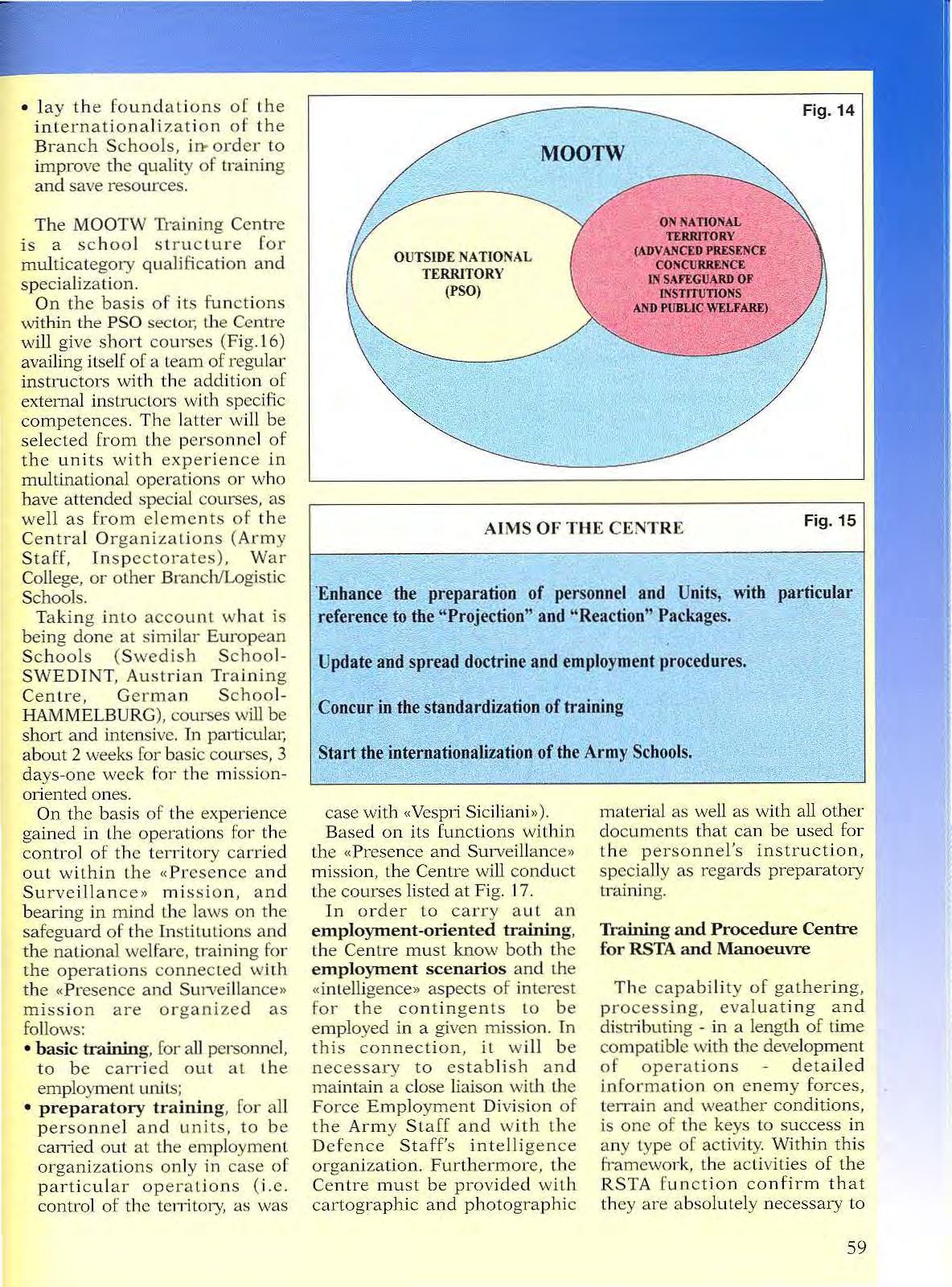
Concur in tile _ standardization of training
Start internationalization of the Ar my Schools. .... ,-"".
cas e with «Ves pJi Sicili a ni »). Bas e d on i ts functio n s w i th in t he «Prese n ce and Surve ill a n ce» mis s ion , the Cent re w ill condu ct t he co urses liste d at Fig . 17.
I n o rder to ca r ry a u t an em plo yment -o ri e n te d training , t h e Ce n t re m u st know both the emp l oyme nt scen arios and Lhe «in t ell igence» as pects of interest for the co n t i ngents to be e m ployed in a given mission. In this connection, it w i ll be necessary to estab li sh an d mai n tain a close liaison with the Force Emp loyment D ivi sion of t h e Arm y St aff and with the Defenc e Sta ff's in t e lli gence organi za t i on. Fur thermo(c, t h e Ce n t re must be p r ovid e d with c a r tographic and photogra phi c
mat eria l as w ell as w ith all other docum.ents that ca n be u sed fo r t h e person n e l's i n st r uction , special ly as rega rd s preparatory trai ni ng.
Training and P r ocedur e Centre for RSTA and Manoeuvre
T h e capabi li ty of gather i ng, processing, eval u at in g and distributing - in a length of time compatibl e with the deve lopm ent of operations deta iled information on enemy fo r ces, terrain and weather conditions, is one of the keys to s u cce ss in any type of activi ty. ·wit h in t h i s framewor k, t h e ac t iv i t ies of the RSTA f u nc tion c o n f i rm that t h ey are a bso lu tely necessary to
•
AIMS OF T H E CENTR E Fig 15
59
the Commanders at all le vels, since they pennit to optimize the management of the resources destined to the IEW function (Fig. 18), of which RSTA is a subfunct ion.
Within the Service, at operational and tactical level, these activities concern , or will soon concern (Fig. 19):
• Special Forces, LRRP and Ranger units , for tasks of widerange reconnaissance (special recce) and search/acquisition of targets, with capabilities in the sector of the RSTA/H U MINT source;
• JEW units, for tasks of swveillance of the zone of responsibility and search/acquisition of tar gets, \vith capabilities in the sector of the RSTNSIGINT and RTSA/.MASINT sources;
• SORAO units for tasks of surveillance of zones of responsibility and sea r ch/ acquisi tion of objectives with capabilities of the RSTA/MI NT sources;
• Scouting Cavalry units, for tasks of short-range reconnaissance (by force or concealed) with capabilities in the sector of the RSTA/HUMINT sources;
• Army Aviation (AVES) units with combat and combatsupport helicop ters, for tasks in support of short-range reconnaissance, surveillance of zones of responsibility and search/acquisition of objectives with operational capabilities essentially in the RSTA/HUJ\Illi\!T and RSTA/IMI NT sources. At present, the responsibiLities for the basic techno-spec i alistic formation of persmmel and wlits in the various sectors of the RSTA function are clistribuited as shown at Fig.19.
Taking for granted that the t e chno-specialistic formation of the personnel designated to operate in the various sectors must remain under the responsibility of the appropriat e
BASlC COURSE FOR IN STRUCTORS COURSE FOR SPECIALISTS
DUR:AT10N:2 Wks
MlSSlON - ORlEN"EED COURSE
PAKqCIPANTS; Jun off l:'fCOs , ·. rpatsha1s, · PARJ'l<;IPA.NTS ' Staff off; log ."C i MLC s p, PI, .1..,.0 · Fig 17
I THE CENTRE' S BASIC COURSE FOR INSTRUCTORS
BASIC COURSE FOR SPECIALISTS
DIDACTIC ACTIVITY I
DURATION:2 wks
PARTIC£PA.NTS: Jun off, NCOs, marshals, sergeants, vol. !
Dl:JRAriON: 1-2 wks
PARTICIPANTS: Staff off, log and CIMIC Pf, LO i
DURATION: 3 days
MISSION-ORIENTED
PARTlClPANTS: s COURSE key Personnel and Specialists
DURATION : 1 wk
PARTICI PANT S : COURSE Off from Re gt. Hqs; Coy cdr
tions/Schools/Centres (Fig.20), there was the need to find ·within the Service a «pilot» Organization capable of integrating, after the basic training, the single capabilities acquired separately by the personnel and units concurring in the development of the function.
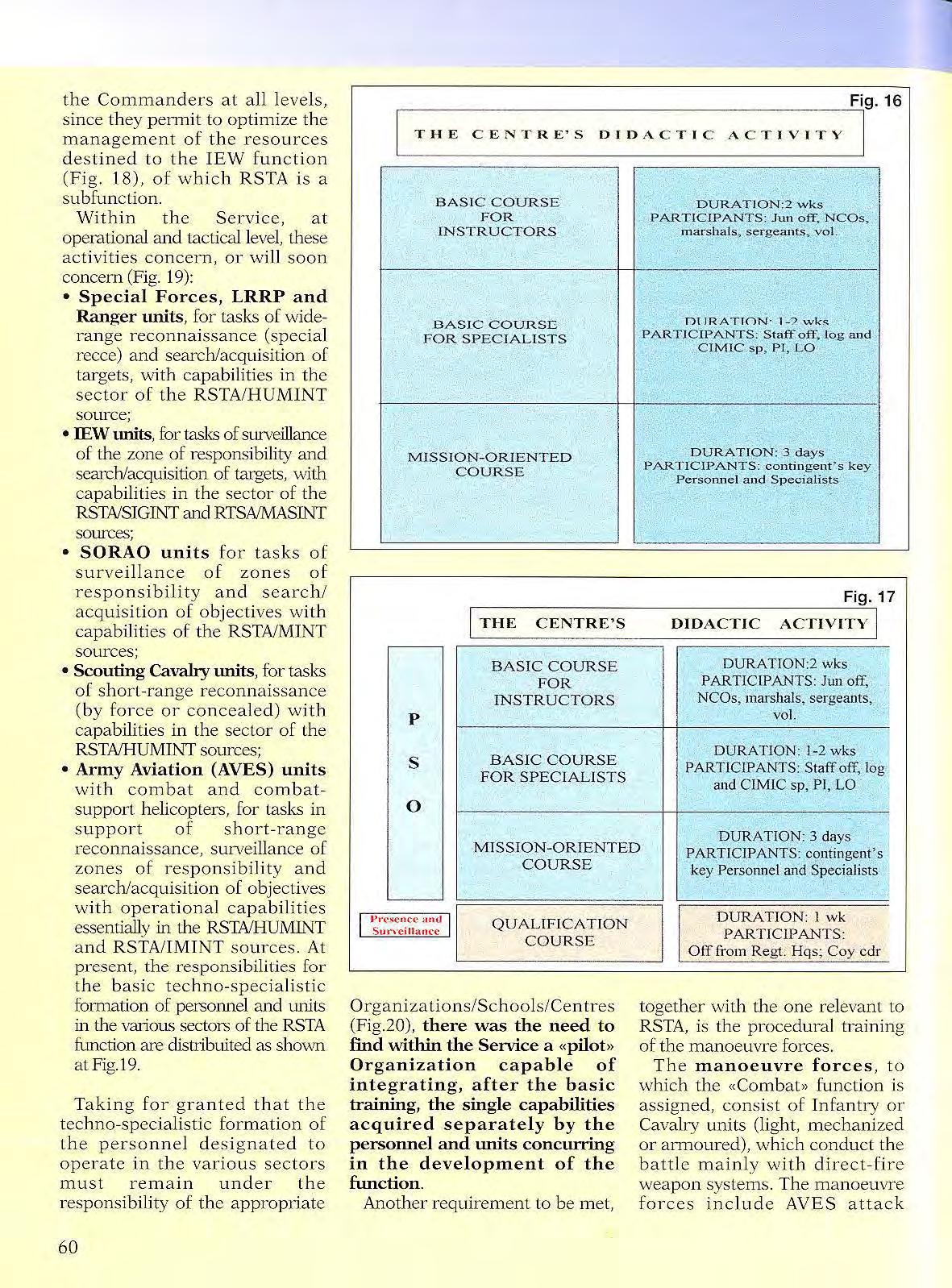
0 rganiza
together with the one relevant to RSTA, is the procedural training of the manoeuvre forces.
Another requirement to be met,
The manoeuvre forces, to which the «Combat» functio n is assigned, consist of Infantry or Cavalry un its (light, mechani zed or armoured), which conduct the battle mainly with direct-fi r e weapon systems. The manoeuvre forces include AYES attack
60 T H E c E N T R E' s o r o A c T I c A c T I v I T Y I
p s
0
-
I J' • csc tl CC a nd I Sur , ci lt a n c c
h elicopters and air:mobi le units. Besides bein g a component of the mano euvre forces (allack he li copte r R eg i ment s, which may or ma y not be included in a n airmobile com plex), th e AVES a i rc raft pla y an equally direct role i n the employment of these forces. This role finds i ts concrete form in the conduct of combat, reconnaissance, s urveilla nce, C2 s upport, tacti ca l and lo g istic transport etc.
In pratice, th e AVES co m po ne n t develops activ i t i es of R STA, com bat-in cooperation \.vith other manoeuverin g forces - corn bat suppo rt and logistic/m edical support to combat. In view of th is, the manoeuvre requires a continuous integration between the swface land forces and the third dimension. Therefore, the dev e lopment of offen sive, defensive an d delaying operations - wher e it is funda m e n tal to achieve surpr i s e and to concentrate efforts at the d esired m ome nt and place, i .e . to manoeuvre forces in space and time - r equ i res, b esides a cons tant training, als o wellestablis h ed procedures p e rmitting the coordinated and cooperative employment of l and forces a nd third dimension. These proc edures must also be updated in relatjo n to the intro du cti on of new airc r aft, new Com m and and Contro) systems, evolutjon of th e emp loyment procedures of th e mi n or un i ts, new technolo g ies (t he trinomial «land vehicleh elicopter-radar integrated with satellite technologies »).
RSTA
Fig 19
.RECCE CAVALRY -
SORA O - --
ORGANIZATIONS RES PONSIBLE FOR TECHNO-SPECIALISTIC TRA INI NG
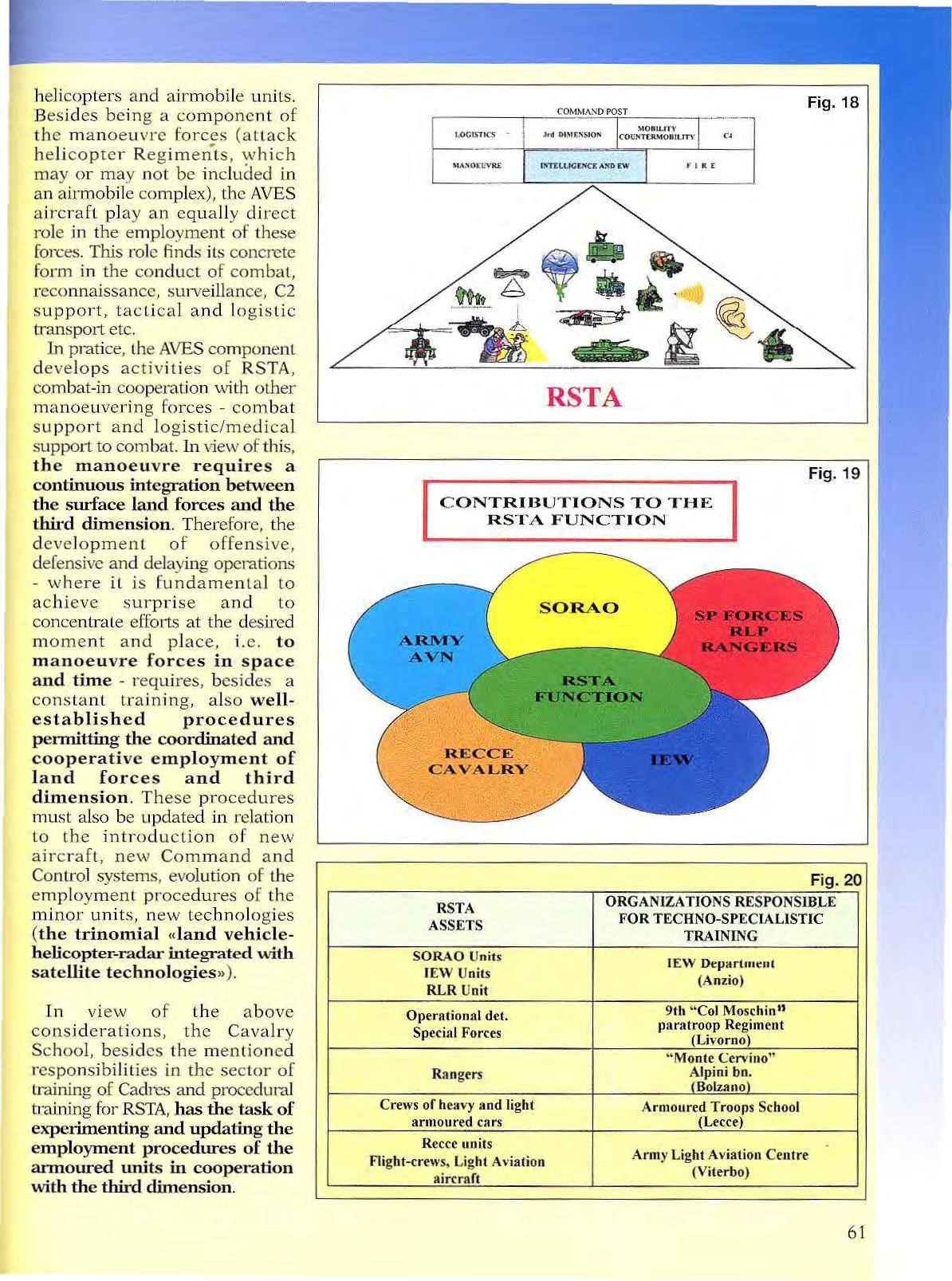
. 111 r , II:C 1,...• I L
SORAO Un its JEW Un its RLR Unit
Op erational det. Special Forces
Ran gers
Crews of heavy and light
.
•
==
9 th "Col Mo sc hin"paratroop Regiment (Livorno) -
" Monte Cervino" Alpin i bn (Bolza nol
Armoured Troops Schoo l g arm o u red ca rs (Lecce)
Rec ce units
Army Ligh t Aviation Centre
Flig ht-crews, Li gh t Aviati on(V iterb o)
ai r craft
. -61
In view of the abo ve consi derati on s, the Cav a lry School , besides the m entio n e d r espo n s i bi li ties in the sector of training of Cadres and procedural training for RSTA, has the task of experimenting and updating the employment procedures of the armoured units in cooperation with the third dimension . -· l
CO NTRIBUTIONS TO THE RSTA FUNCTION
RSTA ASSETS
Fig 20
Ill:!:
- I EW Departm ent
(Anzio)
RSTA and Manoeuvre training and procedural activity.
Basically, the responsibilities of the Centre include two sectors: qualification and specialization of the Cadres of the armoured units, and procedural training of the systems and minor units concurring to RSTA and Manoeuvre.
As re gards RSTA, taking into account t he complexity and div ersHi cation of the unit s, equipment and systems concurring to RSTA, the procedural training must b e conducted progressively and, initially, b y separate and independen t modules.
In p ractice, the fol lowing independent activities m ust be carried out:
•1st level exercise: tactical reconnaissance, conducted only by the minor units (Fig. 21).
Duration : 1 week (2 days theory; 3 days at the fi ring range);
• 2nd level exercise, with t he a ggregation o f two or m ore modules/systems for th e conduct of coop er ationoriented par t ial exercises (recce units, AVES units, LRRP patrols) (Fig.22).
Duration: 1 week;
• 3rd level exercise, with the aggregation and d ep.loyment in the field of all modules and systems for the d evelopment of the RSTA f unc t ion , and the conduct of a composite exercise directed b y an Intermediate Ope r ationa.l Command (COlFig 23). This exercise will be carried out bian nually and could be included in a training context like, for instance, a CommandPost Exercise (EPC).
This activity is the characterizing aspect o f the Cavah-y and Armour School. I n prospect, when t he Sch ool acquires the full capability to manage all the activi ties of the RS TA fun ct ion, the abov ement ioned 3rd-level exercis e will
have to i nclude:
• a CO l Command-Post and 1-2 Briga d e Com mand -P osts;
• an armoured reconnaissanceunit, taken by turns fr om the « Proje ct ion and Reac tion Packages»;
• EC and ESC units of a COMFOTER Army-Aviation Regiment;
• Systems taken from t he units o f COMFOTER's IEW Gr oup (SIGINT, SORAO , RLR);
• F S and RANGER De tachments
At th e level o[ exercised Com m ands t his biannual acti vi ty will have to in volve, b y turns:
• at CO l level, the Projection Forces Command (FOP );
• at Brigate level, in o rder o f priority :
•• the «P o zzuol o d el F riu li», «Alie te» , «Garibaldi>>, «Friuli>> and «Centauro» projection/
reaction Brigades;
•• t he «Folgore» and «Taurinense projection Brigades;
• • the <d ulia>> Brigade, a s Mu l t in at i onal Land Fo r ce (MLF)
Du rin g the transition pe r io d , th is activity could begin with exercises involving only one Brigade-CP and minor RS TA systems (recce uni t, AVES and LRRP elements) connected with the CP accor d ing to a training schedule t o be defined a t a later date.
The procedural training in the manoeuvre sector \Vi.ll have to b e carried out envisaging the execu tion o f different types of cooperation exercises wi th tanks, armoured cars and attack and non -attack helicopters i n o rder to ex p erime nt, study and enhance th e procedures of emp loyment t h at permit to
Tactical - reconnaissance training

62
Fig. 21
Tactica l - reconnaissance training Fig. 22 combined with 3rd dimension a ·nd LRRP
facilitate and improve the cond uct of the manoeuvre.
In particular, the activities wm have to in volve minor formations, const itut ed «adh oc» for limi ted periods of time and biannu ally, with (Fi g. 24) : • minor uni lS, with precedence to those taken from the «Reaction Forces P ackage» Brigad es;
• Ar my Avi ation units from the AYES R eg i me nt ol' t l te airmobile Brigade.
Clearance and Disposal Operational Centre (COB) .
The COB, under reorgani:tation at t h e Army Engineer School, performs bot h trainin g and operational tasks. As regards the operat ion al fu nc t ions, two employment areas are connected to the Cent re: one outside t he n ational territory (clearance in the o perat ions zo ne ) and the ot h er in It a ly (c learan ce of minefields and different types of ordnance, including residuals from war events) . The Centre conducts qualifYing and u pdating courses, and issues certifi cates in line ""ith NATO STANAGs.
Furthermore, the Centre has a data bank with detailed technical in for mation on most mines exist ing in the wo rld: nationality, objective, t ype of acti on, shape, dimensions, etc. and include a
pho tog raph or drawing of the d evice Of course, the availability of these data is a verv us efu l support to both training (preparatory courses, and training of contingents for PSO) and operation s (clea ran ce of minefields and dangero us areas).

Longer-term adaptations
For longer-term prospects, one s hould refer to U1e charactcri:t.ing elements of the evol ution ary process of the mili tary instrumen t as well as to the force multipliers of the human element: leadership and motivation. The m ain elements of the evo lution ary
process are:
• th e degree of inn ovati ve int ell i gen ce , expre ssed by th e joint research and development of ideas and reali:tation concepts, be fore tu r nin g t o materia ls and asse ts;
• the abi li ty to ke ep up with the growth of professionalism a n d t echnology, throu gh the d eve l o pment of formed con cep ts ad equate t o th e capabilities expected from the p ersonnel;
• the degree of the Army-system's intelligence of t hose concepts, appli ed through the employmen t of the men and materi als that
Procedural train ing f or Coopcr·ation amon g tanks- a r mou red cars - 3rd d i me nsio n
Fig. 24
Coordinated emJlloyment of RST A resources in conjunction with art IOC and/or Brigade Command-Post ExerCise
Fig . 23
P.C.
63
C.O.I. (S IACCON)
compose t he Service.
A mod ern Army, in fact, finds its expression through the permanent integration of all its elements an d its capa bility of flexi bly integrating i ts co mpo nents into ta sk fo rcescons isting of men and tech n ologies - whose duty is to carry out p lanned or contingent assignments. On the basis of t hese tasks , trai n ed and p rofessi onal men emplo y sop hi stica ted and innovative t ec hno logies in the fiel d s of mechanics, electronics, au to malio n , info rmat i cs and satellite comm unicati ons, ma inly applied to the func tional sectors of command and control, to the t hrust and pmtection capabil ities of the armoured forces, the power of the contro ll e d- effect s urgical fi re of artille ry and Cr uise missiles, the exp loration of air and land spaces, integrated with the «l and-ve hicle, radar» trinomial.
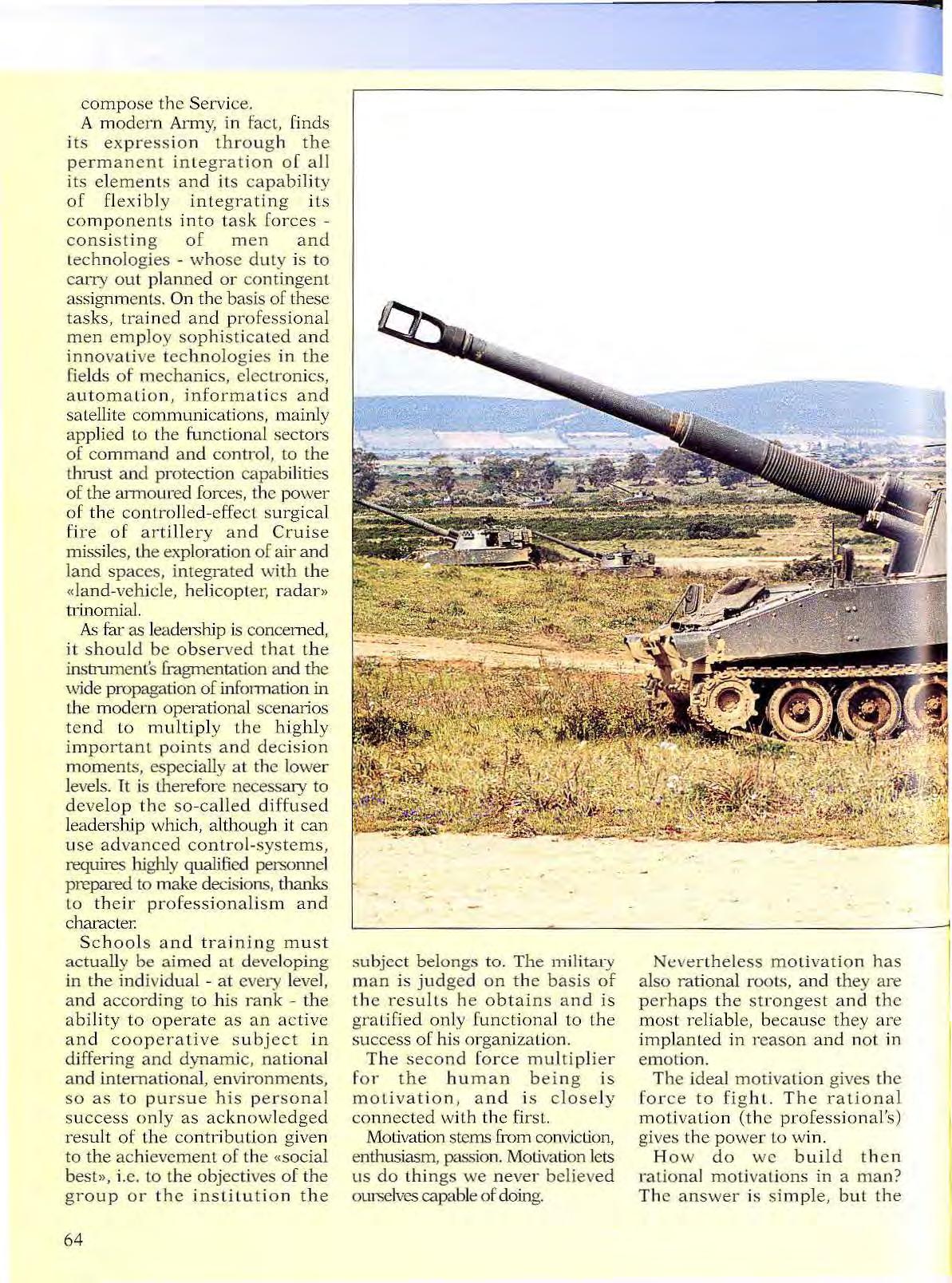
Ac:, fa r as leadership is concerned , it should be observed that the instrument's fragmentation and the "vide propagation of information in the mod ern operational scenarios ten d Lo mu lt i ply the h ighly important points and dec isi on momen ts, especially at the lower levels. It is therefore necessary to develop the so-ca lled diffused leadershi p whic h, although it can use ad vanced control-syste ms, requires highly qualified personnel prepared to make decisions, thanks Lo their professionalis m and charac ter.
Scho ols an d tr a i ning must actually be aimed nl devel oping in the individual - at every level, and according to h is rank - th e a bility to operate as an act iv e and cooperative subject in d iffering and dynamic, natio n a l and internati onal , e n vironments, so as to pursue his personal s uccess only as acknowled g ed resu lt of the co ntrib ution gi ven to the achievement of t he «S ocial best», i.e. to the objectives of the group or the institution the
su bject belongs t o. Th e m ilitary man is judged on t h e basis of the re su lts he obtains an d i s gra tified only fun cti ona l to the success of his o rganizati on.
The second force multiplie r f or the human being is motiv ati on, an d i s clos ely connected w i th the first.
Motivation stems from conviction, enthusiasm, passion. Motivation lets us do thin gs we never believed ow-selves capable of doing.
Nevertheless mo ti vation has also rational roots, and they are p erha ps th e strongest and the most reliabl e, because they are implanted in reason and not in e m ot i on.
The i deal motivation gives the for ce to fighl. The rational motivatio n (the professional's) gives the power to w in.
How do we build then rational motivat ions in a man? Th e answer is sim ple, but the
64
solution is difficul t and laborious : the achievement of a high -d egree o f professionali s m. The milit ary organization is a machin e whose objectiv e effectiveness and efficiency as regards th e serv ices it s h ou ld render to society are c hi efly enstrusted to the professionalism of t he protagonists. E very member of this organization must b e a professional and feel like o n e, because he is called to
provi de his expertis e and to COtTectly operate the mechanism he is responsible for, o f which he knows the workings perfeclly.
To lay out the future stmcturc of the school-training organiza tion accor ding to the eme rging pointers, a project is being drafted to consti t u te an Authorit y for Do ct rine , P rocedures a nd Traini ng , a kind of Italian TRADOC, to which a l so the secto rs of applied Operational
Research and Simulation woul d b e a ttached, in suppo rt of decisions and planning.
T he said Aut h orit y and the Agency to be instituted under its control, will h ave to implement the propul sio n model of the Army. Th ey will b e formed throu gh the aggrega tion and the reorga n ization of th e resources that now opera t e wit hi n the Inspcctoratcs of Services a nd Schools.
In particular; this Authority would have the task of sys tematizing the generative p r ocess of the Land forces' basic requireme n ts - the capabili ties - in the var ious operational and c ooperative environments.

Th is process, to be carried out in the appropri ate international meetin gs, starts w i th t he defini tion of th e sce narios and is follow e d by the elaboration of the opera ti onal co ncepts. After this, one goes on experime nting the concep ts in virtual and real training e n vi ronments as well as in a n operational envi ronment , thu s activatin g and feeding the Cycle of th e Lessons Learned.
Th e last p h ase of th e process , \.vhich has moreover a continuou s and self-adjusting cyclic character; consists in defini n g the forces' requirem e nt s as regards the six fundamental qualifying areas of a Service (man, doctrine , leadership, mate r ials, force orga nization , training).
Th e me n tioned Authorit y, besides , would represe n t the fulcrum of a system of verification and validation of the capabiJities and of the units, as a precondition for th eir organic homologat ion and operational e mployment.
"''Brigadier General, Chief, Working Group, Anny General Sta ff Colonel, Sectio11 Chief, Pla ns Office, Army General Staff
D
6 5
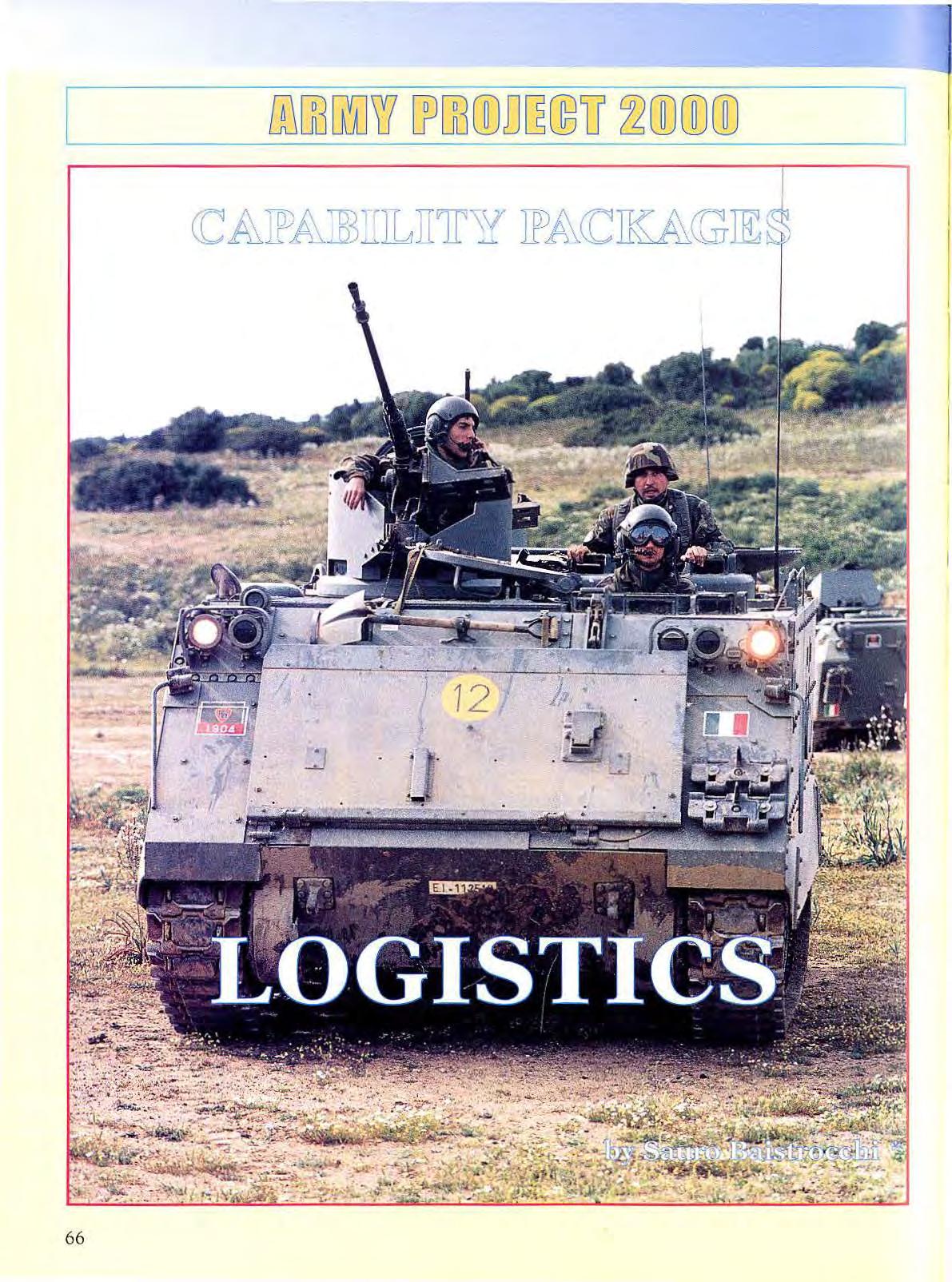
... .!J .:.J 66
E VOLUTION OF TH E OPERATIONAL SC E N ARIO S
Dur i ng the four-decade-long bipolar confron tation in Europe th e Ila lia n Army- like the Annies of mo s t NATO n ati ons - was enga ged in a credibl e a nd effective defence against a t h1·eat clear·ly defin ed as for its orig in , d irection and intensity.
The ev e n ts of t he las t d ec a d e , a lthough decid edly removin g the prospect of a large-sca l e conflict in Western E urope, ha ve made th e scene of in t ernati o na l re l a ti o ns m u c h mo re complex and unstable a nd fav oured, a t the same time, the risi ng of t h e geestrateg i c condit ion s fo r a preventive and esse ntiall y remote control o f confl icts, b e th ey la tent or act u a l.
Once the conce pt of sta tic defe n ce w as overco me , a commo n policy of d ynami c security began to take shap e w ith in the United Nations, th e Atlantic All ian ce and w ithin the dawning Eur ope an Union. This po li cy is essentially projected o ut s ide national b orders, t owards the a reas whe re, within a State or a mon g States, s ituations of political , social or economic c ri s i s occur, with possible con fli c t sp irals and exte nsion to the neighbou r ing terr ito r ies, or w it h t he p oss ibili ty of affecti n g th e gene ral int eres ts of economi c deve lopm emt a nd social progress
Wit hi n this framework, the employ m e n t of the I tali an Ar me d Forces and , in partic ul ar, of the land forces, a primary tool of the P eace Support Operations (PS O), assumes a n ew value, mu ch rno re act i ve and dynamic t h an that of th e «c old wan> years
The Ar:my, th erefore , if in the long term is still a producer of forces, trained for detetTence and d efence, on the fr ont of the m ul tin atio na l contro l of outs id e -th e-bor d er conflicts, beco m es an instrument ab le to express, at short notice, real operational capabilities, incl ud ing
comba t o nes .
T h e o p era ti onal scena rios that can be imagined today and fo,· th e f utu re can t entat i vely be gro up ed into three main types of confl ic t:
• conve ntio nal co nflic t b etw ee n forces with basically equal capabi lities;
• asymmetrical conO ic t between forces \Vith va ri o us and d iverse de g rees of capab ili ty ; • other- than-w<:u· uperations, particularly those in supp or t of peace.
The types of con flict pointed out, whi ch no d oubt take ro ot in tod ays re a li ty, blen d on e into the other and ove rlap in time and space
Nevertheless, t he y have in common signif ic ant general c h aracteris ti cs, so me of whi c h are of p a r ti c u lar interest for the pu rposes of thi s study.
F irst of all, it is evi de nt that there is a pe rsis t en t tendency towards a preve ntive a n d r emo te managern e nt of the cri s es, with th e e mployment of multinati o na l and joint formations, relatively limited in size, for ope rat io n s outs id e t h e n atio na l bord ers.
T h e as y m rn e try of the opp o nents increases. Th e operational environment tends to extend more a nd more t o include new dimension s o f conflict an d t o ass u m e mark e d ly non-l i near charac teristics.
Furthermore, the environment becomes inc reas ingly urbanized.
The inte rco nn ec tions an d overl app i ngs of the ta cti ca l , opera tional and s trat e gic levels be come mor e co mplex an d dynamic, and a1·e fostered by the cond iti o ns posed by public opinion and politics, a lso with refe ren ce to the safeguard o[ th e environm e n t and the possibl e ex plos ion o f the humanitarian dime nsion of the conflicts. The con tours of tasks and responsibi li ties tend to fade away a nd assume a m ark e d character o( n o n -linearity. The i ndividual so ld ie r becomes in creasingly important and costly,
a nd t end s to b e con sidered an in d ividua l oper ation a l p latfo m1.
Th e role of lo gi stics, more and more important for operational success, is extending far beyond i ts tr aditi onal scopes
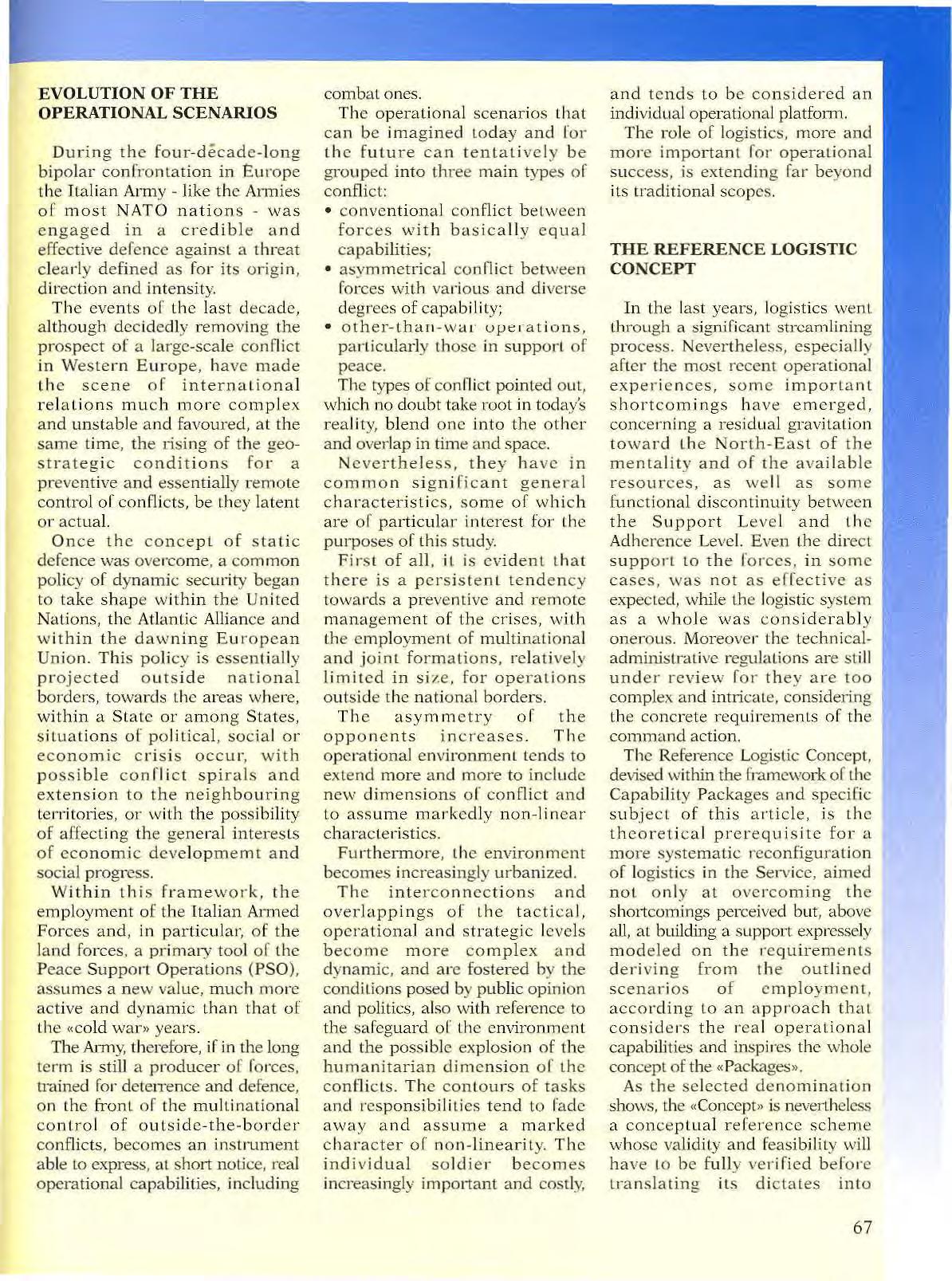
T HE REF E RENCE LOGISTIC CONCEPT
I n the las t years, log is ti cs went through a signi ri cant stream linin g pro cess. Nevertheless, especially after the most recent operatio nal expe1· ie nces, some impor tant s h ort co m i n g s hav e e m erg e d, conce rning a residu a l gravitat ion to ward the North-East of the mentality a nd of the avai lable reso urces, as we l l as some functional d i s continuity b etween t h e Support L eve l a nd th e Adh erence Level. Even the direct support to the forces, i n some cas es, was not as effe ct ive a!i expe c ted, while the log istic system as a who le w as co ns id e r ab.ly onerous Moreove r the technicaladm inistrat ive regulations are sLi ll under review for they are too complex and i n tricate, consideling th e concrete requ ire ment s o f th e comm a nd action.
Th e Re fere nce Logistic Concept, devised within the framewo rk of the Capab ility Packages a nd sp ecific subj ect of this a nic l e , is th e theor et i cal prer equ isi t e for a mo re syste matic reconfiguration of l ogisti cs in the se,·vice, aimed not on ly at overcoming the s h mtco mi ngs perceived b u t, a b ove all, at building a s upport exp ressely mod eled on the requirements d er i ving from the out lin ed scen ar ios o f em p loyment, accord i ng to an a pproach th at co nsid e rs th e r ea l o p e rati o n al capabili ties and inspires the whole concept of the «Packages».
As the se lected denom in at i on shows, the «Concept» is neverth eless a conce p tu a l refere nc e s cheme whos e va lidity and feasibility will have to be fully verifie d before translating its dictates into
67
organizational measures.
The basic idea subtended by the Concept is a radical change in the gravilat ion of t he support assets, no more statically anchored to the na ti ona l territory and to a welldefin e d threat, but dinami ca ll y recon figure d, in terms of mentality and capability, for the projection and sustainment of formations - also multinational and joint - engaged in operations outside the border.
The approach is greatly innovative also from Lbe o rganization al point of view. Fro m a mas s logistics, essentially based on potential needs, \.Vith burdensome and «just in case» unused stockpiles and capabilities, we move to a high-quality support, based on the scientific determ i nation of th e ac tu al requ irements (tendentially «just in time»), accomplished by specialized bodi es, accor ding to centrallyexecuted plans and pro grammes. Th e u se r (the Oper ational Commander is reliev e d of the techn i ca l -a dminist ra ti ve responsibi l ity of the support: however, h e has full authority as regards definition of needs and control (w ithin pre-established limits) over the inflow of resources.
The purpose of the mode l proposed by the Con cept, in subs t ance, is to build a l ogist ic instrument, no t only effective and flexible - being structured on th e basis of the needs of th e inT heatre Operational Command er, an controlled directly by him - but also e([icien t in economic term s, si n ce it aims at giving a certain return vis-a-vis a calculated and accepted risk, using on ly the necessary resources.
The Reference Logistic Concept, whi ch t his article, for obviou s reasons of space, only illustrates in its essen tial features, is centred on five comerstones, which support its logistic and organizational layout
• Great Base;
• Command and Control Organization and LogU,tic System;
• Program me of the logistic activities;
• Specialization of the logistic bodies;
• Capability of m ul tinational logistic integration.
Some organi za ti onal as pects of the Concept are represen t e d in Fig.l and 2, in term s of comparison with the classic scenario of the past and could serve as a general help in readi ng this article.
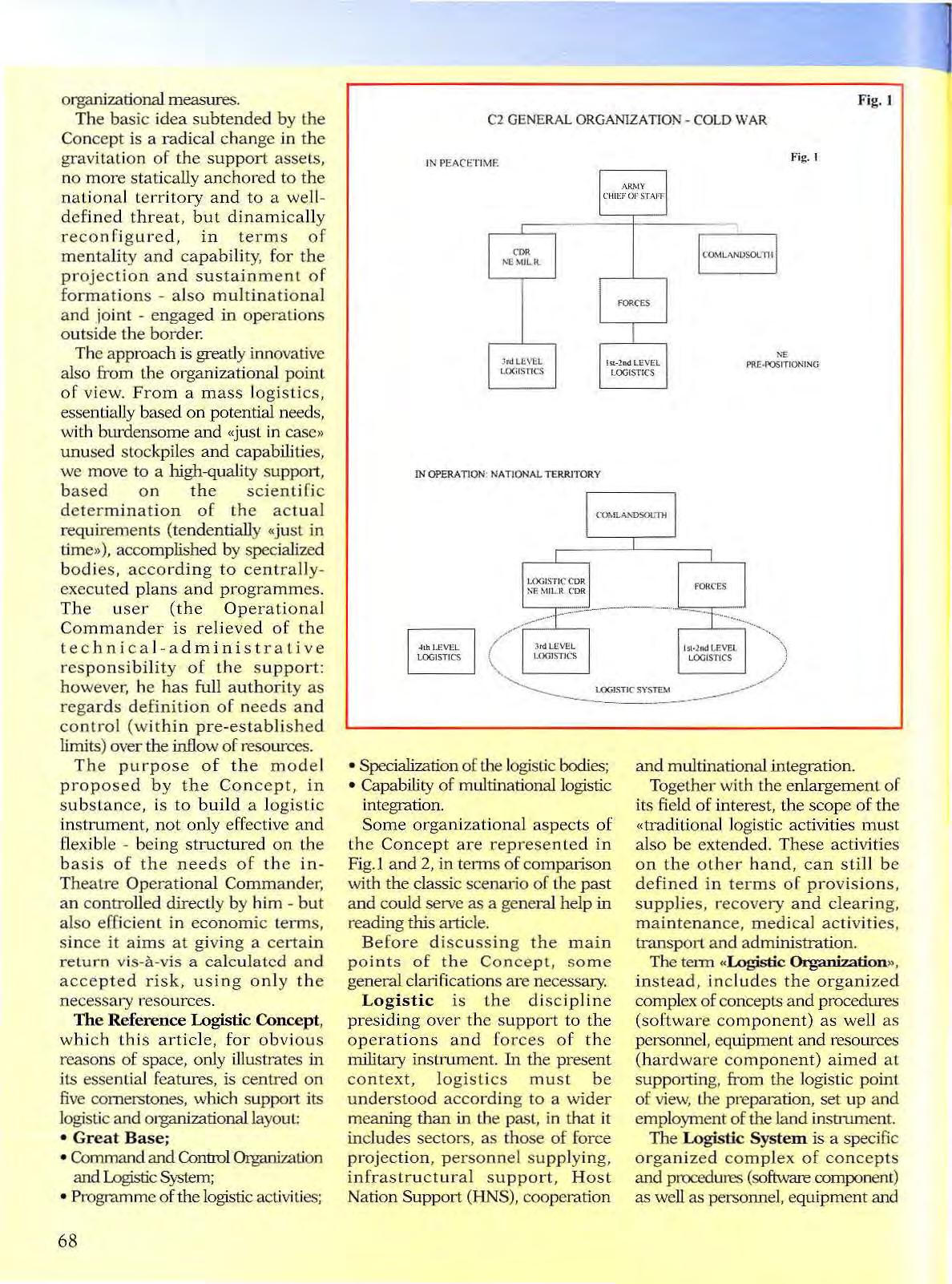
Before discu ssing the main points of the Concept, some general clarifications are necessary.
Log istic is the d iscipline presidjng over the support to the ope rations and fo rces o f the military instrument. In the present context, logisti cs must be understood according to a wider meaning than in the past, in that it includes sectors, as those of force projection, personnel supp ly ing, infrastr u ct u ral support, H ost Nation Support (HNS), cooperation
and multinational integration.
Together with the enlargement of its field of interest, the scope of the «traditional logis tic activities must als o be extended. T hese activit ies on the other hand, can still be defin ed in terms of provisions, s u pplies, recovery and cleari ng, maintenance, medica l ac ti vi ties , lrc111sport and administrati on.
The tetm «Logisti c Organization», instead , inc l udes the organi zed complex of concepts an d procedures (softw are compo nent) as well as personnel , eq uipment and resources (hardwa re component) aimed at supporting, from the logistic point of view, the preparation, set up and employment of the land instrument.
The Logistic System is a specific organized complex of concepts and procedures (software component) a s well as personnel, equipment and
68 Fig. I
IN PEACETIME IN OPERATION: NATIONALTERRITORY
C2 GENERAL ORGANJZATION - COLD WAR
I NE PRE I'OS ITIONING
fig.
resources (hardware componen t), p roduced by the Logisti c O rgani zatio n and a imed at supporting a partic u la r mi ss i on assigned to the la nd instrument or to a portion o f its forces.
Therefore, the re is onl y one Logistic O rga n i zati on, ab le to p r oduce several Logistic S ystems (shown at Fig.3 as A and B ), generally one (or P.:Jr.h sr.P.n ario of emp loymen t , type o f miss ion (or group of similar sce nario s) or for each large-sc ale activity of th e instrument.
Wilhin this framewo rk, Adherence Logistics provides a direct to the forces, w hile Support Logistics guarantees Lhe necessary flywheel of capabilities a nd reso urces, for t h e requ iremenLS of adherence as a who le. T h e Logistic Organization guar antees th e logis ti c support to
Fig. 2 the n a ti o n a l lan d inst rument , p rod u ci n g Logist i c S ystems capable of sustain ing, at supp ort and adherence leve ls, wit h calculat ed effec tiveness and logistic risk:
• the pre p a ra tion of Commands and units;
• th e set u p and p rojection of th e fo rces, o n the na t io nal territory an d outside the nationa l borders;
• th e p erforma n ce of the assi gned task in the a rea of e mployment. The aim of the Logistic Systems is to suppo rt:
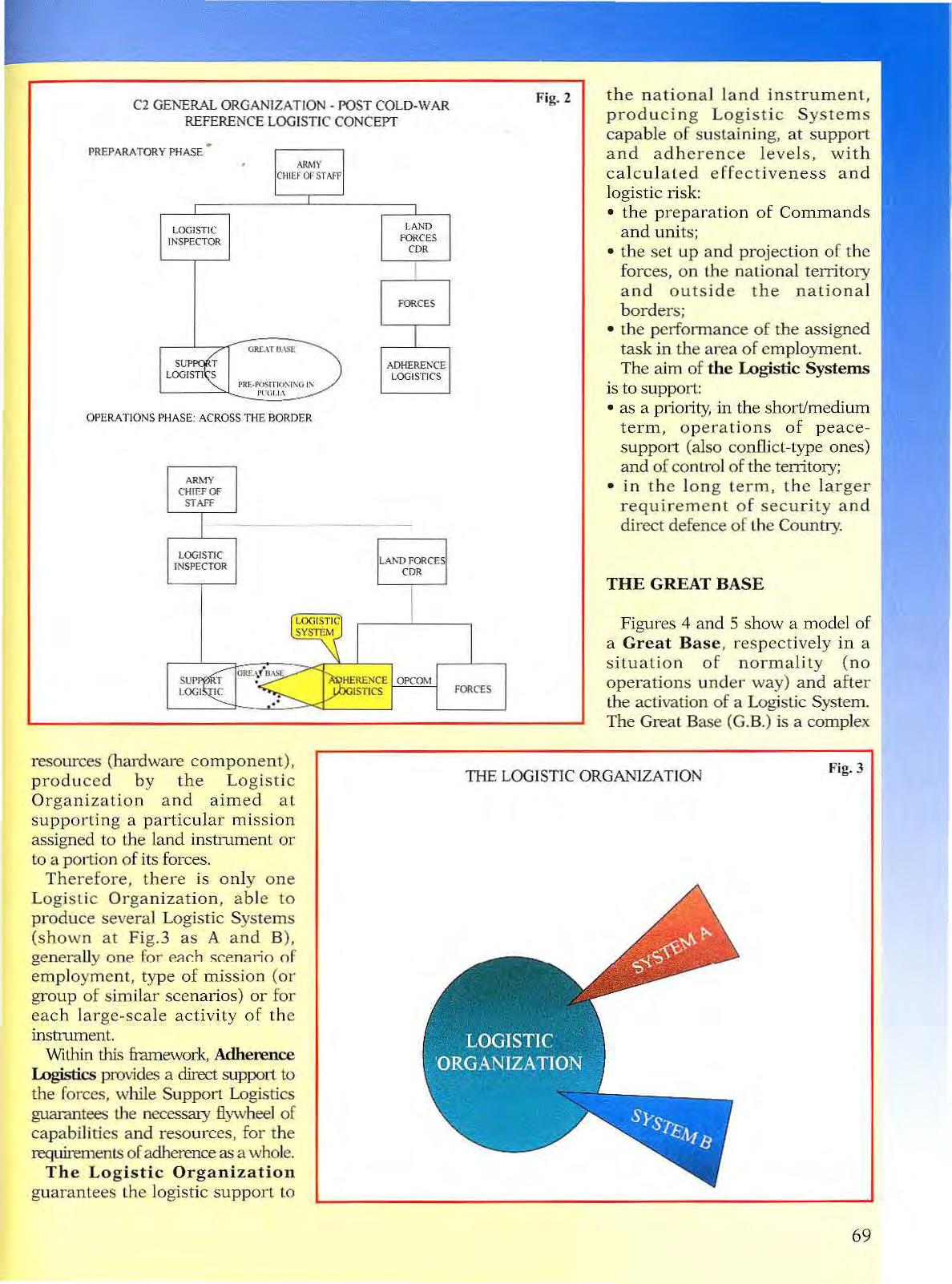
• as a priority, in the shorUmedi um term, o p e r a tions of pea cesupport (also conflict-type ones) and of co ntro l of the territory;
• in the l ong term, the la rger re quirement o f secu ri ty a nd direct defence of the Country.
THE GREAT BASE
Figu res 4 a nd 5 show a model of a Great Bas e , r es p ec tively in a situa tion of normali ty ( no operations u nde r- way) and afte r the activation of a Logistic Sys tem The Great B ase (G. B.) is a complex
PREPARATORY PHASE •
C2
GENERAL ORGANIZAT ION- POST COL D- WA R REFERE NCE LOG ISTI C
CONCEPT
OPERATIONS PHASE ACROSS THE BORDER
69
THE LOGISTIC ORGANIZAT ION Fig.3
logistic str u c ture at Support Level, lo ca ted on the national territory. It represents the model of reorga niz ation o f the logisti c resources available, an d its p urpose i s to supp or t. the proj ection of the Forces outside tl1e national borders and their sustainment in operations of peace support, crisis management an d conflict-type operations g uarant eeing a lso th e n ecessary hardware-an d -soft ware interface between Support Logistics on th e national territory and the Adherence Logistics in lhe Operations Zone.
The Great Base consists of:
• a G.B. Co mmand (division level);
• one Operations Roo m for Support Logistics (SOSTLOG ) and 1-2 ( I ) Operations Rooms for Adherence Logistics (ADERLOG);
• ass ets for th e laun ch ing and s upport of t he operations;
• a G.B. management unit which deals with the resources.
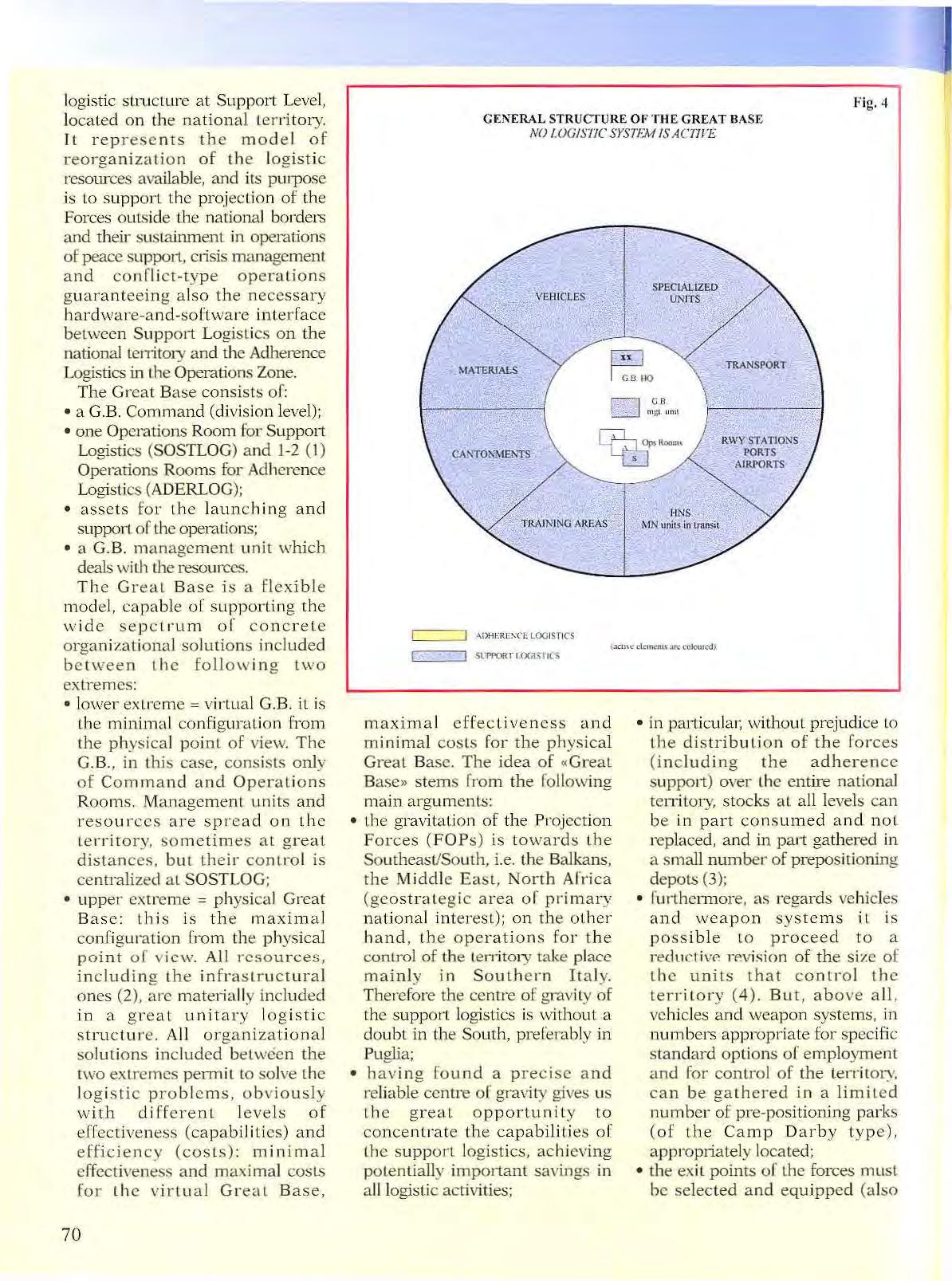
The G reat Base is a flexi bl e model, capable of SLLpport ing the w ide sep c trum or co ncrete organ izational so luti ons included between the follow in g two extre mes:
• lower extreme =v irtu a l G.B. it is the minim a l configuration from the physica l point of view. The G. B., in this case, consists only of Comm and and Operat i ons Room s Management units and resour·ccs are spre ad on the te r-rit ory, so metime s at g reat. distances, but their contro l is centralized at SOSTLOG;
• upp er extreme = ph ysica l Great Base: dJ i s is th e maxima l config ur·ation from the p hys ical point of view. All resources, including the in frastruct u ral ones (2), arc materiall y incl uded in a g r ea t unit ary log istic s tructur·e. All o rganizat ional solutions included b el'ween the two extremes permit to sol ve the l og isti c prob lem s, obvio us ly with different l evels of e ffec ti veness (capabilities) and efficiency (cos t s): m inimal effectiveness and maximal costs for the virt ual Gr eat Base,
max imal effe ctiven ess and mini mal costs for the physical Great Base. The idea of «Great Base» stems from the follo,ving main arguments:
• Ll1 e gravitati o n of the Projec tion Forces ( FO Ps) is towards th e Southeast/South, i.e. the Balkans, the M iddle East, North Africa (gco strategic area of primary natio nal in terest); on the o ther hand, tbe operation s for the control of the tenitmy take place mainly in Southern Italy. Therefo r e the centre o f gravity of the support logistics is without a doubt in the So uth, prefera b ly in Puglia;
• bavi ng found a precise and reliable centre of gravity gives us the gre at op portuni ty to concentrate th e c ap abilities of the s upp ort logistics, achieving potentially important savings in all logistic activit ies;
• in w i thout prejudice to tbe distribution of the forces (including the adher ence support) over th e entire natio n al terri tory, stocks at all levels ca n b e in part consum ed and not replaced, and in pa rt gathered in a small number of prepositioning depots (3);
• furthe m10re, as r egards vehicles an d weapon sy stems it i s possib le to pr oceed to a reductivP. of the size of the units that control the terr it ory (4). But, ab ove all, ve hicles and wea pon systems, in nulTJbers appropr iate fo r specific standard options of e mp loyment and for control of the territory, can be gath ered in a limited numb er of p re-pos itionin g parks (of the Ca mp Darb y type), appropria tely located;
• the ex it points o f the forces must be selected and equ ip ped (a lso
70 f ig 4
LOG ISTICS L:..c.---'' Sl1'PORT U)G inlCS
GENERAL STRUCTURE OF THE GREAT BASE NO SYSTFM IS AC17VE
from the bureaucratic point of view) b eforehand, i. e. once and for all. One port, one airport and 1-2 raiJway sta tions (in th e Brindisi/Bari area) are sufficient. In fact:
• • to have more than one exit point does not make sen se, considering that the bottlenecks when introducing th e Forces in the Th eatre are t h e entry points and not the exits from Italy; •• if the em ploymen t Theatre is local (within th e ment ioned geostrategic area) the Apulian are th e best. If th e Theatre is remot e, it do es not mak e much difference whet her the embarkation port is Bari or· Genova; the fact remains tha t, if neces sa ry, part of the personn el can be em barked at any airpor t;
should t he Th eatre be in Eastern Europe , (tr ansport by rail), materials could anyway be loaded from ad-ho c platfom1s
Fi g . 5 p lac ed ve ry near to t he parks and prepositioning depots.
In any case , the l oca tion and permanent organization of the exit points are extremely important fo r a good l ayo ut of the logisti c ins trument.
For the above reasons, the Great Base should preferabl y be located in Puglia. Ju s t by way o f exampl e, Fig.6 shows a possible experimen tal pr-ototype or such a s olutio n, to which the follovving main resources, proportiona te to th e s tand ard options of empl oyment, should be a-;s igned/alloca ted:
• prepositioning parks ror vehicles an d ·weapon systems, for th e initial conditioning of the FOPs and sustainment of the operations (rep la ceme nt of inscrviceable material s re mo ved from the Theatre);
• prepositioning d epots, fo r th e initia l condition ing of t he FOPs (co nfe rn1e nt of the b asic a utonom y) and provisionin g of t he operations (supplies);
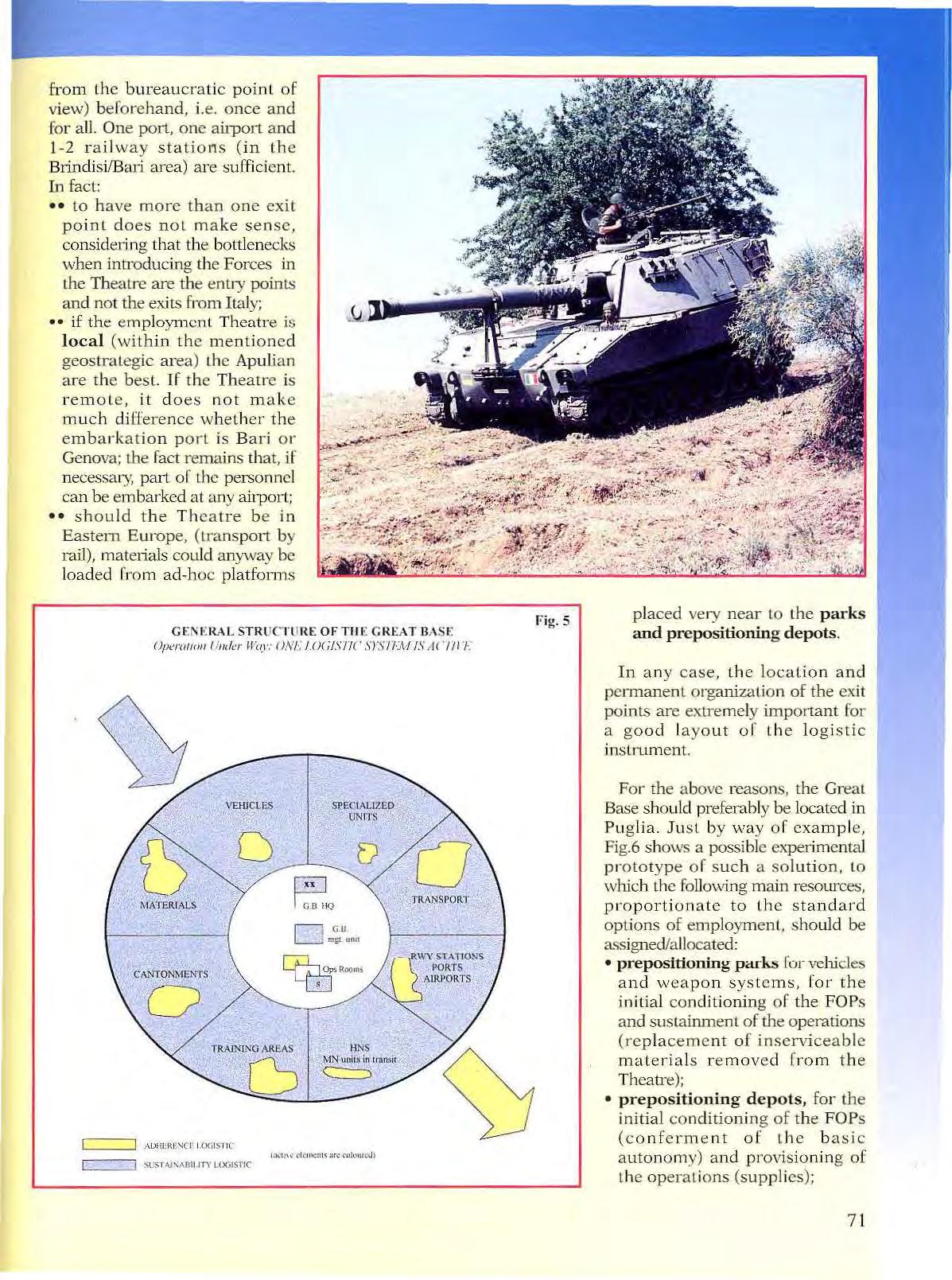
STRUCTliRE
Opera/it ill Under Wo_r: ON! ·: /.(}( ;JSl'lC IS!/(. '-- ---' :\Dt-H! I{I:.\ICF I ()( ii S'II t c-= j LoGISTIC
••
OF T II F. GREAT BASF:
7 1
, oice n,eatre wan
• organs for the mainte n ance of Sup po rt, including civilian contracto rs to keep parks a nd matet"ials in working ord er and to repair the equipment removed;
• we ll e quipped qu ar t ers and camps, for the FOPs' stopovers, including possible non-nationa l un its (Hos t Nati o n Support act i vity on It a l ian territory) waiting for their introduction in th e Th ea tre;
• trainin g a r eas and s h ooti n g r a n ges , for t h e act i v i t i es of preparation and amalgamation of th e FOPs;
• ra il way sta t i ons , po rts and airports, and the relevant li m its for the i r management, i. e ex it p oi nts to be use d fo r the p rojection of the FOPs, their rotation and the logistic a<>sistance to operations;

• ve h icles , in the s h a p e of spec ifi cally assigned units (motor vehicles, h elicopters) or movem e n t c r e dits ( milita•·y and com m ercial aircraft and ships) for t h e transport of forces and
matelials;
• specialist units (commu nica tions, mai n tenance, engineers, medical corps, traffic contro l, e tc.) for the Functioning of the Great Base itself, for logistic reconna issance (spec ialized contribu tion) a n d for pro j ectin g contac t t e ams int o t h e Theatre. In compli a n ce wit h the p ermane nt and contingent direc tives iss ued by the responsibl e Commande r s OSPELOG, COMFOTER, COMFOP) for the ir respective sectors of responsibi l it y, the Grea t Base s hould:
• plan the parks fo r veh icles and mate r ia l s accordin g to t he s tandard optio ns, and precondi tion them for pro jection;
• plan and car ry out, t ogethe r with FOPs op eratio n t ea ms, the prelimin ary in- Theatre reconnaissance, provi ding , in pa r ticu la1·, a spec ialized con tri bu ti on, a l so in re lation to the negotiation of MOUs and technical-logis tic agree ments
• ensure th e maintenance and th e efficiency of the pa rks ass igned, perfecting t heir composit io n a n d se tup accor ding to th e specific opera tional events an d th e resu l ts of the prelimi nary reconnaissance;
• sch edu l e and monitor th e transfer of the F OPs fro m t he ir garrisons to the Great Bas e, conc u rri n g, if necessary, to th e organi zat io n a nd execu tio n of th e movement;
• guarantee fu ll su pport (reception, logistics, c antonments, trainin g areas) to th e hal ting F OPs as well as to the non-national u nits that may be in transit HNSI;
• carry out the co ndi t ioni ng of the FOPs, i n cl u ding th e handi ng ove r of materia ls and equipment t o the Continge nt's dep ositary;
• loa d f orces and materials on th e veh ic les an d project the m into t h e Theatre, fo r the in itia l introduct i on an d succes s iv e periodic rotat ions;
Fig. 6 PROT OTYPE OF' GREAT BASE SOUTHERN AREA LOG CD OPSROOM SOSTLOO c OPCON ADERLOG • OPCON ADERLOG F OPCO:\ G B T A c 0 N TACON
72
r*,
G.B. EXECUTIVE ORGAN S
i . fL.J I L -----·--·------------ ;
RELORE (NA)
• e n s ure t h e logis ti c support of th e opera t io n in progress for all i t s duratio n ; • pla n and can y out the movements fo r t h e withdra wal of the FOPs from th e T heatre .
At t h e beginning, t h e Great Base would hav e , a n es se nti a ll y «virtu al» being r eali zed t h ro u g h t he co ncen tra ti o n of res o u rces an d ca pa b ilit ies di stri but ed ove r a large area of so u th ern I taly. Late r it could also ass u me a phys i cal configura t io n , in order to ex pl o it in t h e best p oss ible way the savings obtai n ed from the co n ce n tr ati on of i nf r as tru c t ure, m a te r ia ls and e qui pm en t , a nd to optimi ze t h e p erfo r man ce of t he support u nit s .
THE ORGANIZATON OF COMMAND AND CONTROL
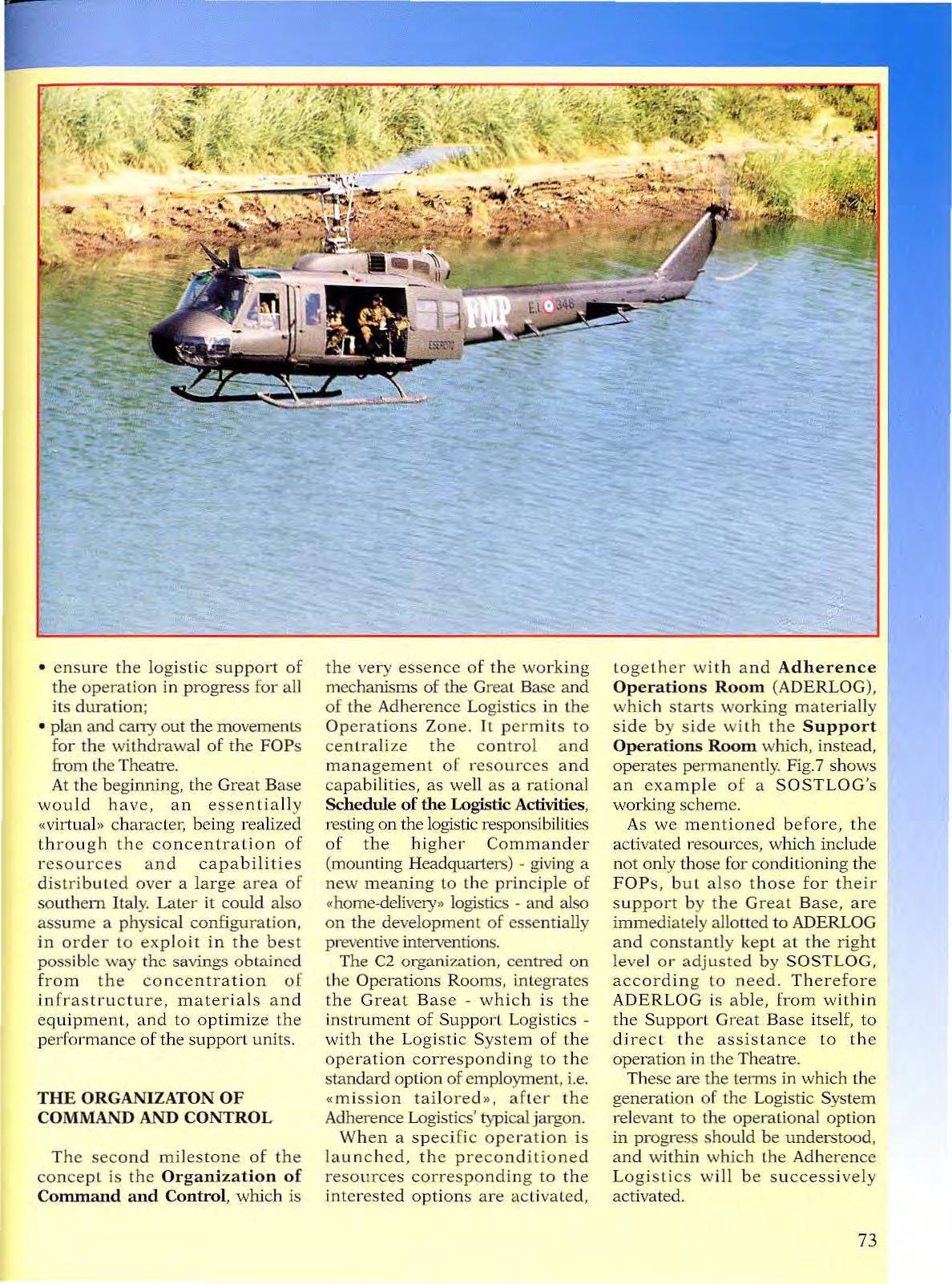
T he seco nd mi lestone of the conce pt is th e Organization o f Command and Control, w hi ch is
the very esse n ce of t h e wo rking m ec hanisms of t h e Grea t Ba<;c and of the Ad he rence Logis t ics in the Operat ions Z o n e. Jl p erm it s to cen tra l iz e t he co n trol an d m a nagemen t of r esources and ca pab ilities, as well as a ra tio n al Schedule of the Logistic Activities, res tin g on the logis tic res po ns ibili ti es of t he hi g h e r Co mma nd e r (m oun ti ng Hea dquarters) - gi vi ng a ne w meani n g to t h e p ri n c ipl e o f «home-delivery» logistics - and also on t h e d evelop me n t of esse n t i ally preve n tive interven tio ns.
T h e C2 organi za.t ion, centred on t h e Operations R oo ms, in teg rates t he G r e a t Base - wh ic h i s th e in s tr u ment of Suppor t Lo g is ticsvvith the Logi s ti c S ys t e m of t he o p e r atio n co rrespondin g t o t h e sta nd a rd o p t ion of em p loyment, i. e «m i s s ion ta i l o re d », afte r the Adh ere nce Logistics' typical jargon
W h en a spec i fic ope r at i o n is la un c h e d, th e preconditione d resour ces co r r e sp o n ding to the inte res t e d opti o n s a r e ac ti vat e d ,
tog e th e r wi th a nd Adherence Operation s Room ( ADERLOG ), wh ic h sta r ts wo r king ma t eri a ll y side by side wi t h t h e Support Operations Room which , instead, op erates p ermane n tly Fig 7 s h ows a n exampl e of a S OSTLO G ' s working sc h e m e
As w e m en tione d b ef ore, th e activated reso u rces, w hich inclu de not o nl y t h ose for con diti o ni n g th e FOP s, b u t also t hose for the ir sup p o rt b y the G rea t B as e, are immediately allo tt ed to ADE RLOG and co n stantly ke pt a t the r i g h t leve l o r adjuste d b y SOST LOG , ac cordin g to n ee d T h e r efore ADERL OG i s a ble, fro m within the Sup por t G re at B ase itself, t o di rec t th e as sis t an c e to th e op er a t ion in th e Theat re .
Th ese are the terms in which t he generatio n o f the Log istic System re levan t to the operati o na l op tion in progress should b e un derstood, and with in which t he Adhere n ce Logi s ti cs w ill b e s u cce s sive l y acti va t ed.
73
The Gr eat B ase, by closel y int egr ating Support and Adheren c e within its struc tur e, gua rantees the Ltnity of the Logist ic S ystem, excluding potential fractures or gaps b etween the t wo Levels.
The working principle of the Operations Room s , SOSTLOG and ADF R I.OG, is the bas ic fcattu·e of th e C2 organizati o n, in that these R oo ms conduct th e centralized co ntrol of th e en tire l ogistic support of the operat ion.
SOSTLOG and ADERLO G work s ide b y side and are physically id e n t ical (same so ftware and h a rdware) and therefor e int e rchangeabl e after a software reconfig u ra li on. The y ar e respect ively activated by the staffs of the Great B ase Headquarters
an d of an Adh ere nce Logisti cs Headquarters (COMLOG), produ ced by COMFOT ER or COMFOP, de pending on the op tion.
The Ro oms co nsist of an opera tion a l contro l section , h eade d b y an operationa l controller, and a tactical con t rol sec tion, dir ected by a tactical controller who - a lbeit conducting spec ific elabo rat ions re lated to t h e i r respecti ve funct ions - avai I th emsel ves o f the same data-base of the situation, w hi c h reprodu ces, amo ng other thin gs , the logjstic picture of the moment.
The opera tion al con tr oll er rece ives his orders and works out on a compute r, the plans of the com plex lo gistic activ i ties, usin g the data - base of the s i t uati on to al l ocat e th e resources and
coordinate the programme for their em ployment. If necessary, he can transmit the plan, also on to the Command s and Organiza tion s co n c erned. However, h e is not qualified to modify the situatio n data; in other ·wor ds , he can use the l ogistic picture of the moment , but cannot directly interfere with il.
The Tactical Co ntroller receives the devised p.lan on his display, and proceeds to its execu tion on the computer, accord ing to the procedures fixed by the plan, d irectly e mploying th e necessary resources and constantly controllin g t he development of the acti-vities throug h the Great Base Management Unit, which practi c.:'l.ll y cond ucts them. He can change the logistic pic t ure during t\.\ro princip.:ll moments: when he engages the resources and vv hen the activity is co mpl e ted.
The Great Base Management Unit ( UGGB) is not an organic for mati o n , but it consists or several u nitary components, one for e ach sector of homogeneous capabili ty/resources.
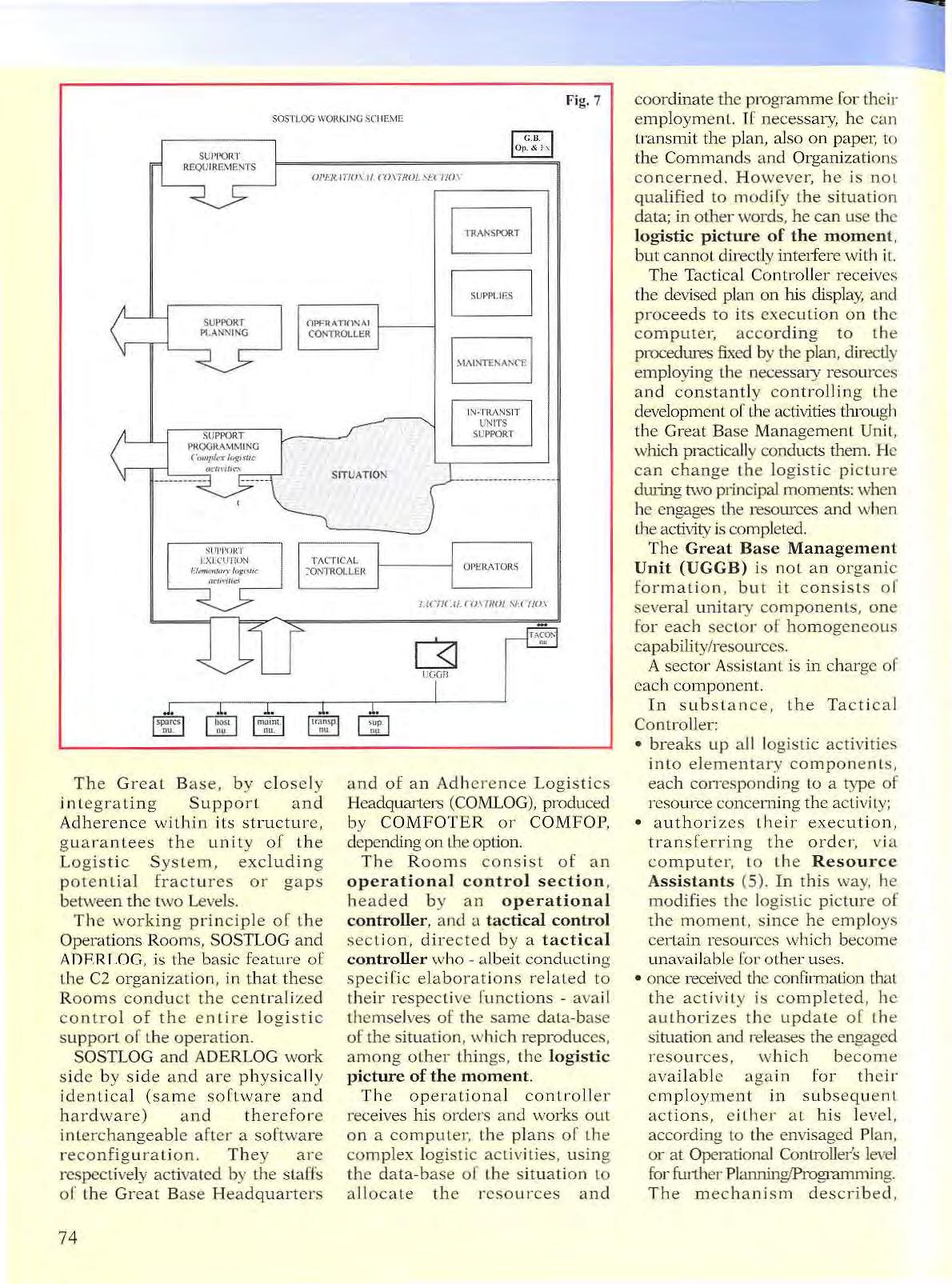
A sector Ass is ta nt is in charge of each component.
In substan ce, the Tacti ca l Controller:
• breaks up all logistic activi ties into elementary components, each correspond ing to a type of resource concenung the activity;
• aut h orize s th e ir executi on, transferri ng t he order, v i a co mputer, to th e Resourc e Assista nt s (5) In th is way, he modifies the lo gist ic p icture of the mom en t , since he employs certain resources which bec ome unavailable Cor other uses.
• once received the confirmalion rhat the activit y is co mpleted , he authorize s t he upda t e of the situati on and re leases the engaged res ources, w hich b ecome available aga in for th e ir emp l oyment in subsequ e nt actions, e ith e r at his l evel, accor di ng to the e n visaged Pl an, or at Operational Controllds level fo r fwther P lanninWJ>rogrammin g. T he mechanism des cribed,
7 SOSTLOG 11'0Rt-.ING S('IIEME Ol'i':/1. 11/0 \' r/. f'0\ 7RO! -'Hl/01 liGGfl 8J J. l. 1. 1.
Fig.
74
app lied both w ithi n the Great Base an d in the Th ea tre, guarantees the following main adva n tages:
• immediate ver i fi cation .o( the feas ibility of a logistic activi ty, be it schedul e d or une xp ec te d;
• timely and justified di spatch of requests o r interventi o n an d imme diat e alloca tion of the necessary resources, betwee n the Suppo rt and Adherence Le ve ls , a nd within th e Adheren ce Level. Act ually, a direct i ntera ctio n in rea l time is ass u red betwee n Supp mt and Ad herence.
• optimization of the employment of the available reso urces;
• uninterrupt e d upda te an d con trol of the logisti c situation;
• direct and constant coordina tio n of the elementary compone nts w ithin an activ ity, and of the ac tivit i es vvithin a comp lex activ ity.
• in case of unforeseen events, immedia te feed backs Lo the Tact ical Contro ller, for a co rrective ac ti o n on th e ac tivity undet- way, o r t o t he Operatio n a l Cont roller, fot· the mo dification of the plans;
• s implification and standardi za tion (also in informat ics) of the log is tic procedw-es, hi gh flexibili ty of the syste m, both in the planning and in the condu ct phases.
• s imp licit y of ex ec ution of the s ingle componen ts of even very co mp lex activ iti es b y th ose in charge of the resources .
F i g 8 show s t he sequ ence of th e main ph ases of the lo g is tic process in outside - the-border operations.
At this point, it is possib l e to better specify h ow the di scont inuity betwee n Sup port. and Adhe re nce was eliminated. The entire logis tic autono m y of the opera ti on is co ntrolled by Adherence (of t h e inTheat re Com mander), alth o u g h it is mainly stationed on the nationa l terr it ory (6). With the preventive transfer of th e logisti c fl y-wheel of supp ort to Adherence, the fly-wheel is move d forward, ve ry close to t h e
forces, even if, physically, it is still on th e national t e rri to ry (in the Great Base). Th e times need ed t o brin g to leve.l the territ or i a l o rganizatio ns can be as long as we wa nt , because they cease to affect th e Adhere nce's Au tonomy - which is co nstantly r es tored within the G r ea L Base - but affec t the autonomy of Su pport, respons ib le for t he levell ing wit hin t h e Great Base. The suppon a utonom y will h ave l.o be appropr iately adju s te d to th e said Lim es.
The FOPs Ad h e re nce Logi stics avails itself of an Operat ions R oom ( ADER LOG-F) se t u p in field she lters , an d practi ca lly guarante es t h e sa me fun ct i ons p erfo rm e d b y ADE RLOG Grea t B ase , with which it operates in close integ ration Th rough
ADERLOG-F, which in o perat ions takes on the role o f «master», t h e in-Th eat re Comm an der contro ls th e wh o le Lo gisti c S y stem in support to his fo rc es .
ADERLOG-F's Logistic Instrument, the rea l Adhe r en ce Logist ics, c onsists of intervention mod ul es ca pabl e of st and ard p erformances ( d eg ree of intervention ), j oi ned accord i ng to th e ir logistic activity (for examp l e , s everal maintenan ce stand ar d-modul es ma ke up a mainte nance unit ).
When employed, these mod ul es are associ aLed in mono - or pluriactivity com plexes, qua ntita tive ly and qualitat ively adjusted to the spec ifi c requi reme nts, and ca rry out standardized activities according to a pre-esLablished p rogram me, und er
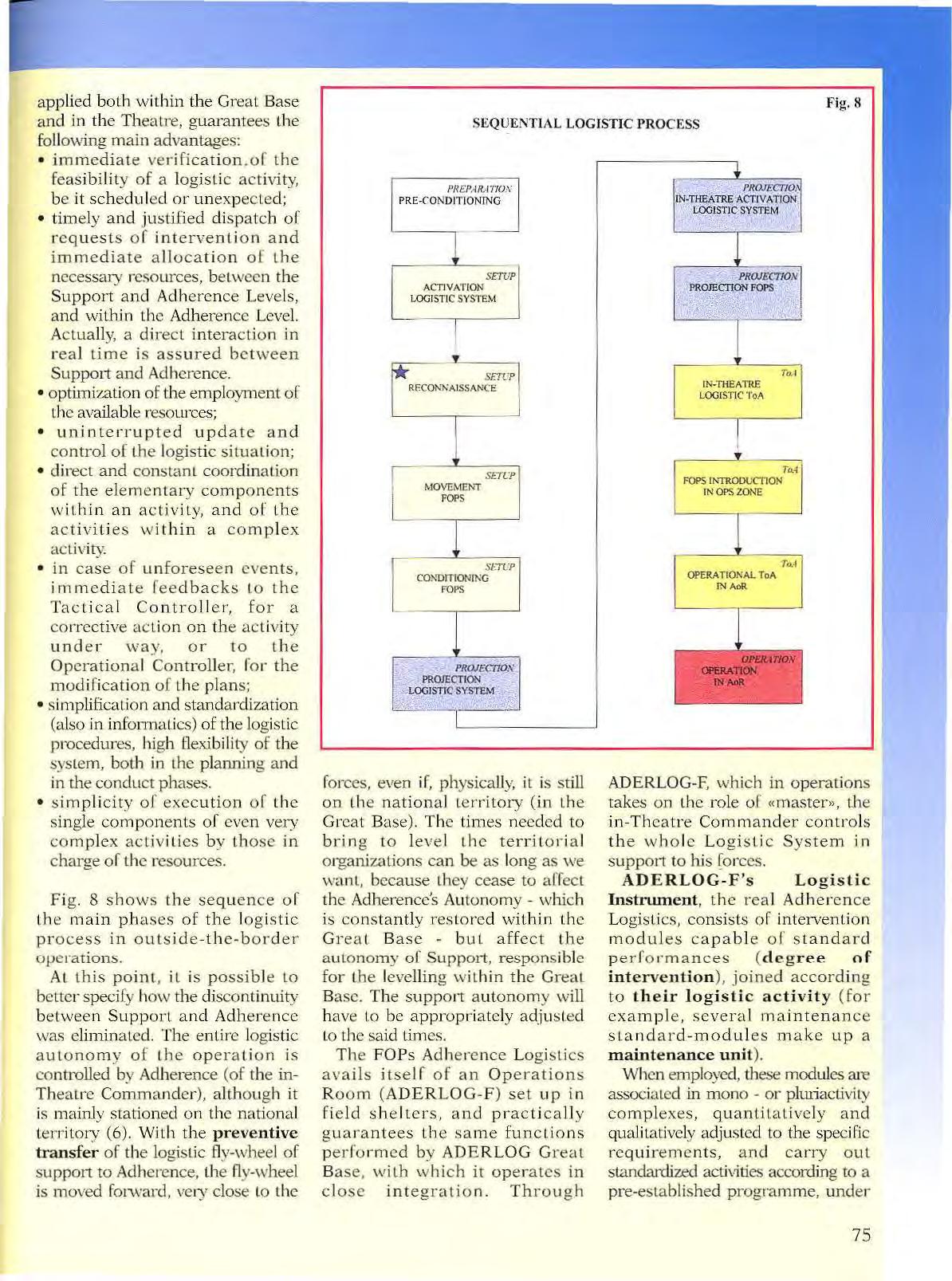
SEQUE NTIAL LOGISTIC PROCESS PR EI'AJIATIO!V PRE-CONOITIONJNG SETUP ACT IVATION LOGISTI C SYSTE M SETUP I RECONJ\'AISSANCE 1 "--r--- J r-- SETCP I MOVEMEI'IT L FOPS CO!\'DITIO.\JING FOPS [ SJ:.TU'
Pl/OJf.'Cf/0, IN-THEATRE ACTIVATJ.ON U=!GISTI C SYSTEM IN·nlEATRI'. LOGIST IC TO!\ ToA FOPS li'<'TRODL(TION INOPS ZONE OPERATIONAL ToA IN AoR ToA
75
the guidan ce of ADERLOG-F's tactical controll er:
The operational users, i. e the tmits employable for adherence support, are Regim e n ts or compara ble w1its (7) mono-o r m u ltibran c h , in the lactical confi guration on the field fo r a specific operation.
Fig. 9 s h ows th e worki ng schem e in t h e Area of Res po nsibi lity.
LO GISTI C ACTIVITIES' PROGRAMMING (8)
If the logistic fl yvvheel (ca p abilities a nd resources ) is well d es igned, w ithin a certa in per io d o f time (autonom y) it will be «consumed )) by t he operational u sers, which in th is way meet t he ir needs in ord er to maintain their operativeness for th at gi ven period.
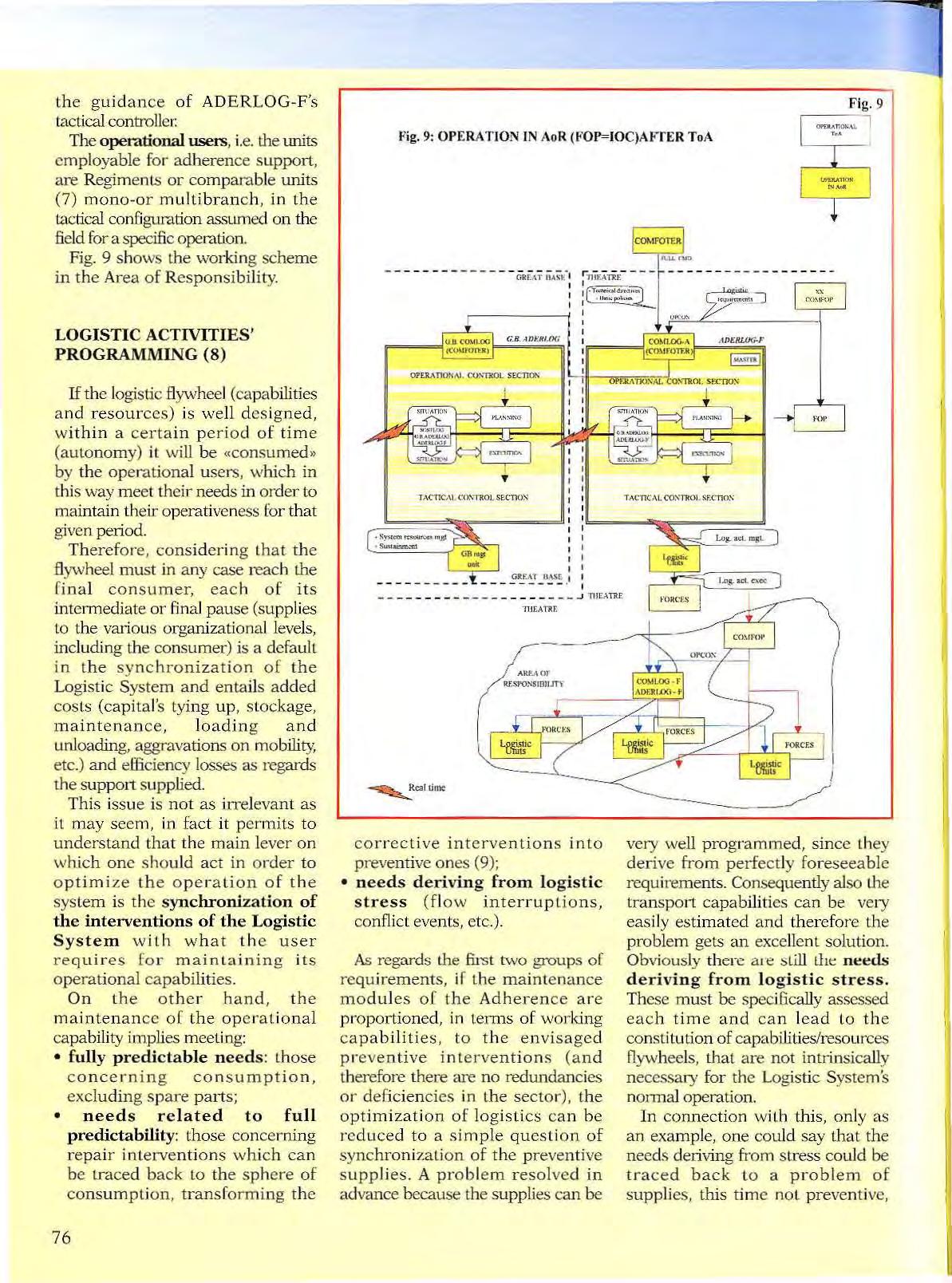
Therefore, co n s ider i ng that th e flywheel m ust i n any case reac h the fina l c onsumer, e a c h o f its intermedia te or fina l pause (s upplies to the various organizati o na l levels, in cluding th e co ns um er) is a d efaul t in t he synchroni z ation of t he Logisti c System a nd entails a dded cos ts (capi ta l's tying up , s tockage, maintenan ce, loadin g and u nloading, aggravations o n mo bility, etc ) and efficiency losses as regards the suppo rt s up plied.
This issu e is not as in·el eva nt as it may seem , in fact it p e rmits to u nderstand tha t the main leve r on which o n e sho ul d a ct in order to opt i mize the ope r ation o f t h e sys lem is t h e synchronization of the interventions of the Logistic Syst em wi t h what th e user req uir es for m aint a i ning it s operati onal capabilities.
On t he ot her hand , the maintenan ce of the op e r a t ional capability impli es meeting:
• fully predictable n eeds : those co nc e r ning c o nsumptio n , excludin g spare parts;
• needs re lated to full predictability: those conce rning repai r i nt erve ntion s whi c h can be traced back to the sphere of co nsum ption, t rans forming t h e
cor r e ctive interven t i o n s in t o preven ti ve o n es (9); • nee d s d eriving from l ogistic stres s ( fl ow interruptio ns, conflic t events, etc.).
As regards the firs t t\vo groups of requirem en t s, i f the m a in t e nan ce mo dul e s o f the Adhe rence a r e pro portion ed, in t.erms of w orking cap abilities , to the env isaged p r even t i ve interve ntion s (an d th erefore t here are no redundancies or defi ciencies in the secto r), t he opt imizat io n of logistics ca n be r ed uced to a s imple que s ti on of sync hroni zation o f the p reven t ive supp li es . A prob lem r esolved in advance b ecause the supplies can be
very well pro g ramme d , since t h ey derive from perfectly fo r eseeable requ irements. Consequen tly also the transpo rt capabilit ies can b e very easil y esti mat ed and therefore the proble m ge ts an excellent solution. Obviously th e r e are still the deriving from logistic s tress. T hese m ust be spec ifi.cally as sessed e a c h time and ca n lead to t h e const il1.1tion of capa bilities/resou rces flywhee ls, tha t are not in trinsically necessary fo r the Logistic System's normal operation.
In connection with this, onl y as an exa mple, one co uld say tha t the nee d s d etiving from stress coul d be traced bac k to a p r oblem of s u pp l ies, this time no t p r eve n t ive,
76
- - - - - - - G'RL,T I I I G B .A IJio:.HI ()(; OPERATIONAI COSIROI SECTION time
Fig. 9: OPERATION I N AoR (FOP=IO C)AI'TE R ToA
but urge n t.
R econsid ering the struc tu re of the Logis t ic S ys tem a-nd in t h e quite acce p ta ble assumption th at the Transit Area does no t constitu te a stress sou rce (1 0), there would b e no adv a n tag e in plac ing th e menti on ed Qywhee l at th e entrance poin ts (in the Theatre) ins tead o f the ex i ts ( i. e . i n th e Great Base) .
Pu s hi ng the fl ywh ee l a hea d toward s the 7 on e. of Operat i o n swith the relevant consequences - on the o n e s ide it w ould reduce th e stress ri s ks but only in rela t ion to the Lim e a utonomy tha t th e flywh ee l ca n grant t o the FO P, while on th e other, they would rise considerably, in relation to with th e in c r eased v ulne r ability o f t h e resources.
I n a n y case, if the «s ta ti c» aut o n omy p r e- p osi Uo n e d in th e Ope rat ions Zo n e wore out and th e stress p ersisted the prob lem would rise a gain
What we mean is not only t h at the r a pid delivery of urg e nt suppli es fro m the Great Ba se allo ws t o co n fe r a lesser stress- risk auton omy to th e Adhere nc e, but, above all , that the real solutio n of th e p ro bl em c an be precisel y in th e Logis t ic S ys tem 's abili ty t o ensu re a pr o mpt delivery o f suppli es .
Of course the appropriat e solution fo r the logistic risk must be studied each lime according to the circumstances and the foreseea bl e confu cts, keeping in mind also th e n um ero u s o p po rtuni t ies t hat are offerred i n t h is reg ard b y t he po ss i bi li ty of m u ltinati ona l coop eration and employment o f local resources
With a vi e w to th e abov e con sid era tions, t he analyUca l develop me nt of t h e Logisti c Activities Programming (whi c h boil s d ow n in substanc e t o program ming m a inte n an ce and trans p ort) can b e defi n ed b y t h e followi n g ste ps :
• a ssess t he distribution of breakd own prob a b ili ties for eac h typ e o[ ve hicle or system (on e
ca n o btain the average val u es of inc id e n c e and the ma r g in s o f va riability);
• d efine the degree o f int erve ntion (o r the Adherence Lo gis ti cs : on t h e basis of the times of exec ution a nd the concrete possibil i ti es o f a dapting the equipment fo r field e mployment;
• evalu a te the capabilities necessary fo r p r eventive interven tions: one can derive the n umber and typ e o f t h e standard mai nt e n a n ce modules that should be employed (instrument), th e need s rega rding the remov a l of uns er vi cea ble ve hicles to the Gr ea t Base (transpor t ) and, if th e tac tical r e quirements d e m a n d i t , a seg me nt of flywheel vehicles for each line of materi a ls;
• de f ine t he p r o gramme of t h e maintenance ac ti vities: this is th e fi rst re sult of th e d eve l opmen t, a nd permits to assess the transport req u irem e nt s for deliveting spare parts ;
• es timate the global requ irem ents co ncerning supplies: i t p er mits to de fin e, considering the results of the preceding steps:
•• t he Adher e n ce logistic i n str umen t = m a i n t enance modules + trans p or t mo dul es;
•• Programmn i n g of the liansport Activities = s upplies + s pare parts + removals
THE SPECIALIZATION OF THE LOGISTIC ORGANIZATIONS
F ro m the ou t li ne d reference l ogistic concept t he foregro und ro le played by the Specialization of the Logistic Organs sta nd s out, both from the organizatio na l point of view a n d f r om th at o f t he p er formance requi re d of the Logistic System.
T h e s pecializatio n of the Logis ti c O rg a ns re p rese n ts, at the same t i me, a n a ss ump ti o n and a n objec t iv e of th e co n cep t. T he com pl e xity of t h e s u p port org anization and th e costs o f its
deplo y m e nt require i n f act a mar ked profess ionalism o f the men and uni ts destine d to op erate in the logistic sector a t all leve l s. Nevertheless o n e s hould envisage to graft on the t eclmical knowledge of the spec iali zed o rgans constant and health y co nt r ibution of conc ret e experiences c oming fro m operational activities.
To go in to d eta il, th e requiremen t o f sp ecializa ti on in logistics, whi ch r e f l e ct s many of t h e concre te aspe cts con n ecte d with the applicatio n of the learning c riteri on, ou g ht to be pursued, especially in the Exe cutive Or gans.
Th e standard modules are formed by p em1an ent teams, whose capabilities of i ntervention are buil t and im p r oved thro u g h a s p ecific fo rma tive course for each m ember; individu al and team trai ning carried ou t al so in ter ms o f tea m competit ion ; em plo y ment of sta nd ardi ze d p r oced ures of intervention (including th e layout of the equipmen t ), improved, first of all, by relying on th e contribution (to be encou raged) of the operators; exper i en ce of i n t erve ntion in o p er ati o n s; drawi n g up o f postactivity repo r ts and organiza tion of seminars; constant te c h nic al updating.
The units s p ecialized acco rdi ng to their activit y a r c const itute d, organizationally (11) and fo r employm e nt ( s ubdivisio n in operations) by se ve r a l standard modules
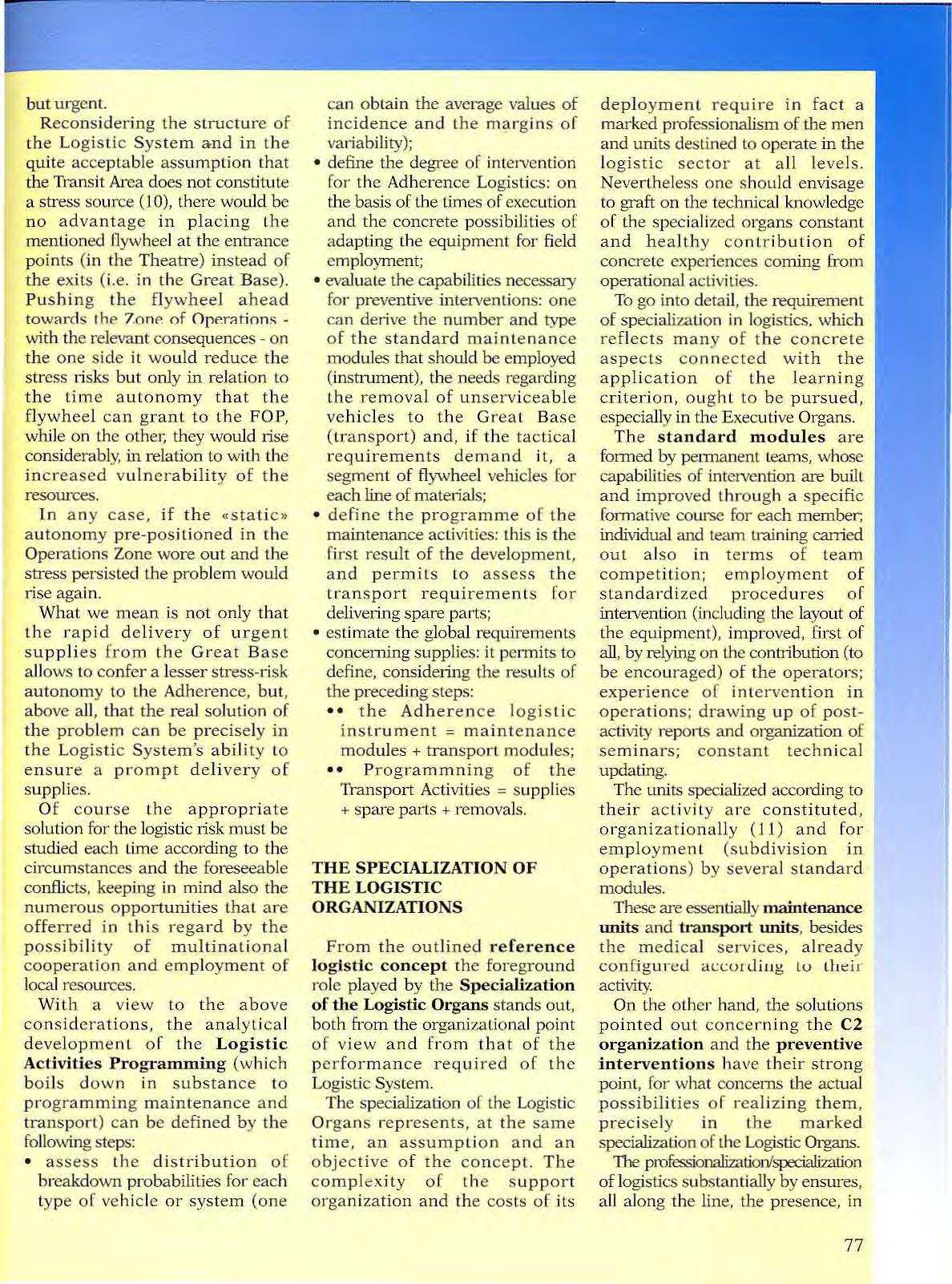
These are essentially maintenance units an d t ranspo rt units , besides t h e m edica l services, alre ad y con f igur e <.l au.:on.l iu g to the ir activity.
On the othe r h and , the solutions pointed out co n ce rning the C2 organization and the preventive interventions h a ve their strong point, fo r w ha t concerns the actual possib i li ties of rea lizing them , pre ci sely i n the m a rke d s pecializa tion of the Logistic Organs.
The pmfessionalizationlspecia.lization oflogis ti cs s u bstan tially by ensures, all along the li ne, the presence, in
77
the organization of t h e u n its, of pe rson n e l of t h e Technical and Logistic Corps, a lso w i th the purpose of g r anting an adequate suppor t to the Commanders by relieving them from the technical, administrative and bookkeeping activities related to the management.
Tn short, specialization is one of the most powerfu I levers for incr easi n g the efficiency of the Logistic Systems, because it directly emphasizes t he technica l and f u nctional performance of the organizational 'U1d in the meantime, in d irec tl y, c uts its cos ts. Moreover, it helps, on the plane of the Command action at all levels, to give the Commanders the technical-admini strative s upport necessary for them to co nce ntrate attention and capabiliti es o n the performance of their in stitutional operational tasks.
MULTINATIONAL LOGISTIC INTEGRATION
Prospecti vely, a remarkab le potentiality of the logistic concept worked out is that of plac in g the Servic e in a posit ion to take on among th e o th er nations that parti cipa t e in a multinational operation, th e ro le o f Lead Nation in the conduct of the logistic support activities. This promising devel op ment trend is suggested by the total consistency o f t hi s concep t \Vith NATO 's logistic doctrine, by the envisaged location of the Great Base and by th e co n crete possib il i ties offered, a l so in a multi n at ional contex1 , by t he specific management standards (of logistic capabilities and resources) designed within the framework of the command and contro l organi/.ation.

Tf the verificat ions in this regard, that are now be ing made, were to confirm such poss ib ili ty, the MultinatiOiu:tl Logistics Management Command could by itself constitute a complete capability package of the Service of its own particular value not only from th e techni cal-mili tary angle.
CONCLUSIONS
We have mentioned that the R efere nce Logistic Concept is not the arrival, but rather t he starting poin t. Th erefore, in concl u ding, it would be contradict ory to sum up its characteristics which, b esides , are in a co n tin uo u s and progressive phase of development.
I t is th e case , instead, to out li ne some o f the trends and possible effects of th e concept on th e other co mponents o f the L og i st i c Organization , abou t which noth ing or very littl e was writt e n in this article.
It is cleac first of a ll - and a lot has already been done in thi s regard - that the support on the national territory is ensured by a l im ited number of l ogistic formations o f the Suppor t Level, assembled in multifunctional bod ies a nd b y specia lized, areal centres in tegrate d th r ough a wholly computerized Comman d and Contro l syst em.
. As rega r ds the l ogistic ca pabilities to be conferred to the Ope ratio nal Forces, there would remain the resources ty p ical of today's Regim ent, albeit substantially reorgan ized, vvhile significant changes could occur at the higher levels. The B1igad e wou Id lose the executive logistic organs currently at its disposal (lo gis ti c baualion and m edical unit) which would be concen t rated, a ft er reorganization in a specialistic sen se (maintenance b attalions, transport batta lions, etc .) , at In termediate Operational Command level.
The outline of t h e future operational logistics, which here deserves a specific, i f summary, mention, w i ll p resumably reflect the featu r es of n on-linear operations a nd will b e marked by very high fle xib ili ty and dyna m ism.
I ts most qualif)illg points could be:
• transparence and visibility of the available l ogistic resources and capabilities , as well as of those needed from th e ga rri so n
to the areas of e n gagement, prerequisites for a maximum efficiency o f s uppo rt;
• supe1i01i ty of the tactical mobility over the lo gist ic mobility, and therefore the necessity to free the ac ti on of the forces from th e burden and friction deliving from dragging along their ovvn supports.
• dynam ic planni n g of meetin g
78
points for the fo rces and their respective supports i n «re conditionin g i s land s», variab le and flexibl e according t o the s i tua tion in progre ss, where one can carry o ut , with field equ ip ment, th e activiti es o f suppl y ing, repl ace m ent of unservi ceable materials, force reco nfi gur·ation , etc.;
• real-lime, dose-n etwork centralized control of th e «islands» t hat contain t he supplies and o f the forces where th e requirements c:u·e l o cated , both in continuous m oveme nt and rec ip rocally and constantly transparent, in order to be a b le t o programme «011 the way» the location of th e «meeting point » and the act i vit i es t hat
s hould b e carri ed out in it, auto matically and efficienlly, wh en the m eeting takes place. To prevent th is meeting to b ecome a case of vulnerability, it wi ll hav e to b e necessarily «quick and sec ret ».
NOTES
(l) Likewise, I or 2 operat io ns can be co nducted simultaneous ly.
(2) Tf the Grea t Base cat1JlOt include all Exit Points (poJts , airpoJts, mihvay stations), these installati ons m ust be availa ble in its i mme diate vic inity
(3) Obvious ly, the contro l s upplie s and stocks must be condu cte d i n deta il , considering not only their q u antity, but a lso the typ es o f matetial.
(4) See note 3
(5) Eac h assistant recei ves bot h the detailed executive order relevant to the cleme n tary -component/reso u rce und er hi s res p onsib ility, and th e ge n eral pi ctw·e of the activity to which i t bel ongs .
(6) This pennits a remarkable reduction of the burd e n of in-Th eat re sup port, w ith no exc essive psych ological repercussions on COMFOP's sense of responsibili ty.
(7) From the poi nt of view of Adherence Logisti c, a Co mmand Post of Brigad e/Division/Corps level is to b e considered «R eg iment equ ivale nt »

(8) In the planning context, the critetia of Aexibili ty, sc ale and lea rning- p ointe d out at th e beginning - find a part icular applica tion.
(9) For instance, by programming t h e replacement of a part ah ead of the av('rage breaki ng time , envisage d o n th e basis of th e data issu ed by the constructor or dra\.vll fro m opera tional expelie nce.
(10) Otherwise it would be a ppropli ate lo includ e th e Trans i t Area in the Op er ations Zon e.
( J I) When stationed at a garrison o n the national terri tory, the specia li zed units a re estab lis h ed as battalions, therefore they have a ba ttali o n-level st ructure organizalion of their own.
0
1'Lt Colonel, S ection Chief; Plans Office, Army General Staff
79
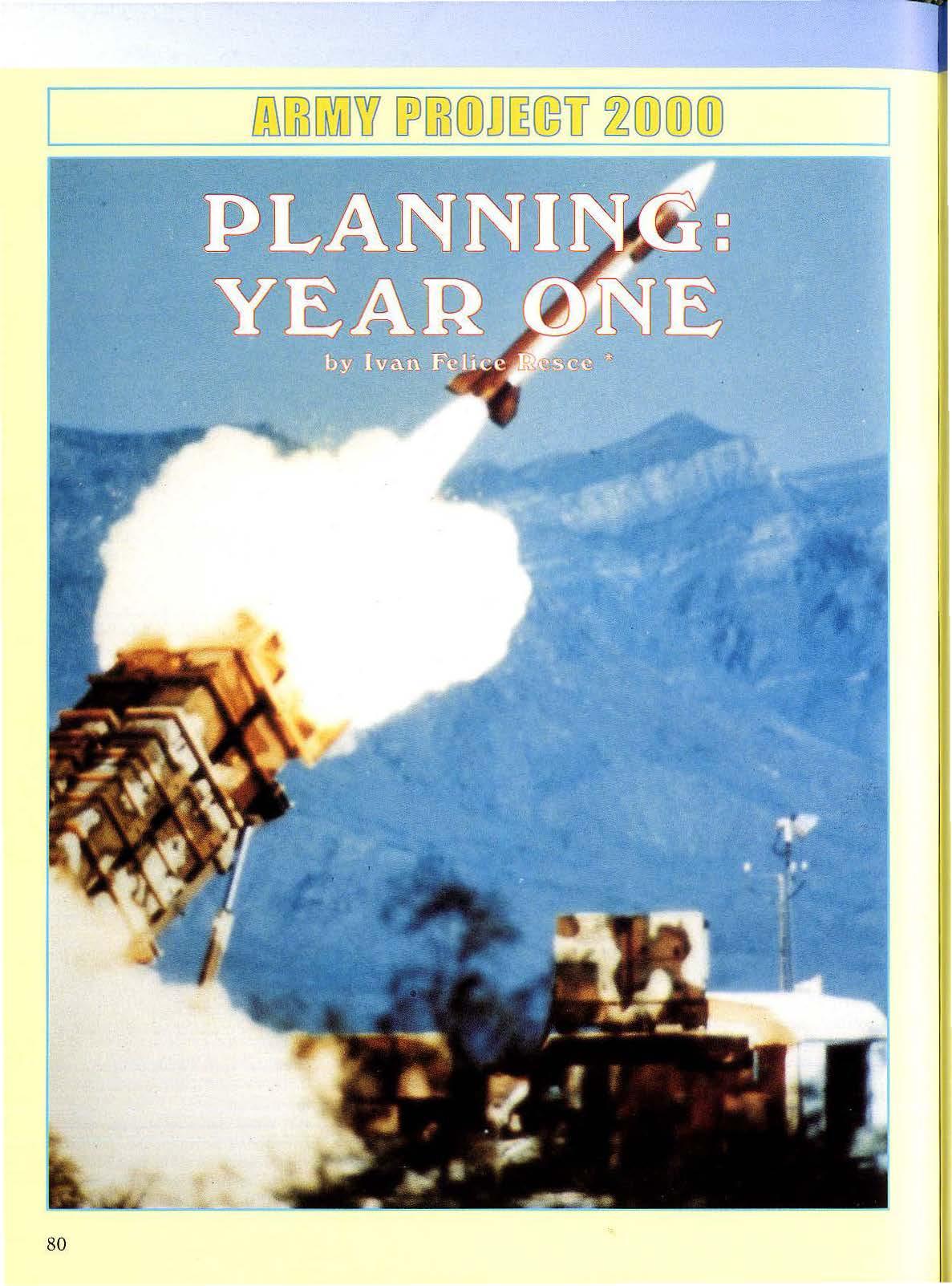
80
BACKGROUND
The articles of the series «Army Project 2000», intended to provide a panoramic view both of the structures planned for the land military instrument and of its main functional components.
In particular, they presented a dynamic model of Army , which has to be adapted, perfected and brought up to-date according to the changes in the following basic parameters: scenarios, resources, technology. The planning cycle (Fig.l), formally started in the spring of 1997, is the instrument to adapt the model. Yet, though the model is dynamic, the objectives to pursue are clearly defined. The first objective is general and aims at transforming the Army from a mere defensive instrumentcreated to guarantee a credible deterrent in the Alliance contextinto a dynamic system able to carry out the most diversified and complex missions of the modern scenar ios Since the world has ceased to be divided into two opposite blocks, the system of international relations has assigned to the Armed Forces in general, and to the Anny in the role of active protagonist, for the direct support of the national and international security policy and for the preventive and remote control of the conflicts.

In this context, the range of the force employment options is very varied. The operational scenarios are characterized by an increasing complexity.
Moreover, the thea tre of operations has been almost completely projected outside the national territory. Finally, the employment contexts are becoming more and more joint and multinational and not only limited to the framework of the Alliance.
The modem Army therefore, has to cope daily with new operational realities and il1creasing multinational contexts. It must therefore become a qualified and reliable partner; whose
operational capabilities are fully integrated in its components; the Army must also guarantee the capability of a flexible integration of its components into task forces, usually joint and combined. From the general objective the specific one originates, which refers to its operational component, i.e. the organization of the forces by «capability packages».
THE CAPABILITY PACKAGES
T he «Capability Packages» are born with the intent of giving new shape to the Army, on the basis of the emerging operational necessities. It is essentially a new system of force planning, marking the passage from a structure based on the threatt to a new one, founded on the capabilities. In the past, the force plruming was aimed at maintaining the instrument coherent and effective vis-a-vis a specific and operational contingency. With the introduction of the Packages, the force planning aims now at building, into a predetemlined framework of available resources, a flexible and versatile complex of capabilities, suitable for supporting various security needs, both of the Nation and of the international community.
The Packages are founded upon two fundamental principles: the first one is economy in terms of tactics, finance and organization of the formations; the second is the organization of the structure by modules, which is an essential condition for economy.
ln particular, the Project also aims at the synergy of all the available resources towards the objectives correspondi11g to specific concrete capabilities (the partial objectives), which are coherent and integrable with each other. In this way, in short-, middle-and longterm horizons, the overall plan of the Army is carried out. This plan vvill be accomplished Qrogress ively ru1d the single partial systems, once completed, will be operatively employable in every development stage of the program.
The «Capability Packages» are essentially the that the Am1y is determined to achieve, in connection with the great missions that it is institutionally called to accomplish. The «Capability Package for Projection» includes the forces destined to accomplish the tasks of dynamic secwity beyond the borders, i11 the framework of peace sup.Port and crisis managem en t operations.
PLANNING ON HY POTHES ES OF INTERVE NTION keepin g of the Ope rational capabiliti es CONTINGENC Y PLAN NING Express ion a nd util iz a t ion of operat iona l c apab ilities 81
The «Capabi lit y P ac k age for Reaction» is formed, in acco rd ance with the e n gagemen ts undertaken by Italy in the context interallied, by t h e u ni ts appointed to assure the deten-ence, according to the new NATO str-ategy, based both on the presence of differentiated levels of operational capabili ty, acco rding to the func tion to be accom plished (Reaction Forces, Ma in De fence Forces, Reinfo rcements) and on t he capability of imm e diate counterconcent.ra tion of the forces with the hi g h est ope r a tional readiness (Reaction
Forces)
The simil a rit y of tasks and structures, and especially the need f or the most dr astic economy in every field , m ake the two packages to part iall y overlap (some un its belong to both). They w ill b ecome comp l etely overlapped in the future, when, hopefu ll y, th ere will be a greater number of volun t eers
The t hird Package concerns the « Capab ili ties for Control of the N ational Territory». Tl includes the units (completel y manned b y draftecs) and t he resou rces destined to the sur veillance of borders, coasts and air space, to the inte 1-vention in case of calamities, to the support of Police Forces and Inst itutio n s , as
well as to the preparation of the capabilities for employment.
The last group of capabilities, the «Defence P ackage» includes the command and control st ru ctu r es and the l ogistic a n d tactical supports w hi ch are indispensable to connec t and to employ, in unitary way, the \.vhol c la n d instm ment in case of a l arge scale conflict; such h ,ypothesis, though no t very probab l e at present, cannot be definitively mled out.
To define the Packages from the point of vievv of their quality, it h as be e n nec ess ary to divid e the o pera tions included in the variou s imaginable scenarios i nto their p rimary activities. In this way, it has been possibl e to defin e t he «O pe rational functions », whose basic categories ar e : «combat>>; «com b at s up port»; «intellige n ce»; «combat service support».
T he command and control fu n ctio n i s a connective web for all the others and cou l d be defined as a «Superfuncti on». It represents the intelligence, that is to say, t he in tegrat e d w h o l e o f knowledge and rational creativity of the Army system.
From the point of vi e w of quantity, eve1y functional capability
compo nen t has been s u bdivided i n to modules, that is to units organized b y standard rul es
Specific operational capability sets can be obtained th ro ugh the aggregation of t h e func tions by modules; s u ch aggregation must be done in accordance \Vith appropriate comb in ations suggested by t h e various employme nt op t io ns , prep lanned or contingent.
Each module con·esponds to predeterm in ed elementary operational capabilities and is accompanied by its employment instn1ctions, i .e. the s ta nd ard planning. As in the wellknown chi ldren 's games, where a grea t n umber of compl ex con s tructions can be obtained o:orn a set of ve ry el ementary standard pieces, in the same through an approp riate com b inati on of the various e l emen ta ry operational modules, i t is poss i ble to attain, automatica lly a nd e ffici ently, the task- f orce most s ui t ab le for the specific missions assigned.
T his system, wh ich requires a remarkabl e reorganization effort, gives t h e Army high flexi b ility and versaliJity, and contributes to define the integrabilit y of th e land instrument, in accordance with the guidelines formerly fixed.
l n th e context o f the capability packages, the most immediate and qualifying objective is to prepare, in the medium tem1 , a set of forces at leas t at division level, especially in view of the new definitive impulse of t he European Union in the field o f sec urity: at least one Italian Divisio n for Europe!

THE OPERATIONAL MODULES
Th e definiti on of the capability packages and of t h eir functional components h as led, as we said, to t h e specificatio n of a dynamic mode l of the militar y instrument. The su bsequent planning step is the r e-shap ing of the operational modules of the different functional compo n en t s (manoeuvre forces, co mbat s upport, logistic support
82
Headquarters and Logistic Support Company
of the infrastructure and related services, thus disengaging the Commander o f the projected forces from the garrison responsibilities.
THE RECONNAISSANCE UNITS
Also for the reconnaissance units the reshaping process o f the operational modules, started from the ana.lysis o.f the scenarios (peace support operation and highintensity operational engagements) and from the relevant main functions:
• reconnaissance , in its most important forms (by stealth and by force);
• control of routes and/or wide areas;
etc.), on the basis of two essential ctiteria: the internal integration and the integrability into the sets of forces structured for the employment.
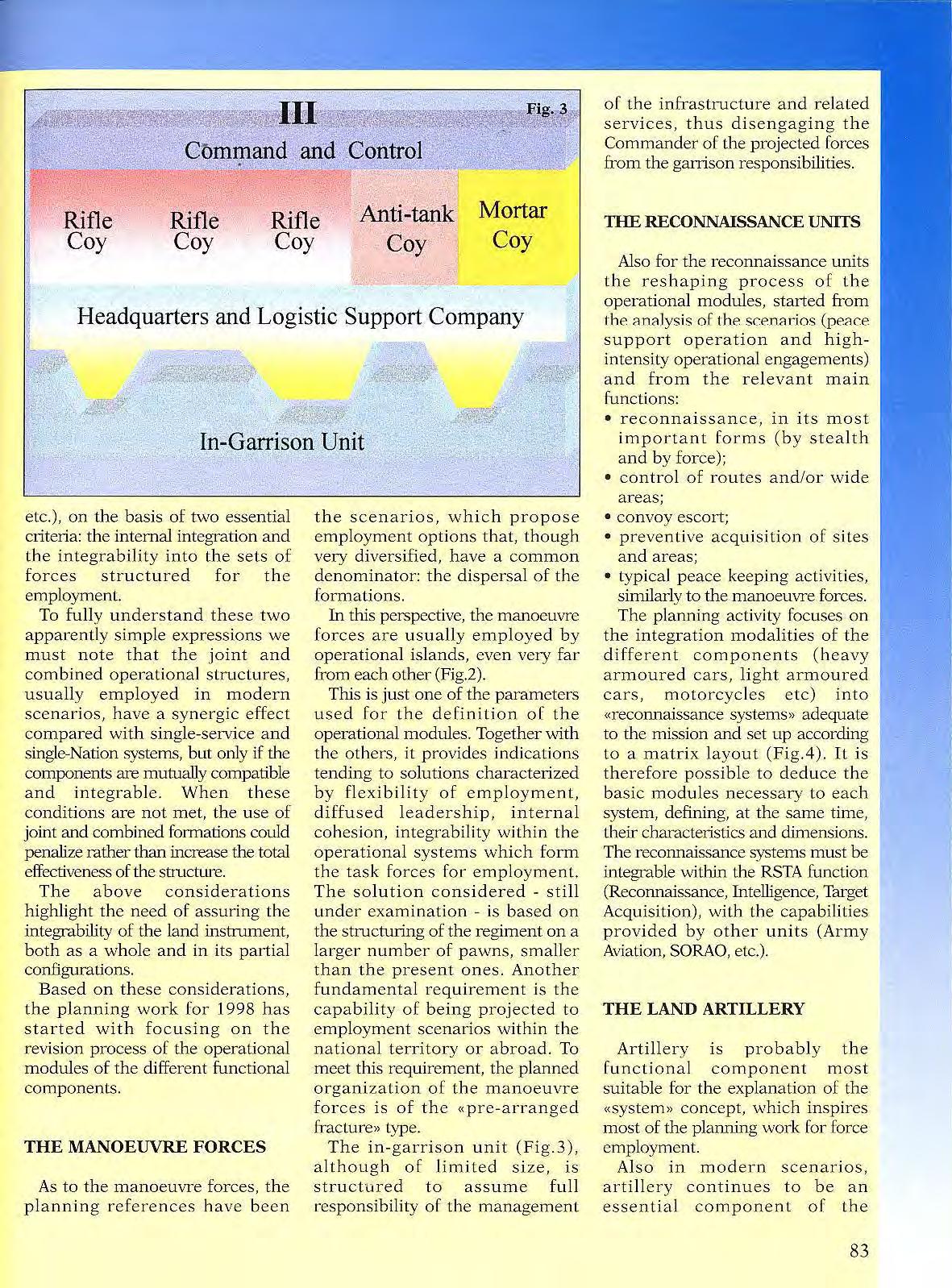
To fully understand these two apparently simple expressions we must note that the joint and combined operational structures, usually employed in modern scenarios, have a synergic effect compared with single-service and single-Nation systems, but only if the components are mutually compatible and integrable. When these conditions are not met, the use of joint and combined formations could penalize rather than increase the total effectiveness of the structure.
The above considerations highlight the need of assuring the integrability of the land instrument, both as a whole and in its partial configurations.
Based on these considerations, the planning work for 1998 has started with focusing on the revision process of the operational modules of the different functional components.
THE MANOEUVRE FORCES
As to the manoeuvre forces, the planning references have been
the scenarios, which propose employment options that, though very diversified, have a common denominator: the dispersal of the formations.
In this perspective, the manoeuvre forces are usually employed by operational islands, even vety far from each other (Fig.2).
This is just one of the parameters used for the definition of the operational modules. Together \Vith the others, it provides indications tending to solutions characterized by flexibility of employment, diffused leadership, internal cohesion, integrability within the operational systems which form the task forces for employment. The solution considered - still under examination - is based on the structuring of the regiment on a larger number of pawns, smaller than the present ones. Another fundamental requirement is the capability o f being projected to employment scenarios within the national territory or abroad. To meet this requirement, the planned organization o f the manoeuvre forces is of the «pre-arranged fTactur.e» t}1Je.
The in-garrison unit (Fig.3) , although of limited size, is structured to assume full responsibility of the management
• convoy escort;
• preventive acquisition of sites and areas;
• typical peace keeping activities, similarly to the manoeuvre forces. The planning activity focuses on the integration modalities of the different components (hea vy armoured cars, light armoured cars, motorcycles etc) into «recmmaissance systems» adequate to the mission and set up according to a matrix layout (Fig.4). It is therefore possible to deduce the basic modules necessary to each system, defining, at the same time, their characte1istics and dimensions. The recmmaissance systems must be integrable within the RSTA ft.mction (Reconnaissance, Intelligence, Target Acquisition), vvith the capabilities provided by other units (Army Aviation, SORAO, etc.).
THE LAND ARTILLERY
Artillery is probably the functional component most suitable for the explanation of the «system» concept, which inspires most of the plmm.ing work for force employment.
Also in modern scenarios, artillery continues to be an essential component of the
Rifle Coy Rifle Coy Rifle Coy Anti-tank Coy Mortar Coy
83
«manoeuvre». If this statement appears to be evident as regards high-intensity operations, it could cause some perplexities when related to PSOs. Nevertheless, if one considers the requirements necessary to succeed in the specific kind of operations (agreement of the parties, impartiality and credibility of the intervention force), the role of artillery comes out fully, even in terms of simple deterrent presence.
In any cac;e, the employment of the modem artillery is characterized by:
• timeliness, since the dynamism of the action makes tardy interventions absolutely useless;
• accuracy, in order to hit the selected targets, save anununition, pursue the safety of the formations (fire and disappear) and, finally, to avoid collateral effects, particularly unacceptable in PSOs;
• fire effectiveness, to achieve the effects expected in relation to the kind of target.
To meet all these fundamental requirements at the same time, it is necessary to structure the artillery as a system (Fig.S). Such system should assure the exact identification of the targets; the immediate and secw·e transmission
of the request of intervention; the activation in real time of the command and control chain; the timely, careful and effective distribution of fire. The search for the most efficient organization for the artillery system is the main objective of tl1e cmrent studies.
THE ENGINEER CORPS
As to the Engineer Corps, a different methodology of approach has been followed. It is not easy to apply the concept of «system» to an element which includes a wide range of tasks and, consequently, a range of specialistic units just as wide. The basic principles have therefore been the organizational flexibility for employment (stmctme by modules) and high specialization (or plurispecialization) of the capabilities. The synthesis of these two principles present two main aspects:
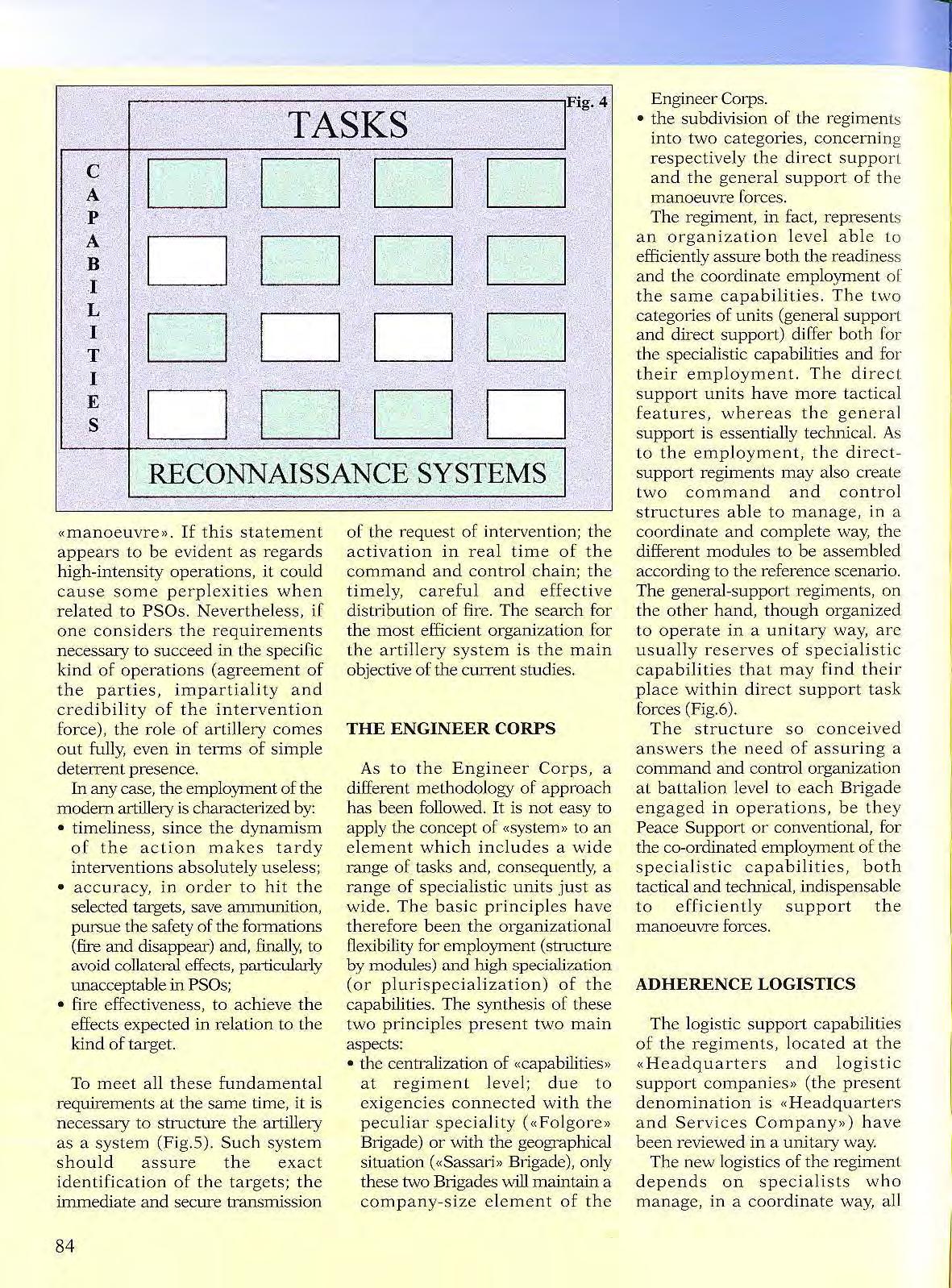
• the centralization of «Capabilities» at regiment level; due to exigencies connected with the peculiar speciality («Folgore» Brigade) or -vvith the geographical situation («Sassari» Brigade), only these two Brigades v.·ill maintain a company-size element of the
Engineer Corps.
• the subdivision of the regiments into two categories, concerning respectively the direct suppor t and the general support of th e manoeuvre forces.
The regiment, in fact, represents an organization level able t o efficiently assure both the readiness and the coordinate employment o f the same capabilities. The two categories of units (general support and direct support) differ both for the specialistic capabilities and for their employment. The direc t support units have more tactica l features, whereas the general support is essentially teclmical. As to the employment, the directsupport regiments may also create two command and control structures able to manage, in a coordinate and complete way, the different modules to be assembled according to the reference scenario. The general-support regirnents, on the other hand, though organized to operate in a unitary way, arc usually reserves of specialistic capabilities that may find their place within direct support task forces (Fig.6).
The structure so conceived answers the need of assuring a command and control organization at battalion level to each Brigade engaged in operations, be they Peace Support or conventional, for the co-ordinated employment of the specialistic capabilities, both tactical and technical, indispensable to efficiently support the manoeuvre forces.
ADHERENCE LOGISTICS
The logistic support capabilities of the regiments, located at the «Headquarters and logistic support companies» (the present denomination is «Headquarters and Services Company») have been reviewed in a unitm-:y way.
The new logistics of the regiment depends on specialists who manage, in a coordinate way, all
84
th e act ivi ti es re Ia ted t o the par tic ular branch and are f ull y responsib le to the Co11Jmander o f the unit. .
The Headquarters and Services Company includes therefore a C3 component ( Comm and, Contro l and Com mun icat i on) and a l ogis tic s upport component, based 0 11 three speciali stic e l e ments (medical, ordnance and trans por t). Qu al ified and specialized personn e l are in charge of these components
The regimental logistics have b een org anized in to t h e general context of Adherence Log istics (1). Th e study's object ives we re:
• to adap t t he logi stic suppo rt as a w h ole to the r equi r ements aris in g from mod em operatio ns;
• to sim plify and optimize the re so u rc es, in order to rea ch a balance, also quan ti ta tive , among the different func tional components ;
• to make the in strument, i ts structural organization and the national pr ocedures f u lly compa tible with the NATO n orms .
The rese arch represents a d evelopment, in term of realization, of the reference logistic concept worked out in the context o f the Capability Packages (2). The careful exam ination of t h e latest opera ti o nal experiences (lessons le a rn ed) ha d evidenced some deficiencies of the logistic support, that can be summarily referred to:

• a res idual gra v i tation towards th e North-Ea st of th e <<me ntality» and of th e ava ilable resources;
• a ce rtain func tiona l discontinuity between the Stra tegic Support Level and the Adhere n ceLogis tics Level;
• a pe rforman ce be low the expectations, vis-a-vis a re markably onerous logistic system.
The new logisti c concept in t ended to coherently meet the exigency of restructuring an instrume nt whose configura tion was still sta tic and
Ill DIRECT SUPPORT D I ..... c=J--1 lllil Re ser ves of s pcc iali s t ic capabi lities Ill GENERAL SUPPORT I D Ei2J llitJ Fig 6 85
task fo r ces structures for cm plo y mcnt
anchored to the national territory and to a precise threat , and had to b e reso lut ely miented towards th e proj ec tio n an d support of forces in operations outside t h e borders
Th e co n ce pt also m arks the passage fro m a logist ics based on requiremen t s with onerou s and u nu sed acc u mulations of ma teria ls and capabili ties t o a l og i st i cs based on preventiv e pl annin g an d on activiti es devel oped by cen tralized agencies in favour o r the users.
The esse ntial elements of the concept are:
• th e estab lishment of the << Great Base», tasked wi th the sustenance of the Forces' projection abroad and Lheir s uppl y in operalions;
• th e Comma nd and Cont ro l Orga ni zat ion, which is the real
essence of th e working sys tem of the Great Base and of Adherence Logistics in the Operatio n s Area. The Command and Control Org anization is ba sed on the centraliza tio n of co ntro l a nd management of resources;
• the Logistic Activities P rogramme, based on the logistic res po n s ibility of the Hi ghP. r l. ommancl ( in an innov ative meanin g of the principle of <<hom e d e livery» log istics) and on the developme nt of essentially pre ventive interventions;
• the Specializati on of the Logistic Organizations which represen ts , at the same time, th e assump tion and the objective or th e concept; in fact, t h e complexity of t h e s upp ort organi zalion and the cost of its deploymen t impose a h ighly
profess ional specialization of th e men and unit s cha rged with the logisti cs' operation at all levels. In pros p ec t, t he «logistic concept» work e d out h as an important potentiality: to make the Army able t o a<>surn e the role of <dead Nation» for the management o f the logistic support activities vis-a-vis th e other Nati o n s partec ipating in a multin ational ope ration. This promising trend of development is suggested by the full compatibility o f the conce pt with the NATO logis t ic d octrine, by the envisaged location of the Great Base and by the concrete p oss ibilities offered, also in a mult in ational context, by the specific management m od alities (of capabilities and logisti c resou rces) withi n the ne\v command and control organization.
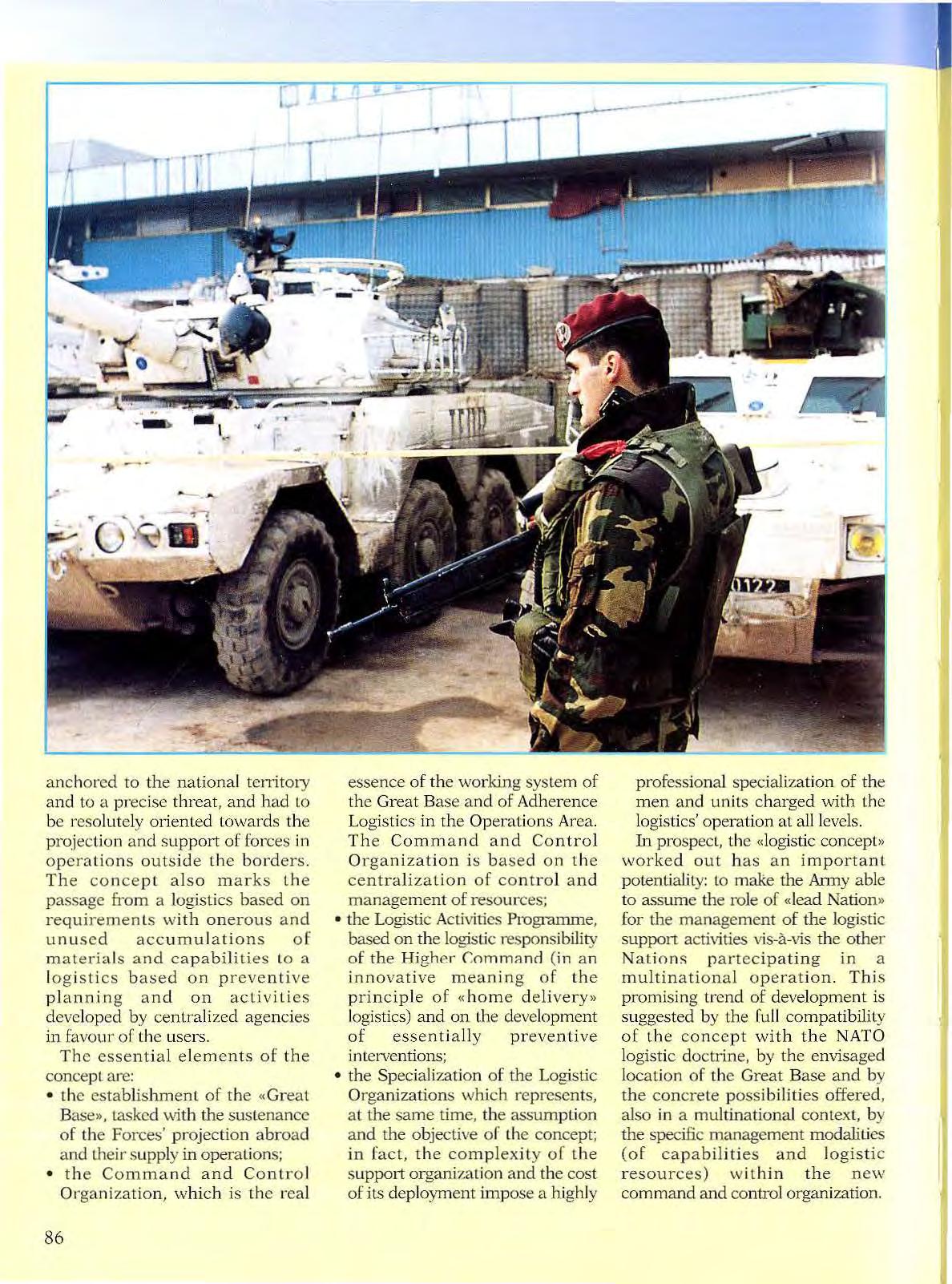
86
ENGI 1E ER WORK S
CONT RA CTS
The development, in practical terms, of the logistic reference co ncept, has le d to th e integration of the logistic capabilities in to real «l ogis ti c syste ms>>, i.e. organized sets of procedures, pe r s onn el, equipment a nd resources aimed a t su ppor tin g s pecifi c mission s . Having examined the systems, it has been possi ble to define the logislic capabilities that m u s t be ass u red at the different organiza tion le ve ls This is briefly s umm ed up by the table above.
A fundamental s tep for the ident i fica ti on of the l og i stic cap abilities was the defini tion of the orga nizat ion al pri ncip les which a re the bases of adherence logis tics:
• op erat ion-o rien ted system : adh e re nce lo g is tics is p revalently oriented to the opera tions. When in garrison, t he resort to goods and serv ices ava ilable on t he mark e t should be pr efe rred (food s uppli es eq uipment- andinfrastruc ture maintenance etc.);
• cen tralization of th e capabilities: it represents the answer to the progressive contractio n of the operation al instntment, in order to pursu e the functional balance among the different componen ts;
• co nfi guration by m odu les a nd sp ec ializati on: it is an in dispen sa ble premise for t h e accomplishme nt of the taskorg ani zatio n con cept. It also a llows to a ccura te ly fit th e ins tru ment to th e operationa l re quirem e nt , \Vithout gaps or

,,,
OF CAPABILITIES GARRISON C APABILITIES:
• PROJECTABLE CAPABILITIES:
SUPPORT ADHERENCE CAPABILITIES LOG ISTI C 11'\SPECTORATE LO G ISTIC A RE A C OMMAND LA D FORCES lr>TERMW IAT£ BRIGAD E REG IMENT C4 X(XX) X XX XX XX XX C2SUPPORT X X XX XX XX XX Medical Service X (XX) XX XX ;;.;l ' m :z: Accounting X (XX) X X XX XX XX !-< 0 Food supplies XX XX XX mm Ge3 Clothing X X XX XX XX Barracks Assets X X X X X 0 Mobile Equipment XX X X <n E- Pr ev entive l nter vc ntios X X XX XX !;; R eplacement XX X XX::.. t.) - Co.-rcctive I nt e r ve ntios X X XX XX - w Re co ver ies X X X X Class (NATO) I X XX XX XX Class IJ X X XX XX XX Class lfl X XX XX XX Class (NATO) lH X XX XX Class (NATO) IV X XX __._ __ Class (N ATO) V X XX XX XX Transfers Domestic Transfers Ext e rnal Tr a n s fer s Domcstic Logistic Support External Transfers
REQUJRE:vtENTS/ALLOCATION
X
XX
XX X XX XX XX XX X X XX XX XX XX XX X X X X Housing XX X(XX) X
XX XX XX XX XX XX XX XX XX XX XX XX XX XX XX XX XX XX
87 . l "
Great Base
LAYOUT B Y BLOCKS
redundancies;
• co in cidence of the responsi bility wi th the technic al competence and availab i lity of the requ ired resources: the Command ers must regain their role and their freedom o r ac tion, i n orde r to a ccomp li sh their instituti ona l ta s k, i .e th e r e adin ess and employment of their instrum e nt;
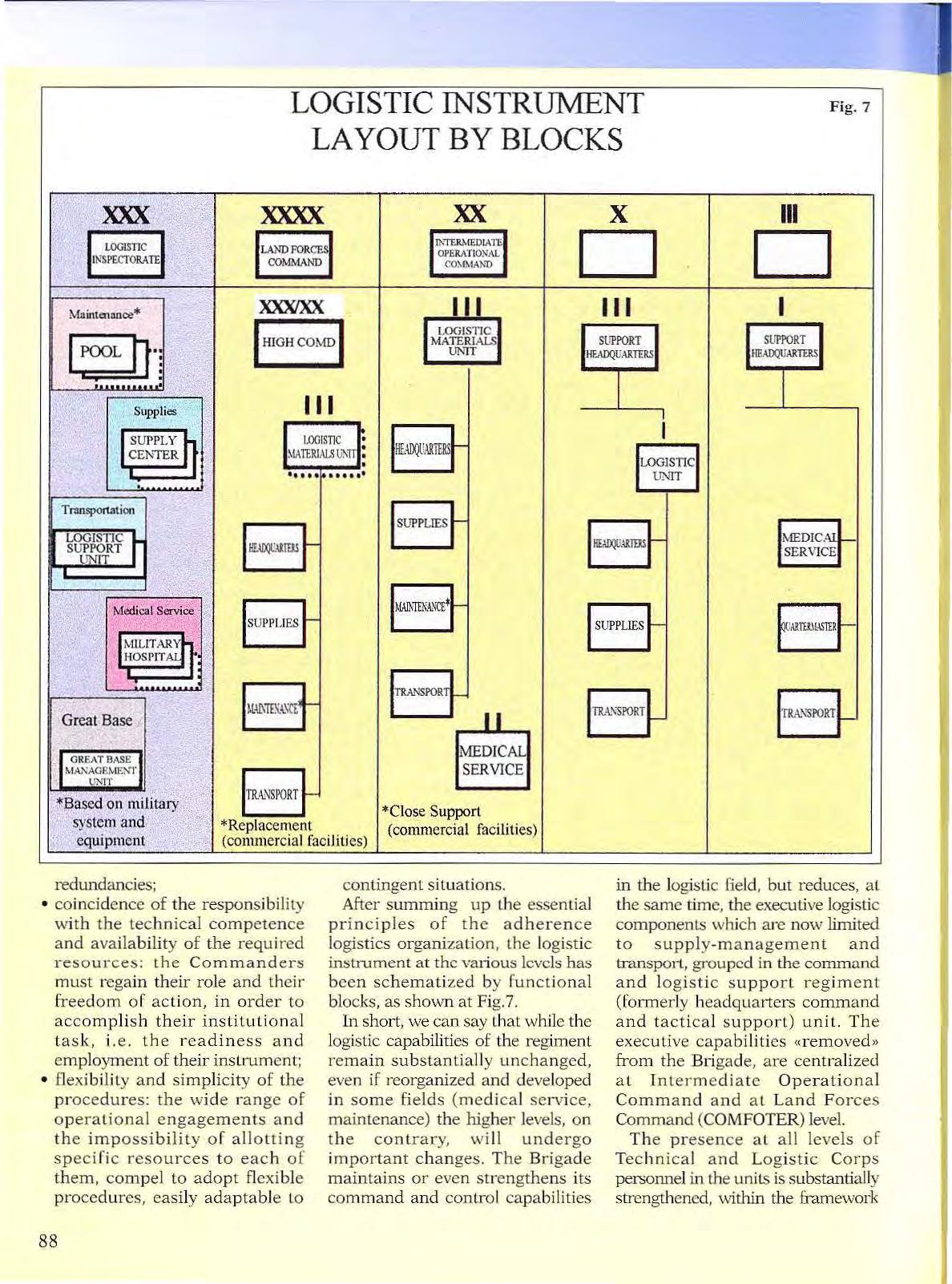
• flexi bi lity a nd simplicity o f the procedures: the w ide ra nge of operational engagements and the impossibility of allottin g specific resource s to each of th em, com pel to adopt flexible proced u res , eas ily adaptabJ e to
*Close Support (commercial facilities)
continge nt situations.
After summing up the essential princi p les of the adhe r ence logistics organization , the logistic instn1me nt at th e various levels has been schemati zed by functional blocks, as shovvn at F ig. 7
In short, we can say t hat wh il e the logis tic capabilities of the regiment re main substantia ll y unchange d, eve n if reorganized and developed in so me fields (medica l se r vi ce, maintenance) the high er levels, on t h e contrary, will undergo i mpor tant c h anges. The Brigade maintains or even strengthe ns its co mmand and contro l capa bilities
in the logistic Ge ld, but reduces, at th e same ti me, the executive logistic components which a re now limited t o supply-management and transport, groupe d in the conunnnd and l ogistic su pport reg im ent (form erly h eadq uarters command and tac t i cal sup port) unit. Th e executi ve capa bilities <<removed » from t h e Brigade, are centralized al I ntermedia te Opera t ional Comm and and al Land F orces Command (C OMFOTER) level.
Th e presence at all levels of Tech nica l and Log i stic Corps persmu1el in the units is subs tanti ally strengthened, within the framewo r k
LOGISTIC INSTRUMENT
F i g. 7
88 XX
Ill D r ' . .. ... .. ,.. ......- .. !:.. • •
Iof p rofessio n alization/specialization o f logi stics . Th is aims a lso a t ass uring an adequ ate support to th e Commanders, d isengaging them f r o m the man ageria l tech nic a ladminis tra tive-accoun ting activities.

With in t hi s fra me work, t he revisio n process of the procedures re levan t t o adm in istra t ion , f ood s uppli es, e quipme nt-and -sys tems maintenance, modernizatio n a nd m anagement of the infrastntc ture, h as no t b ee n less sig n.ifir.:1n t.. Th ese ac ti vities are essentially logistic, but they can have a crucial influence on the ove ra ll opera ti o nal capa bility. The process is canied out accordin g to the ex i stin g rules; it a i ms a t ac hi eving s i m plifi cat ion an d e ffectiv e nes s , a ls o th r ou g h th e ass ign ment of res p o nsi bi lit ies to those who have t h e ski lls and the capabili ty to assume them.
Support on th e national t errito ry is assu r ed by a small numbe r of
logistic f ormations, grouped in s uppl y or gan izat ions and speci a li z ed m ai ntenan ce pol es, wi th areal competen ce, integrated through a f u lly c o mpu t er i zed Comma nd and Contro l s yste m Th e logi stic systems in support of the operation s are put into action by th e capabilities described a bove.
PLANNING PROSPECTS
\o\li tb t hes e b r i ef r ema rks , we intended to prov id e a general des cr ipt ion of th e p l a nn ing objective s rel a t e d to th e c urre n t activities. T hese object ives aim at ca rrying into effect \.v h at has been planned in 1997 and, cs p eciaJJy, at the se t ti ng up o f the «Ar my S ystem >> in its n ew shape as an i n teg rat e a nd integ ra ble instru me nt. I n t his p ers pective, h aving defined th e operational
modules and checked t heir internal coherence, it is necessary t o pursue th e f un cti on al a n d q u an ti t a t ive bal a n ces am o ng the d ifferent function a l comp o nents, as w e ll as t he ir int eg r a tion into th e mu ltifu nc t io na l ope rati ona l aggregates. The following step is to gi ve to th ese «ag g regates», bo t h nat iona l and s ingl e-se rvice, t he c haracter ist ic of full integr a b ility in jo int and combined task-forces.
The primary o bjective for 1999 is t o set up a n org a n ization abl e to address and to s uppor t t h e Army on t he w ay t o it s full -jo in t and multina tional in tegrability.
Th e fo r mulation of a s p ecific prqject aiming at the creation of an Authority for Doctrine, Development, Procedures a n d Trainj ng (s inlllar to TRAD OC) has therefore been started. This authority will have, in a uni tary wa y, the r esp onsibili ty of th e ment ioned subjects, a s well a s the
I J I I
89
responsibility for Applied Operational Research and for Simulation in support of planning and decisions.
In the same context, it will also be necessary to give new shape to the school-and-training component, with a twofold objective: on the one hand, the effectiveness in terms of training and, on the the sustainability, in relation to the resources and the dimensions of the operational component, of which the schooVtraining component is the most qualified support.
In particular, the Authority should systematize the generation of the fundamental requirements of the land forces - the capabilities - in the various operation and cooperation environments.
This process, to be carried out in the appropriate international forums, starts by the definition of the scenarios, followed by the elaboration of the operational concepts, in this way, the so-called «Lessons Learned Cycle» is put in motion and sustained.
The last phase of the process, which has a cyclical and selfcorrecting feature, is the definition of the forces' requirements, with reference to the six fundamental qualification areas of the Service (man, doctrine, leadership, mate1ials, force stn.tcture, training).
The Authority in question should represent the focal point of a check and validation system of capabilities and units, as a premise for their organic homologation and introduction in operations.
The fundamental objectives, relevant to the instrument's internal integration and integrability in joint and multinational contexts, though clearly defined in terms of concepts and organization, still require remarkable efforts for their achievement.
The results will depend on both
the available resources and th e possibility of overcoming the bonds and restrictions that at the present time give rigidity to the (<Army System». It is sufficient to cite a single example: the procurement procedures for the systems, stiiJ too long and complicated.
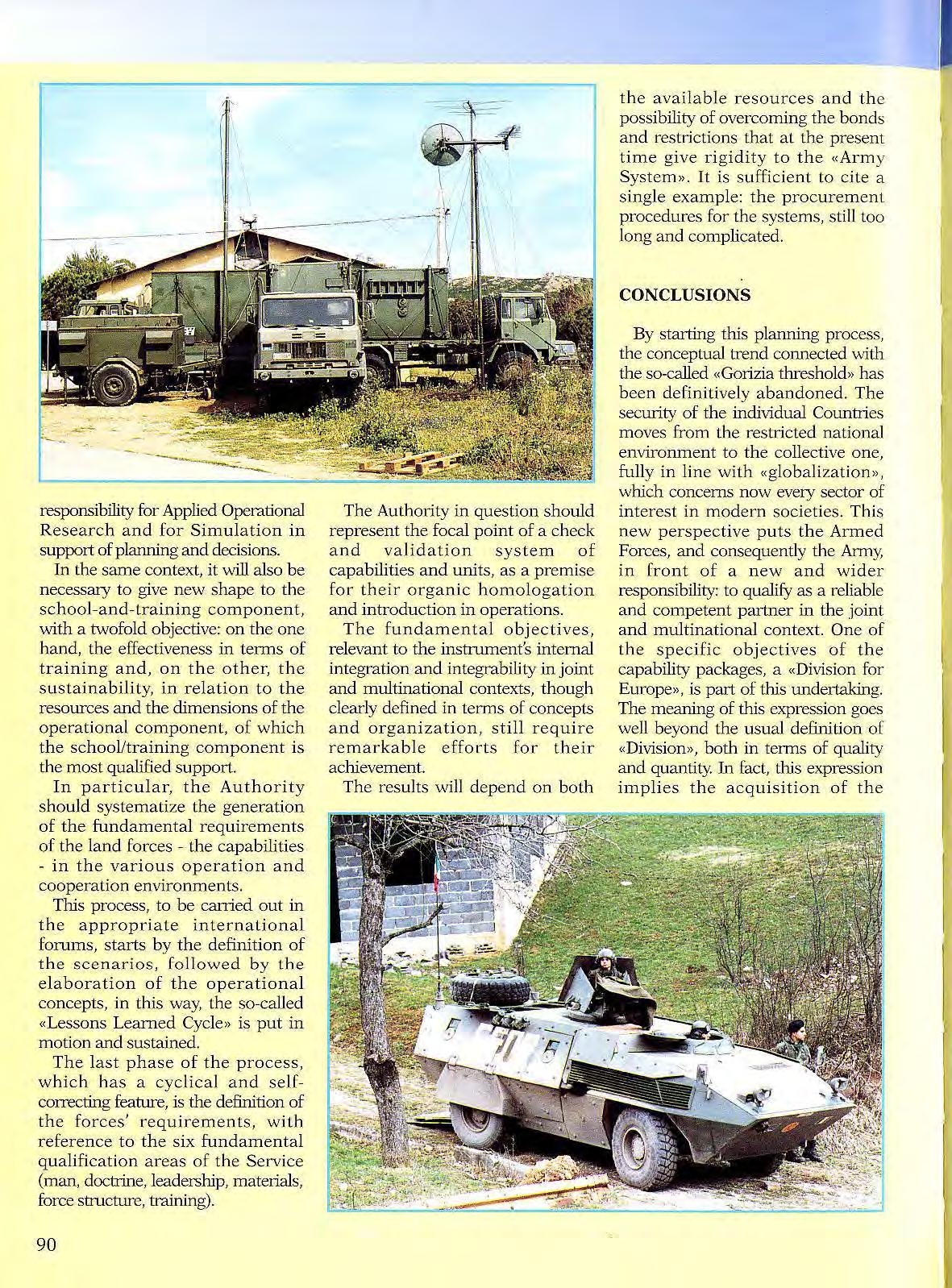
CONCLUSIONS
By starting this planning process, the conceptual tTend connected \.v:ith the so-called (<Gorizia threshold» has been definitively abandoned. The security of the individual Countries moves fTom the restricted national environment to the collective one, fully in line with «globalization», which concerns now every sector of interest in modern societies. This new perspective puts the Armed Forces, and consequently the Am1y, in front of a new and wider responsibility: to qualify as a reliable and competent partner in the joint and multinational context. One of the specific objectives of the capability packages, a «Dh.ision for Europe», is part of this undertaking. The meaning of this expression goes well beyond the usual definition of «Division», both in te1ms of quality and quantity. In fact, this expression implies the acquisition of the
90
ca p a bility of proj ectin g a comp lex of forces and a ssuri ng its sup p ort in case of long - t erm o p erali o n s; a formation s haped in relation to task a nd s cenario , st ructu r ed on a Comma nd a t divisio n level, two B riga d es and the es sential t a c tical an d logistic suppo rt. In subs tance, it is necessary t o provide contribution s qu alitatively a n d q uantitatively equal to th e o nes o f th e ma in E urop ean pa r tners, in o r d e r to sh ar e t h e resp o n s ibili ties and t h e advantages of com mon s ecurity on a p lane o f equal digni ty Borrowing the slogan o f an effective conu n ercial, we can say t hat the plannin g process must tum a «Large Anny » int o a «Grea t Ar my» . An Army s tr u ctu re d for d e t erre nce and wit h p ote n t i al c a p a bilities ( t o be com pl e t e d , in c ase of em er ge n cy, thr ou g h a comp li ca ted mobili zat ion process), m ust produ ce an instrument ready for the rea l employ ment, o n the basis of even lo ng-term ope rational cycl es . Th e compl e x o f forces m u s t esse ntial ly allow the altern ation of s everal continge n ts, a d a p ted to the p arti c u lar need and fu lly integrable wit hin join t a nd multi n a t io n al f or mati ons. I n th e g lob a l p i c tu r e outlined, a substa ntial clarity o f aims and targets is in e vitably in co ntrast with t h e uncetiaint:y of the results. At thi s point , it is necessary to take into

c o n s id e r ation th e pri nci p l e of gra d u a lit y in th e re a li z a tio n of com p le te c a pabil i ti es, re a d y for employment. T his concept is typical of th e organi zat ion o f the o perational component by capability p ackages
O n t h e se b ases , at present th e Itali a n A r m y ha s an ac t ual project i o n capa b i lity of a twoB rigad e divis io n al co m p le x, for th e e m pl oyment out of a r ea and w Hh the p ossibil ity o f p artial turnove rs
As far a s we ca n fo resee today, the «proj ecti on p ackage» objective
and th e o n e co ncerning the rela ted logi st i c Grea t B ase - w hich will ensure th e susta i n a bili t y of th e e ffor t s for s e v e r al o p era t ion al cycles, through the rotati on of th e fo rces - will be fu ll y ac h ie ve d by the year 2000.
0
''B rigadie r Gene ra l, Chi ef, Wo rki n g Group Army Ge ne ra l S taff
NOTES :
(1 ) Th e Adhe r e n ce Log i sti c, p r ov ide d by t he elements d i r e c t ly includ e d in th e ope rat i on al co m po ne nts, in t he mult inati ona l e nvi ronme nt as s u mes th e denomin a t io n of Co m b at S e r vi ce Su pp ort.
T he S upport Lo gistics is prov id ed b y th e Lo g i sti c org aniza ti o n sub o r dinate t o t h e Logisti c I nsp e ct o r ; in th e i nt e rna ti o n a .l e nv iro nm e nt it norm a ll y assum es th e de n ominat i o n of S tr a t e g i c Support.
(2) On this the su bj ec t, see th e ar ti cl e b y Li e u t. C o l. Sa ur o Bai s l rocc hi , publi shed i n th e p resent issue.
91
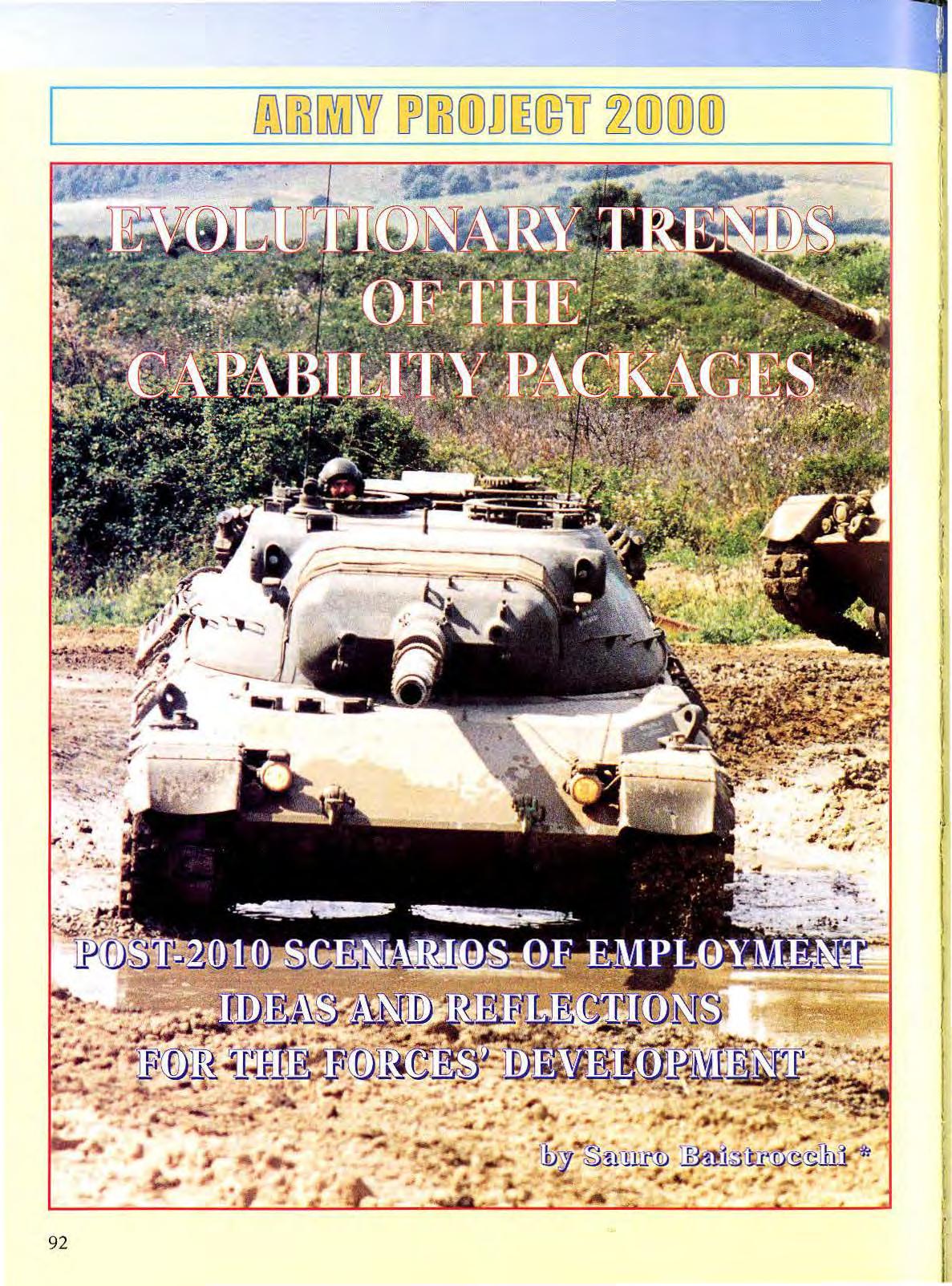
_ __] l I 92
The no tes on vvhich this article is cent r ed a r e based on the studies (:arried out b y the A rmy General Staff, and have the purpose of outlining, with reference to post-2 010 probable scenar ios, some possible directions for an in-depth study of the long-tem1 development or the national land forces.
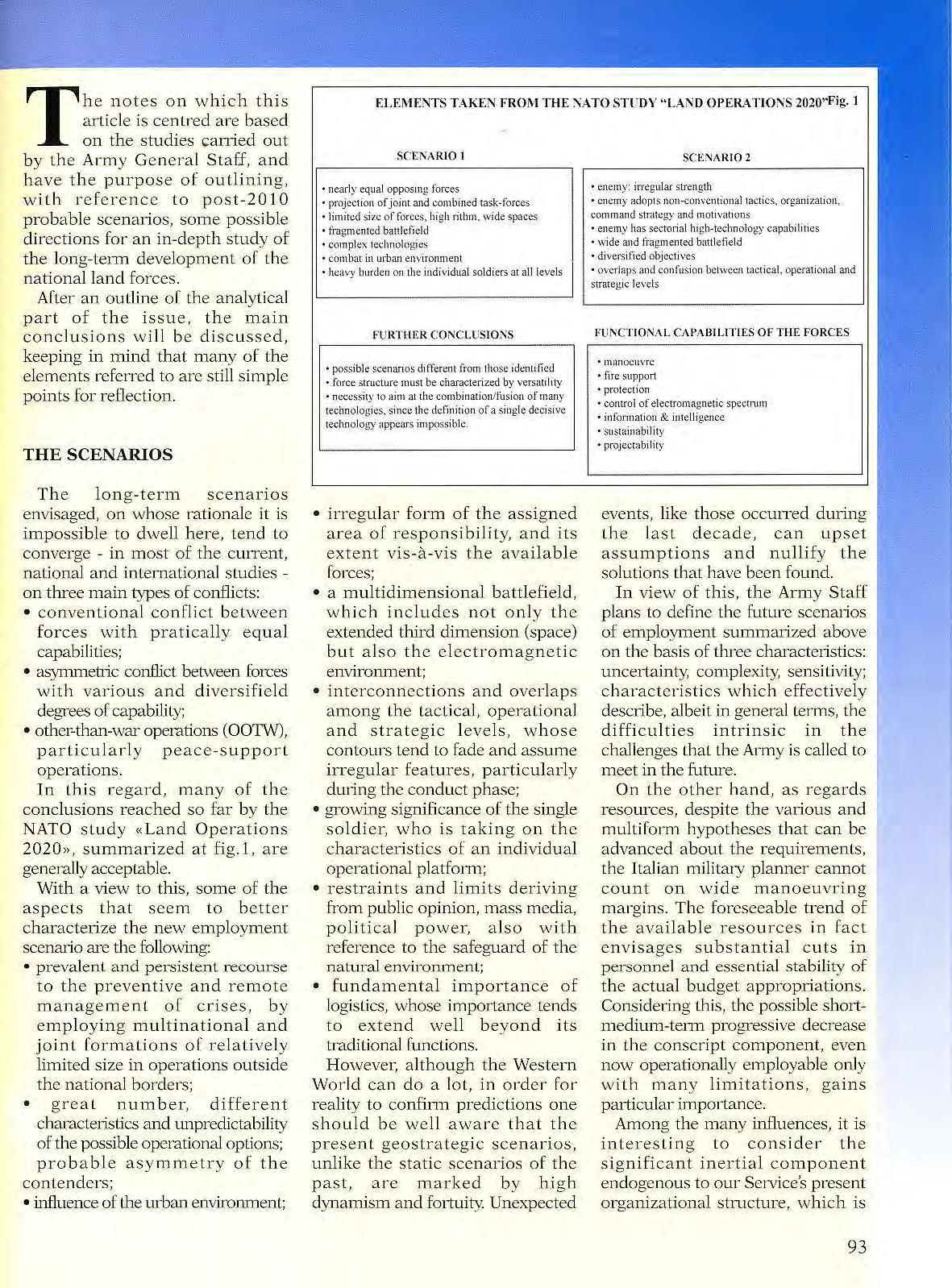
After an outline of L.he analy1ical part of the issue, the main conclusions will be discussed, keeping in mind that many of the elements referred to arc still simple points for rdlection
THE SCENARIOS
The lon g-term scenarios envisaged, on whose mtionale it is impossible to <.hvell here, tend to converge - in most of the cuiTent, national and international studieson three mai n types of contlicts:
• conven tio na l conflict between forces with prati cally equal capabilities;
• conflict between forces with various and diversifield degrees of capability;
• other-than-war operations (OOTW), particularly peace-support operations.
In this regard, many of the conclusions reached so far by the NATO study «Land Operations 2020», summarized at fig.l, are generally acceptable.
\.Vith a view to this, some of the aspects that seem to better charactelize the nevv employment scenario are the follo\ving:
• prevalent and persistent recourse to the preventive and remote management of crises, by employing multinational and joint formations of re lativ ely limited size in operations outside the national borders;
• great number, different charactelistics and tmpredictability of the possible operational oplions; probable asyrn metry o f the contenders;
• influence of tl1e urban environment;
SCENARIO I
• nearl y equa l opposmg forces
• pmjcction of joi m and combined task-fo rce s
• lim ited size o f forces, hig h ri th m, wide spaces
• fragmented bat!lcfield
• complex 1echno1ogies
·com bat in urban environment
• hc;wy burden O!l the indiv idua l soldiers a t all leve ls
FURTHER CONCLUSIONS
·possibl e scenanos d ifferent from those identifi ed
• fo rce ;t ructure must be characterized by ve rsatiltty
• nec.essily 10 aim <U Lhe combination/fusion ofmany technologies, since the definition o f a sin gle decisive techno i.OJ;,')' ilppears impO:$S ib lc
• irregular form of the assigned area of respons ib i li ty, and its extent vis-a - vis the available forces ;
• a multidimensional battlefield, which includes not onl y the extended third dimension (space) but also the e lect romagnetic environment;
• interconnections and overlaps among the tactical, opera tional and strategic levels , whose contours tend to fade and assume irregular features, particularly during the conduct phase;
• growing significance of the single soldier, who is taking on the characteristics of an individual operational platform;
• restraints and limits deriving fTom public opinion, mass media, poli t ical power, also with reference to the safeguard of the .natural environment;
• fundamental importance of logistics, whose importance tends to extend well beyond its tn.tditional funct ions.
although the Western World can do a lot , in ord er for re al ity to confirm predictions one should be wel1 aware that the present geostrategic scenarios, unlike the static scenarios of the p a st, are marked b y bigh dynamism and fm tuity. Unexpected
SCENA RI02
·ene my: irreg ular strength
• enemy adopt s non -convent ional organizaLion, command stnucgy and mo ti va uons
• enemy has sectorial high-techn ology capabihties
• wi de and fragmented battle lield diversified object ives
• overi:lpSa nd confusion bc t\\'CCn tactical, ope rational and strategic levels
FUNCTIO NA L CAPABlLITI£S Of THE fORCES
• manoeuvre • fire support
• protection
• control of elec tromagnetic specmun
• iulbl'lnation & intelli gence
• susta inabili1 y
• projcctabitity
events, like those occurred during the last decade, can upset assumptions and nullify the solutions that have been found.
In view of this, the Ar my Staff plans to d efine the future scenmios of employment swnmruized a bove on the basis of three characte1istics: uncertainty, complexity, sensitivity; cha r act eristics which effectively describe, albeit in general terms, the difficulties intrinsic in the chaiJenges that the Arrny is called to meet in the future.
On the other hand, as regards resources, despite the vmious and multifom1 hypotheses that can be advanced about the requirements, the Italian military p lanner cannot count on wide manoeuvring margins. The foreseeable trend of the available resources in fact envisages substantial cuts in personnel and essential stability of the actual budget appropriations. Considering this , the possible shortmedium -tem1 progressive decrease in the conscript component, even now operationally employable only with man y limitations, gains particulru- impo r tance.
Among the many intluences, it is interesting to consider the significant inertial component endoge nous to our Service's present organizational structure, which is
ELEMENTS TAKEN FROM THE '\ATO STUDY "LAND 2020"Fig 1
93
apparent on the concrete plane mainly as conceptual fracture between present and future. The dinamic, logic and programmatic continuity of the development of concepts and stntctures appears to be a necessary precondition for an effective force planning. In every considered historical moment along the path of development, the Army stntcture should actually configure the achi evement of a complete planning/programming objective, capable of expressing a welldefined complex of integrated and synergic operational capabilities, fundamentally adequate to meet the current requirements.
TilE COMPETITIVE ADVANTAGE
In d efining the key factors for the development of the forces, the predominant approach in the Western world considers t echno logical superiority the main strategic advantage in the competition with the potential adversaries. The maintenance, and
possibly the enlargement, of today's technological gap are preconditions for exerting on effective deterrence and, if necessary, for a successful employment of force, also against Nat ions that can deploy a quantitatively overwhelming strength as compared with the numerically limited - in relative terms - manpower of the West.
The NATO study now w1der way, Land Operations 2020, appears to substantiate this approach.
It cannot be denied that the technological content is a factor destined to characterize the national instntment of the future.
Ta king a more comprehensive glance at conceptually wider horizons, one is led to believe that th e quest for possible competitive advantages p asses first of all through structural im1ovations and only secondly through technological advances. The latter are necessarily subject to the specific requirements of the stntcture, also considering the costs, often very high, entail ed by its in1plementation.
It must also be emphasized that,
in the mentioned context, one should atttibute to the «Stntcture» term a very ample meaning, related to systems and not only to organizations.
A stn.tcture is a body vvith set goals, constituted by men who have at their disposal relational concepts and procedw"es as well as working tools
The structural innovation therefore consists in defining suitable organizational concepts, but its unavoidable precondition is the qualitative improvement of the human component.
THE LOGICAL PROCESS FOR DEFINING TilE DEVELOPMENT PATH
In short, the force planning approach for the future scenarios that the Italian Army is exploring has as its general objective that of maximizing the effectiveness of a military instrument of limit e d quantitative dimensions as compared to complex operational requirements, only partially foreseable and, in any case, variable in time and s pace. This general objective is split in partial objectives, coherent with it, complete from the operational viewpoint and suitably placed in a time perspective. On their turn, the partial objectives are expressed in terms of acquirable capabilities.
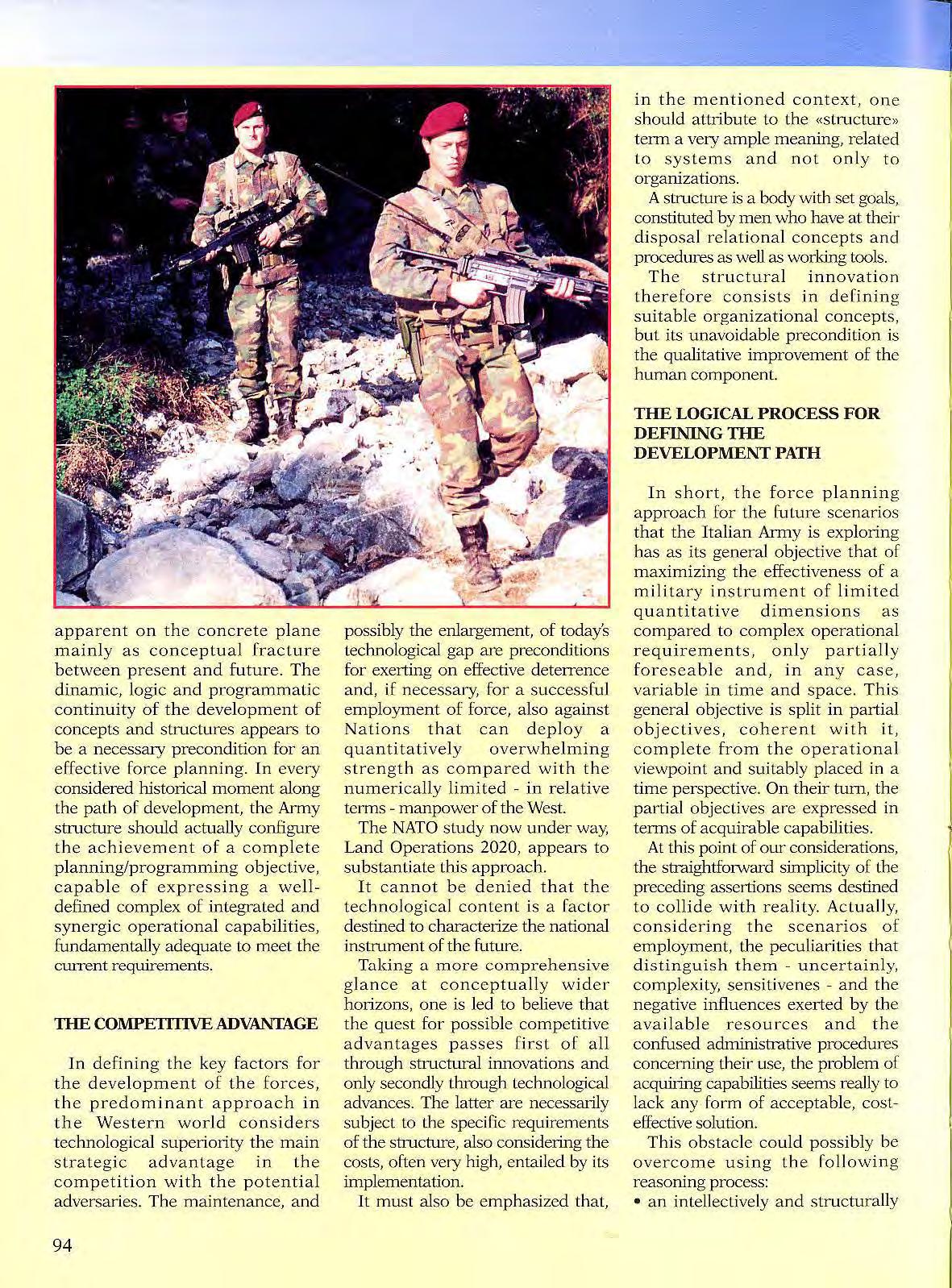
At this point of our considerations, the straightforward sin1plicity of the preceding assertions seems de.<>tined to collide with reality. Actua.l.ly, considering the scenarios of employment, the peculiarities that distinguish them - uncertainly, complexity, sensitivenes - and the negative influences exerted by the availabl e resources and the confused administrcttive procedures concerning their use, the problem of acquiring capabilities seems reaUy to lack any form of acceptable, costeffective solution.
This obstacle could possibly be overcome using the following reasoning process:
• an intellectively and structurally
94
versatile instrument, i.e. ab le to reshape itse lf rapidl y fo r d ifferent needs, is on principle better than an Army that prep c.u·es in advance a range - as wide as may b e , but fixed - of employment optio ns ;

• the optimal per fonn ance in the prepara tion phase and t h e operational success depend essentially on the intelligence of the structure as a w ho le, i.e. on the abili ty of the structure itself to prepare and govern , with rationality and accord ing to its instit u tiona l en d s , t h e activiti es w h ich it is called to condu ct;
• th e maximizat ion of the structure's intelligence is obtained by dynamically pursuing, on the one hand, the integration of the execu t ive capabilities, essentially s p ec i a l ized and relate d to the ma terial and connected operators and, on the other, the synergism, at all leve ls , of the typically and exclusively human capab il ities;
• there is th en a co re capability that preced es and dom i nates a ll others. lt is the i nstrum ent's capability to change its functional and operati ona l organization according to the specific need;
• this core ca pabilit y must be acquired as a priority, because it is th e one and on l y that can ensure the growth of t he Arm y Th e core capabi lity is at t ained ess en tia ll y t h rough s t ructura l impr ovemen ts, meaning by «Slructw·e, the whole o f men and rules which guides individu al an d g 1·oup activ i ties. In s t r i ctly m ilitary terms, t he core capability coincides w it h th e command and co n trol coref u n c tion, i.e. ex t ended to operalional employm ent as w e ll as to the force pr ep a rat i on a c tiviti es;
• the best gene ral organization form ul a for achieving the mentioned goals is the matri x, i.e., in evol u tionary terms, the net, because it em p h asi zes the taskoriented flexibility of t h e structure, e nsures the optim a l
emp lo y men t of th e speci a l ize d resou rces and spurs the versatility and creativity of th e human component. This req uires a high qualificatio n of the personnel and implies a modularity o f the structure at all levels.
THE NETIVORK STRUCTURES
The network o r ganiz ation struct u res, as the name indicates , are represented (fig.2) by a nwnber (tha t may be h i gh) of knots, in terconnec te d by links. In general, the k nots ( use r points) arc not ::trranged in adva nce according to a preestablished relati ona l hierarchy, which is i nstead d ynam i ca lly defi ned a cco rding to the s pecific tasks.
The mentioned structures tend to borrow the chara cter i st ics of telecommunications and computer net'"' orks, i.e. ubiquity and reversibility.
Ubiqui ty co n s i sts of the possibility to use in each knot o[ the net all t he «energy» availa ble in
the entire s tr uct ure. T h e st.J.uctw·e is t herefo re not localize d , but distribut ed th ro u g h space, in a range of points w ith equivalent capabilities, nor can it be localized on the vulnerability plane.
Reversibility consists not only of the po ss ibil ity o f dynamically ranging the knots, but also of the fact that the c urrent use of the energy do es not affe ct t h e t ota l p o t ent ia l ava ilable, which is conti nually recons tituted b y the network itscl f.
The «e n ergy» of the net\vork's organizational stmctu r es is made up by two fundamental types of reso u rces : in formation and control.
While inf ormat ion (shared «plannin g and program mi ng» r e source) i s u s ually co ns tant ly a v a ilab le is eve ry kn o t, c o n trol (executiv e a uth o rity) is re leased according to a task-oriented logic. By releasing degrees of control in the network one defi nes the h ierarchical relations o f the knots.
The network structure is often deem e d reduc ti ve, fo r it is a techno logical system subject to a
95
struct1J.re with a random organization or with no organization at all.
Actually the effective possibilities of this concept emerge only after its full application to the functioning principles of the organizational structure itself.
The mabix/network organizational structure permits to dynarnica.lly manage complex situations marked by unc ertainly and variabil it y, optirnizing meanwhile the employment ot the scarce resources. Nevertheless, this structure is difficult to govern, especial ly as regards the typically military requirements of the hierarchical line.
In order to ensure the structure the necessary degree of integration and synergism, making it governable on the basic of simple guidelines, such as the «competence principle» or the «exception principle» a pt to free the responsible summit from onerous direct coordinative interventions the su bordinate level, it is possible to superimpose on the netvvork, and insert in it, a range of organizational instruments, already proved from the theoretical view point, capable of focalizing the activities conducted on predetermined institutional objectives.
For example, the Theory of the
Games proposes, arnong others, the «non-cooperative>) game, kno\v'TI as the «prisoners dilemma».
The game pennits to identify and analyze the problems of noncooperative «Social» aggregation and, in many cases, to find the relevant COJ.Teclive measures.
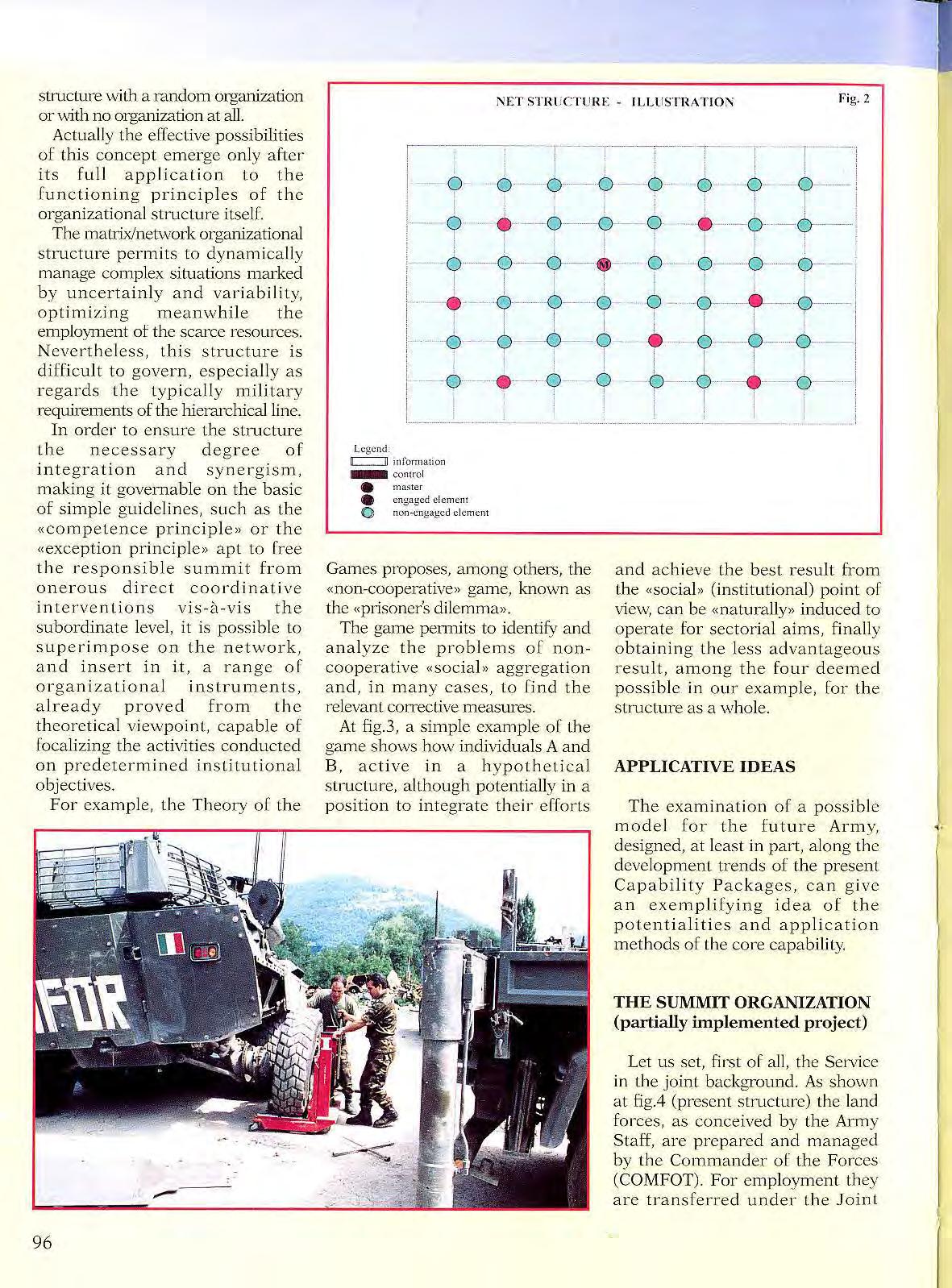
At fig.3, a simple example o[ the game shows how individuals A and B, active in a hypothetical structure, although potentially in a position to in t egrate their efforts
and achieve the best result from the «social» (institutional) point of view, can be «naturally)) induced to operate for sectorial aims, finally obtaining the less advantageous result, among the four deemed possible in our example, For the structure as a whole.
APPLICATIVE IDEAS
The examination of a possible model for the future Army, designed, at least in part, along the development trends of the present Capability Packages, can give an exem p.li fying idea of the potentialities and application methods of the core capability.
THE SUMMIT ORGANIZATION (partially implemented project)
Let us set, first of all, the Service in the joint background. As shown at fig.4 (present structure) the land forces, as conceived by the An11y Staff, are prepared and managed by th e Cornmander of the Forces (COMFOT). For emp loyment they are transfer-red under the Joint
96 NET STRUCTURE - JLLliSTRATIOi'i Fig. 2 r- ---·-···--!! I I r- · . --·-·-:----··--r-- r - I ···--: I ' ! - 0 0 -·-·--6 . - 0 -·0 ··. 0 ··-0 ·-- -·-· 0 -··-- ! 6 ····-e ------o ---·----6 -- o ·! r-- I I I J • ' r 1 i i 1 t· -9 ··--·-y ·-<?, ·--·· -· ? i ! i I ! t ! ---· ·0 ---· ···0 -- -0 - 0 ·-0 -·-· · - · ·- -0--· - I I ! ! I i I I I l I i- ·····--·6 -·· -9----<?-- -9 ., ·--·--0 ·9 -··--0 ! i ' ' • ' 6 ! I I ' I ! ! ! I . i 1 ·0 -·-- -®·--··0 -·- Q - h- ···· ·· --·-0 -·-! ! I ! ! ! I ! ! ; : ; i ; ! ! ! I i j I I : I I i !_ ____ -.......... • ' Legend: c::=D informati on - con crol • • engaged el emen t 0 non -engaged clement
Operational Command (COl), through which the Defence Chier of Staff exercises the O perationa l Command (OPCOM) in operations; subsequently, organized in a Joint Task For·ce (JTF) - combined, if necessary - they are placed w1der a Force Commande r (COMFOR), who is normally charged ·with the Opera tiona l Command in the operations 1.one . The objective's s tructure shows the possibilities provided by th e network integration of the joint summit and must be r ead having as a reference the abovesaid characteristics and capabilities of such organizational scheme.
The Army gen e ral structure includes the Summit Organization and the Porces' Organi zation, 'Which embody the necessary command and execution capabil ities (fig.S).
The Commander of the Service is the Arm y Chief of Staff. He avails himself of a concentrated command capability, which is the starting point of the forces' hierarchical line in the preparation phase and finds its express ion in the Su mmit Organi zation , both, with the Arm y Staff, in terms oC evolutionary capability - i .e. studies
and plans - and, with the Forces Command, foe what concerns the execution of the p rogrammes and the management of the units.
The Forces' Organiza tion instead, is stcucturecl on a distribu ted command capability, based on single pre-established inter-branch leve l , the major unit , and on regiment-level modules joined into functional Centres for their preparation. Fig.6 shovvs the two key figur es of the Summit Organiza.tion,
the Army Deputy Chief of Staff <:md the Forces' respectively in charge of the Anny Staff and the Forces' Command.
The Army Deputy Chief of Staff is responsible for force planning, that he orients towards object i ves represen ting complete operational capabilities Within this framework, he outlines the basic operational p lann ing at runct ional-moclule level, so as to be able to proceed to the eva lu ation , programming and preventive allocation of the fo r ces in a dynamic and integrated context, taking into account both the needs connected with the constn1ction of the forces and those r·elated to the emp loyment of the single functional modul es that \Vill have to compose them in the op e rations. In substance, a lso the operational planning - like the forces - is l aid out in modu l ar terms, and each module is col le ,·ently asse mblable \.Vith others in order to make up a plan, j ust as the force modules arc assembled to constitute a task force. The intent is to provide the operational planning \.Vith the necessmy versatility to face contingencies that cou ld develop, spurred by the events , in sbort peliods of time and in only panially foreseable terms.
The Forces' Commander can ies out the Arm y Staff's progmmmes,
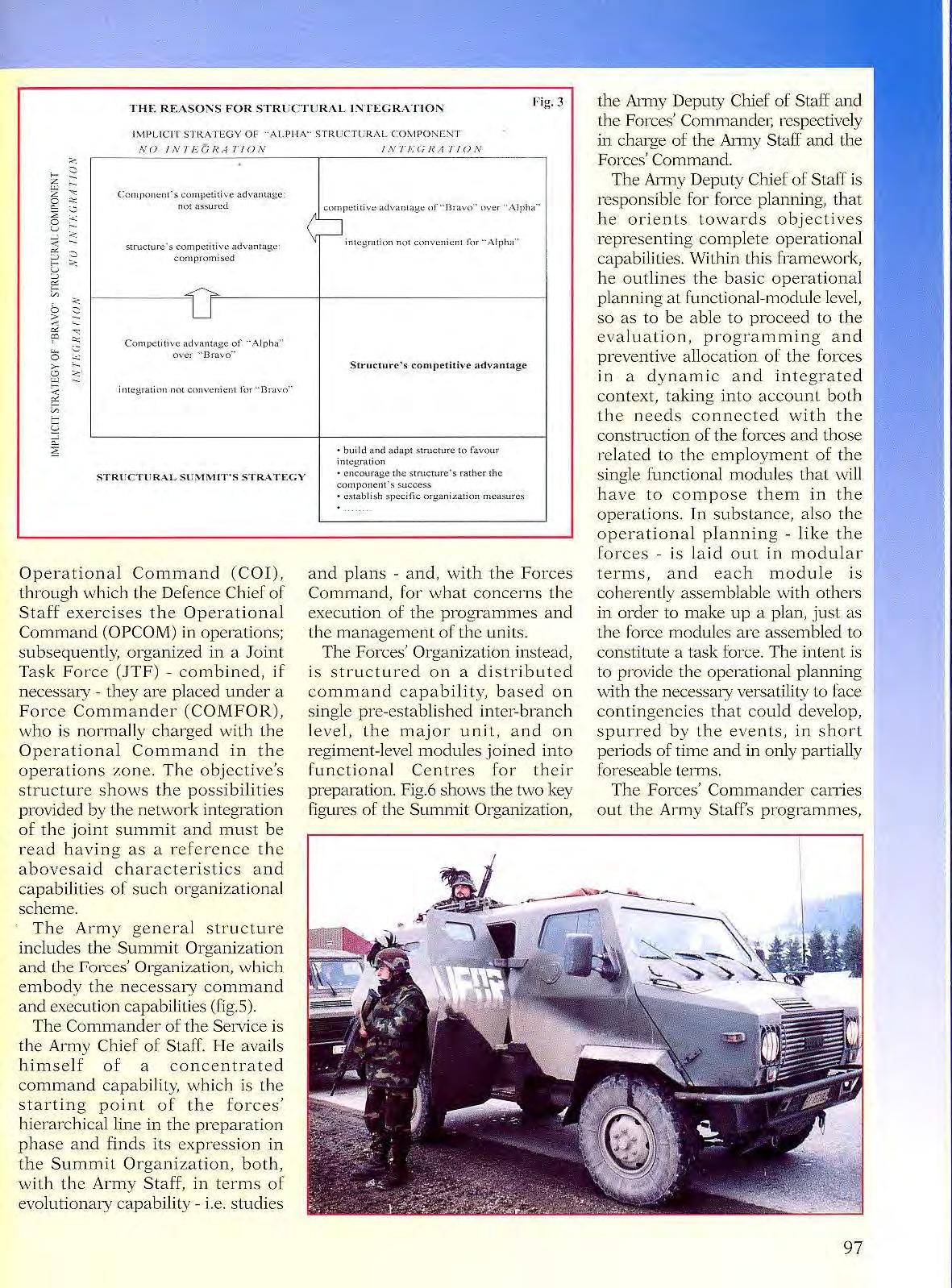
THE FOR STRU C T URAL l."'f£GRA'fi0N Fig. 3 I MPLIC IT STR ATEGY OF "AI PHA" STR l! C Tl : RA L CO'viPO NE:-.I T ::.-: 1- 0 - :z ;... u; :«: "" 2 "' ;::; V :.: 0 ;... u _, >-: < "' 0 :2) ,_ "" u :.; c< NO I N T J·: t RA T/(}N COIHpont: nt ' s cun •peti tiv e advarHage : no! struclu re s com p cti ti CC>rllp rom i sed I N TI·: GIIA TIO N i n a :gn11 i on n o l liu "'A i phH , ,_ "" >-: b 0 > '- -<« "" !p "" .... ;,:: 0 :..:..:: >- '0 ::,>; ' E! < c "' b :J 0.. ;g Com pe titive ad v antage o f ··Alpha'' over Dra.v o int egra ti on m)t convc nit:I'H l{) r "Dnn o>· S UM MIT 'S STRATEGY
Stt'uctu.re's competitive advantage ·bui ld (!od adapt structu n:: tO favou r i n tegra tion encourage the stm cture s rath er the cornpolle llt •s success • estab li sh !-> pCcific orga ni zat ion rnc-asures
97
Br a nch or Sp ecia li ty Tra inin g Ce ntres, vvhich are demul tipliers of th e orga nizat ion lin e d escending from the F orce Comman d. They have no operational functions , but are responsible for the preparation of the modu les for e mployment , also as regards the preparation o f t h e blocks for th eir in-T heatre ro ta tion in case or lon g operations.
THE SCHOOL-TRAINING SYSTEM
(project under study)
Tbe Army's S c h oo l-Training system, under th e supervision of the a l ready men tioned TRADOC , consists of War College, Schools and Training Centres.
The integration be tween the Schoo l - Trainin g System and th e Opera tion a l Forces s hould guarantee a dyn amic evolution o f the n1ilitary knowledge according to the scenarios of employment. T he Trainjng System, as a matter of fact, would dir ectly share, through the subo rdinate un its, the lessons learned by the latter in operations at aiJ levels.
The organiza tiona l differenc es b e tween th e two sys t e ms would actually be accept ab le, in a context of doc trinal quasi-st illn ess, as was that of the past 50 years, but, in a high ly evo lutionary situations like t h e present on e, resu lts in t h e iso lation and imp over ishment of the train ing fun ction, ntarking its irr e parable separation from th e
operation al f un ct ion which it sho uld i ns tead s ustain and foster.
DIVISION-LEVEL OPERATIONS (proj ect und er stud y)
rn operations, a JTF, based a n a major urut, operates either as a unit o r by islands of co nflict (fig.9) if th e battlefield is fragmented ancl/or in case of peace-suppott operation s.
e mploying the ass igned resources , and i s al so responsible for t he management of the enti re land ins tr ument. In par ticular, he h as the t ask of co ll ect in g the modtLl ar p Ja nni n g int o contingency pla ns fo r exercises or emergencies.
I n substan ce, t h e F orces' Command is the s tructure thro ugh wh ich th e Army Chief of St aff exercises his full co mmand on the Service.
Fig.7 exemplifi es the organizatio n s tructures adapted for the Swnmi t a nd for the Forces.
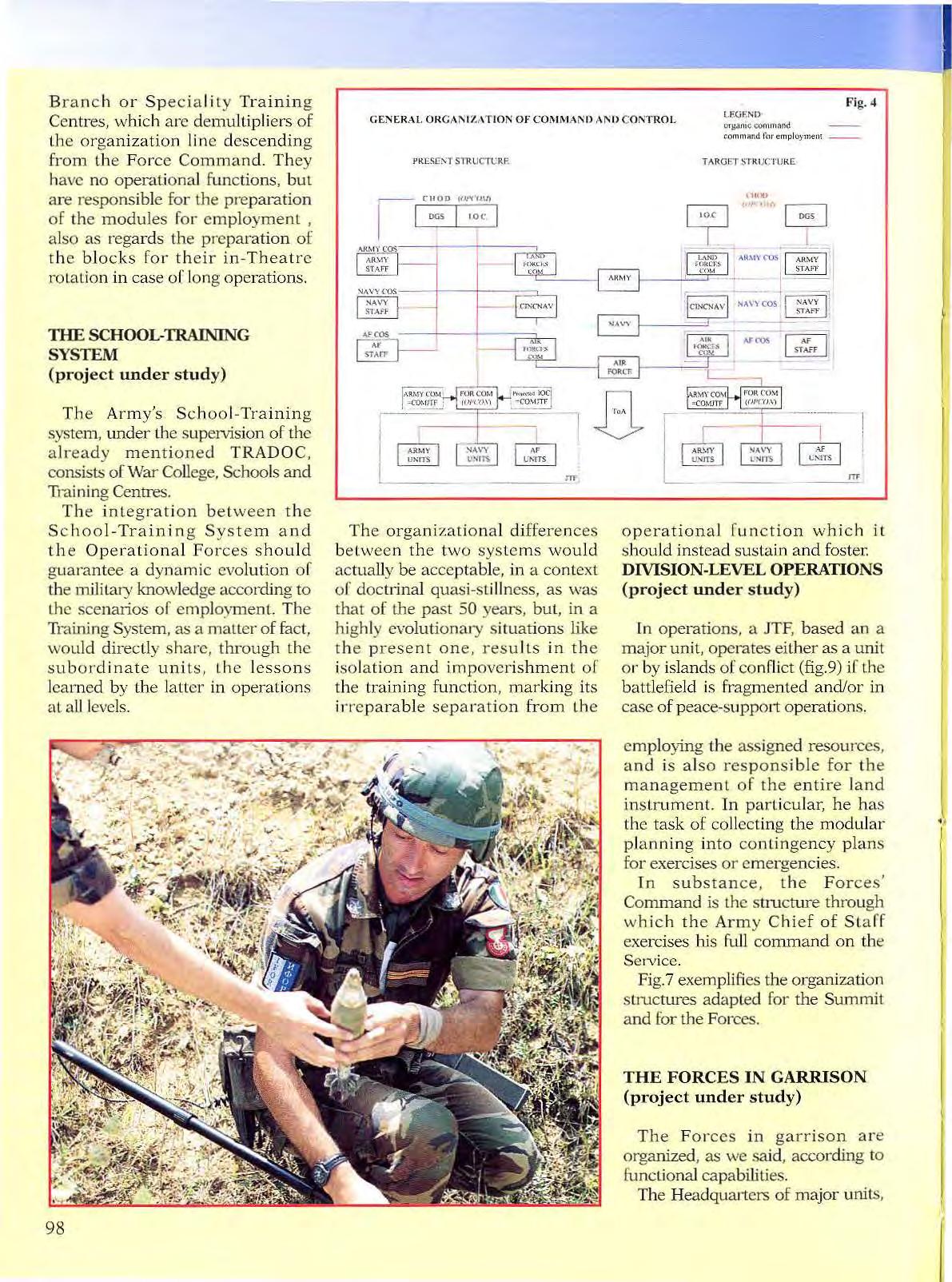
THE FORCES IN GARRISON (project und er st udy)
The F orces i n garr ison are organized, as we said, according to funct ional capabilities.
The Headqu a rters of major units,
98
4 LF.GF.NI) GENER-\L Of CONTROL o•'iJ•me I CI-IOD (OP('I).tl) I I DGS I 10(" I
Fig.
commar.d fol' empiOyment -TA RGFT ST RI) (:T lJ RE fTf
variable - geom et ry form a tions cap a ble of conducting opera t ions in a ll t h e envisioned scenatios:
• consist of th e Stalls only, organized i n to mo d ules and relevant co mmand and control systems, programm ed for employme nt in sim ulation p atterns;
• have no subordinate forces of their own, they take charge of the forces at the moment of the nati onal ToA in operations o r exercises;
• can set up the CO MFOR of a JTF co ns isting mostly of land forces, possibly combined, working e ither as a un it or d etaching th eir own modules to d1e Headquart ers of s ubordinat e un i ts or to the COMF OR of ano the r Nation, with a framework r o le, or o f ano ther S erv ice in cases of pre vai l in gly ma ritim e or a ir missions (or operation ph ases).
T he Headqu arte rs of the majo r units are subordinate to the Comma nd of the Forces. Their training at staff level is planned an d coo rdinated by the Cent re for Doctrine and Train ing (TRADOCtypc organization), on the basis of the special directives issued by the S u mmi t of the Service.
Th e modul a rity of the organizat ion structu re of the land instru me nt could be fully implemented by the year 2010. This is o ne o f th e most imp orta n t consequences of th e application of the pri ncipl es exp ound ed, a nd marks the final overcoming of the logic based on t h e conce p t of CapabilHy Pa ckages organi zed by n-1ac ro-miss ions (Proj ect ion,
Reaction, Con trol o( the Tenitory)
The tra nsiti on to the concept of multipurpose formations, fully suited to fit into a network stru cture, closes also the era of th e maj or units with a pre-const ituted organi za tion, by bra nc h and spec iality (Alpi ni , B ersaglieri , Reconnaissance, Almom; Mechanized etc.). Bnmches and specialities, as a matter of fact, will charactelize only the func tional compo nents, an d will find th e ir place at a level comparable to that of today's Regim ents.
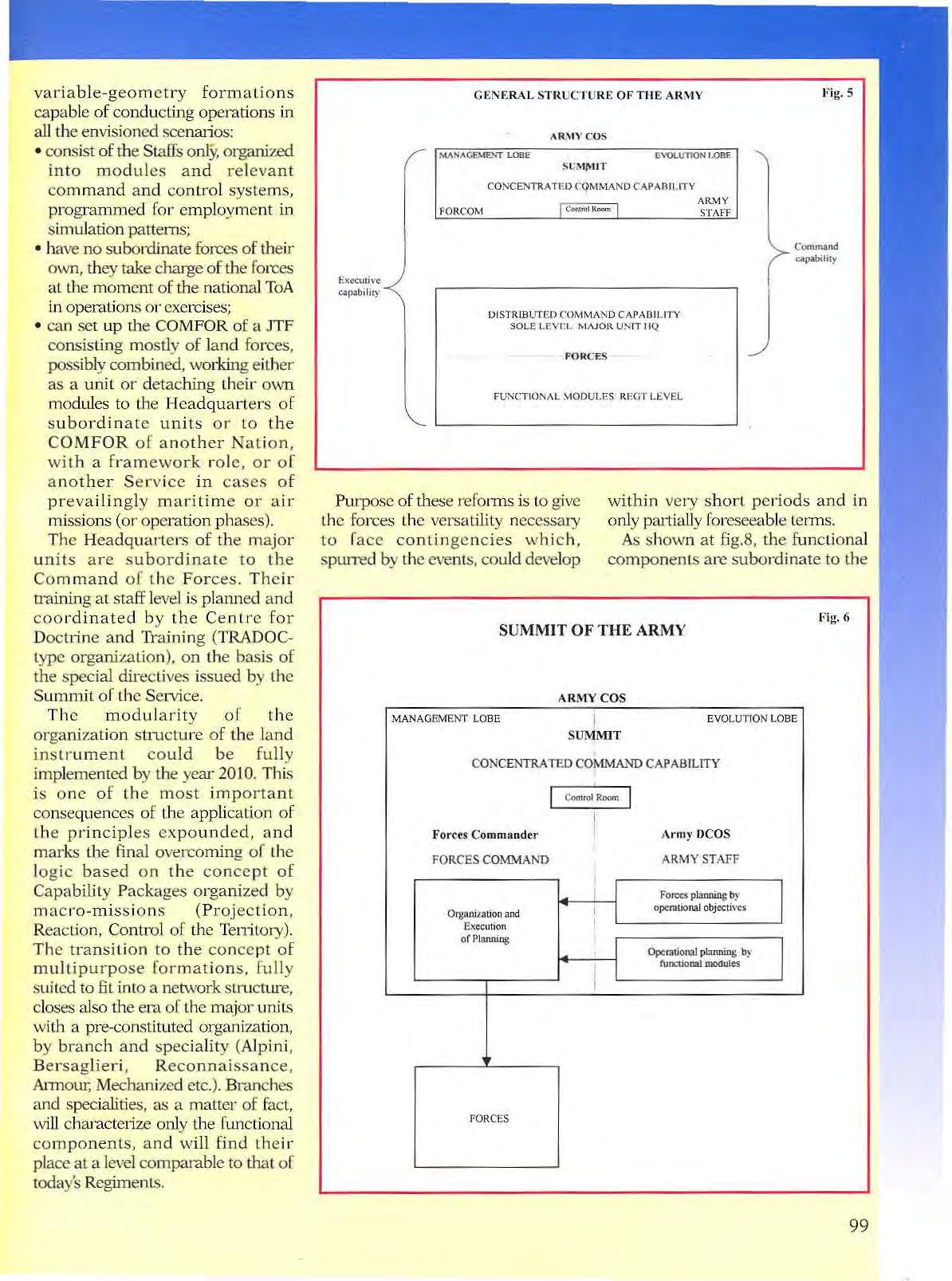
Purpose of thes e re forms is to give the fo rces the versatility necessary to face contingencies which, spl.llTed by t he events, could develop
with
Jshort pe r iods and in only partially foreseeab le terms.
As
at fig.8, the functional componenls are subordinate to the
IExecutive ) GENF. R AL STRUCTURE OF TilE ARMY COS EVOI.UllO N l.ORE CONCENTRATf.D ('QMMAND CAPAOII, ITY Alt,\1Y FORCOM I c.,,,,,., I STAFF OISTRIBUTI'.I) COM MA ND CAPABIL ITY SOLE L E V E L MAJOR U:--IIT FORC£S FUNCTIONAL YIODULE S RE(;T LE VEL
F ig. 5 C om;Hand capability
in ve ry
OF THE ARMY Fig. 6 ARMY COS MANAG EMENT LOBE ! EVOLUTION LOBE suJMIT CON CENTRAT ED COMMA1'ID CAP ABILITY
Control Room I
es Co mma n der ! Army DCOS FORCES COMMAND ARMY STAFF
s ho\\rn
SUMMIT
I
Forc
plannil\g
I Organiza tion and I operational objectives Execution of Pl:mning
l Operational planning by I tunctiooal ll\O<Iutes i FORCES 99
I Forces
by
I
ARMYSTAI'II
A.r-.,1)) CAPADILI'nf.S
terminal of t h e supporting C4I System , of a complete replic a of the Commander's software and hardw are , w ith rea l- time net upd ating (availa bili ty of information);
• conduct of in tegra ted operations carri ed out by the mast er (atnibution of control), coinciding wi t h the Commander 's suppo n section, located at the terminal of th e island most exposed to the manoeuvre (reve rsibility ) The concept o utlin ed , vvhich at present i s only a t h eore tical referen ce model , to be closely examined and tes ted , should offe r the followin g main advantages;
Particula rl y, in the latter instan ce, each is lan d o f' co ntlict is assigned a task for ce s uited, for quali ty and quantity, to the s pecific tasks.
Th e task force Hq. of each island consists of a major un it module, detached from the major unit H q , one o r more basic- branch regt Hq. modu !es and one or more modules of tactical -s upport regt Headqu mters.
COMFOR, i.e. t he majo r unit Hq., operates according Lo the concept of the network command capabilit y, which envisages:
• su bdh·ision of the Comman d into a se ction in support. to the Commander and in severa l comple te modu les (i.e. Gl, G2 , G3 , G4 etc. );
• establishment of a s ing l e Command Post, spread on the territory - since it s var ious models are lo cated in each island, togethe r with th e taskforce Commanders - but virtually integrated into an l NT RAN ETtype network (ub iquity);
• availab ilit y, at eac h i s l an d-
• ensure the high es t probability of survival to COM FOR , withou t having to provide for substitute Comm a nds. The command-andcontrol capabili ty in operations is a p1imary reso urce for success, and th e r efore represents a critical vulnerability, espec ially in a context suc h as the present, charac teri ze d by grow ing risks in the C2 warfare secto r;
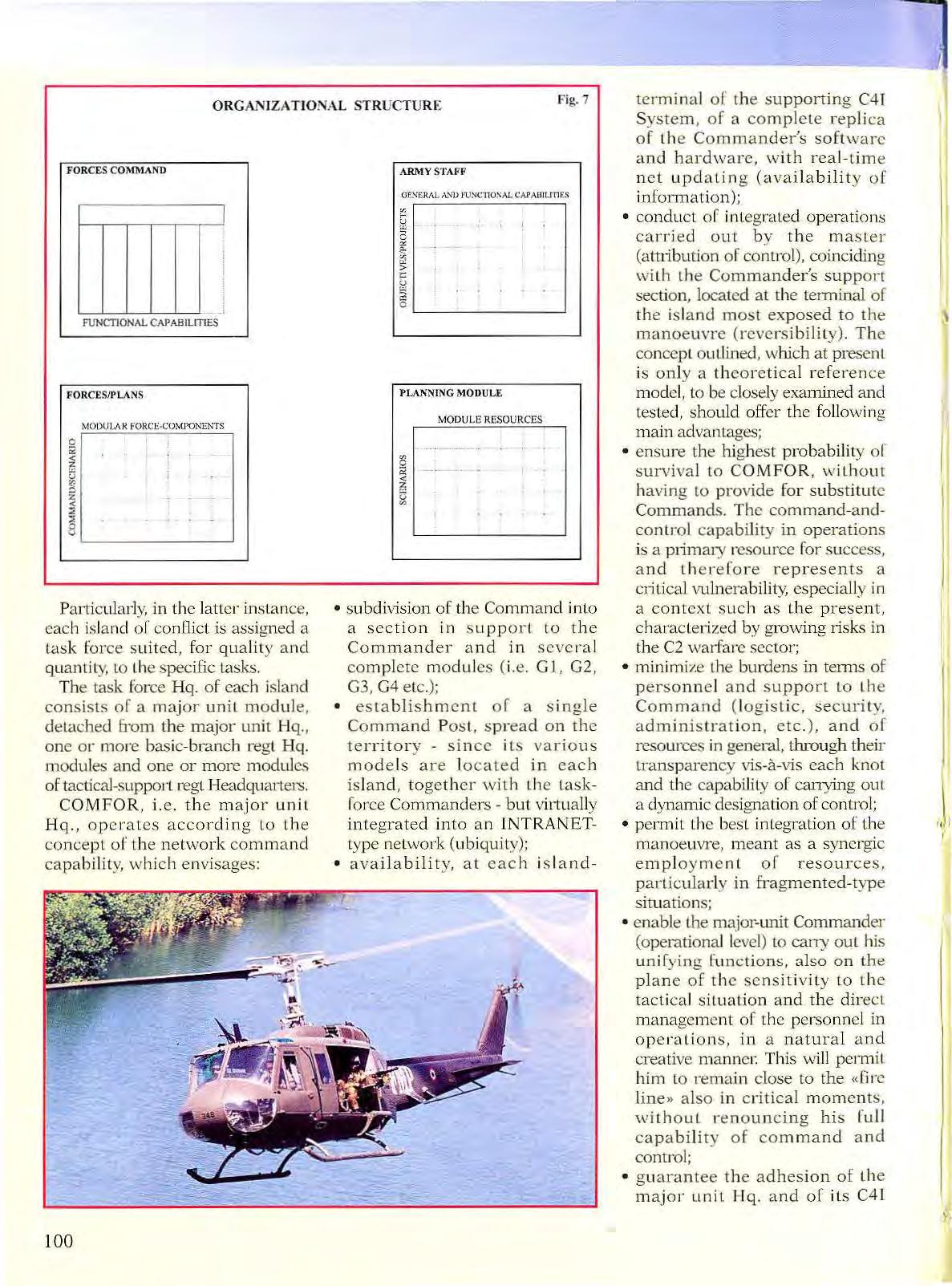
• minimize Lbe bw·dens in terms of personn e l and support to th e Comm and ( lo gist i c, security, administrat i on, etc.), and of resources in ge neral, through their transparency vis-a -vis each knot and the capability of amying oul a dynamic d esignation of control;
• permi t the bes t integration of the rn.anoeuvre, mea nt as a synergic emp l oyment of resources, particula rl y in fragmente d-type sin1ations;
• enable the major-unit Commander (operatio nal level) to carry out his unifying functions, also on the plane of the se nsit ivity to the tact ica l situatio n and the dire ct mana geme n t of the personnel i n operati ons, in a natural and creative This w ill permit h im to remain close to the «fire line» also in c ritical moments, \vithout renouncing his full capability of com mand and control;
• guaran tee the adhes ion of th e major unit llq. and o[ it s C4l
j I
ORGAN I ZATIONAL ST RUCTURE Fi g 7 FORC£S COMMAND I
FUNCTIONAL CAPABILITIES
FORCE Sil'lANS
100
c
PL'<N NfNG MO DULE
MODU l.E RESOURCES
capabilities to all subordinate units, also dming the conduct phase; • sustain the integratiQn of forces from other Nations into the f ramework major unit, thanks to the detachment of the mentioned cornmand modules
LOGISTICS
(projectpartiallyrealized,akeady discussed more exhaustively in a previous article)
In the last ye.u; especially after the most recent operational experiences, Logistics has gone through a signi f:icant streamlining process.
The reference logistic concept, approved at the end of 1997 , and novv on the way to a gradual implementation, marks the transition to a modular logistics, resolute ly oriented towards the projection and support of forces in operations outside the borders. It is cenb:ed or1 the preventive planning and development of activities, conducted by centralized organizations, organically subordinate to a technical command-system, but under the operational control of the Commanders of the tactical formations supported.

In particular, the concept envisages the reorganization of the resources available according to the Great Base model, destined to support the projection of the Forces outside the borders, and their sustenance in peace -support and crisis-management operations, as well as to establish the interface structm e between Support Logistics - which operates on the national territory m1der the responsibility of the Logistic Inspector - and the inTheatre Acll1erence Lof,ristics, which is in the sphere of the Force Com1nande1:
Initially the Great Base would have an essentially «virtual» having been realized through the concentration of resources and capabilities which were formerly spread over a large area of southem Italy. Later on it
could also assume a physical form, in order to exploit to the utmost the savings deriving from the cenLrali7.ation of materials and assets and to optimize the performance of the support units. Another cornerstone of the concept is the peculiar Command and Control Organization, which is the real essence of the working mechanisms of the Great Base and of the Adherence Logistics in the Operations Zone. This organization permits to centralize control and to manage resources and capabilities, as well as prepare a rational Programme of Logistic Activities, centred on the logistic responsibility
of the Command above the one which conducts the in - Theatre operations - a completely new interpretation of the «home delivery>> logistics - as well as on the development of essentially preventive interventions.
Finally, the specialization of the Logistic Organizations permits to effectively deal with the complexity of the Support organization and the cost of its deployment, through a mar·kecl professionalism of the men and units entrusted w .ith the operation of logistics at all levels.
The reference logistic-concept enables the Service to take on, if necessary, the role of lead Nation
Maj Unit X X X X X D LU DD D TRAINING COMMAKDSICENTRI!S IJ( Ill 1 111 Ill
IN-GARR ISON FORCES
101
for'the management of the logistic activities, among o t her Countries involved in a multi.nat iona .l operation.
0 .(ganic logistic assets , very limited in size, are allocated only at regiment level. Jhe executive logistic organizations of the Adherence r.ogistics are concentrated at majorunit level, ' V.1d organized by specialistic modules, (maintenance, transport, etc.), \vhicp can be assembled into task forces and are capab\_e of iJ;ltegraUp g the r;nodular elements released by the SupportLogistics organjzations.

Support, on the national t erritory, is provided by a limited number of «Supporb> logistic formations, joined jn multifunctional organizations and specialized centres with area! responsibilities, integrated through a fully computerized Command 'md Control system.
The outline of logistics in
operations, marked by high flexibility and dynamism, reflects the featuFes of f ragmented
operations. It envisages:
• transparency and visibility of the available and necessary logistic resources and capabilities - from the Home Country to the engagement areas - which are prerequisites for the highest efficiency of the support;
• tactical mobility higher than logistic mobility, which means relieving the forces of the burden and attrition derived from dragging along their ovm support;
• dynamic planning of meeting points between forces and supports, in reconditioning islands - variable and flexible according to the situation - where activities of resupplying, replacement of unserviceable materials , reconfiguration of forces, etc. are canied out with field equipment.
• close-net, real-time centralized control of the «islands» (location of the assets), and of the forces (where the requirements are).
Islands and forces are continuously moving and mutually transparent: the centralized control is necessary in order to be able to plan «On the roach> the site of the meeting point and the activitv to be conducted within it, at;tomatically and
FORCES IN OPERATIONS AREA OF RESPONSmiLITY Co,IJ)Icr Atc:l 1 Maj. U nit HQ D istributed capability operation Fig. 9 AREA OF RESPONSIBILITY
MANAGEMENT OF THE RESOURCES I•ig. 10
j I I J IM.l,lA;U I I "l!:ANj; J I ME.'.:S $:'- 1 I"'"'' 11 SUPPORT ADHERENCE GREAT-BASE/ ADRERRNCE.M!I.NAGF.MENT Ul\'TI 'r"'"'""""'' I $'1',\'I'JON:l I "''' I '!'RA!"'"' l>cilT:i HCt.J31);(; lJNmi AIRPCKTS MN VIIMI\ AREA$ j[QJ !miD I CaJ I I 11al [EJ] LED [8] [OIDJ I Ell im ! u l ©J LbLI I E:J I I [[ill] [@]] t al r OHALcntl []§] E§D [Ell I [ffi] [ill] b'.'l... 1:0] [GJ 1:0] i[TI]] I irn;m o:m [El] o:w JeAA.R.U"..stl I MATIIP..J I [EjJ B 11.....=·1 ; ,_, I I i l ldA UL l 1 OBlli IA! R( t\AfT f I IEJ 1k \X':f, , I W.1nl J mm 1 ....,.......1 I 6 ..CWJ '---- '---- '----
effici ently, at the mom en t o f a me etin g that , to avoid b ec o ming an occasion of vulnerability, mus t necessarily be «swi ft and secret>>
Fig 10 a nd 1 1 sho w the schep 1es of the n e t structures co n side red fo r resou rce management, respect ively within the Great Bas e a nd t he log i s t ic organi zatio ns o f the inTheatre Adherence, and for the use/employment of t he reso urces in the Ope ration s Zone
CON CLUS IONS
In conclusion, the result s of th e studies and researches conducted so far have led t o the co nviction that to run aft er scen ario s marke d by repeated and not always foreseeable cha nges is neith er productive nor co mp atib le wi t h t h e in stitu tio na l rea lit y of the Army I t wou ld b e nec essary to invert the o rder of causality of the capability-scenarios, but this is a hyp othetical prerogat ive of the political leve l o nly.
On the part of the military, es pecially when resow-ces are scarce, it is necessary to concentrate on the core-capab ili ty, consis ting of t h e a bil it y to promp t ly ad ap t the instrumen t's confi g uration to the cha n g ing requirements, w i t h the
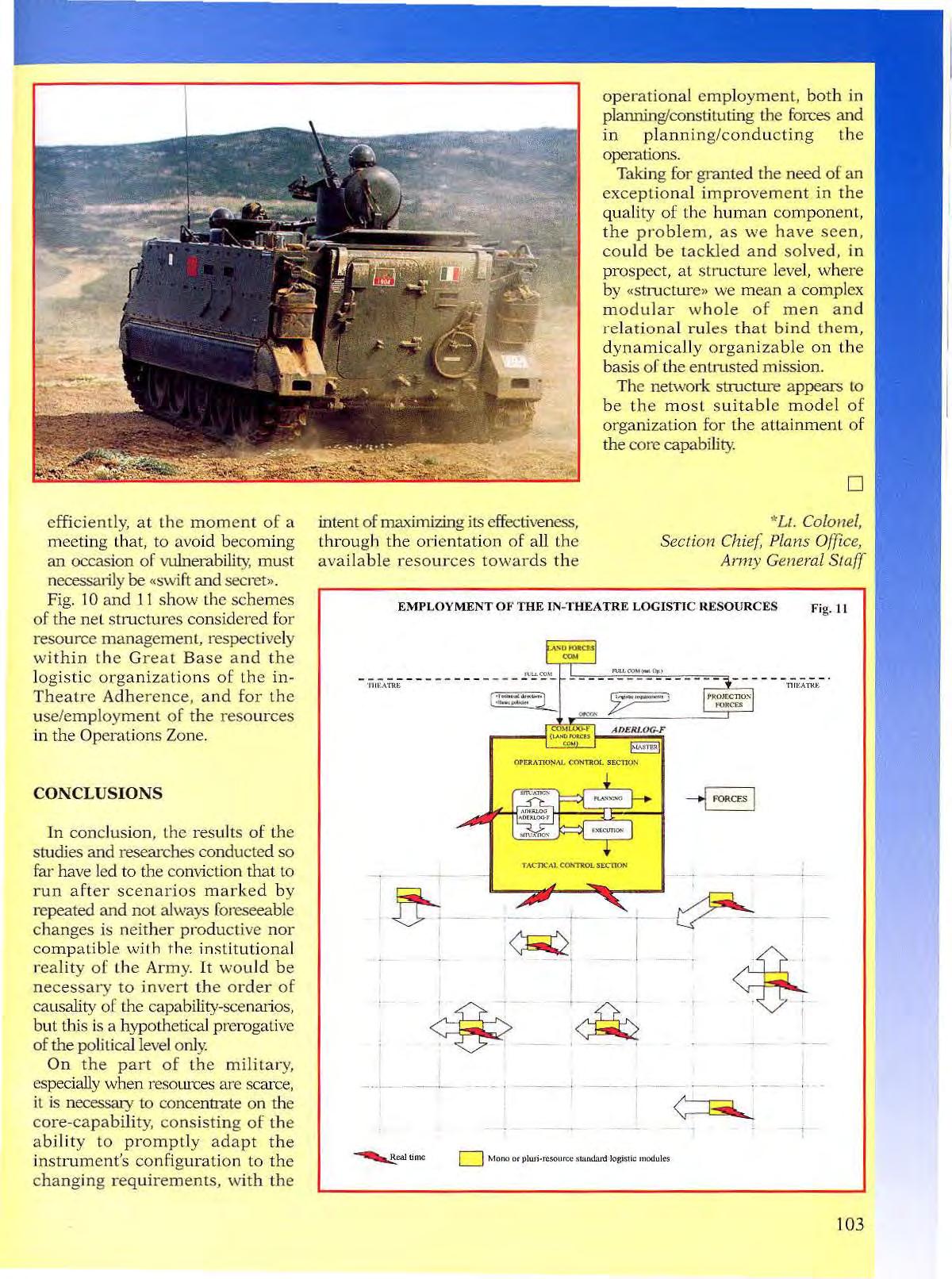
inten t of maximizing its effectiveness, th roug h t he or ie nta ti on of a ll th e available resource s tow ar ds th e
ope•·ational employm ent, both in planning/constitu ting the forces and in ela n nin g/c ond u cti ng the operatio ns.
Taki ng fo r granted the need o£ an exceptional improvement in the qu ality of t he h u m an co m pon e nt, the prob lem , as we hav e seen, could be ta ckled and s.9lved, i p rosp ect, a t s t r ucture le vel. where by «Structure >> we mean a comp lex m odular w hole of men an d rela tio nal rul es that bind them, d ynamic a l ly organ i za ble on the basis o f the entrusted mission.
The net\·Vork structure appears to b e t}1e mo st s u i t ab le m o del of organization for the attainm ent <;>f the core capability
Col011.el, S ecti on Chief, Plans Offi ce, Army Ge11.eral St aff
• •
EMPL O YMENT OF T HE I N-THEA T R E LOGISTI C RES OURCES Fi g. 11 t\.!; ;.("()\l - -- -- -- --- - -- --- - -- -( ' ONTROL S EC'IlOl'\ I _, D Mono t>r plwi -rcsource s &uc\dard Jogistic modules --
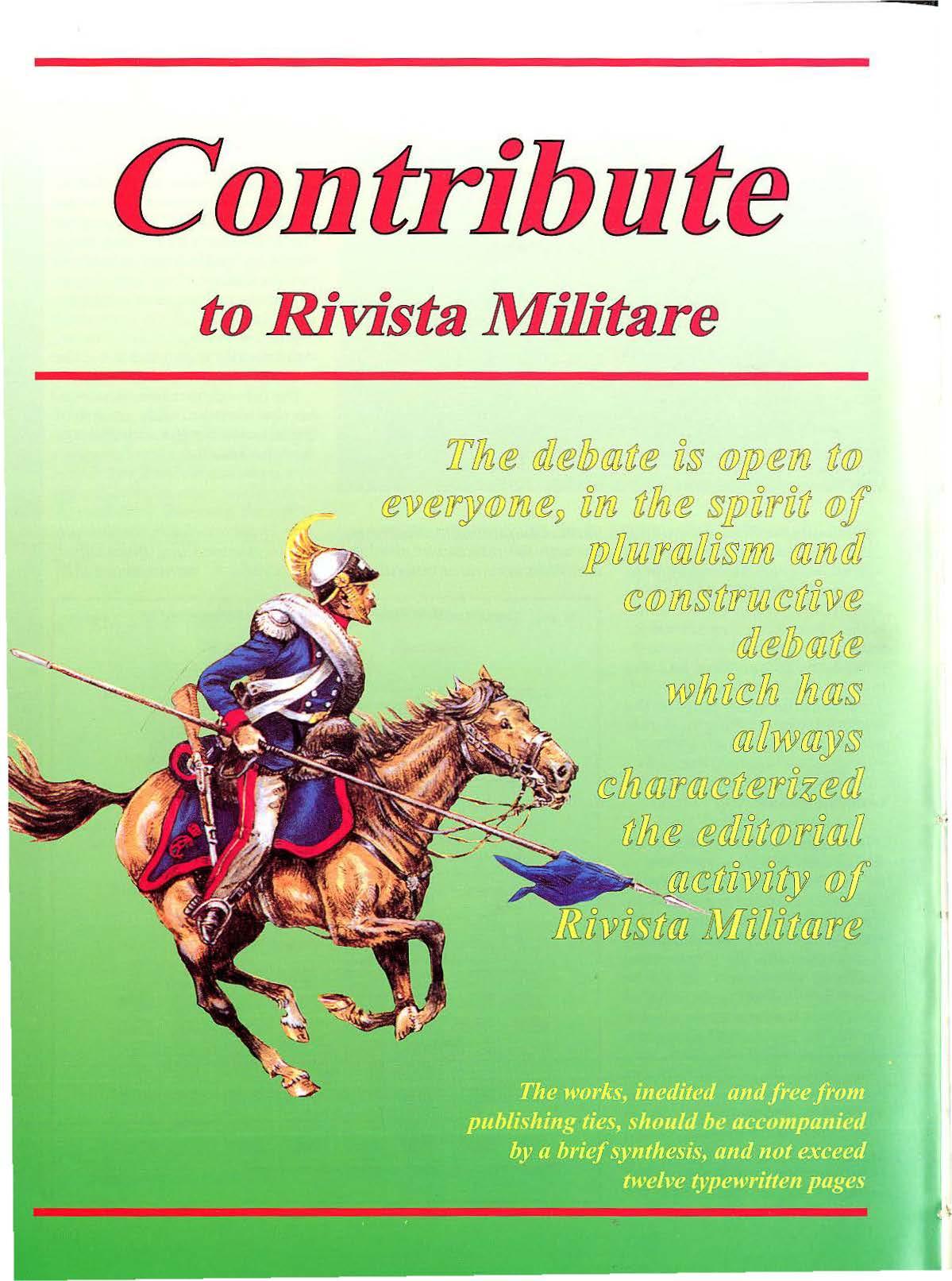
on
/ I Jr!k cdlce!b @J arE iJ§ ,@)[OJ (EllfJ rt@ .;.._,. nw rllkrE §JjJJflrtflll @ I 17JJ 2[/)) !!(!}] Ea§[f!!J (fjJ l11 dl COJ l1fJ § (/J! 1!lJ CC (J ff T t cPJ d1& !!» &J are , T7L"l o TZ !! TX9lf!J !J 0:L.ffJ Lt!J (J[J (!}]!}lKY@JJl§ cc llrJ @J rt@J re rrfJzrt riJ rl!fare ' 1
tribute to Rivista MiHtare
SOMMAIRE INHALT RESUMEN
La nouvell e OTAN, par Vittorio Barbati (p. 2).
Da ns la p erspective d'un u l ler ie ur elargisseme nt d e J' OTAN vers !'Est, l'Aut e u r ana lyse les facteurs principales qu e pourront causer un e compl e te r efon cl ation de !'Alli a n ce: n:!gime politiq u e, ressou rces, co ll ocation geostrategique, programmes militaires, capac it c de l'in dus Lt ie, niveau de recherche pure et de recherche app l iquee, r o le de !'Europ e Unie . CeL arti cle termine avec une comparaison parallele entre le potentiel militaire d es Etats -Unis et d e !'Europe en cours de standardisation
Norvege. La n o uvelle Arm ee de Terre. Interview avec l e Majeur-General Sverre 0kland, par Emico Mag n a ni (p. 10).
De 1993l'Arrn ee de T erre nm-ve gienne a subi un e reduction du 50% en termes de force e t d'unit es . On compte de r6du ire aussi les rrai s ord in a ires d' enlrel.ien en l"a veur d e n o uv ea ux p rogrammes d'inves tisseme nts. Les experiences dans le domaine de l'OTAN ont produit de determinant es innov at ions p o ur ce qui concerne !'orga ni sa tion , !'in s tru c ti on, les moyens et la doctr ine m ilita ir e. La Norvege ne renoncera pas a u se1-vic e ob ligato ire pour ses ciroyc n s masculins ayants entre 19 Cl 44 an s (et le service vol ontaire pour l es femmes). Les li e ns avec !'Alliance Allantique et la stricte collaboration avec les Etats-Unis, le Ro ya u me-Un i , l'Hollande, l'Allema gne et les Pays scandinaves reslanls inc h anges .
Danemark. La nouvelle Annee de
Terre. Entrevue au General Cluistian Hvidt, par Enrico (p. 18). l'Annee de Terre danoise , la premiere a faire partie d' u n Corps d'Armee intemationale, a en cours une profonde transformation qu'on achevera en On co nservera le service e t !'o rgan isa t ion d es ri servistes que permet d e triple r le personnel aux annes avec le passa ge d e l a te nu e de p a ix a la tenue de campagne. Tous les roles sont ouverts auss i a ux femme s. La Defe nse dan oise peut aussi compte r sur la Gard c N ationale, avec ses 6 000 homm es, tous des vo lontai r es.
Un nouveau ordre in ternational Globalisation et societes multiethniques , par Ornella Rota ( p. 26 ). Des societes multicthniqu es et multiculturelles sont en train de s'affirmer un peu partout clans un planete d irige vers une globa lisa ti on economique et soc ia le . De <;a dcri ve nt d es p r oblemes de tre s grande portcc co n ce rnan ts la sC!rete et la p a ix. Cet article comprend auss i plusieurs fortes tcmoignages dignes de foi de representant s d e deux grandes Nations , qui son t !'expression la p lu s g rand e d e la so ciete multiracial e: les Ambassadeurs des E t ats-Uni s et de l'Ind ie.
La planification operationnelle par Pier Paolo Lunelli (p. 32). Le recours a u jeu d es echecs sert pour expliquer des idees impo r ta n tes telles gue ll es le centre de gra vite, les !ignes operationnelles, les object ifs, les rorces dep]acees («assets»), les conceptions ( «ass umpLions »), la pla nification . Ce t article , le deuxieme de la serie, trace le tableau des i nterconnexions doctlinales existantes p am1i les points d ec is i fs, les phases et les suites operationnclles, la pla n.ifi.ca tion de contingence et le poi nt culminant. Des exemples
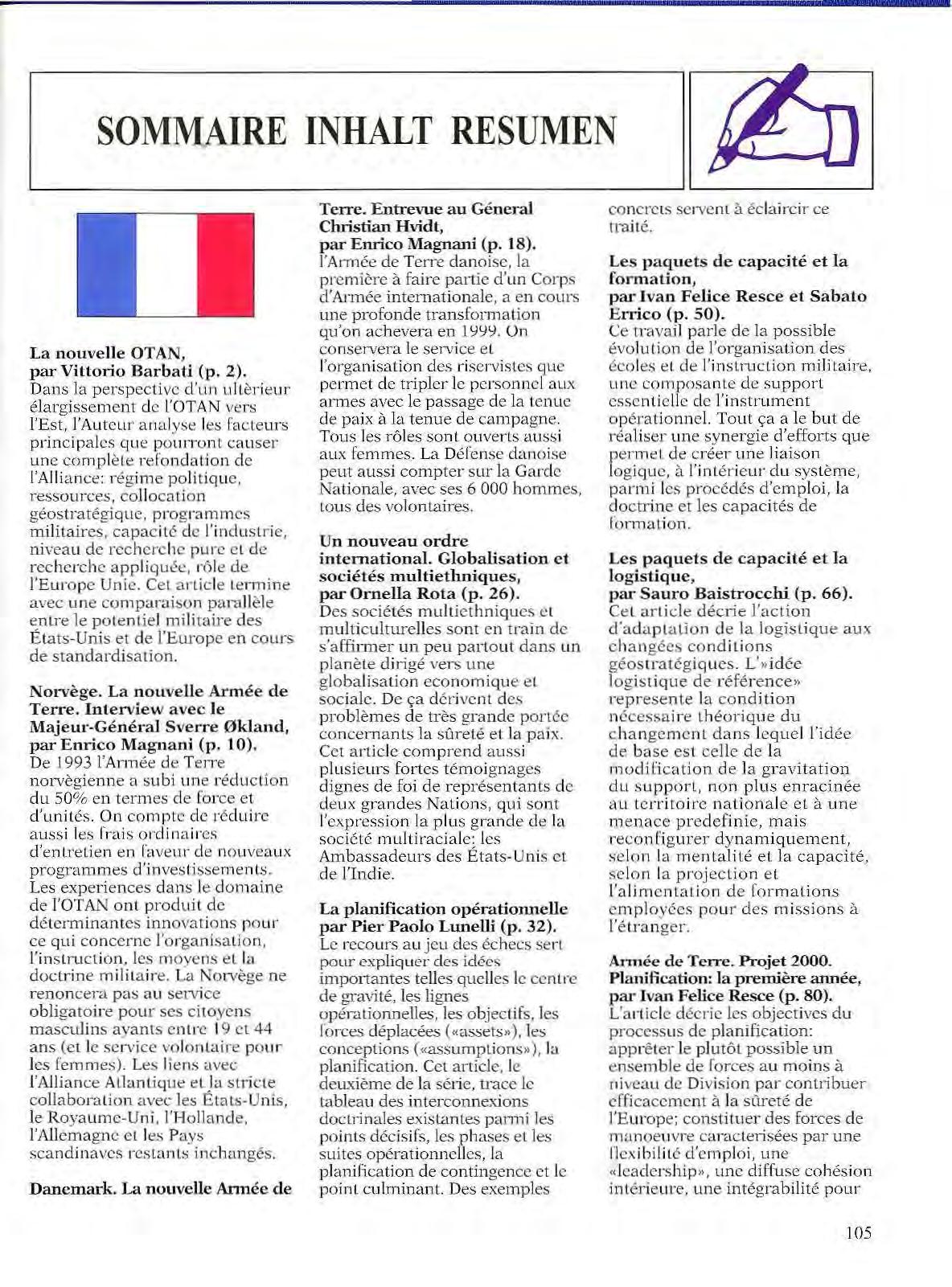
concre ts se rve nt a eclaircir ce n-aite.
Les paquets de capacite et la form atio n , p ar Ivan Felice Resce et Sabato E rrico (p. 50).
Ce travai l p arle de la possible evolu tion de !'organisation des eco les e t de l'instruction militaire, une co rnp osa nl e de s upport essc nt ie ll c de !'instrum e nt operation n e l. Tout ya a le but de rea liser un e syne rgie d'efforts qu e perl11et d e creer une liaison log iqu e, a l' inter ie ur du sy steme, parmi lcs precedes d'emploi , la doctr in e e t les capacites de format ion.
Les paquets de capacite et la logistique, par Sauro Baistrocchi ( p. 66 ). Cel article decrie !'action d'adaplalion de la logislique aux changces co nditions geos trat6 gig u es . L'» id ec logistique de r efere nce » represente l a co ndition n ecessai r e theorique du c h a n ge ment clans lcque l !'idee d e b ase es t celle de l a modification de la gravitation clu sup port, non plus enraci nee au tcrrito ir e na tional e e t a un e menace predefi nie, mais r econfi gurer dynamiquement, se lo n la n1enta li te et la capacite, sc ion la proj ec tion e t l' a lim e ntation de format ion s e mp loyees po u r des mi ss ions a l'e tranger.
Annee de Terre. Projet 2000. P l ani6cation: la premiere annee, p ar I van Felice Resce (p. 80) L'a t·t icle dccrie les objectives du processus de planification : app r e t er le p lutOt possible u n ensemble de forces a u mo ins a niveau de Division par contribuer cfficaccme n t a la surete de !'E urope; constituer des forces de manoeu vre cara cte lisees par une d'emploi , une «leaders hip », une diffuse cohes io n interie ur e, un e integrabili t e po u r
105
cc qui conceme le.s .sy.s t emes d'operation q u e constituent la «task force >> p o u r l'emploi; re nd re pl u s e ffic a ce les unites d'exploration, l'A r till er ie e t le Genie; r endre plus p u issa nt e la logyst iq u e de p r otection. Il est u n projct amb it ie u x qu'on peut realiser da n s le 2000.
ligne d'evolution d es paquets de capacites. Les panoramas d' e mploi apres I'an 2010, par Sauro Baistrocchi (p. 92). L'article trac e u n tableau, e n donnent aussi des hypotheses d e panoramas d'apres l' an 2000, de quelq uc poss i ble directrice d'appro fondi ssement pou r le deve loppement d es forces de terre n at io nal es. Le proj et, e n consi d e rent les n ombrc u ses disponib ilites d es resso urces, est centre sur les soi-d isantes «s u per capacites», qui consistent en la possib ilite d'adapter la configu ra tion de !'instrument milita ire aux ex igences ch<mgeantes.
SOMMAIRE INHALT RESUMEN
angewandten Forschung sowie d ie R olle des Yere inten Europa Die Arb ei t fi ndet ihre n Ab schluE in ei ne r Gegen i.iberstell ung d es mili Uirischen P otentials der Vc r e ini g ten Staaten u nd dem sich i n e inem
befindlichen Potential Europas.
Norwegen. Die Ne u e n Streitkrafte. Intervie w mit Generahnajor Sverre 0kland, von Enrico Magnani. (s. 10). Seit 199 3 s ind die norweg isc hen Strcitkrafte u rn 50% reduzi ert warden, und zwar sowohl die Mannstarke als auch die Einheiten. E s ist beabsic hti gt, auch d ie or d entlichen u nd di e In s ta ndset z ungsausgaben z u g unst e n n e u er Investit ions programme zu reduzieren. Die Erfahrungen im Bereich der NATO habe n zu en tsche iclenden In novati onen im Bereich d e r Organisat io n , der Aus bildung, d er M itt cl und der Do kt r in gefuhrt. Norweg en w ird nicht a uf di e Wc h rpfl ich t fiir seine mannl ichen Staatsbilrger zwischen 19 und 44 Jahren verzichten; Frauen ist ein freiwillig e r Dienst anhcimgestellt. Unverandert b l eiben schlieEli c h d ie Yerbindun gen z.ur at la ntischen All ia n z. so wie die enge Zusammenarbe i t mi t d en USA, d em Vereinigtcn Konigreich, den Niede rl anden, De u tschland und den ska nd inav ischen Landern.
K.t; egszustand ermoglicht, b lcihen crh a l ten.
Allc Laufb ah nen stehen auch den Fra u e n offe n. Di e da ni sche Verteidigun g kann im i.ibrige n a uf d ie 6000 Fr ehvillige zahlenclc Nat ion a lgard e zunickgreifen.
E ine neuen We ltordnung. Globalisierung und rnultiethnische Gesellschaften, von Omella Rota (s. 26).

O bcrall auf u nserem Planeten, der a uf dem W ege einer o k onomischen und soz ial en Globalis ierung ist, entstehen pluriethni sche und multikul turelle Gesellschaften. Daraus leitet sich e ine Problematik crheb li c h e n Au s maEes ab , die de n T h e menbereich Sic h e rheit u n d Frieden b etreffen. Den Artikel bcrcichern aussagekraftige Zeugnisse von hochsteh enden Reprase n tanten zwcier Nation.en , di e sel bst I nb egriff mul t irass isc h e r Gesellschaftcn s in cl: es s ind di e Botsc hafter der Vere ini gte n Staaten und Indiens.
Operative Planung (2 . Teil), von Pier Paolo L unelli (s. 32). Der Rtickgliff auf das Schac hspic l clien t dazu, wi ch tige B egriffe vvie das Gravita tionszen trum, die Strat eg ie n , die Ziele, di e verte il ten Kra fte (a ssets), die Konzepte (assump tions) sowic die Planu ng zu erklaren.
Die neue NATO, von Vittorio Ba1·ba ti (s. 2). Anges i c h t s einer weitcrcn NATO- Osterweiterung werd e n die wichtigsten Faktoren unte r sucht, die sozusage n zu einer rad i kalen Neugri.in dun g der All i a n z f i.i h ren konnen Dies betri fft das politi sche Sys tem , d ie Res sourcen, d ie geos u·ategi.s c h e Einord n u ng, M iliUi.rprog r amme, industri e lle Ka p azitat, Nivea u dcr Grundlagen -u n d de r
Danemark. Das neue Heer. b1terview mit General Christian Hvidt, von Enrico Magnani. (s. 18). Die danisc h en S t reitkrafte, die als ers te Teil eines intcrnationalen Verband es waren, befinden sich in einem tiefen Tra n s fonnatio nsprozeg, der 1999 sci n c n vorlaufi gen Abschlu() find en soU. W e hrpfl icht unci R eserve, die die Ver dreif achung der Zahl an Personen unter Waffen beim Obergang vom Ft;edens- zu m
Dieser zweite Teil des Aufs a t zes ze igt die th eoretische n Zu s amme n ha nge z wi s chen d e n au sschlagge bendcn Punkten au f, sowie die o perativen Ph a sen u nd deren R eihenfolge, die jeweils anzuwendende P lanung u nd den Hohep unkt.
Einige konkrctc Bcispicle di enen zur Klarung der Ab ha ndlung.
«Hihigkeitspa k e te » und Ausbildung, von Ivan Felice Resce und Saba to Errico (s. SO) Die Arbei t erlautert die moglic h e Entwicklung der militarisc h en
106
I'
SOMMAIRE INHALT RESUMEN
schu l- und Organisation, einer grundlegenden Komponente operativer Mittcl. Das Ziel ist es, eine Syncrgie aller Bestrebungen zu erreichen, die eine log ische Verbindung innerhalb des S ystems den Verfahn::u d er Anwendung, der Lehre und der Ausbildunghlhigkeiten schaff t.
«Fahigkeitspakete» und L ogis tik, von Sauro Baistrocchi (s. 66). Der Artikel beschreibt die Anpassung der Logistik an die veranderlen geostra tegischen Verhaltnissc. Das «logi stische Bczugskonzept» stellt die theoretische Voraussctzung des Wand e ls dar, in der die Grundid cc darin besteht, den Sch wcrpunkt der Untersti.itzungselemente (support) zu moclifizieren, d ie nun nich t mehr auf das eigene T erritorium beschra nkt und gegcn eine vorher bestimmbare Bed rohung gerich tet sind. Vielmehr wcrden sie, was MentalitiH und Kapazitat betrifft, fi.ir die Projektien.mg und die Unterhaltung van Formationen , die «out o f border» operieren , in dynam isc h c r Weise ne u gegliedcrt.
Das H eer - Projekt 2000. Planungsjabr, van lvan Felice Resce (s. 80). Dieser Aufsatz beschre ibt die Zi elvorgaben des Planungsprozesses, und zwar: mitte lflistig einen Verband mind estens von Divisionsstiirke bereitzustelle n, urn wirkungsvoll zur europaischen Siche r heit beitragen zu konne n; Manoverk.rafte zu schaffen, die sich durch n cx ible Einsa tzbcrei tschaft, (leadership ), dw·ch einc wcit vcrbre itete innere Kohasion ausz.eichnen, sowie durch die Fahigkeit , s ich im Rahm en dcr operativen Systeme, aus denen di e Einsatzbereitschaft
(task force) besteht, zu integ rieren; die Effektivitat von Aufklarung, Artillelie w1d Pioni erkraften zu erho hen; die zugehorige Logistik deutlich zu verstarken. Es handelt sich urn ein ehrgeiziges Projekt, das aber his zum Jahr 2000 verwirklicht werden kann .
Entwickl ungslinien der «Fahigkeitspakete ». Szenarien fur ilrre Anwendung nach 2010, von Sauro Baistrocchi (s . 92). In d iese m Aufsatz werd e n ei nigc mogliche Haup tentwicklungs linien der nationalen Landstreitkrafteals hypothetisches Sze nar io nach 2010- vertieft. Angesich ts der heutigen Mittclknappheit wird in diesem Projekt der Schwerpunkt auf die soge nannten «Super-Fah igke itcn>> gclcgt , die in der Moglichkeit b es tehen, die Ko nfigurat.io n des Mi l itars den veranderlich e n Bedingungen anzupas sc n.
Sverre 0kland, de Enrico Magnani (p. 10). Desde 1993 el Ejercito de Norvega ha sido reducido del 50% en termino s de fuer za y de unidad. Se pien sa en reducir tam bien Ios gastos ordinarios y de mantenimicnto pa1·a Ios nuevos pragramas de insumo . Las esperiencias de la OT AN h<m traido a decisivas inovac iones en el campo d e l a organizaci6n, del adiestrami ento, de Ios medios y de la doctrina. La Norvega no renuncian1 a l servicio militar obligatori o para Ios hombres desde Ios 19 hasta Ios 44 anos (servici o vo luntario para las mujeres). Se q u eda n imudados los atad os con la Alianza Atlantica, asf como la arrada colaborac i6n con Ios Estados Un idos, el Rey no Unido, la Holanda, La Ale mania y lo Pai ses Escand in avos.
La nueva OTAN, de Vittorio Barbati (p. 2). Para otro ampliamento hacia Este de la OTAN , se analizan Ios principales factores que podrfan llevar a una definiti va re fondaci6n de la Alianza; regime politico, rccursos, colocaci6n geoes trategica, pro gramas militares , ca pacidad in d u strial, nivel de busca ve rd ad era, ro l de la Europa Unida E l trab ajo d e co ncluye con una comparaci6n entre el potencial m ili tar de Ios Estados Unidos y lo europeo que es ta para estandardizarse.
Norvega. El nu evo E j ercito. Entrevista al Mayor-Gen eral
Danimarca. E l nuevo Ejercito. Entrevista al General Christian Hvidt, de Enrico Magnani (p 18). El E jer cito el primero a tomar parte de un Cuerpo de Armada internacional, tiene en acto una profu n da transformaci6n que se ra terminada e n 1999. Sera conservada cl servicio military la organizaci6n de la rese1·va que consente d e triplicar e l personal alas armas con e l tninsito del aseto de paz a lo de guerra. Todos Ios rol es son ab.iertos tambien a las muj eres La Defensa danes p u ede contar en la Guardi a Nacional, con 6000 hombres, todos volontarios
Un nuevo orden internacional. Gobali zaci6n y sociedades multi et ni cas, de Ornella Rota (p. 26).
P or dogui era se van a afirmar sociedades multie tn icas y multi c ul turales en un planeta que va hacia una globalizaci6n economi ca y soc ial. De esto derivan problcmas de gran
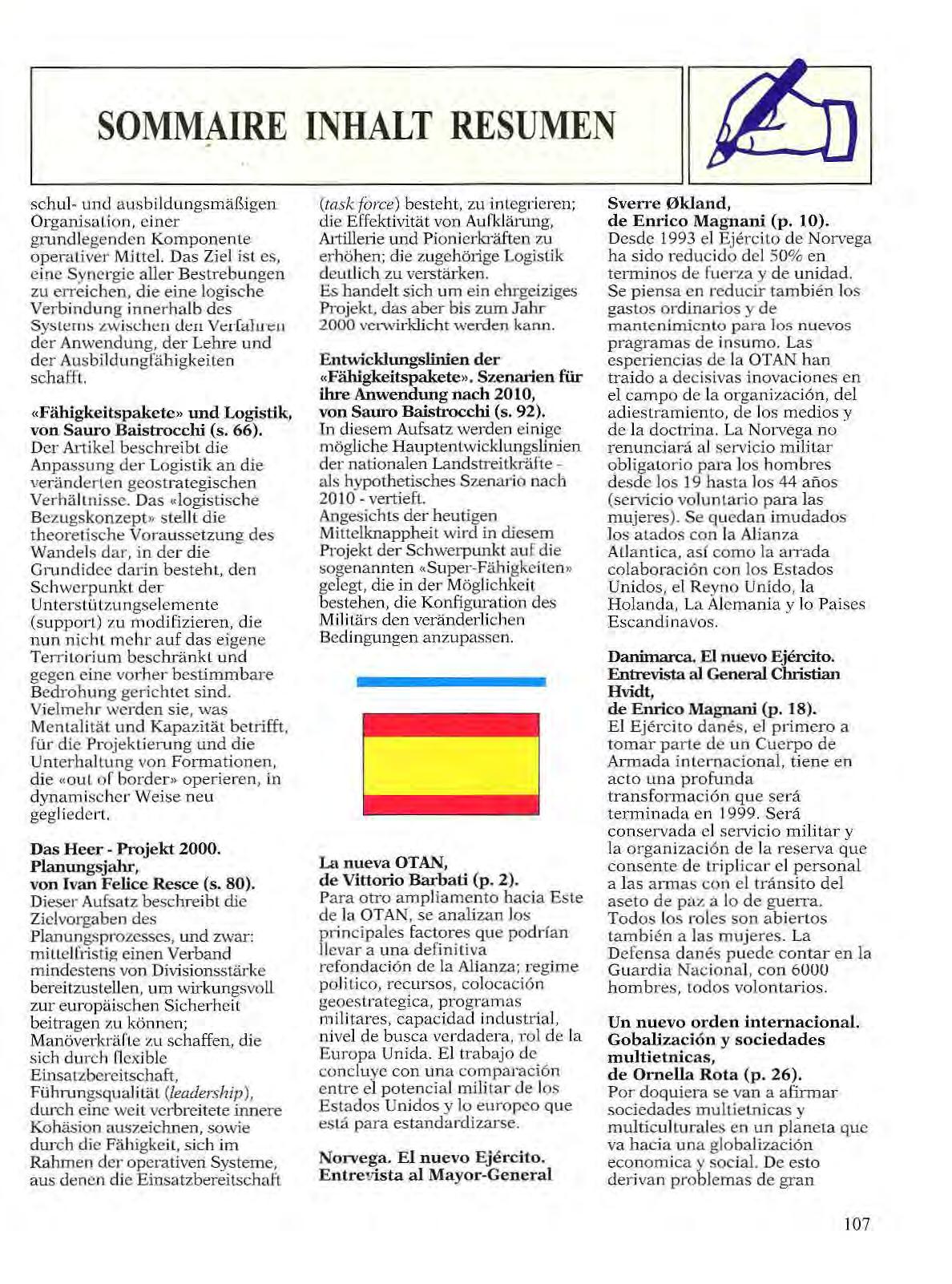
107
magn i tud que inves t on el tema de la sefur id ad y de la p a z E l a rticulo es e nr iq u ec ida d e fu ertes declaracia nes d e i m p artant es representant cs d e dos grand es P a ises qu e so n la max i ma ex p resi6 n d e la sac ieclacl m ulti r ac ial: Ios ambaja d ares de Esta das Un idos y de I n d ia.
La planificaci6n operativa de Pier Paolo Lunelli (p. 32). El recu rso al j uego de ajeclr-ez es necesari o pa r a ex plica r can ceptos impo rtantes como e l c e ntra de gravi d ae!. las lineas operativas, Ios abjet ivos las fuerz a s dispuestas («ass e ts»), I as conce pc iones (« assum p t ions»), la p lani ficaci6n. El articul o, seg undo de la ser ic, traza las in te r ca ne z iones doc t rinal es existe ntes en t r e Ios puntos clefinitivos, las fases y las secu enc i as operativas, la planificaci6n de continge n cia y e l p un t o c u mbre . Algunos ejemplos c oncret o s sirven para acl arar la exp osi c i6n.
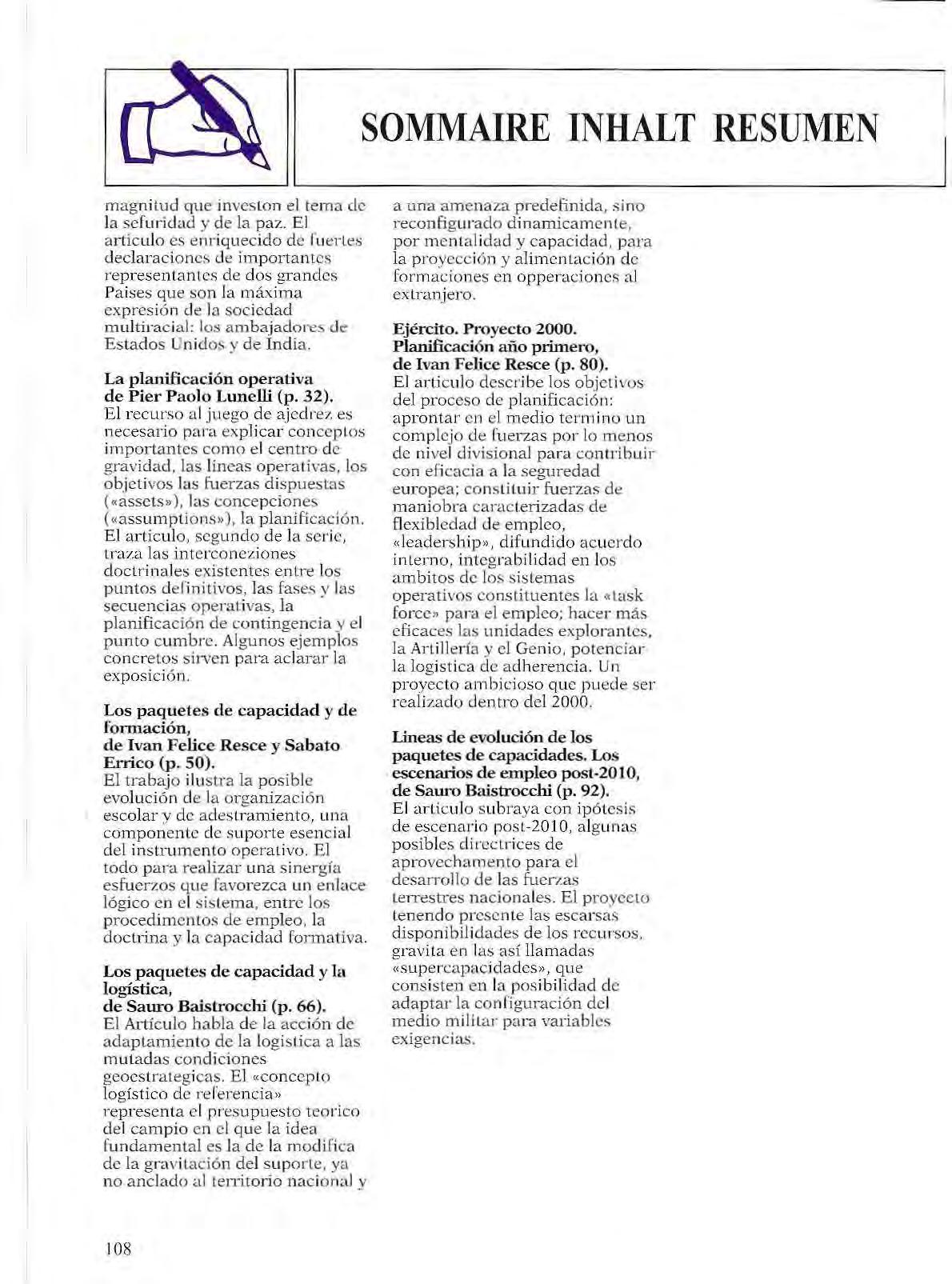
Los paquetes de capacidad y d e fonnaci6n, de I van Felice R esce y Sabato Errico (p. 50).
El t rahaj o i lu stra la pos ible evoluci6n d e la organizaci 6n escolar y d e ades tramiento, u na c om pon e nte d e s uporte es e n cia l d e l instru mento o pe rat ivo . El to clo p ara realizar una s i nerg(a esfuerzos que favo r ezca un enlace l6gic a en e l sistema, entre Ios p r ocedimentos de empleo, la doctrin a y la ca pa cidad fo nnativa .
Los paquetes de capacidad y la logistica, de Sauro Baistrocchi (p. 66 ).
E l Ar ticulo habla d e la acci 6n de adap tamie n to de la l ogistica a las mutadas cond ic io n es geoes t rat eg icas. E l «co n cep to logfstico d e r e fe rencia» represen t a cl p r es upu esto t eor ico de l ca m p io en cl q u e la id ea fund amental es la de la modifica de la gra vi laci6n de l s u porte, ya n o anclado al territo ri o n a c ional y
a una amenaza predefinida, si no reconfigurado d inamicamenle, por m en tal idad y capaci d ad, para la proyecc i6n y alimentac i 6n d e fonn ac io n es e n opperacioncs a l e xtranjero.
E jercito. Proyecto 2000. Planificaci6 n a:fi.o primero, de l van F e llcc Resce (p. 8 0 ) . E l arti c u lo descr ibe los objct ivos del p ro ceso de p lan i ficaci o n : apro ntar e n e l medi a tcrmin o un compl cjo de fue rzas por lo menos d e n ive l divisio n al p ara contrib ui r con eficacia a la seguredad e uropea; constituir fuerzas de man iabra carac teriza da s de flexih ledad d e e mpleo, «leadershi p», difundido a c u cr do int erno , integ rabil iclad en Ios ambi tos de Ios s istemas o p erativos constituen tes la «task force» para el em p lea; hacer mas eficaces las unida d es explorantes, la Artillerfa y c l G e ni o, p otencia r la logist ica de a dherencia. U n prayec to a m bicioso qu e pu e d e se r reali zad o dentro de l 2000.
Lineas d e evo luci6n de los paque t es d e capacidades. Los ·escenarios d e empleo post-2010, de Sauro Baistrocchi (p. 92). El articul o s ubraya con ip 6 tes is de escenario post -2010, a lg un as posibles cli r·ectrices de a p ro vec hamento para e l desatTollo de !as fuerzas ten·estres naciona les. El proyccto tene nd o prescn te la s esca r sas dispani h ili dades de los recu r sos, grav i ta e n las asf llam ada s qu e consis ten en l a pos ibilid ad d e a d a p tar la con f iguraci6n de l media mililat· para variables cxigencias.
SOMMAIRE INHALT RESUMEN
108

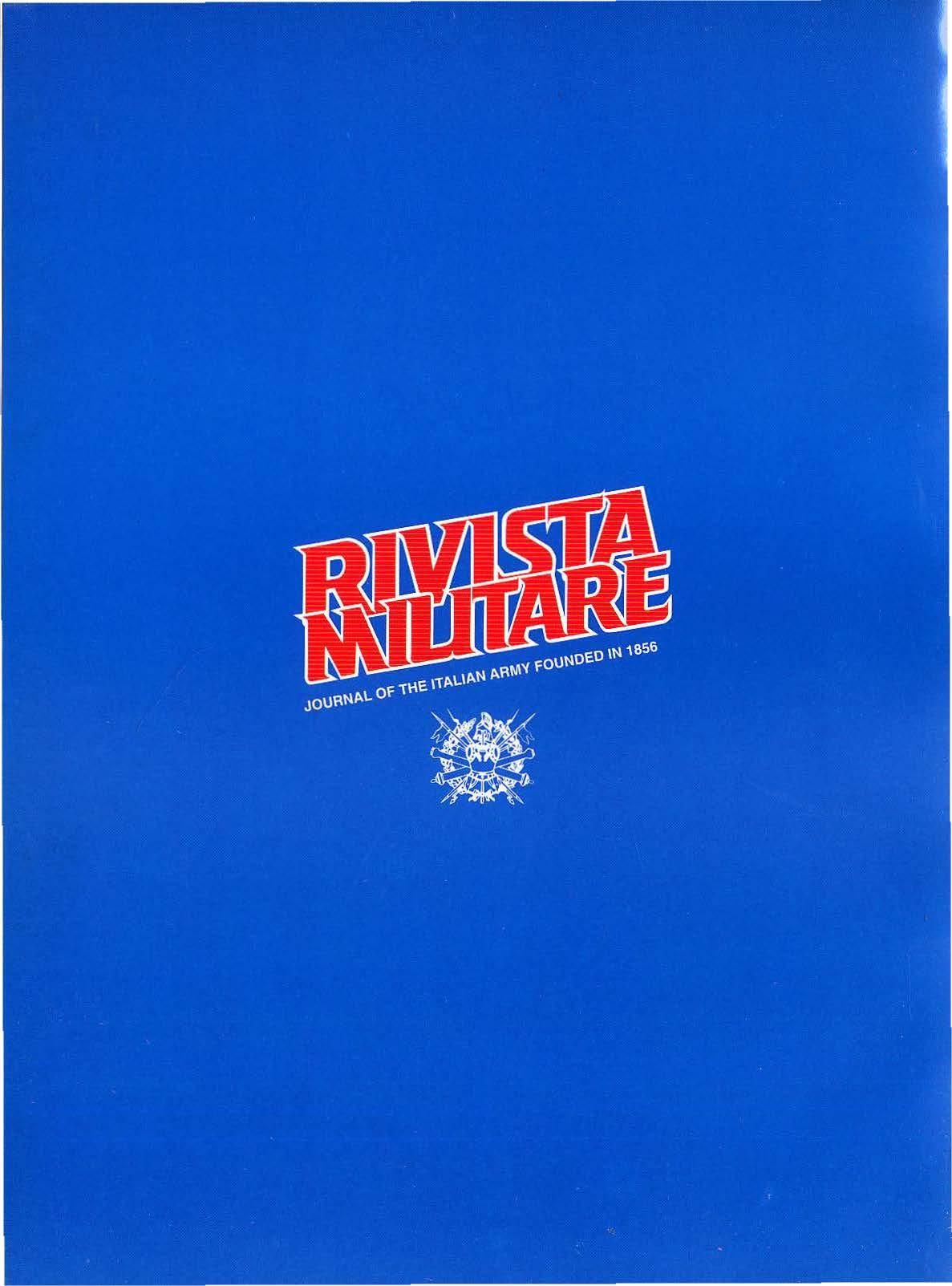













 by Enrico Magnani *
by Enrico Magnani *




































































































